Hours of Henry VIII
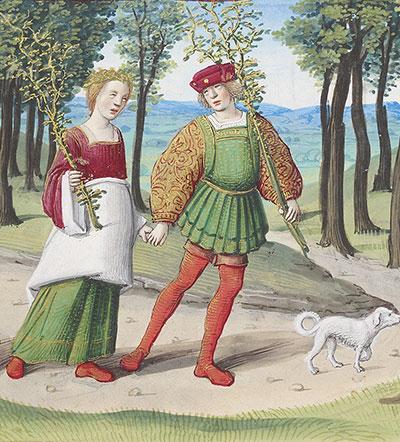
Illuminated around 1500 by the artist Jean Poyer, The Hours of Henry VIII receives its name from the possible but unproven eighteenth-century tradition that holds King Henry of England once owned this splendid manuscript. By following the simple instructions, you can explore every painting of this Renaissance masterpiece and learn how Books of Hours helped their readers to pray.
Books of Hours contain more or less standard texts—Calendar, Gospel Lessons, Hours of the Virgin, Hours of the Cross, Hours of the Holy Spirit, Penitential Psalms with Litany, Office of the Dead, and Suffrages—as well as a number of common accessory prayers. Based on the frequency and variety of added devotions, it appears that scribes included these for owners who wished to personalize their prayer books.
Also by Jean Poyer: The Prayer Book of Anne de Bretagne »
Month of May: Picking Branches
Hours of Henry VIII, in Latin
Illuminated by Jean Poyer
France, Tours, ca. 1500
The Pierpont Morgan Library, Gift of the Heineman Foundation, 1977
MS H.8 (fol. 3)
Thumbnails
Front cover
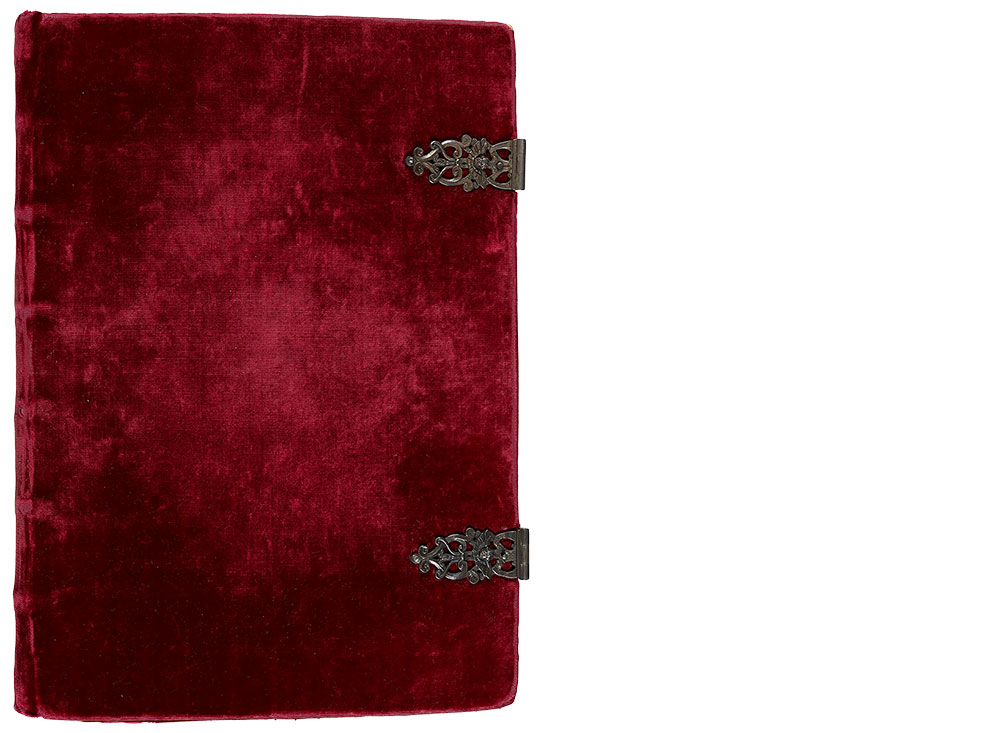
Hours of Henry VIII
Illuminated by Jean Poyer
Gift of the Heineman Foundation, 1977
MS H.8, inside front cover–first front fly leaf recto
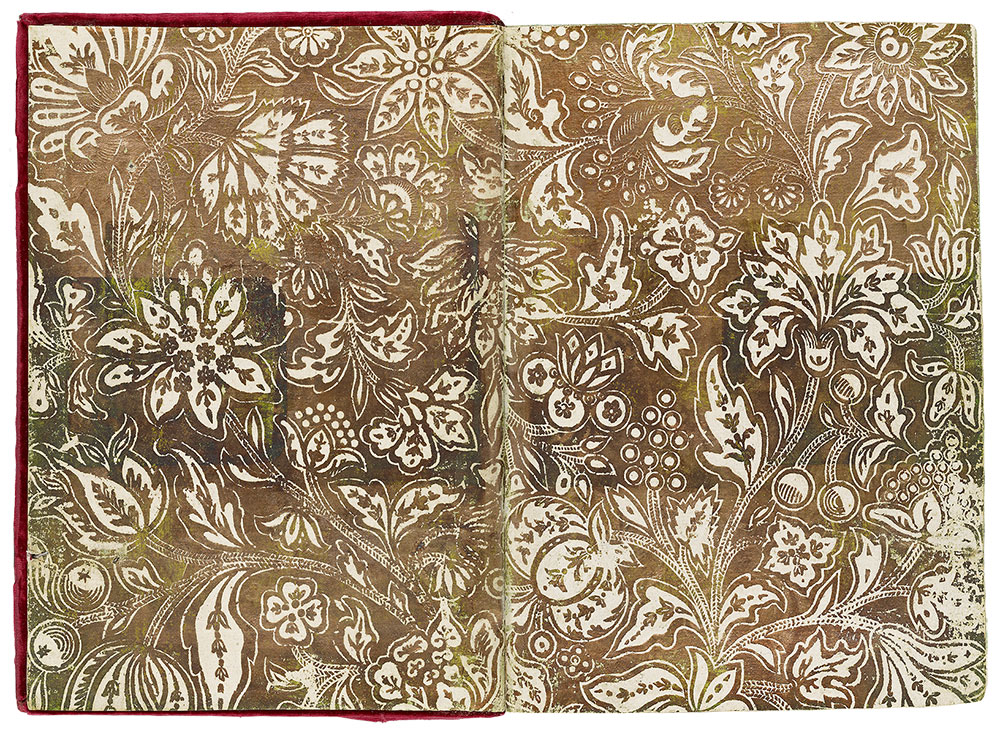
Hours of Henry VIII
Illuminated by Jean Poyer
Gift of the Heineman Foundation, 1977
MS H.8, first front fly leaf recto–second front fly leaf recto
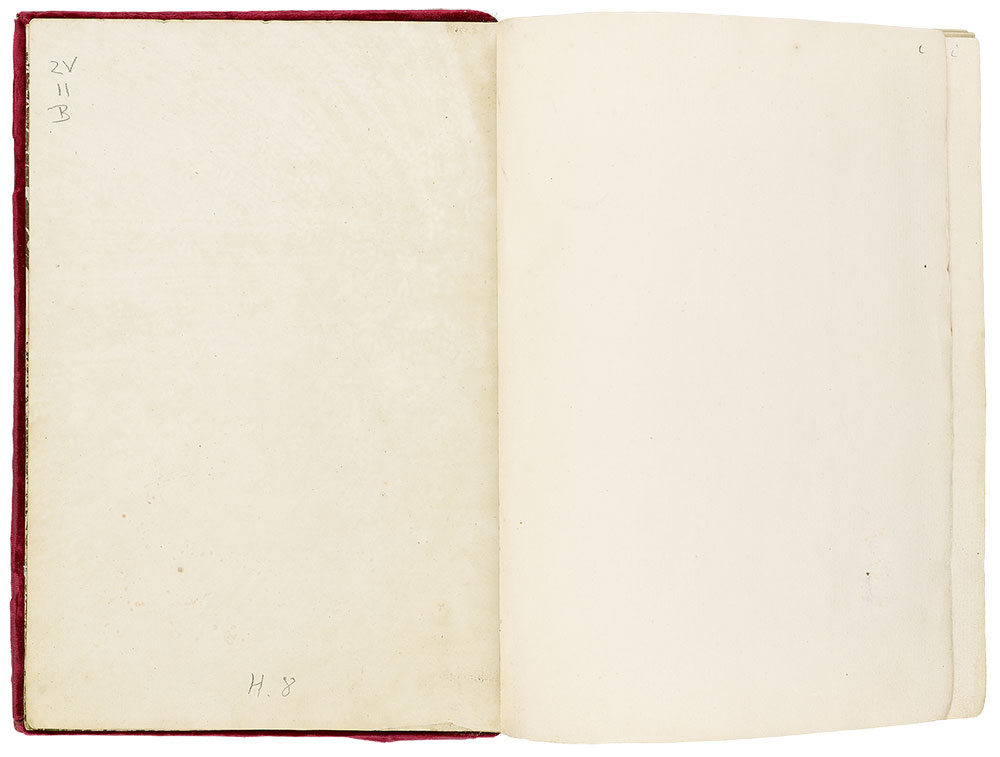
Hours of Henry VIII
Illuminated by Jean Poyer
Gift of the Heineman Foundation, 1977
MS H.8, second front fly leaf verso–fol. [i] recto
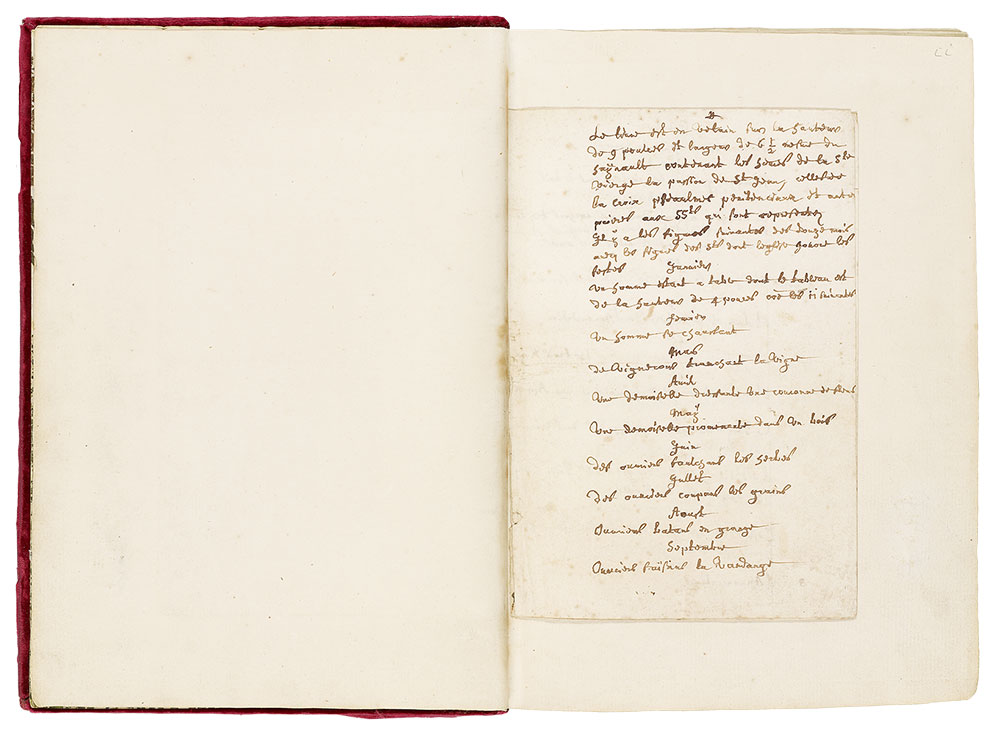
Hours of Henry VIII
Illuminated by Jean Poyer
Gift of the Heineman Foundation, 1977
MS H.8, fol. [i] verso–fol. [ii] recto
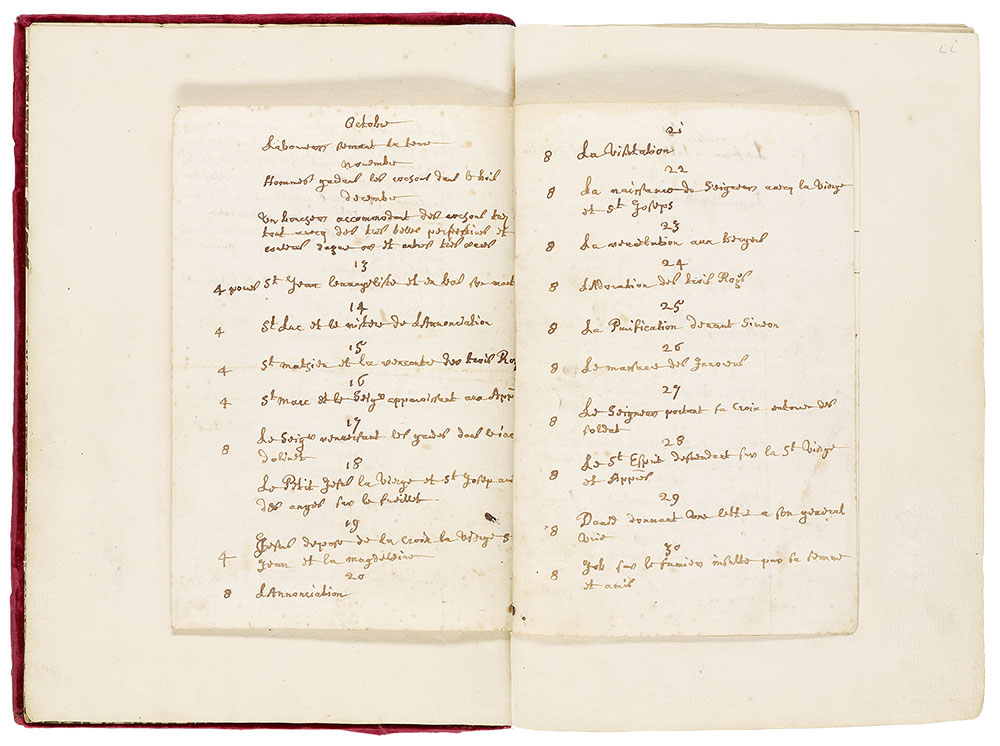
Hours of Henry VIII
Illuminated by Jean Poyer
Gift of the Heineman Foundation, 1977
MS H.8, fol. [ii] verso–fol. [iii] recto
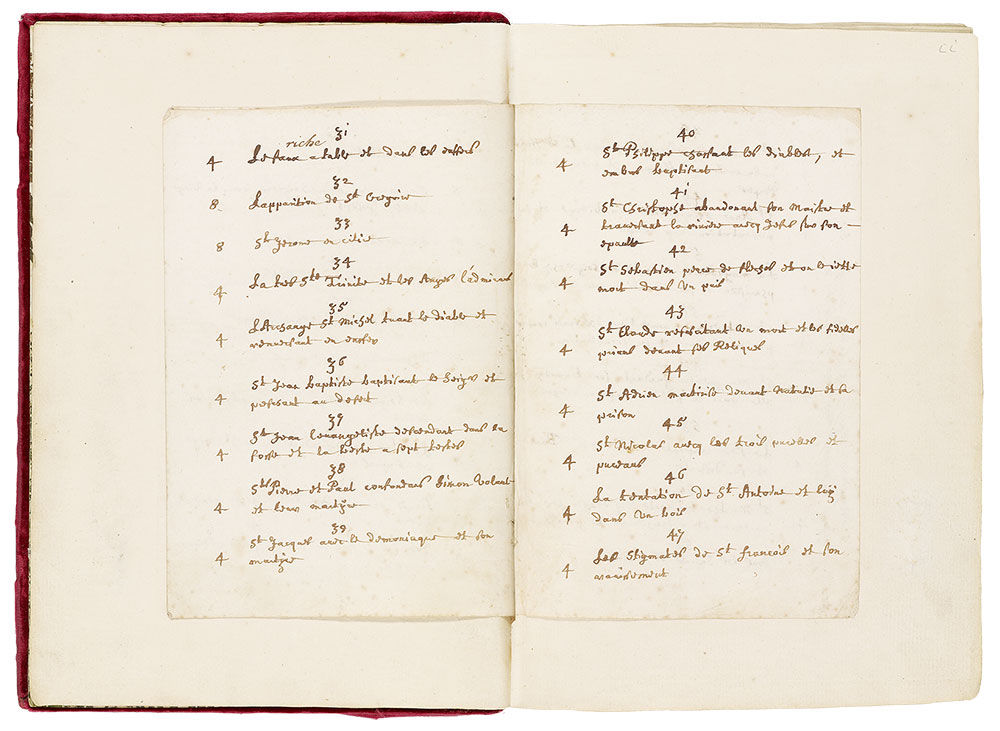
Hours of Henry VIII
Illuminated by Jean Poyer
Gift of the Heineman Foundation, 1977
MS H.8, fol. [iii] verso–third front fly leaf verso
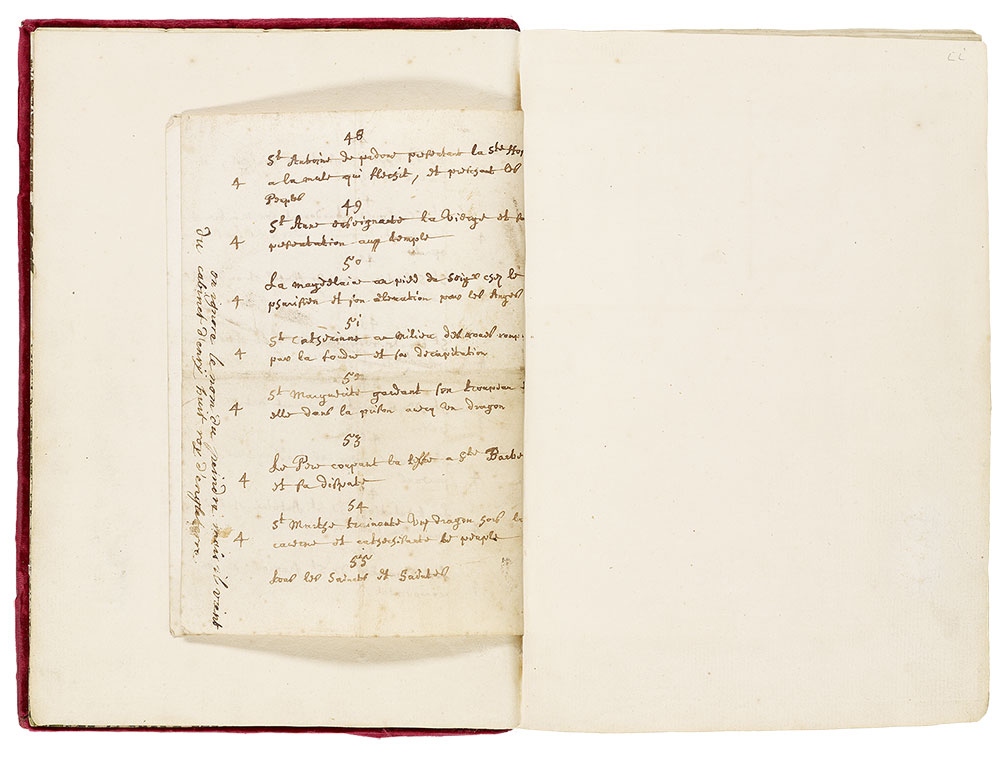
Hours of Henry VIII
Illuminated by Jean Poyer
Gift of the Heineman Foundation, 1977
Calendar, fol. 1r
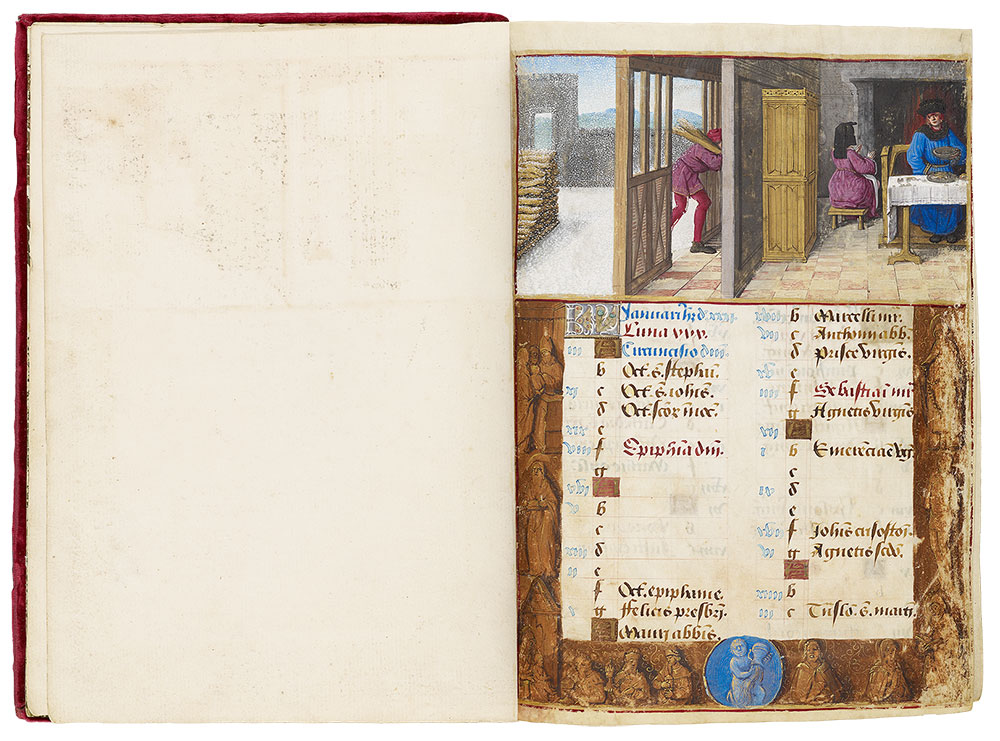
January: Feasting and Keeping Warm
Hours of Henry VIII
Illuminated by Jean Poyer
Gift of the Heineman Foundation, 1977
January: Feasting and Keeping Warm (fol. 1)
Calendars in Books of Hours do not demarcate time by enumerating the days from the first to the last of the month, as seen in this January page, but, rather list the important liturgical feasts of the month.
Inside, the lord of the house sits at his meal, his back to the hearth,as his wife, closer to the fire, warms her hands.
While a heavy snow covers the land, a laborer carries a few logs from the woodpile into the manor.
When Calendars in Horea (Latin for "Hours") were illustrated, they followed a tradition of depicting two vignettes in each month: the sign of the zodiac and the activity, usually agrarian, commonly undertaken during the season.
The borders illustrate some of January's major feasts, including, at top left, the Circumcision (feast on January 1). At bottom center is the zodiacal sign Aquarius, the Water Carrier.
MS H.8, fols. 1v–2r
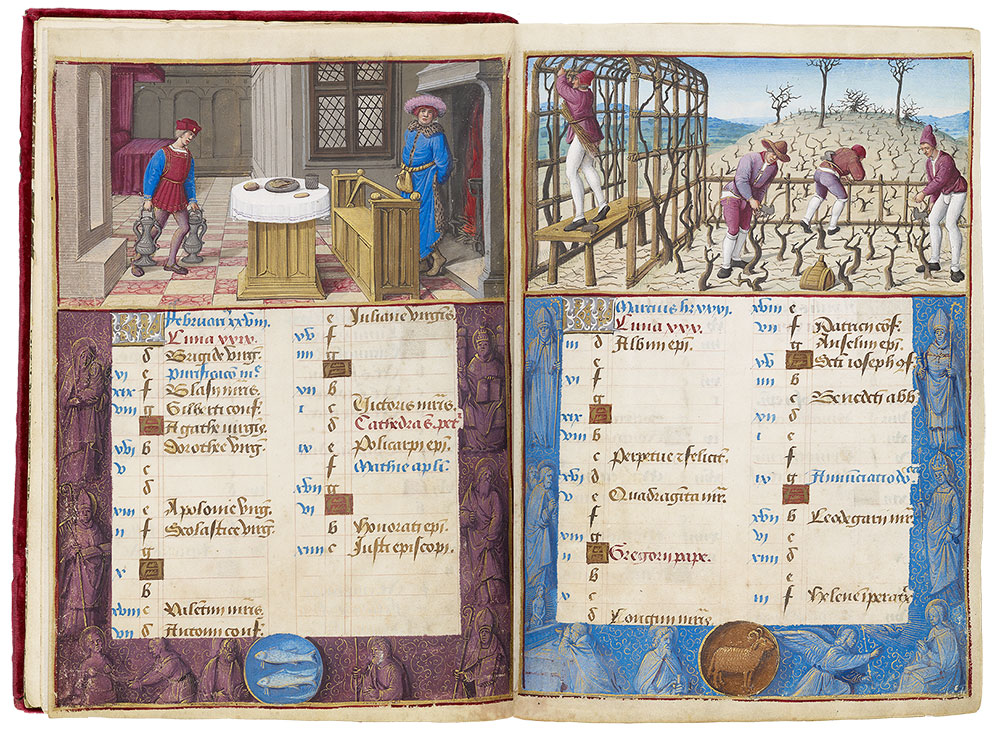
February: Keeping Warm
March: Pruning
Hours of Henry VIII
Illuminated by Jean Poyer
Gift of the Heineman Foundation, 1977
February: Keeping Warm (fol. 1v)
February's labor is not much different from January's. The lord of the house, richly dressed in fur-lined garments and hat, raises the folds of his clothes, to better warm his backside. His attention has been caught by his servant, who enters with flagons of wine.
In the left border are the Virgin holding the Christ Child (for the Feast of the Purification, February 2) and Sts. Blaise (holding his attribute, an iron comb, February 3), Agatha, whose breasts are being removed (February 5), and a generic male saint. The zodiacal sign is Pisces, the Fish.
March: Pruning (fol. 2)
In the early spring month of March, work begins outdoors with the typical labor of pruning the vineyard. Workers trim the leafless vines and tie them to the grape arbor. A wood cask for drink is in the foreground.
Among the scenes depicted in the margins are, at bottom left, St. Gregory with a vision at the altar of Christ (for the Feast of St. Gregory, March 12), and the Annunciation (March 25), at bottom right. Above the seated Virgin is St. Helena, discoverer of the True Cross, whose May 22 feast has been entered here mistakenly on March 31. The zodiacal sign is Aries, the Ram.
MS H.8, fols. 2v–3r
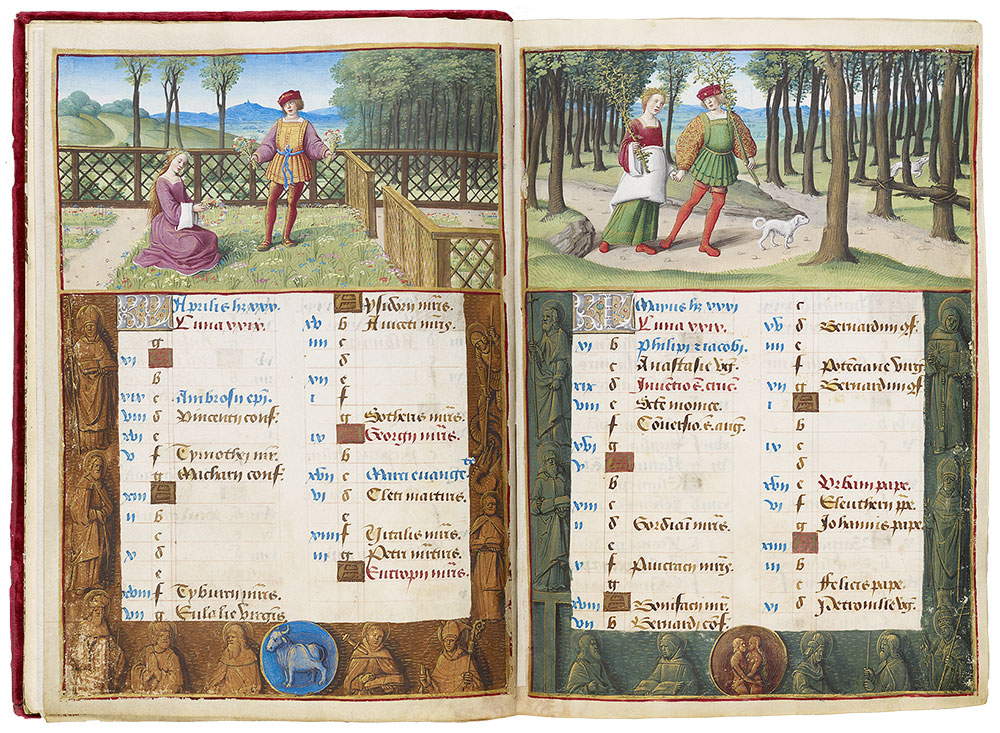
April: Picking Flowers and Making Wreaths
May: Picking Branches
Hours of Henry VIII
Illuminated by Jean Poyer
Gift of the Heineman Foundation, 1977
April: Picking Flowers and Making Wreaths (fol. 2v)
With April, the landscape becomes green and alive, and the month's activity is not laborious, but one for the leisure class. A foppishly dressed youth, his hands filled with freshly picked spring flowers, waits while his lady friend weaves the blossoms into a garland.
At the top of the right border is a depiction of St. George slaying the dragon (April 23). To the right of the zodiacal sign Taurus, the Bull, are Peter the Martyr, stabbed in the chest with a dagger, his attribute (April 29), and St. Eutropius, depicted with the ax with which he was struck in the head and killed (April 30).
May: Picking Branches (fol. 3)
Another leisurely couple partakes of May's pleasure, the gathering, on the first of the month, of flowering or leafing branches.
While one dog slowly leads the couple along a dirt path marked by branches tied across tree boughs, a second dog runs deeper into the woods on an uncharted track.
The rich border illustrations on the left side of May's calendar include images of Sts. Philip and James (May 1) and the True Cross (for the Feast of the Finding of the True Cross, May 3).
The zodiacal sign for Gemini portrays the Twins in naked embrace, possibly a visual reference to the couple depicted on the top half of the page.
MS H.8, fols. 3v–4r
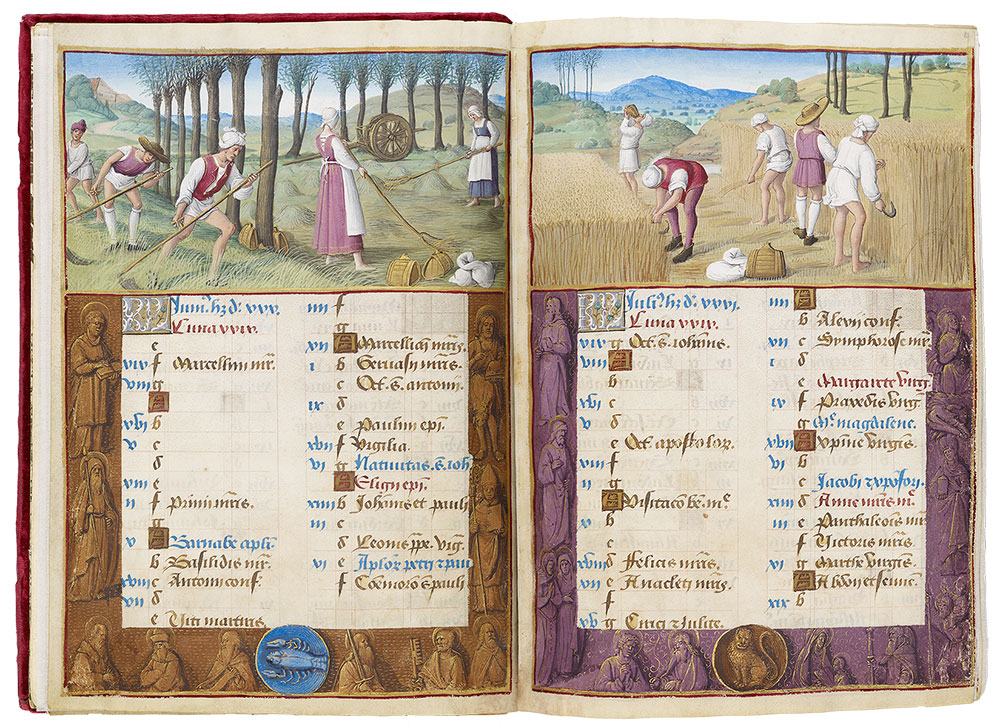
June: Mowing
July: Reaping
Hours of Henry VIII
Illuminated by Jean Poyer
Gift of the Heineman Foundation, 1977
June: Mowing (fol. 3v)
Summer's hard labors begin in June with the mowing of the hay.
Three men rhythmically attack the field with large scythes.
Two women rake the loose hay into stacks. Behind them, a wagon waits to be filled. In the foreground at the right are the workers' bundles of food and casks of drink.
On the right border are Sts. John the Baptist (feast of his Nativity on June 24), Eligius (June 25), a generic male saint, and Peter and Paul (June 29). The zodiacal sign is Cancer, the Crab.
July: Reaping (fol. 4)
The summer harvest continues in July with the reaping of the wheat. Four men, minimally dressed to keep cool, carefully cut the stalks with sickles and lay them in neat bundles. As in June, the foreground features, in the manner of a still life, their containers of food and drink.
Border: At the right are Sts. Margaret, shown emerging from the dragon (July 20), Mary Magdalene, holding her ointment jar (July 22), Christopher, carrying Christ on his back (feast on July 25, but indicated here on July 23), James, as a pilgrim (July 25), and Anne instructing the Virgin (July 26). The zodiacal sign is Leo, the Lion.
MS H.8, fols. 4v–5r
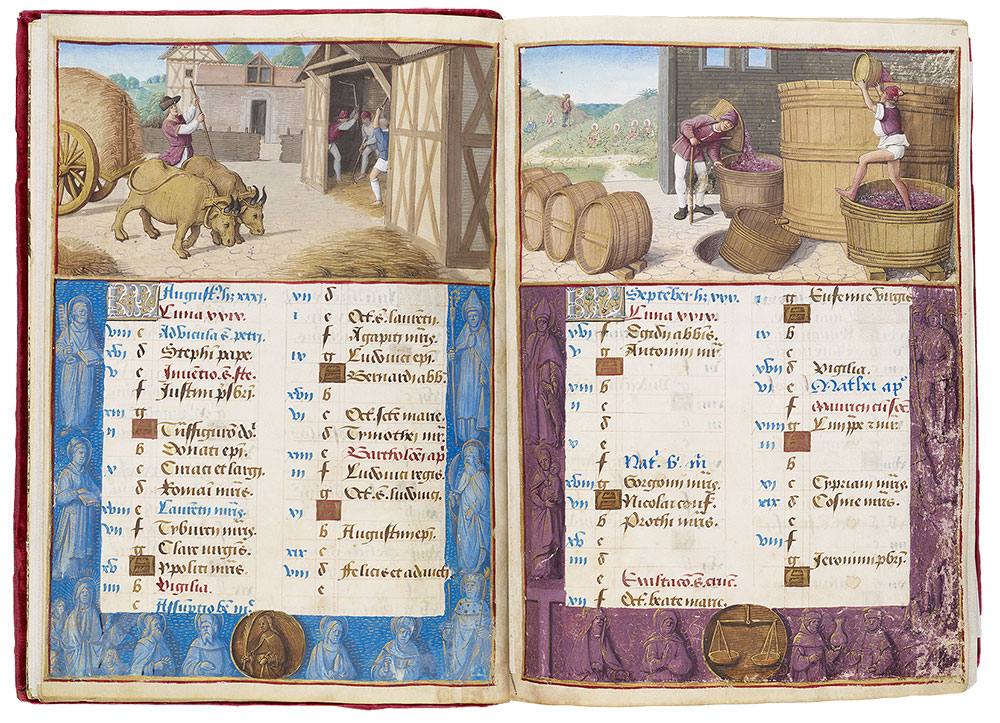
August: Threshing
September: Treading Grapes
Hours of Henry VIII
Illuminated by Jean Poyer
Gift of the Heineman Foundation, 1977
August: Threshing (fol. 4v)
The wheat harvest continues in August as the cut stalks are brought in oxcarts to the barn, where three men beat them with jointed flails.
Threshing with flails loosens the kernels of wheat from their stalks so that they can then be winnowed and thus separated from the chaff.
Starting at the top left margin is St. Peter (for the Feast of St. Peter in Chains, August 1), St. Stephen, with a rock on his head (for the feast of the discovery of his relics, August 3), and the Assumption of the Virgin (August 15).
At right are Sts. Louis of Toulouse (August 19) or possibly Bernard of Clairvaux (August 20), Bartholomew the Apostle, holding his butcher's knife (August 24), and King Louis IX of France (August 25).
The two women without attributes probably represent female saints in a general way, since there is only one female saint, Clare (August 12), listed in the month other than the Virgin. The zodiacal sign is Virgo, the Virgin (holding a palm of martyrdom).
September: Treading Grapes (fol. 5)
The task for September is wine making, an activity that requires a division of labor between men and women.
In the fields in the background, seated women pick the grapes, while a man stands, awaiting a full basket to bring to the winepress.
Inside the barn men dump their baskets into large winepresses where the fruit is trampled. Crushed, the grapes are then transferred to a large vat from which, at the bottom, the liquid can be extracted for storing and aging in the nearby barrels.
In the left margin are Sts. Giles, petting a deer (September 1), Anne, shown holding the Virgin (for the Feast of the Birth of the Virgin, September 8), the True Cross (for the Feast of the Exaltation of the Cross, September 14), Matthew the Apostle (September 21), and possibly St. Euphemia (September 16). The zodiacal sign is Libra, the Scales.
MS H.8, fols. 5v–6r
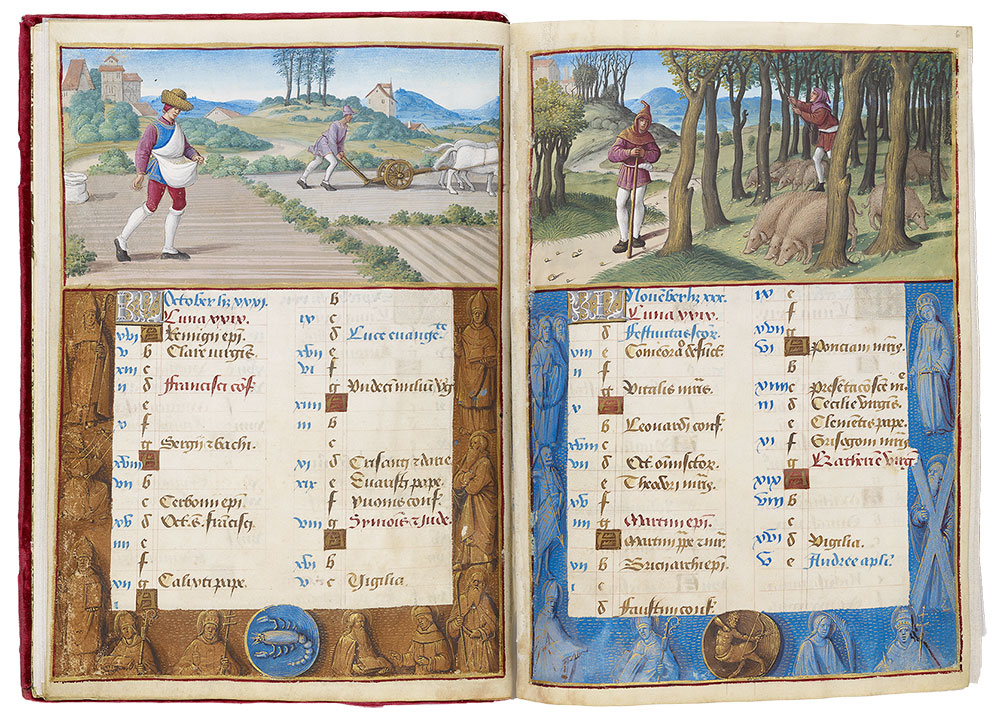
October: Sowing and Ploughing
November: Thrashing for Acorns
Hours of Henry VIII
Illuminated by Jean Poyer
Gift of the Heineman Foundation, 1977
October: Sowing and Ploughing (fol. 5v)
In October the winter wheat is sown. The man at left sows the field with grain he holds in his apron. The man on the right plows his field with a team of white horses.
Beneath St. Remigius (October 1) in the left margin is St. Francis, receiving the stigmata (October 4). They are followed by two bishop saints, one of whom is undoubtedly Cerbonius (October 10), and, finally, Pope Calixtus (October 14). The zodiacal sign is Scorpio, the Scorpion.
November: Thrashing for Acorns (fol. 6)
In November the labor is to take the pigs to the forest and rattle the branches of the oak trees so they shed their acorns, thus fattening up the animals.
In the left margin are a large group of saints (for the Feast of All Saints, November 1), Death as a skeleton (for the feast of All Souls, November 2), and Sts. Martin (bishop of Tours, November 11) and Brictius (archbishop of Tours, November 13).
At the right are Sts. Catherine, with a palm of martyrdom and the sword of her decapitation (November 25), Andrew the Apostle, holding his X-shaped cross (November 30), Clement, in papal tiara (November 23), and Cecilia (November 22). The zodiacal sign is Sagittarius, the Archer.
Gospel Lessons, fol. 6v
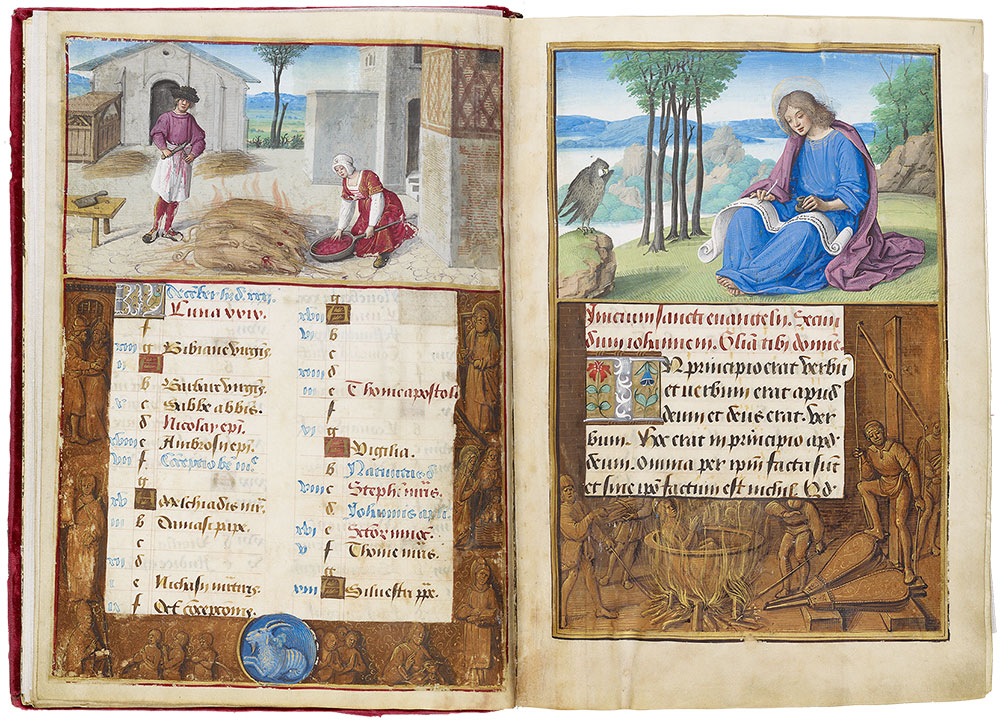
December: Roasting Slaughtered Pigs
John's Lesson: John on Patmos
Hours of Henry VIII
Illuminated by Jean Poyer
Gift of the Heineman Foundation, 1977
December: Roasting Slaughtered Pigs (fol. 6v)
In December the pigs that were fattened in November are butchered. Resting on a bed of kindling and covered with twigs, the hogs are singed prior to butchering, for which the man prepares by sharpening his knife. At the right a woman has collected the pigs' blood in a large pan.
The left margin shows the Meeting of Joachim and Anne at the Golden Gate (for the Feast of the Conception of the Virgin, December 8), Sts. Barbara, holding her tower (December 4), and Nicholas, shown resuscitating the three youths (December 6).
At the right are St. Thomas the Apostle, holding a builder's square (December 21), the Nativity (December 25), Sts. Stephen Protomartyr, with a rock on his head (December 26), John the Evangelist, blessing a cup of poison (December 27), and a group of the Holy Innocents (December 28). The zodiacal sign is Capricorn, the Goat.
John's Lesson: John on Patmos
Border: John Boiled in Oil (fol. 7)
By the beginning of the fifteenth century, four particular Gospel Lessons had become a regular feature in Books of Hours. These Lessons, which often follow the Calendar, are actually the Gospel readings from the Masses for the of the Church's major liturgical feasts.The Gospel Lessons for the Hours of Henry VIII (fols. 7–21v) are illustrated with a cycle of evangelist portraits, one placed at the beginning of each reading.
The first Lesson, from John (1:1– 14), acts as a kind of preamble for the entire Book of Hours. Its theme is humankind's need for redemption and God's willingness to provide it.
John, who writes on a scroll, does so on Patmos, the island to which he was banished by the Roman emperor Domitian (r. 81–96) and where, according to tradition, he wrote the Book of Revelation. The eagle is a symbol for John the Evangelist.
Before banishing John to Patmos, the emperor Domitian had tried to rid himself of the evangelist by boiling him to death. In the border, one man heats the fire with bellows to such a degree that his colleagues must shield their faces from the blast. John, calmly praying in the tub, remains unharmed.
The painted initial opens John's Lesson with its famous passage, In Principio erat verbu(m) (In the beginning was the Word), thus starting the Gospel's theme of Christ's Divinity.
MS H.8, fols. 7v–8r
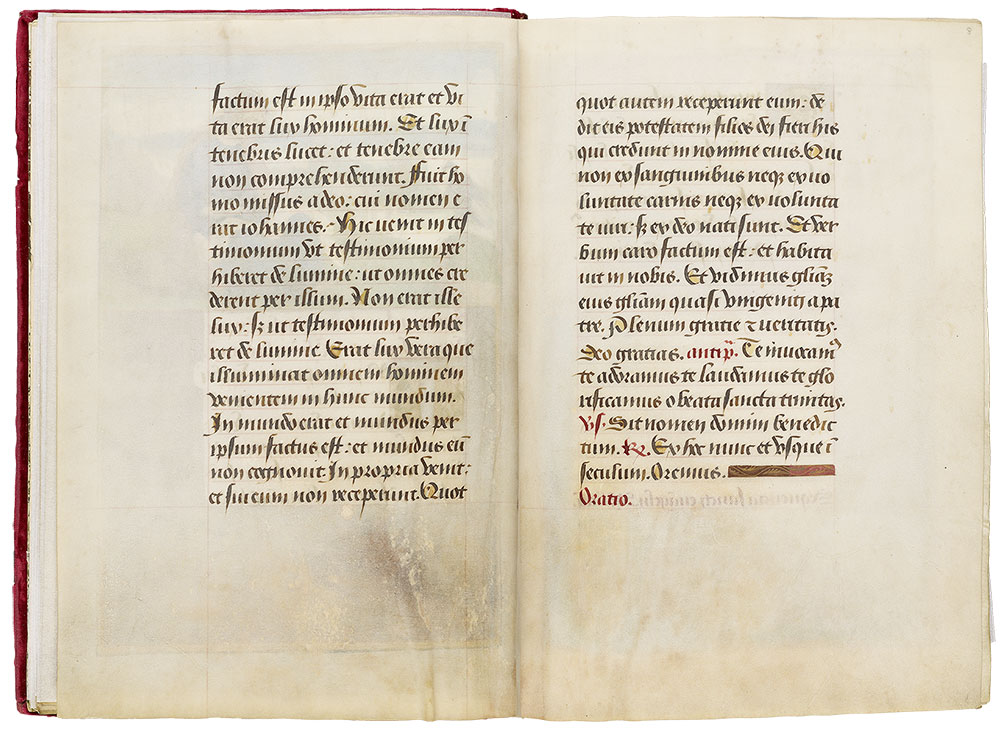
Hours of Henry VIII
Illuminated by Jean Poyer
Gift of the Heineman Foundation, 1977
MS H.8, fols. 8v–9r
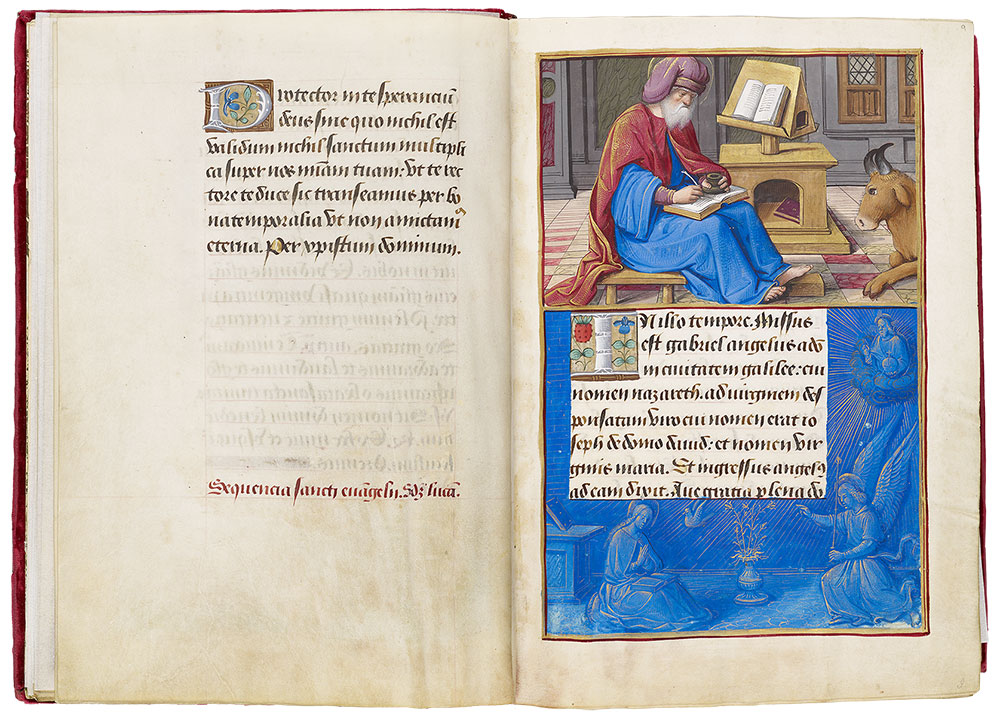
Luke's Lesson: Luke Writing
Hours of Henry VIII
Illuminated by Jean Poyer
Gift of the Heineman Foundation, 1977
Luke's Lesson: Luke Writing
Border: Annunciation (fol. 9)
Seated in his study, the evangelist Luke sits with his symbol, the ox, at his feet, as he writes the Lesson (Luke 1:26–38) describing the Annunciation and ending with the Virgin's acceptance of God's will.
The events mentioned in the opening works of the text are illustrated in the borders: For In illo tempore. Missus est Gabriel angelus a D[e]o in civitatem Galilee cui nomen Nazareth (In that time the angel Gabriel was sent from God to a town on Galilee called Nazareth), Poyer portrays God the Father as having a prominent role in the Annunciation, directing both Gabriel and the Dove of the Holy Spirit toward the Virgin.
MS H.8, fols. 9v–10r
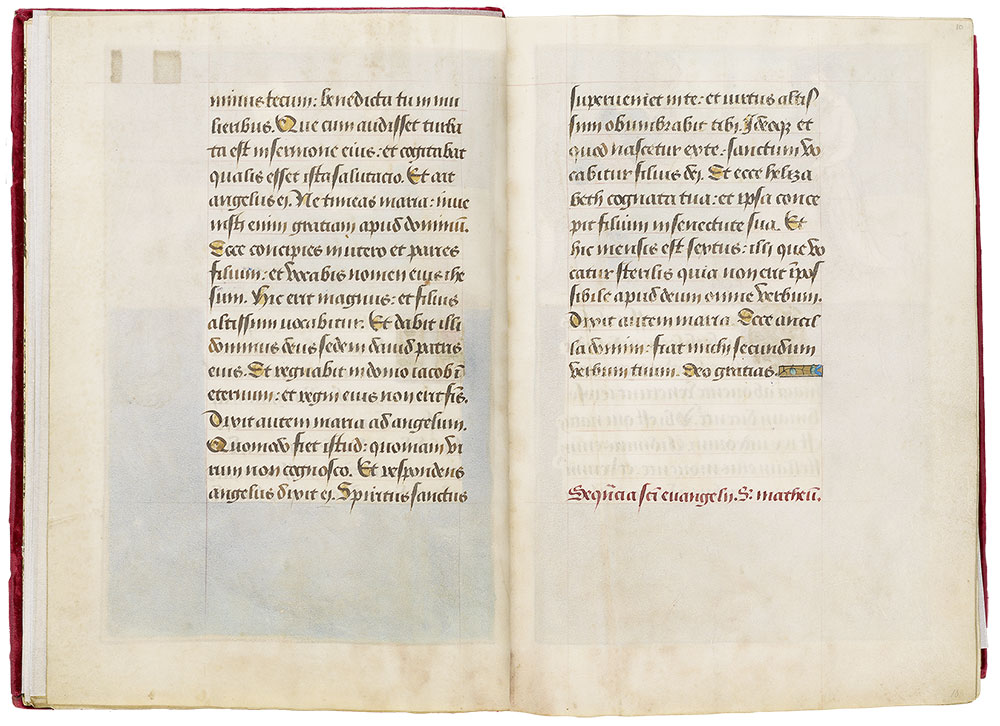
Hours of Henry VIII
Illuminated by Jean Poyer
Gift of the Heineman Foundation, 1977
MS H.8, fols. 10v–11r
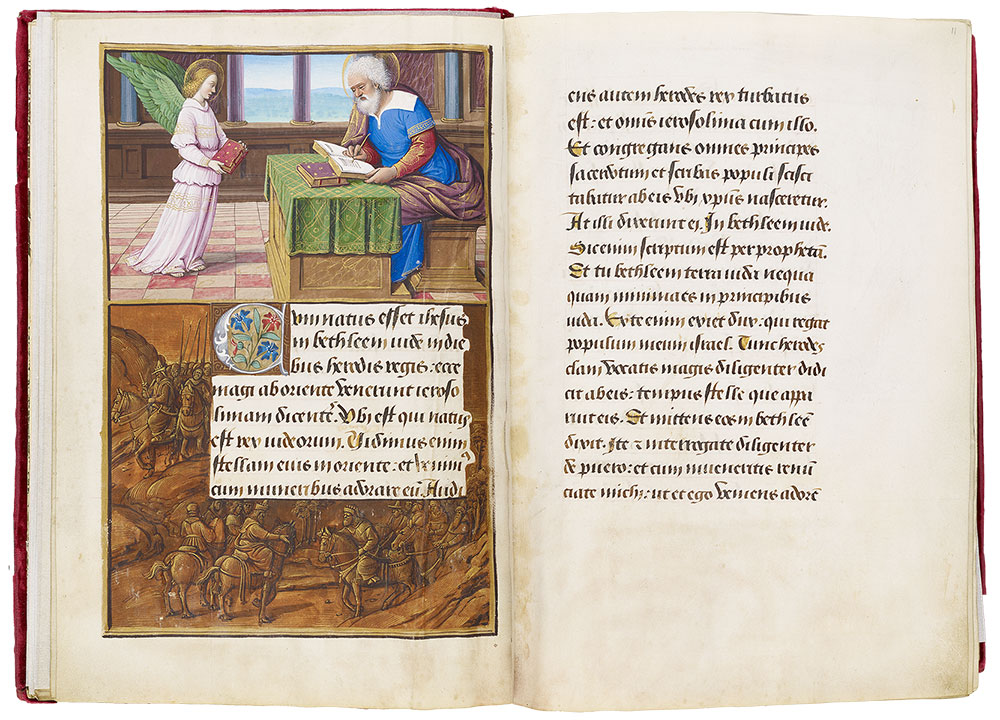
Matthew's Lesson: Matthew Writing
Hours of Henry VIII
Illuminated by Jean Poyer
Gift of the Heineman Foundation, 1977
Matthew's Lesson: Matthew Writing
Border: Magi Meeting at the Crossroads (fol. 10v)
As the angel, Matthew's symbol, attends bearing a book, the evangelist sits at his desk writing the text for his Gospel Lesson, which Poyer brought to life with his border illlustration.
In the border the Three Kings, accompanied by their entourages, meet at the crossroads en route to where the star leads them. The text begins, Cum natus esset Ihesus in Bethleem Iude in diebus Herodis Regis, ecce Magi ab Oriente venerunt Ierosolimam (When Jesus was born in Bethlehem of Judea, in the days of King Herod, behold, Magi came from the East to Jerusalem).
MS H.8, fols. 11v–12r
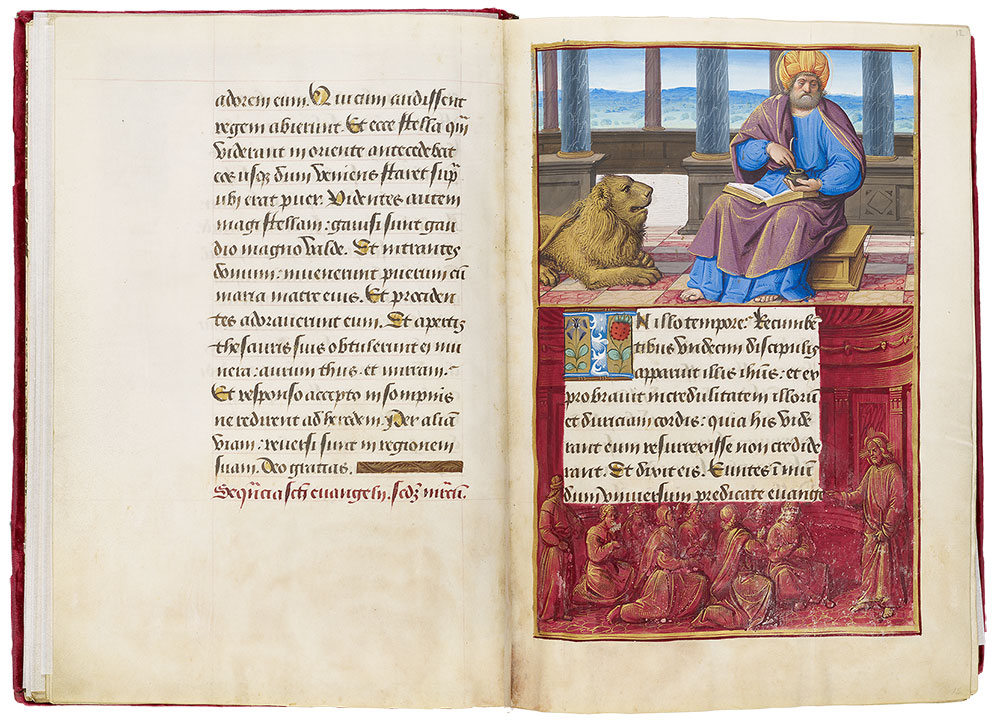
Mark's Lesson: Mark Contemplating
Hours of Henry VIII
Illuminated by Jean Poyer
Gift of the Heineman Foundation, 1977
Mark's Lesson: Mark Contemplating
Border: Christ Preaching to a Crowd (fol. 12)
Portrayed in an interior setting similar to Matthew's, Mark sits with his symbol, the lion, as he writes his Lesson.
Mark's Lesson opens with these words In illo tempore. Recumbe[n]tibus undecim discipulisapparuit illis Ih[es]us (In that time, Jesus appeared to the eleven disciples). Surrounding the text, Poyer illustrated Christ, depicted with a stern gesture leveled at the group as he reproaches the apostles for their lack of faith and hardness of heart.
MS H.8, fols. 12v–13r
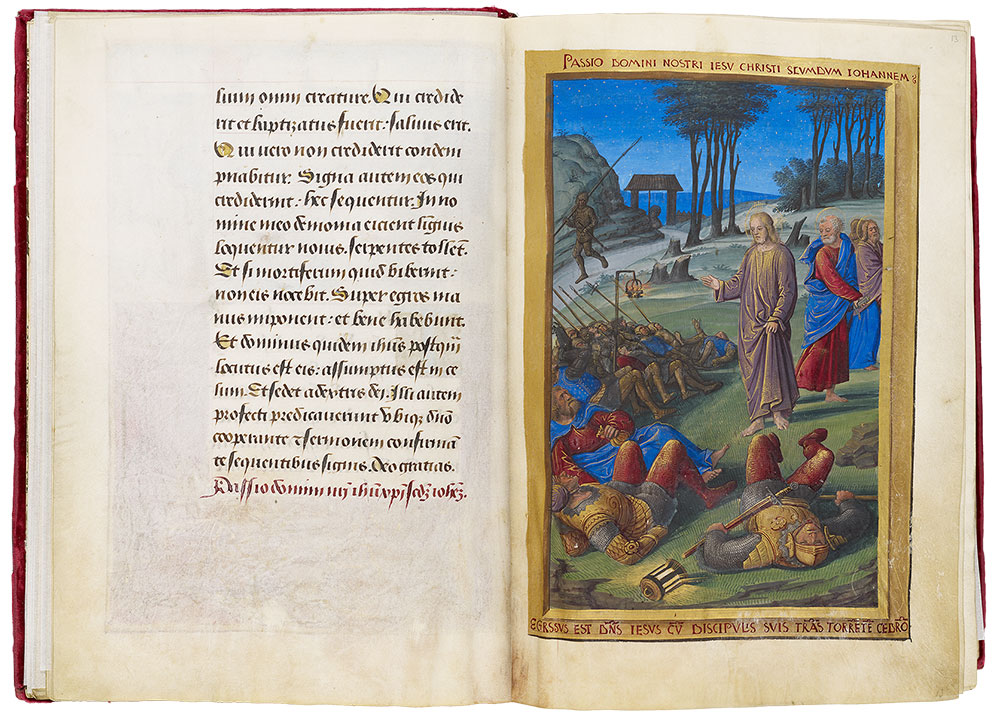
Passion According to John: "Ego sum"
Hours of Henry VIII
Illuminated by Jean Poyer
Gift of the Heineman Foundation, 1977
Passion According to John: "Ego sum" (fol. 13)
John's Passion is normally illustrated with an image of Christ's Agony in the Garden or, as here, the Ego sum (I am he). The Latin title of the picture derives from the short but dramatic answer Christ gave to the rough band of soldiers who had come with Judas to arrest him. At his two words, the soldiers fell back in amazement. Behind Christ, St. Peter begins to draw his sword.
The iconography of Poyer's nighttime scene can be traced back to the version painted by the Limbourg brothers in Jean, duc de Berry's, Trés Riches Heures (shortly before 1416), a miniature that, like many in his famous manuscript, was highly influential on French illumination.
Within the group of soldiers on the ground Judas can be identified as the bearded figure at the left clutching his moneybag.
MS H.8, fols. 13v–14r
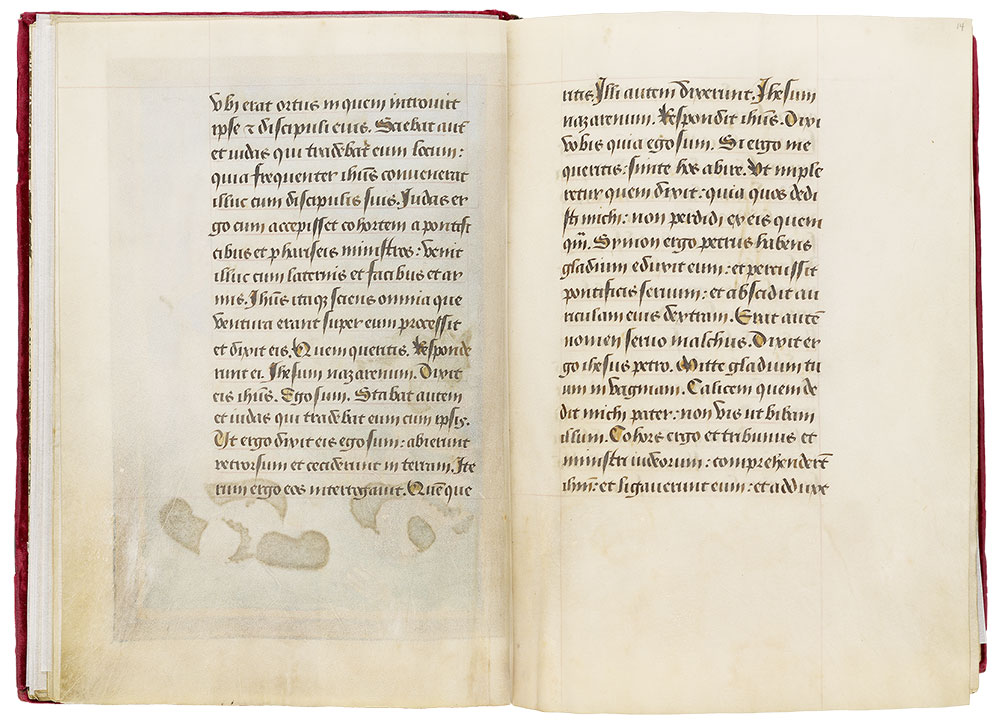
Hours of Henry VIII
Illuminated by Jean Poyer
Gift of the Heineman Foundation, 1977
MS H.8, fols. 14v–15r
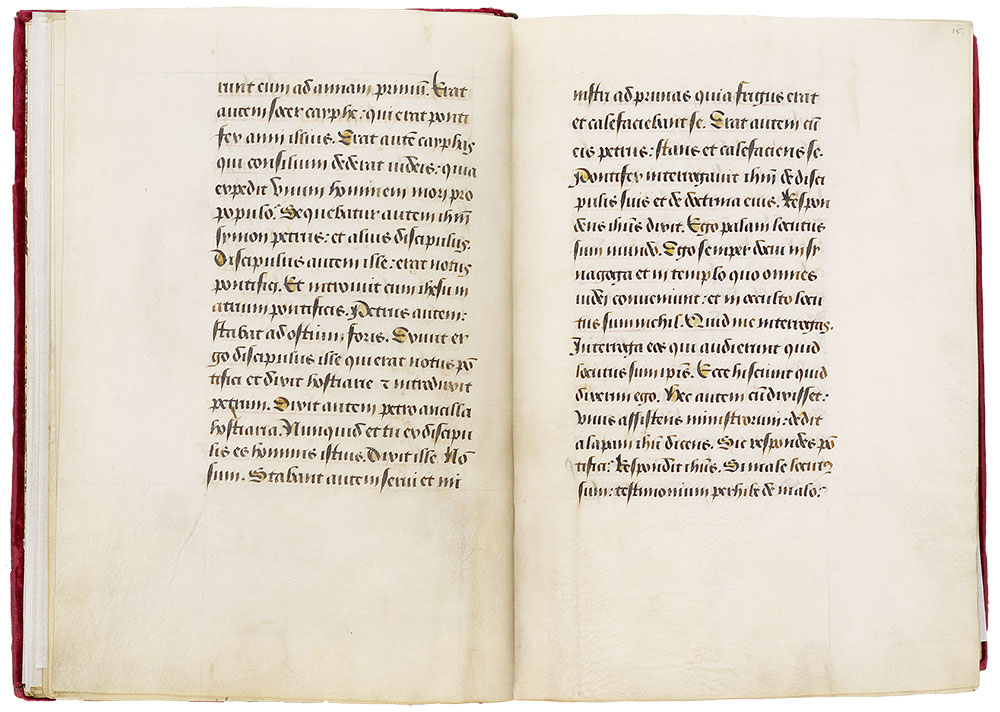
Hours of Henry VIII
Illuminated by Jean Poyer
Gift of the Heineman Foundation, 1977
MS H.8, fols. 15v–16r
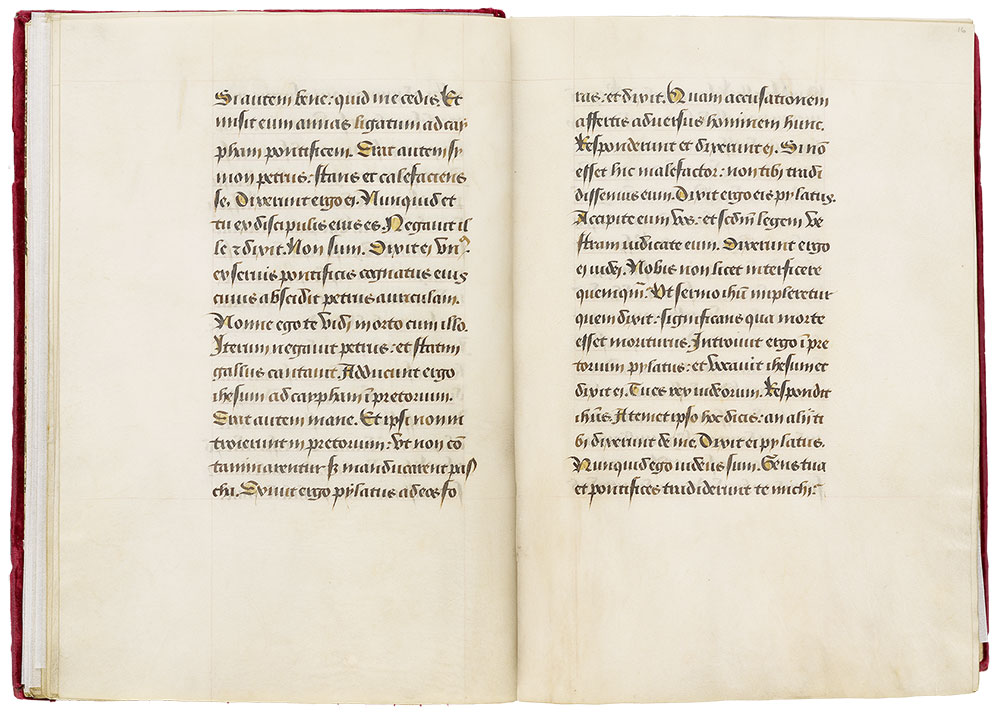
Hours of Henry VIII
Illuminated by Jean Poyer
Gift of the Heineman Foundation, 1977
MS H.8, fols. 16v–17r
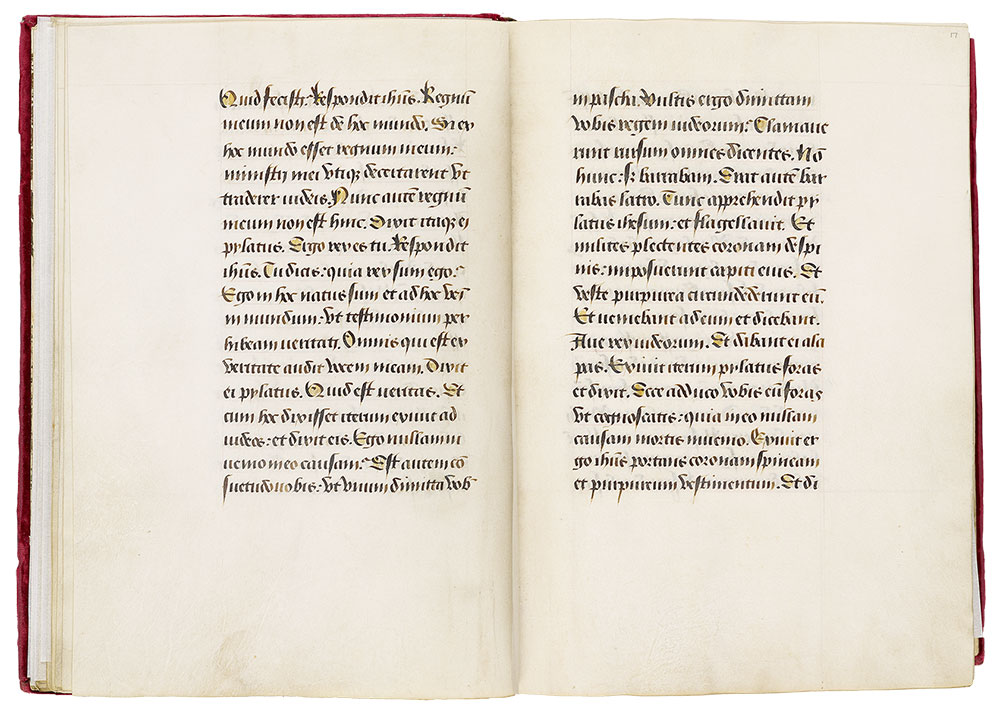
Hours of Henry VIII
Illuminated by Jean Poyer
Gift of the Heineman Foundation, 1977
MS H.8, fols. 17v–18r
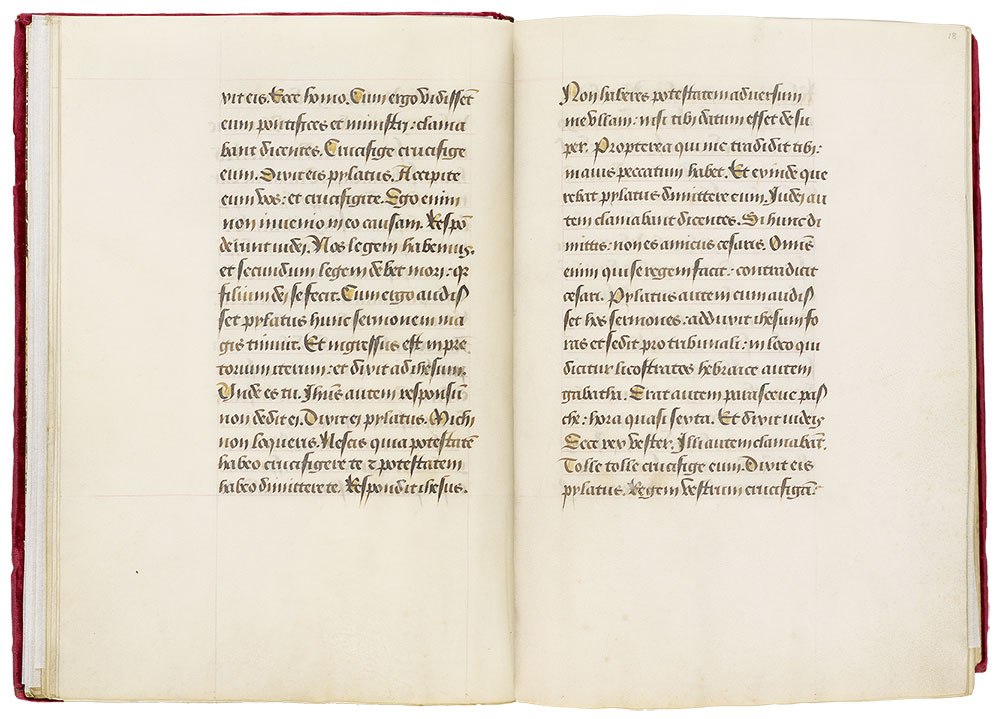
Hours of Henry VIII
Illuminated by Jean Poyer
Gift of the Heineman Foundation, 1977
MS H.8, fols. 18v–19r
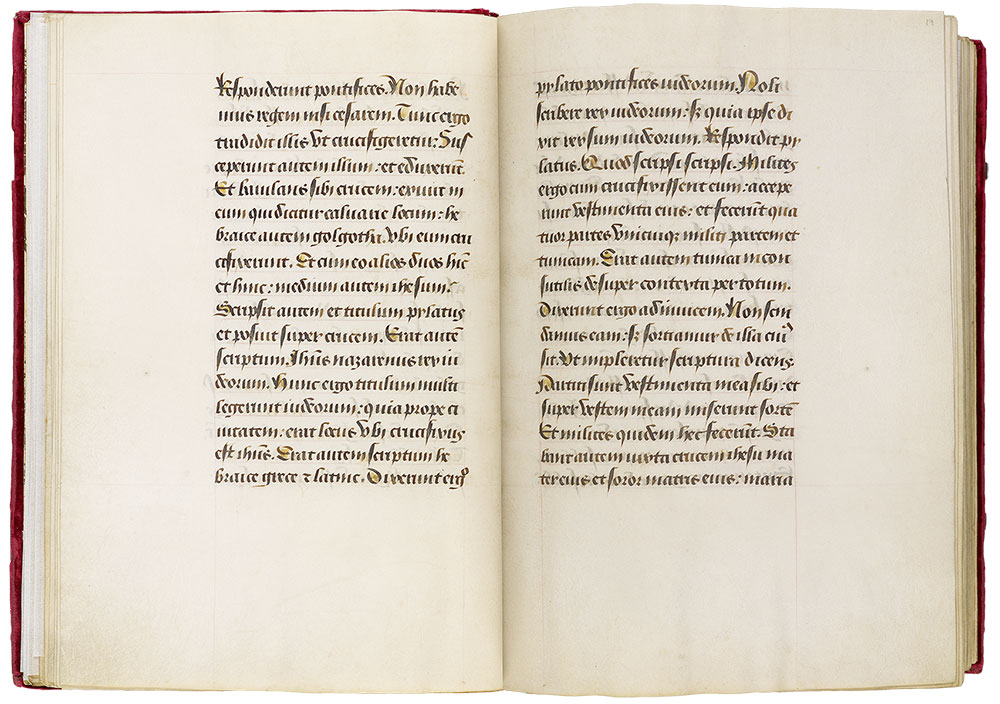
Hours of Henry VIII
Illuminated by Jean Poyer
Gift of the Heineman Foundation, 1977
MS H.8, fols. 19v–20r
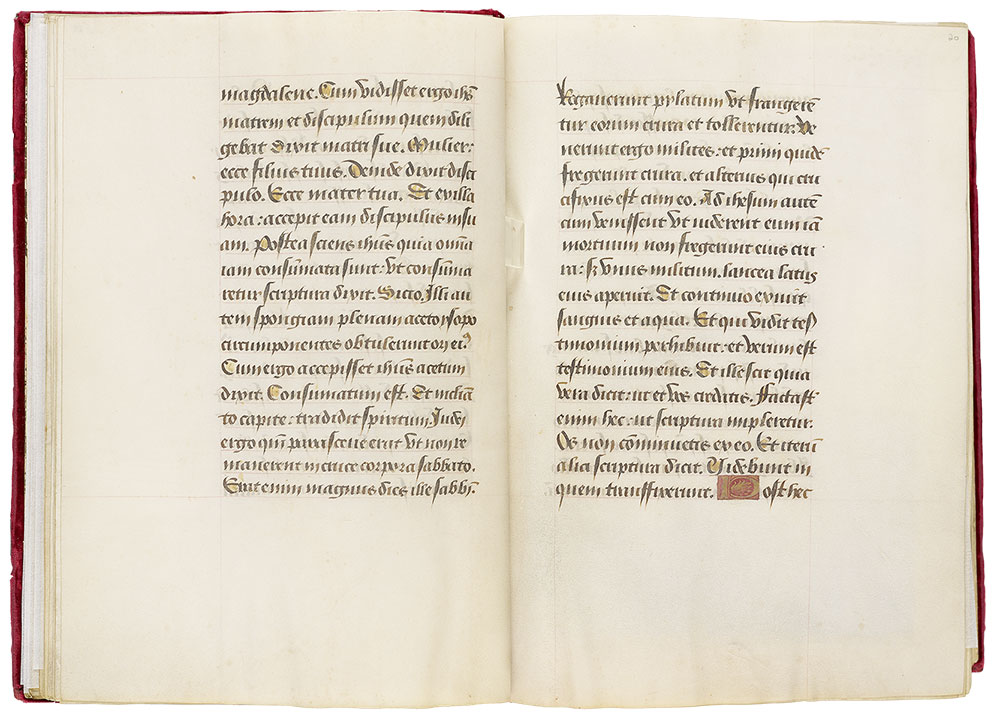
Hours of Henry VIII
Illuminated by Jean Poyer
Gift of the Heineman Foundation, 1977
MS H.8, fols. 20v–21r
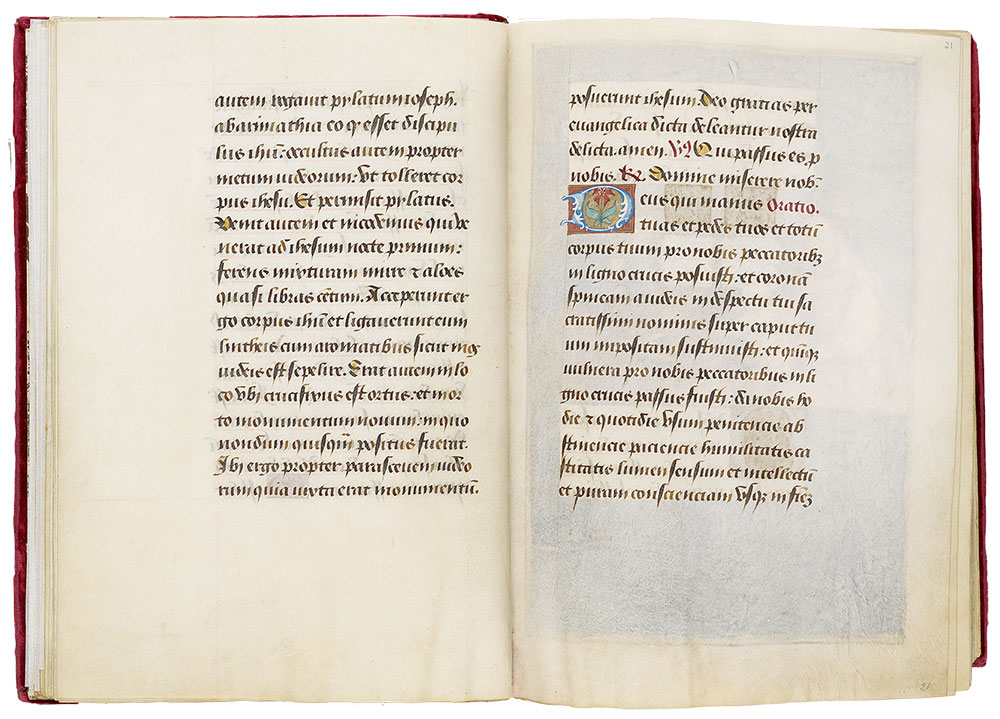
Hours of Henry VIII
Illuminated by Jean Poyer
Gift of the Heineman Foundation, 1977
Prayers to the Virgin, fol. 21v
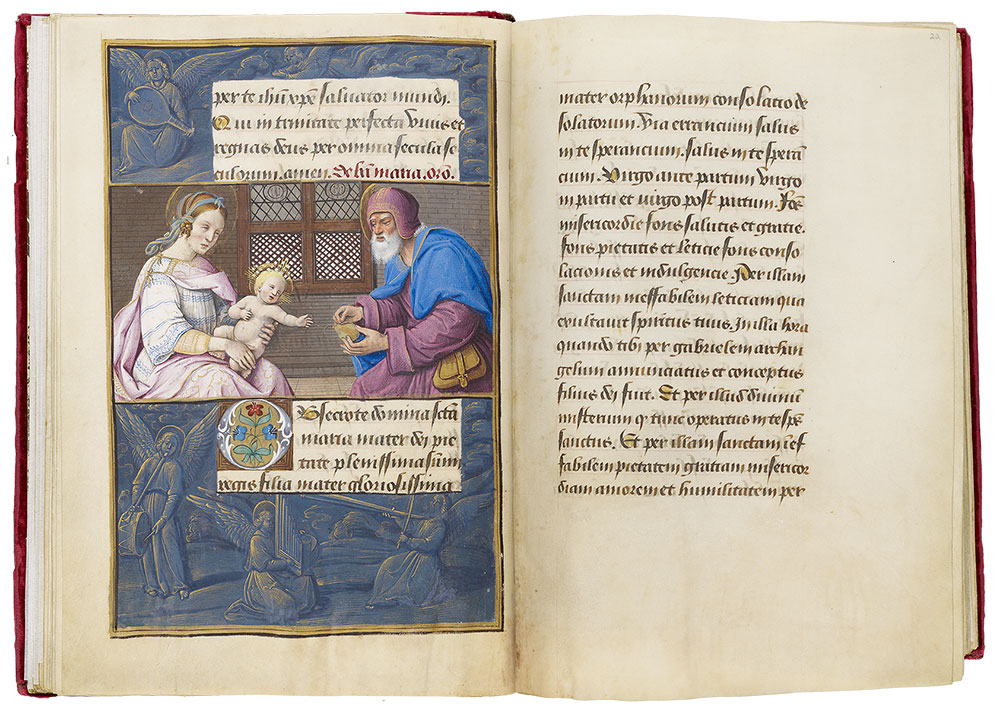
"Obsecro te": Holy Family
Hours of Henry VIII
Illuminated by Jean Poyer
Gift of the Heineman Foundation, 1977
"Obsecro te": Holy Family
Border: Musical Angels
Of all the optional prayers that owners requested, by far the most popular were two to the Virgin called, after their Latin incipits (opening words), the "Obsecro te" (I beseech you), fol. 21v, and the "O intemerata" (O incomparable one), whose miniature is missing.
Prayers to the Virgin (fols. 21v–29v)
The Hours of Henry VIII contains a number of common accessory prayers, including the set of four Marian devotions that follow the Gospel Lessons–"Obsecro te," "O intemerata," "Stabat mater," and the Mass of the Virgin.
Since the first part of the "Obsecro te" emphasizes the Virgin's special role in the Incarnation and reminds her of the joys of motherhood, miniatures illustrating the prayer, as in the Hours of Henry VIII, depict the Virgin with the Christ Child. Here St. Joseph, in an imporant parental role he is rarely given in Books of Hours, offers Jesus a pear.
"Obsecro te" miniatures often include musical angels: here they serenade the Holy Family with a lute, pipe and tabor, portative organ, and trumpet marine.
MS H.8, fols. 22v–23r
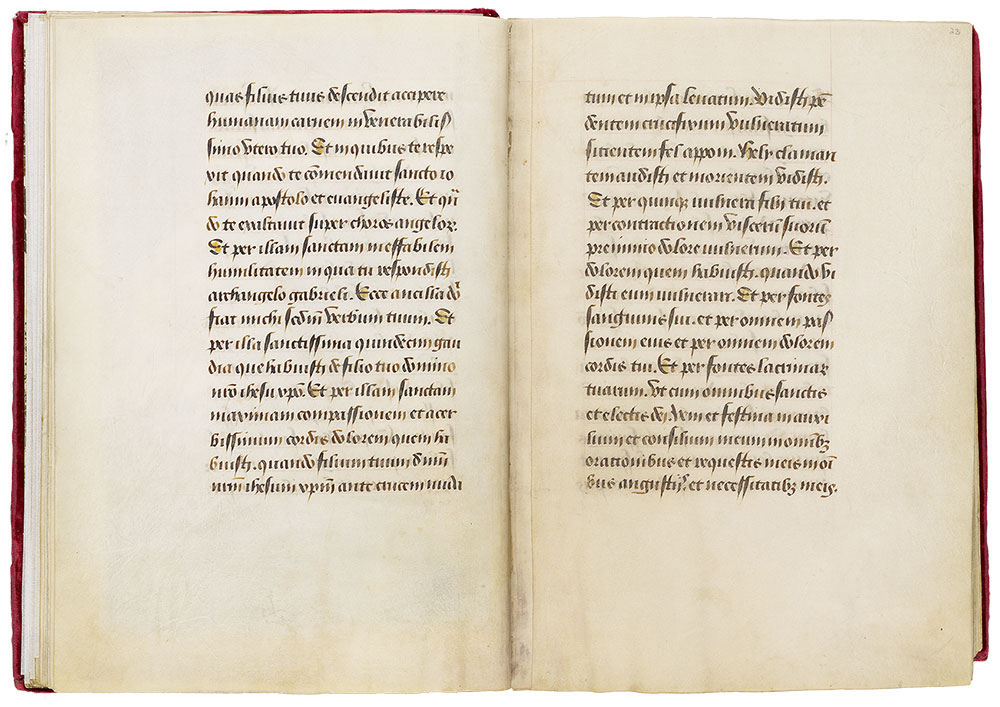
Hours of Henry VIII
Illuminated by Jean Poyer
Gift of the Heineman Foundation, 1977
MS H.8, fols. 23v–24r
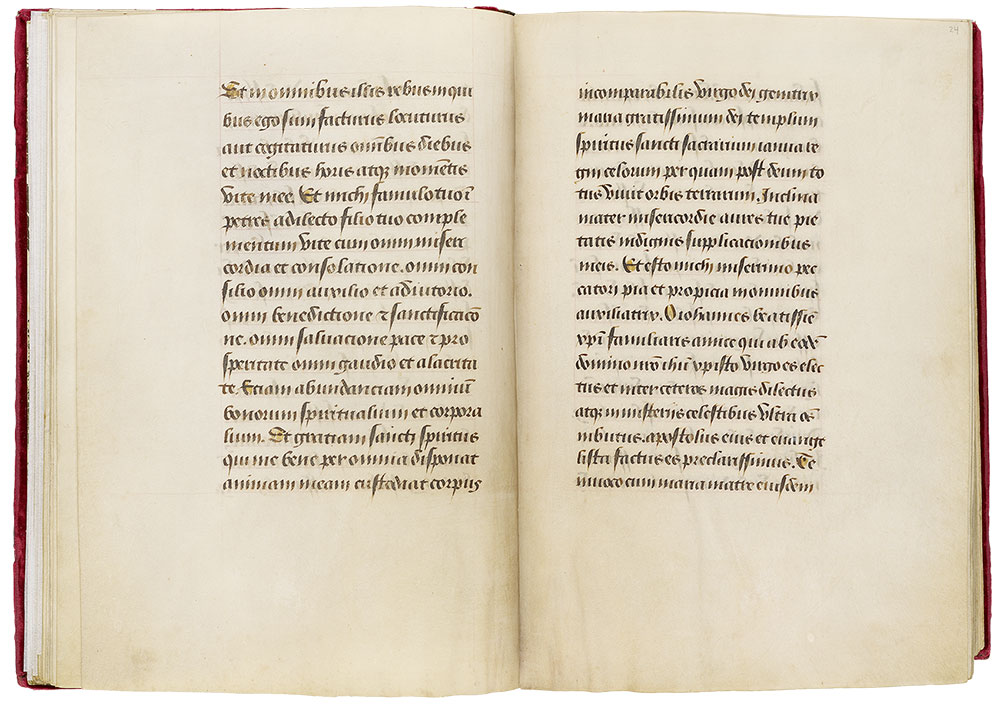
Hours of Henry VIII
Illuminated by Jean Poyer
Gift of the Heineman Foundation, 1977
MS H.8, fols. 24v–25r
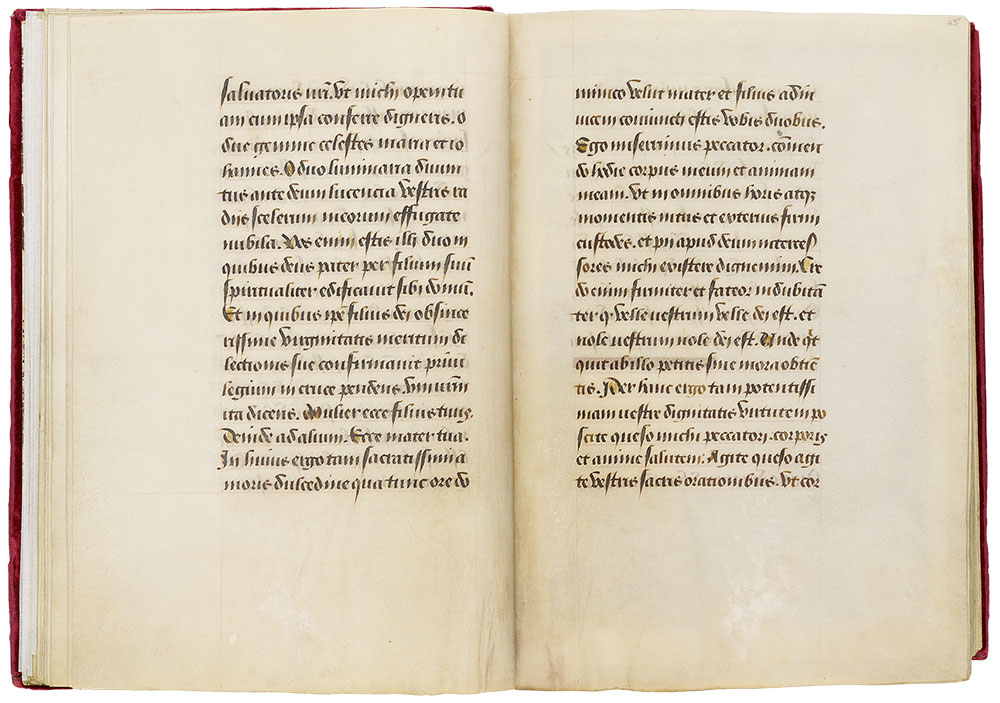
Hours of Henry VIII
Illuminated by Jean Poyer
Gift of the Heineman Foundation, 1977
MS H.8, fols. 25v–26r
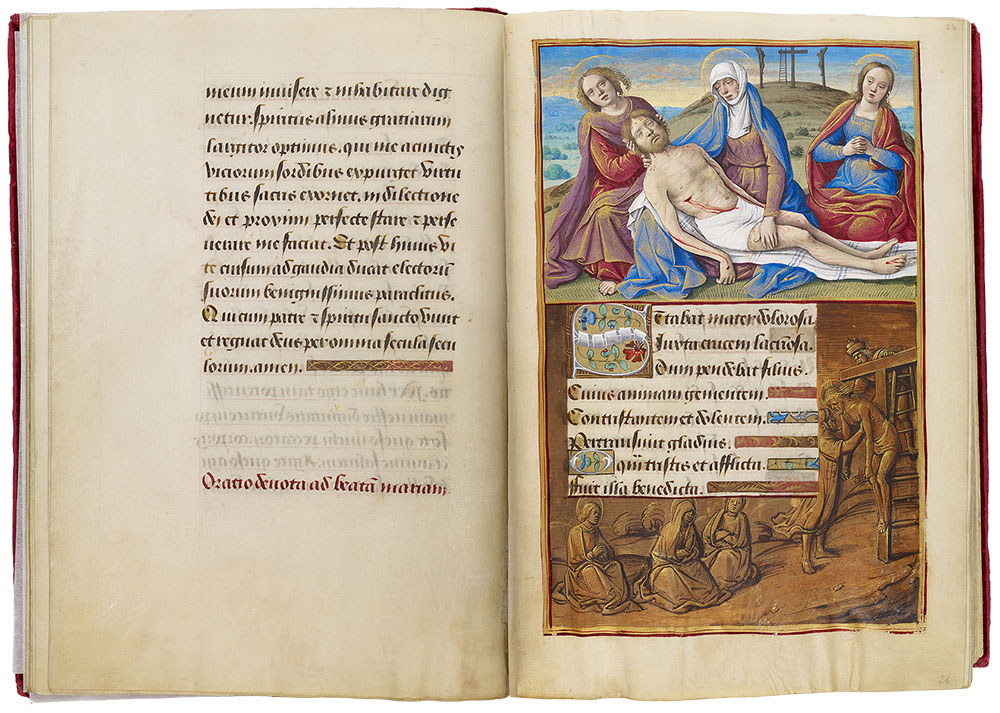
"Stabat mater": Lamentation
Hours of Henry VIII
Illuminated by Jean Poyer
Gift of the Heineman Foundation, 1977
"Stabat mater": Lamentation
Border: Deposition (fol. 26)
The half-page miniature that marks the opening of the "Stabat mater": depicts the Lamentation. The Virgin, flanked by John the Evangelist and Mary Magdalene, holds the dead Christ on her lap. Behind them, on Golgotha, looms the empty Cross; the two thieves have yet to be taken down.
The border illustrates the event that took place just before the Lamentation, the Deposition. The Virgin, again accompanied by John and the Magdalene, awaits the delivery of her dead Son's body by Nicodemus and Joseph of Arimathea.
MS H.8, fols. 26v–27r
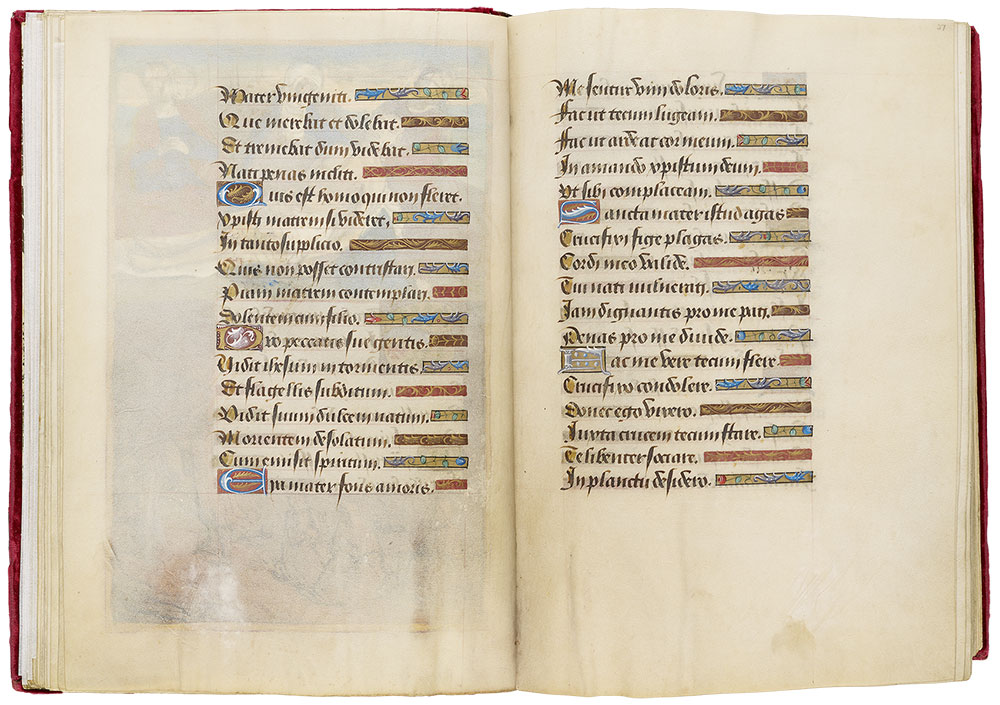
Hours of Henry VIII
Illuminated by Jean Poyer
Gift of the Heineman Foundation, 1977
MS H.8, fols. 27v–28r
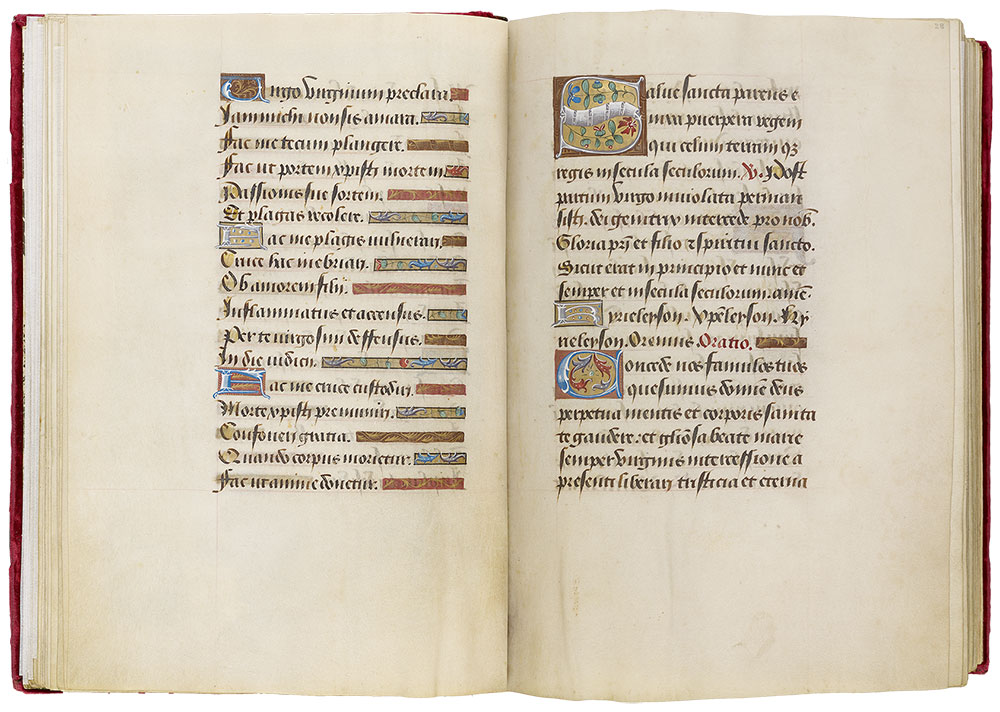
Hours of Henry VIII
Illuminated by Jean Poyer
Gift of the Heineman Foundation, 1977
MS H.8, fols. 28v–29r
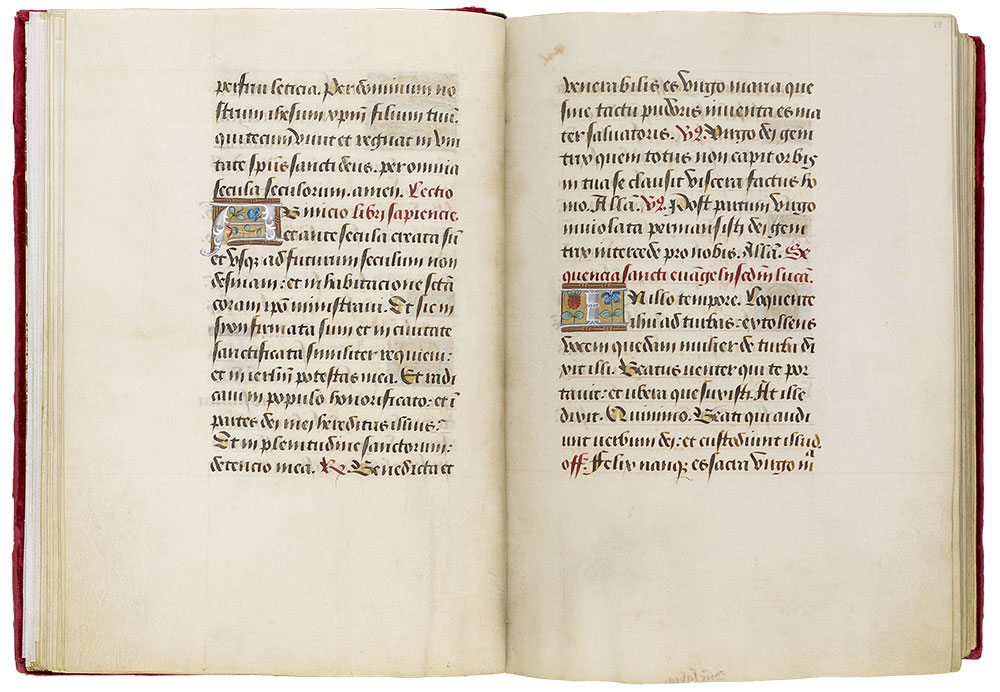
Hours of Henry VIII
Illuminated by Jean Poyer
Gift of the Heineman Foundation, 1977
MS H.8, fols. 29v–30r
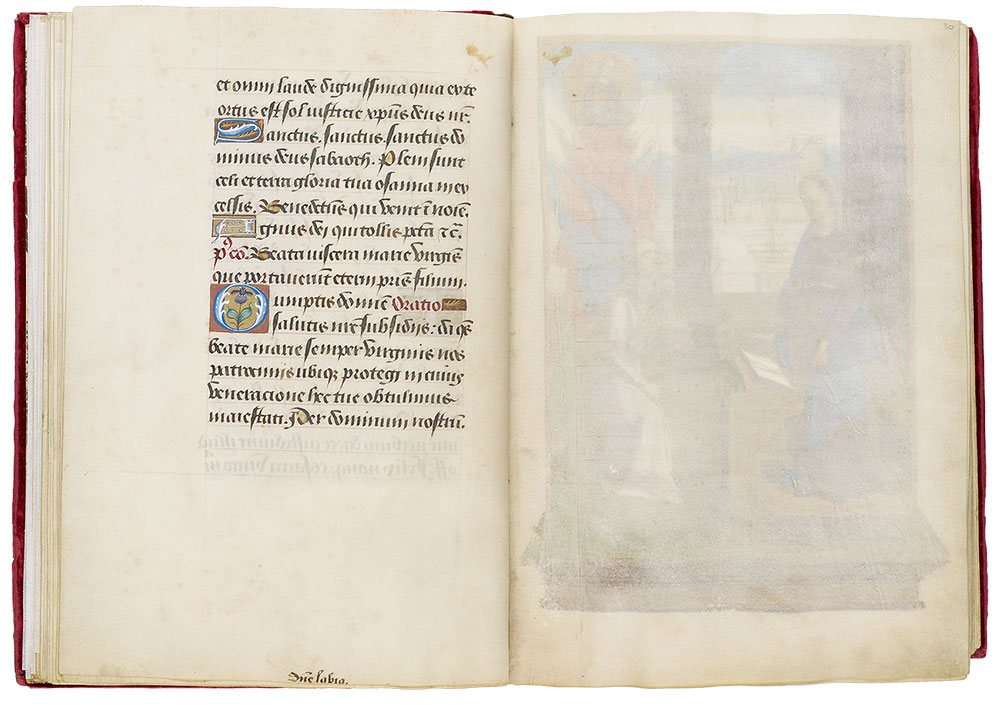
Hours of Henry VIII
Illuminated by Jean Poyer
Gift of the Heineman Foundation, 1977
Hours of the Virgin, fol. 30v
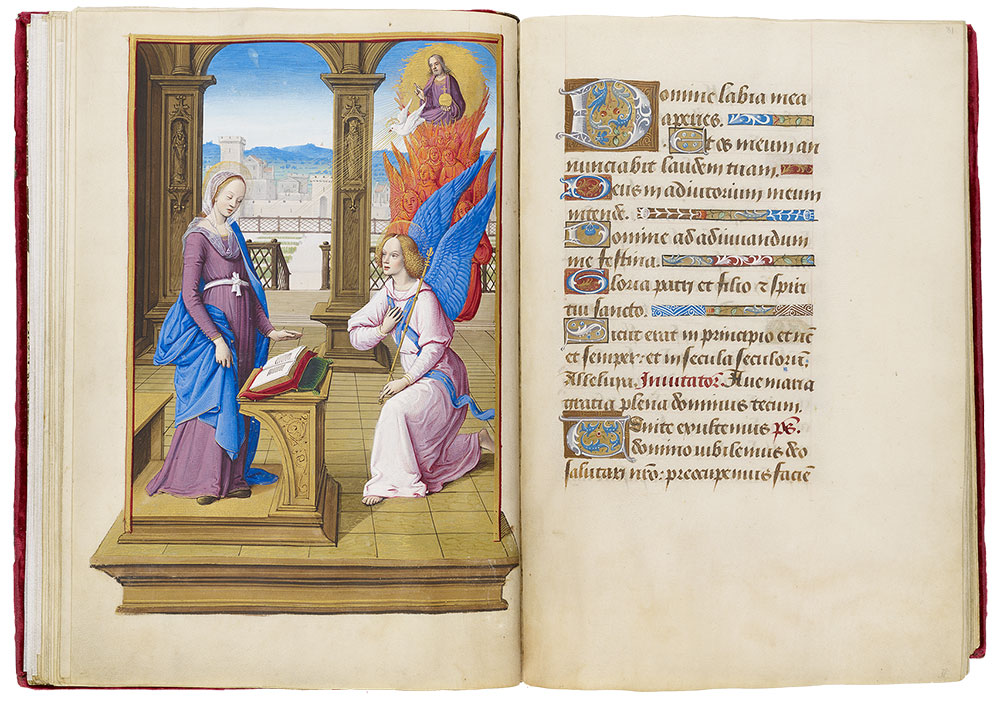
Matins: Annunciation
Hours of Henry VIII
Illuminated by Jean Poyer
Gift of the Heineman Foundation, 1977
Matins: Annunciation (fol. 30v)
The traditional opening miniature in most Hours of the Virgin is the Annunciation. We are about to witness the Incarnation of Christ, when the eternal Son of God took human flesh from his human mother.
The Annunciation takes place in an open portico, whose two arches frame and heighten the figures, while diagonals and orthogonals lead the eye into the garden and distant city, offering testimony to Poyer's legendary skill in the use of perspective.
God the Father, in a flaming aureole supported by a choir of red angels, dispatches the Holy Spirit in the form of a dove, who follows a path of golden rays toward the Virgin. While Poyer may have intended the red angels to be seraphim, the highest order of angels and those closest to God, he gave them full bodies and one rather than three pairs of wings.
Mary, who stands rather than kneels, has her eyes turned downward on an open book in a red chemise binding supported by a green cushion. In Annunciations from the late Middle Ages, these books take on the shape of a Book of Hours. Indeed, the manuscript shown here, in size and layout, is much like the Hours of Henry VIII.
Gabriel, on one knee, holds a scepter surmounted with a fleur- de-lis and wears an alb and a blue stole ornamented with gold crosses, anticipating the priestly vestments worn at Mass and when handling the Blessed Sacrament. (The Eucharist is believed to be the real presence of the Body and Blood of Christ, the human form assumed by God at the Incarnation.)
Hours of the Virgin (fols. 30v–93v)
The Hours of the Virgin are the core text of a Book of Hours and, as their title indicates, are devoted to Mary, the Mother of God. Their importance, moreover, is signaled in the Hours of Henry VIII both by length (some sixty folios) and the richness of its illumination, which includes more than half of the manuscript's full-page miniatures.
MS H.8, fols. 31v–32r
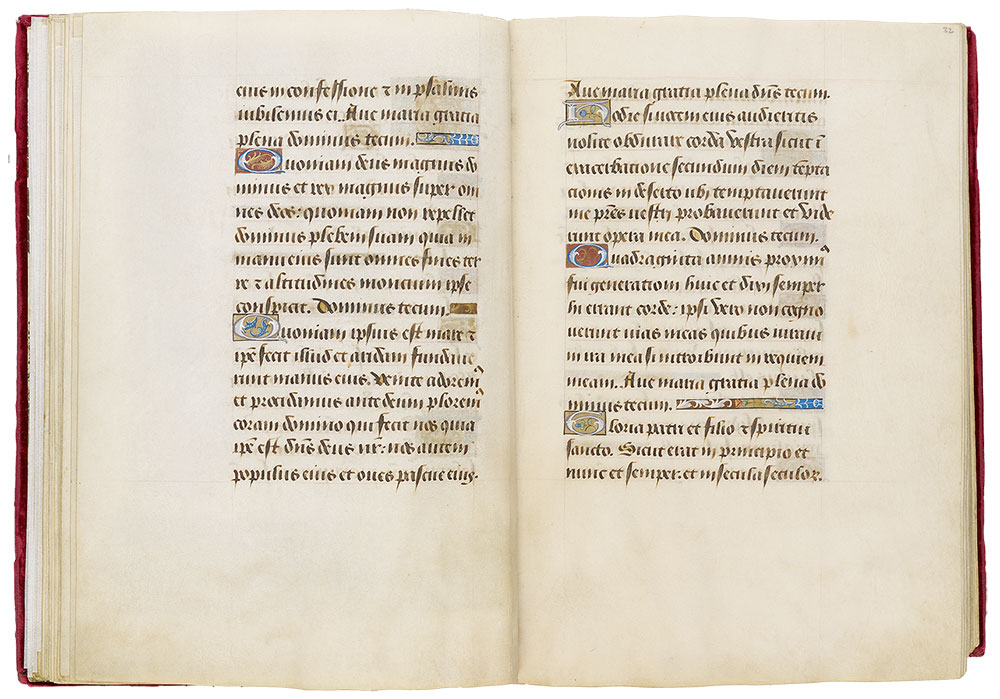
Hours of Henry VIII
Illuminated by Jean Poyer
Gift of the Heineman Foundation, 1977
MS H.8, fols. 32v–33r
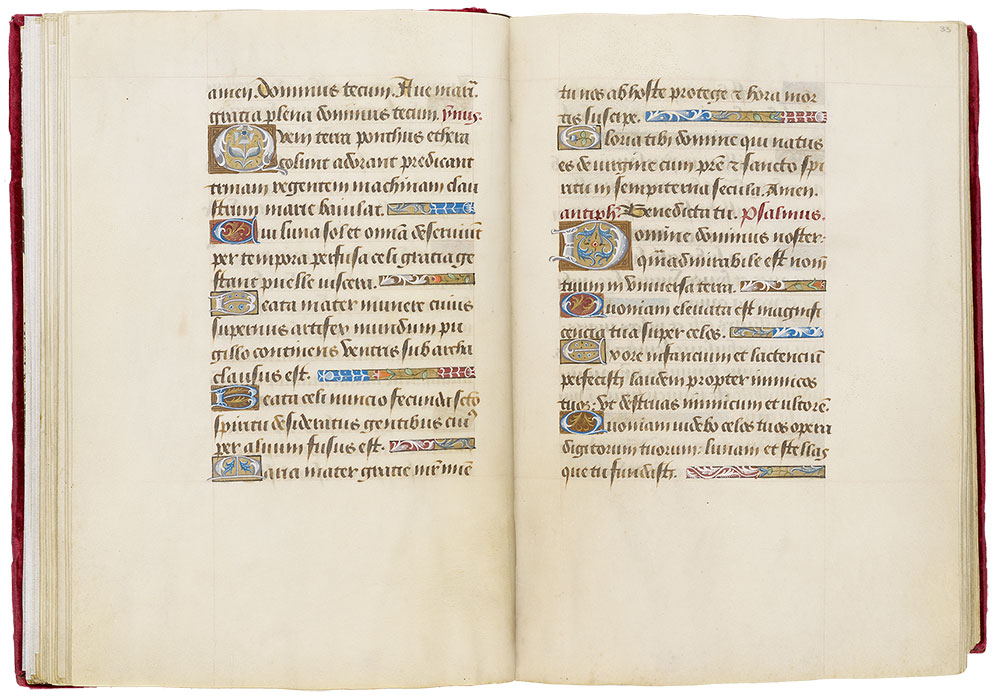
Hours of Henry VIII
Illuminated by Jean Poyer
Gift of the Heineman Foundation, 1977
MS H.8, fols. 33v–34r
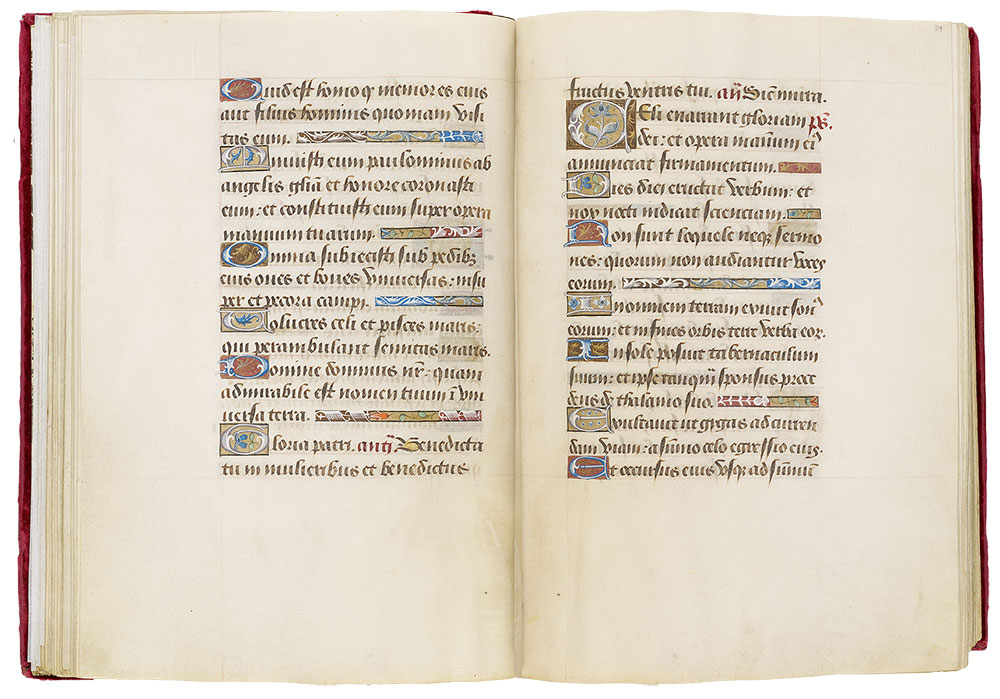
Hours of Henry VIII
Illuminated by Jean Poyer
Gift of the Heineman Foundation, 1977
MS H.8, fols. 34v–35r
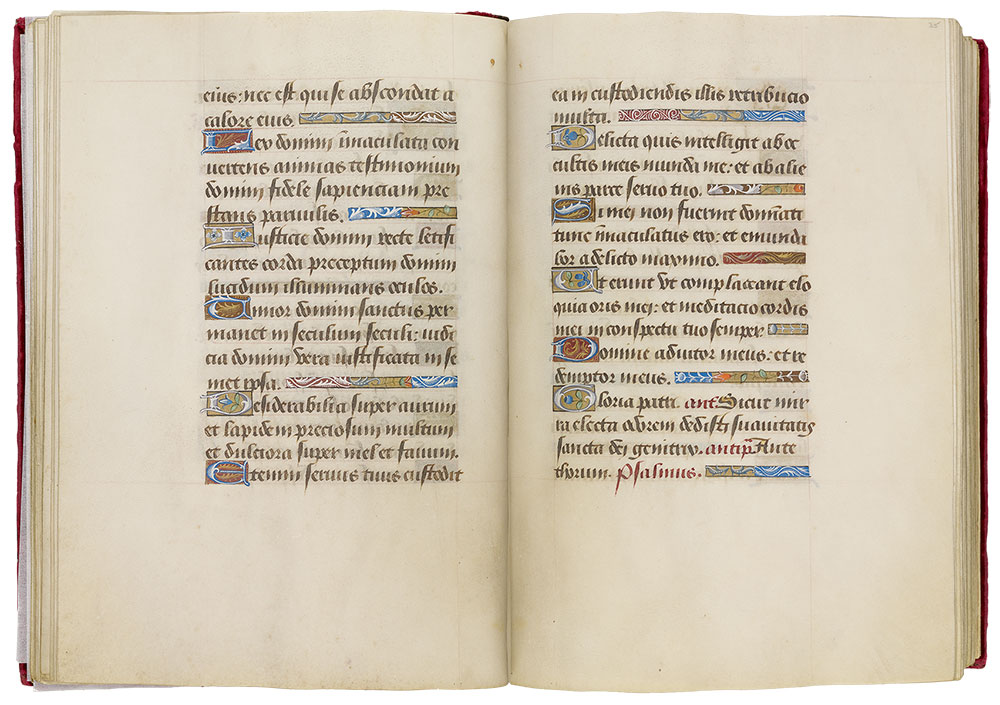
Hours of Henry VIII
Illuminated by Jean Poyer
Gift of the Heineman Foundation, 1977
MS H.8, fols. 35v–36r
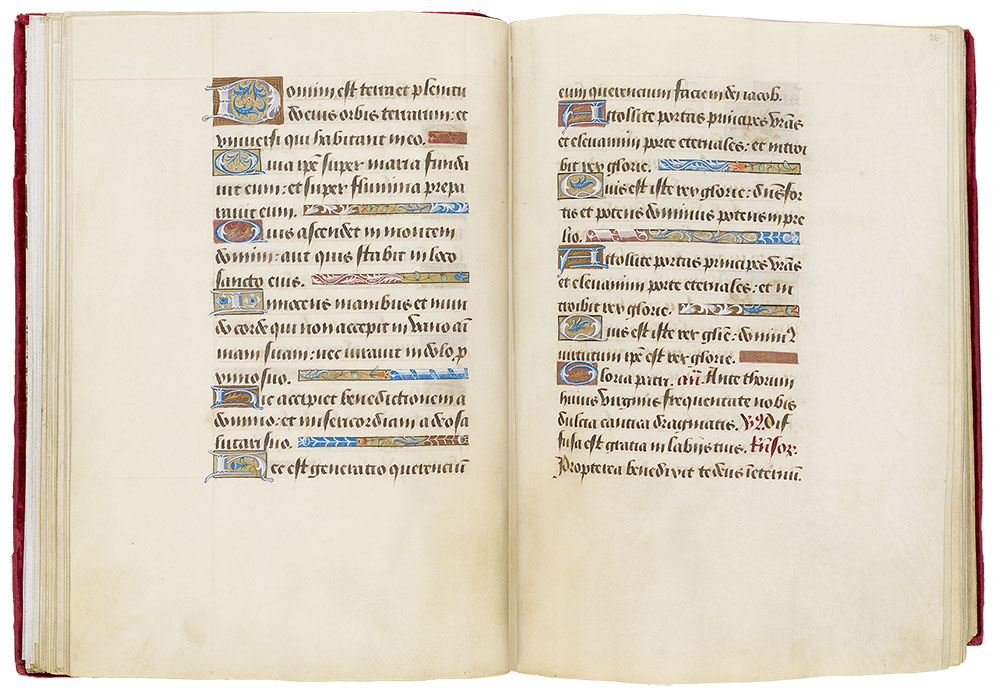
Hours of Henry VIII
Illuminated by Jean Poyer
Gift of the Heineman Foundation, 1977
MS H.8, fols. 36v–37r
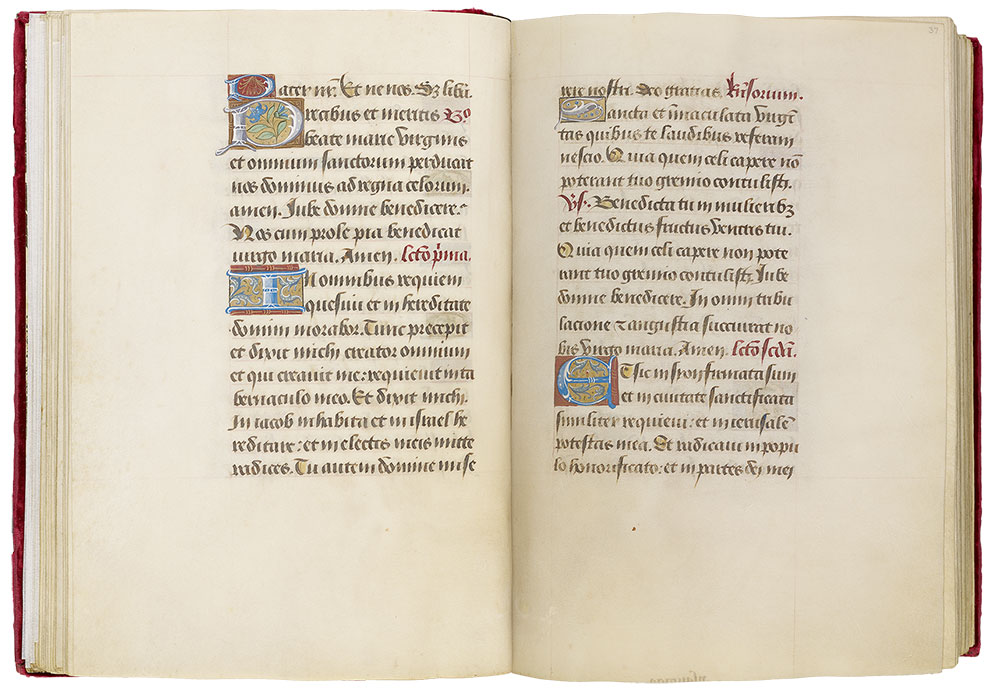
Hours of Henry VIII
Illuminated by Jean Poyer
Gift of the Heineman Foundation, 1977
MS H.8, fols. 37v–38r
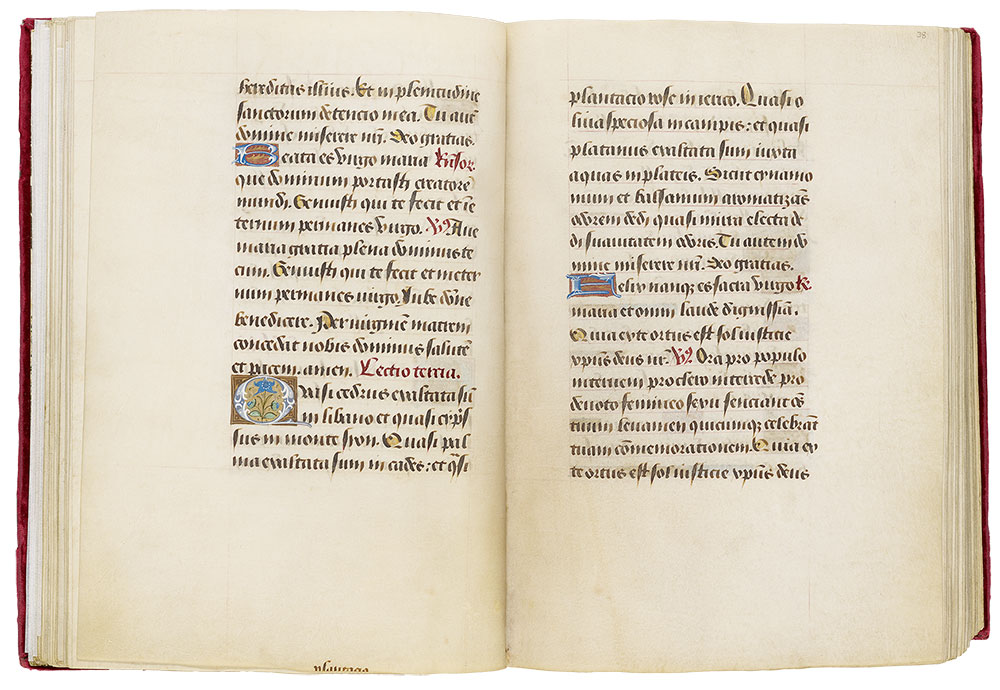
Hours of Henry VIII
Illuminated by Jean Poyer
Gift of the Heineman Foundation, 1977
MS H.8, fols. 38v–39r
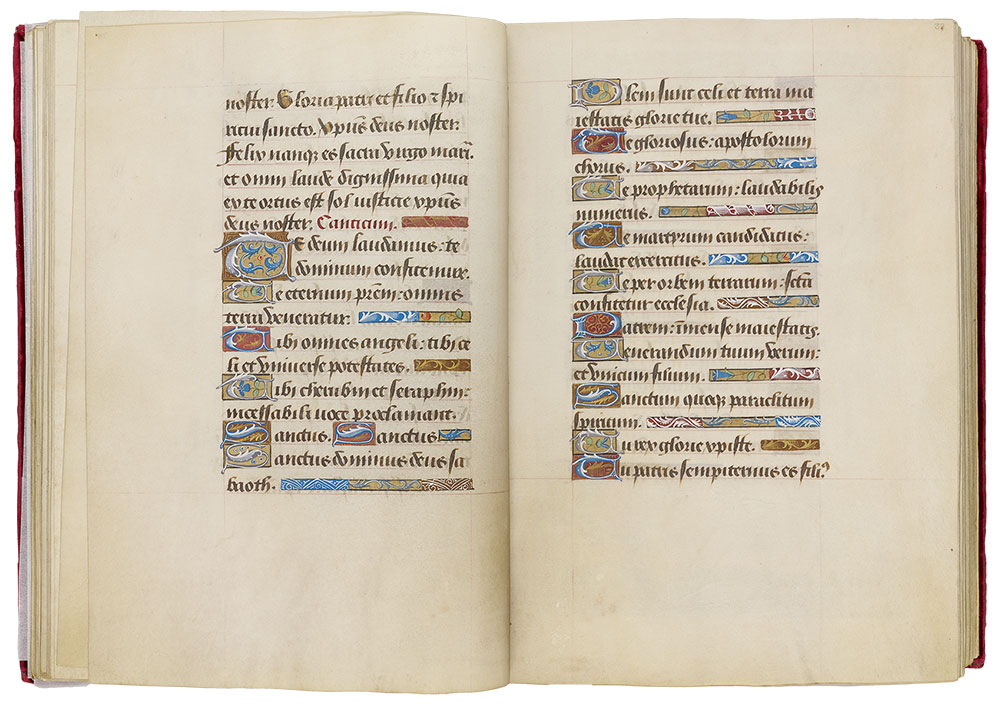
Hours of Henry VIII
Illuminated by Jean Poyer
Gift of the Heineman Foundation, 1977
MS H.8, fols. 39v–40r
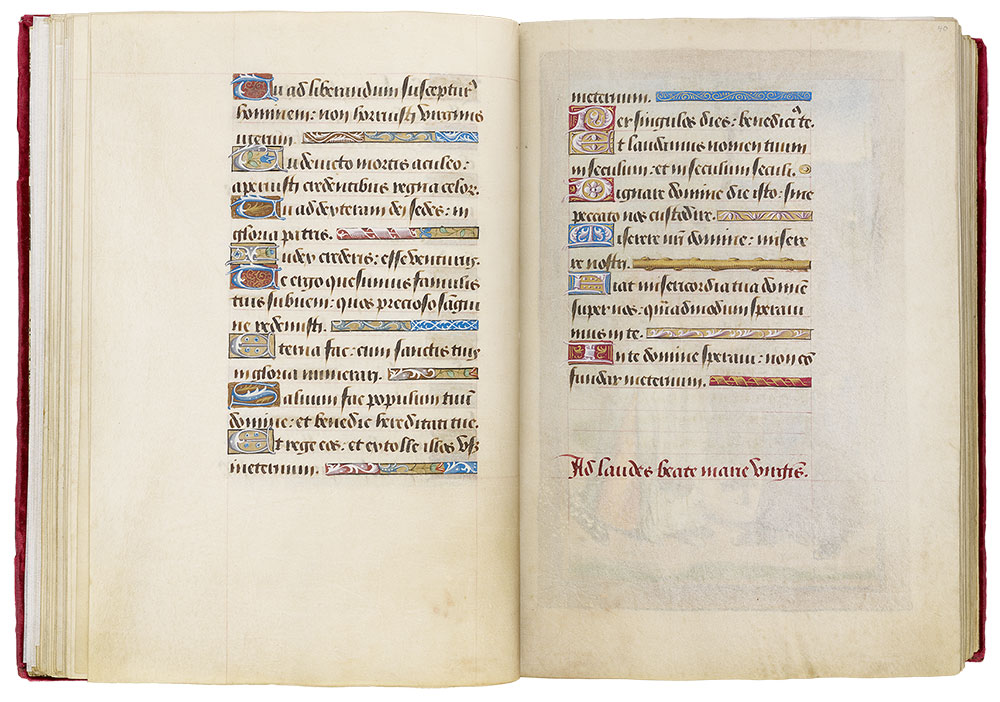
Hours of Henry VIII
Illuminated by Jean Poyer
Gift of the Heineman Foundation, 1977
MS H.8, fols. 40v–41r
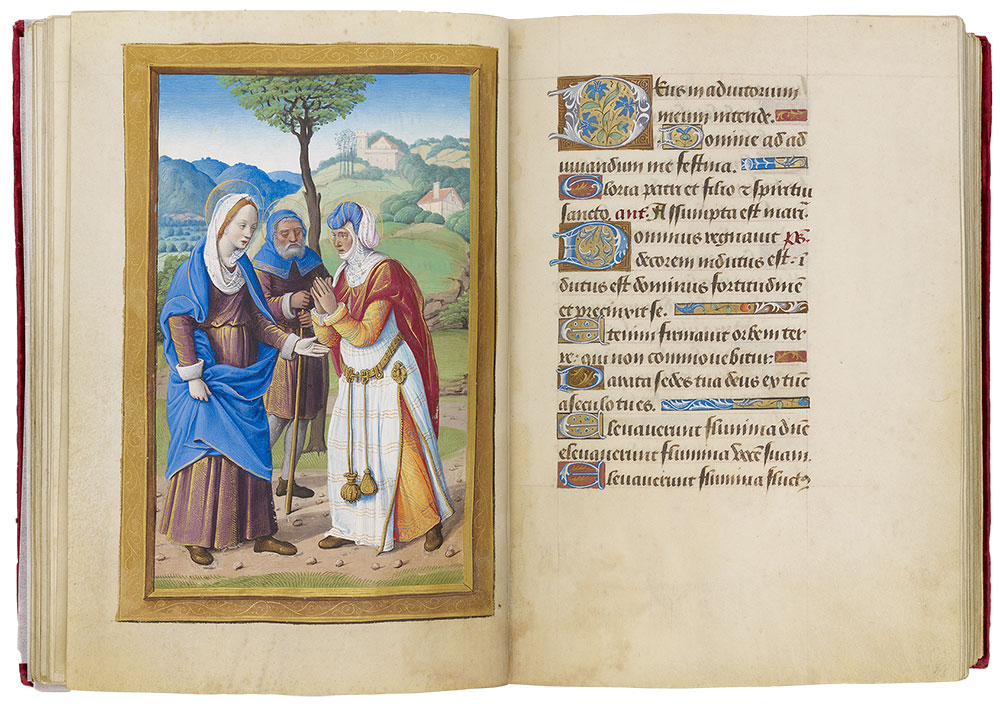
Lauds: Visitation
Hours of Henry VIII
Illuminated by Jean Poyer
Gift of the Heineman Foundation, 1977
Lauds: Visitation (fol. 40v)
According to Luke (1:36–56), Gabriel also told the Virgin that her cousin Elizabeth, in her old age, also had conceived a son. Soon thereafter, to rejoice, Mary went to visit her cousin, who was six months pregnant with John the Baptist. (Elizabeth was barren until Gabriel appeared to Zacharias, her husband, telling him that his wife would bear him a son that he should name John.)
The burlet on Elizabeth's head, as well as the two purses hanging from her elaborate gold belt, give her an exotic appearance. The man standing behind the pair—his eyes half shut—is Joseph.
When the Virgin entered Elizabeth's house and greeted the infant John leaped in her womb and she was filled with the Holy Spirit. Here, however, as this scene is usually depicted, the meeting takes place outdoors; the Virgin extends her hand to Elizabeth, who folds her hands in prayerful recognition of the forthcoming Savior.
MS H.8, fols. 41v–42r
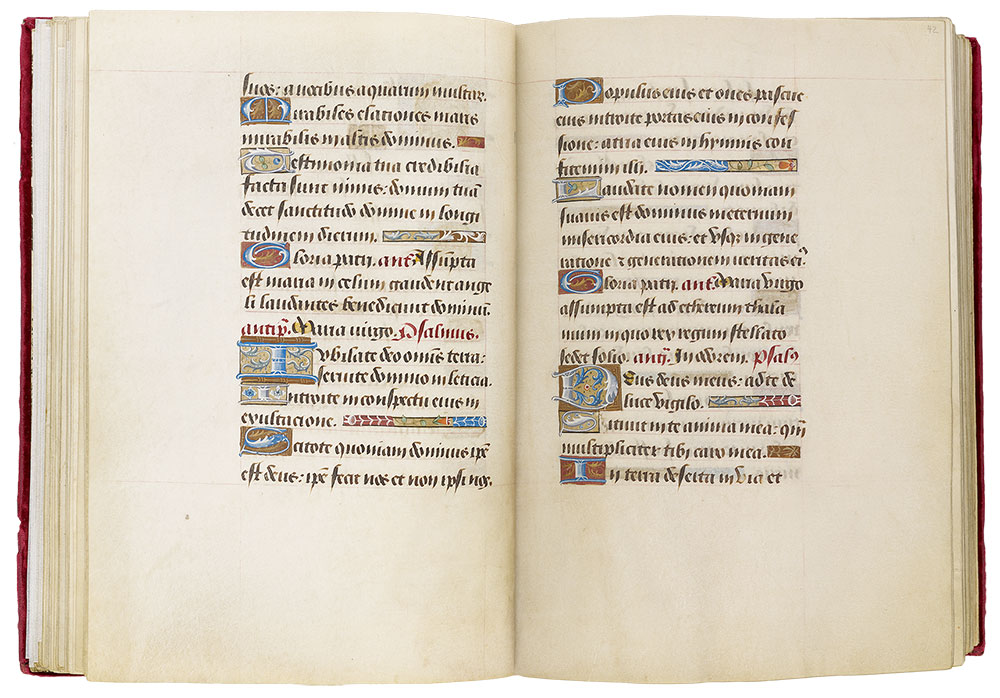
Hours of Henry VIII
Illuminated by Jean Poyer
Gift of the Heineman Foundation, 1977
MS H.8, fols. 42v–43r
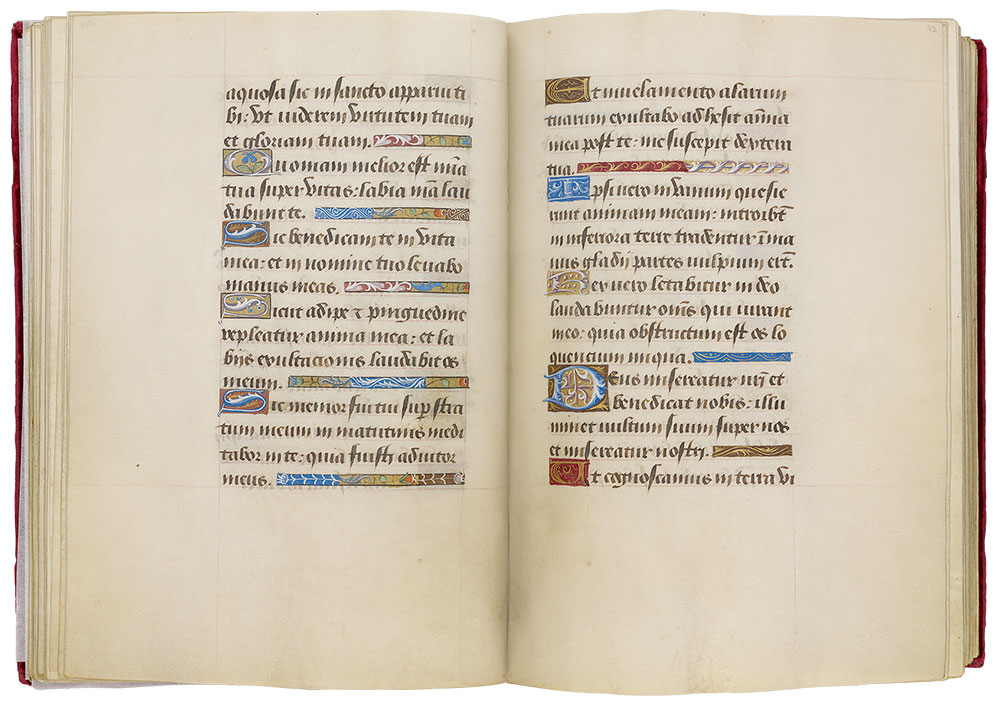
Hours of Henry VIII
Illuminated by Jean Poyer
Gift of the Heineman Foundation, 1977
MS H.8, fols. 43v–44r
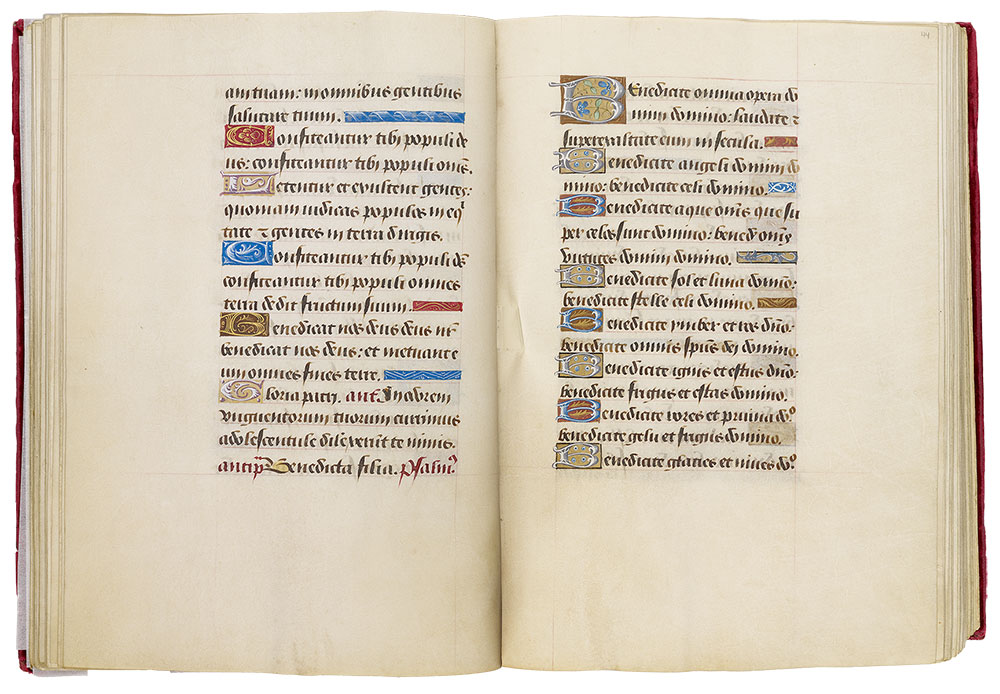
Hours of Henry VIII
Illuminated by Jean Poyer
Gift of the Heineman Foundation, 1977
MS H.8, fols. 44v–45r
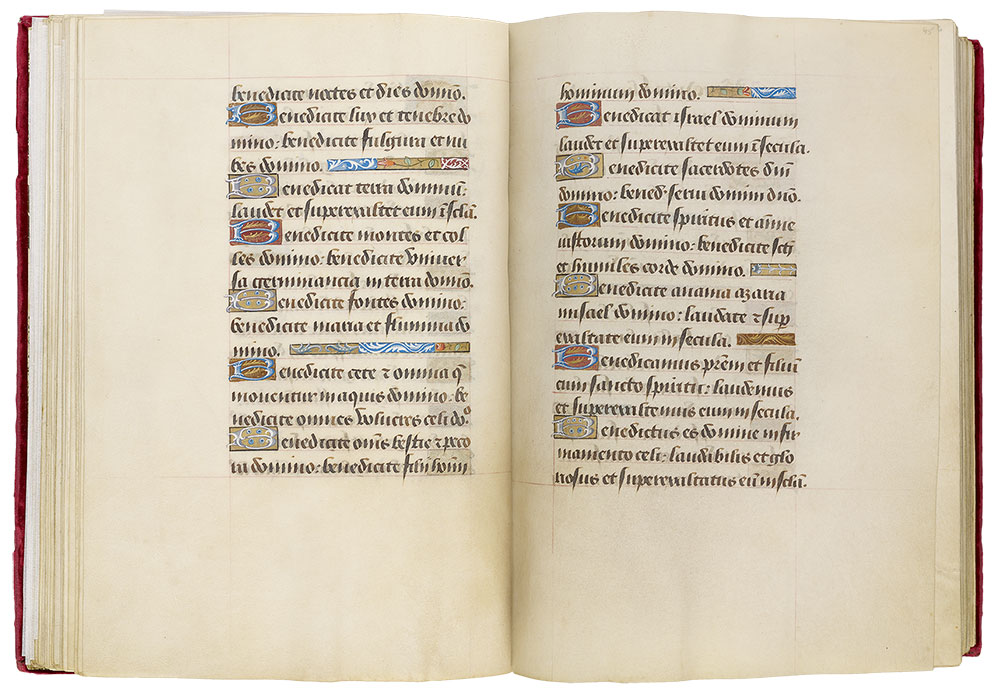
Hours of Henry VIII
Illuminated by Jean Poyer
Gift of the Heineman Foundation, 1977
MS H.8, fols. 45v–46r
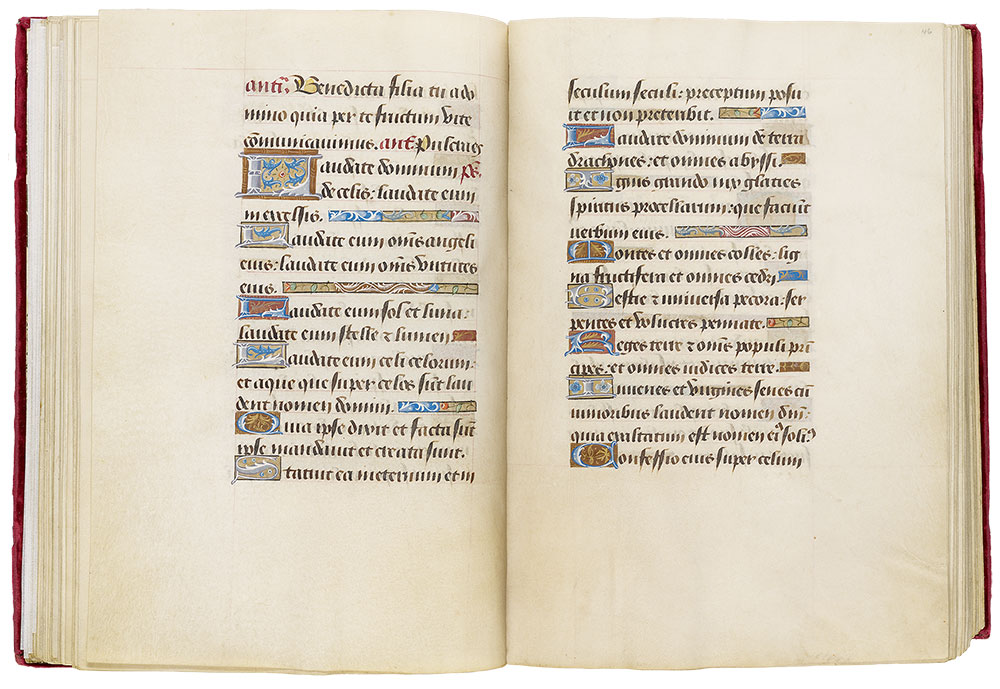
Hours of Henry VIII
Illuminated by Jean Poyer
Gift of the Heineman Foundation, 1977
MS H.8, fols. 46v–47r
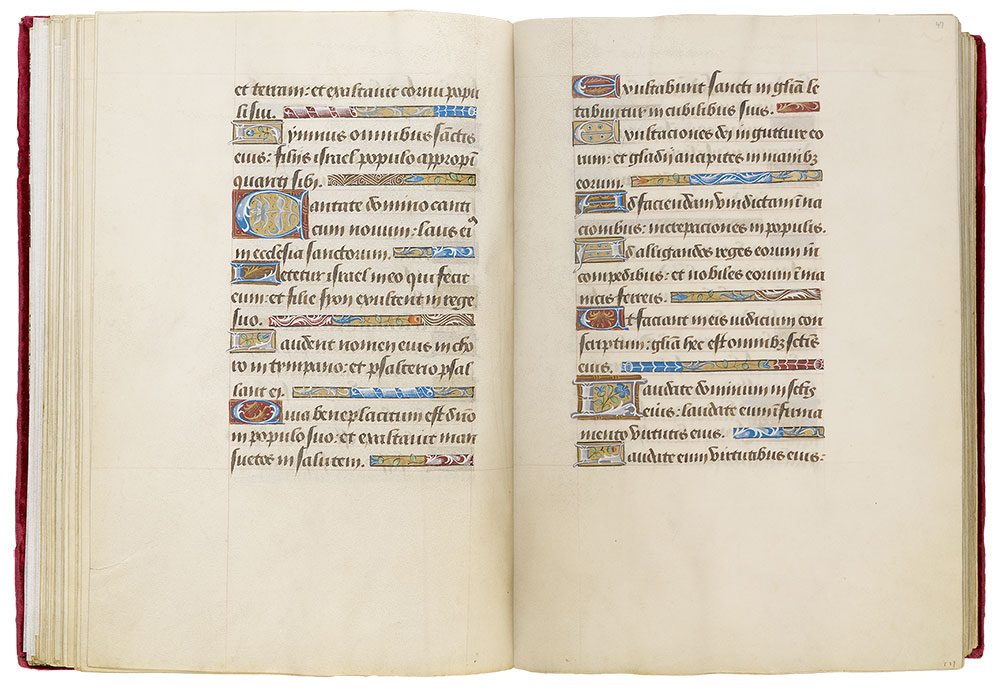
Hours of Henry VIII
Illuminated by Jean Poyer
Gift of the Heineman Foundation, 1977
MS H.8, fols. 47v–48r
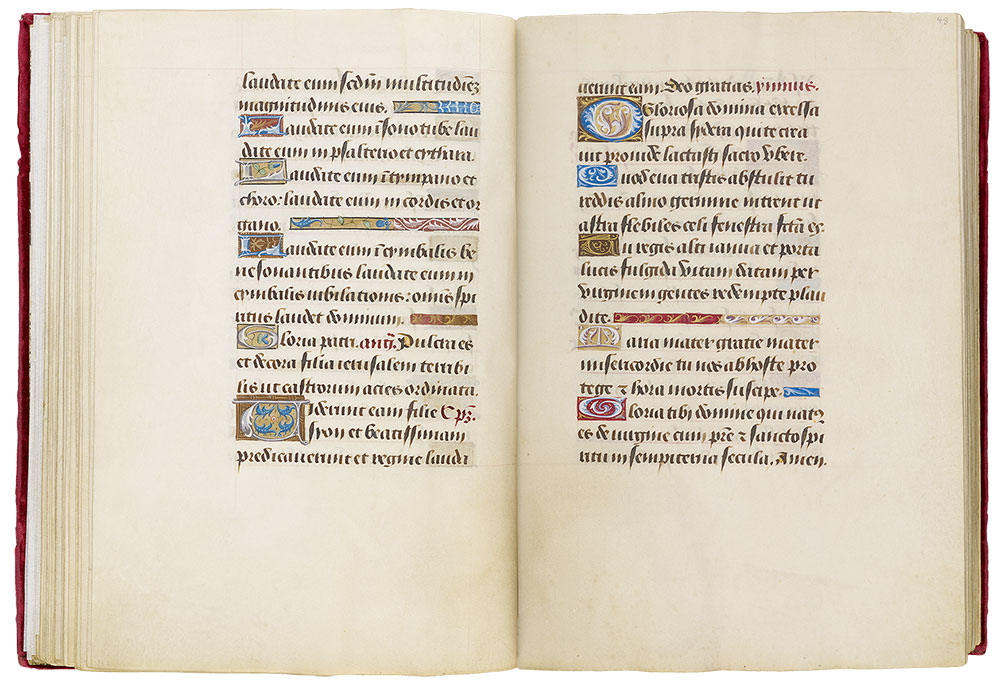
Hours of Henry VIII
Illuminated by Jean Poyer
Gift of the Heineman Foundation, 1977
MS H.8, fols. 48v–49r
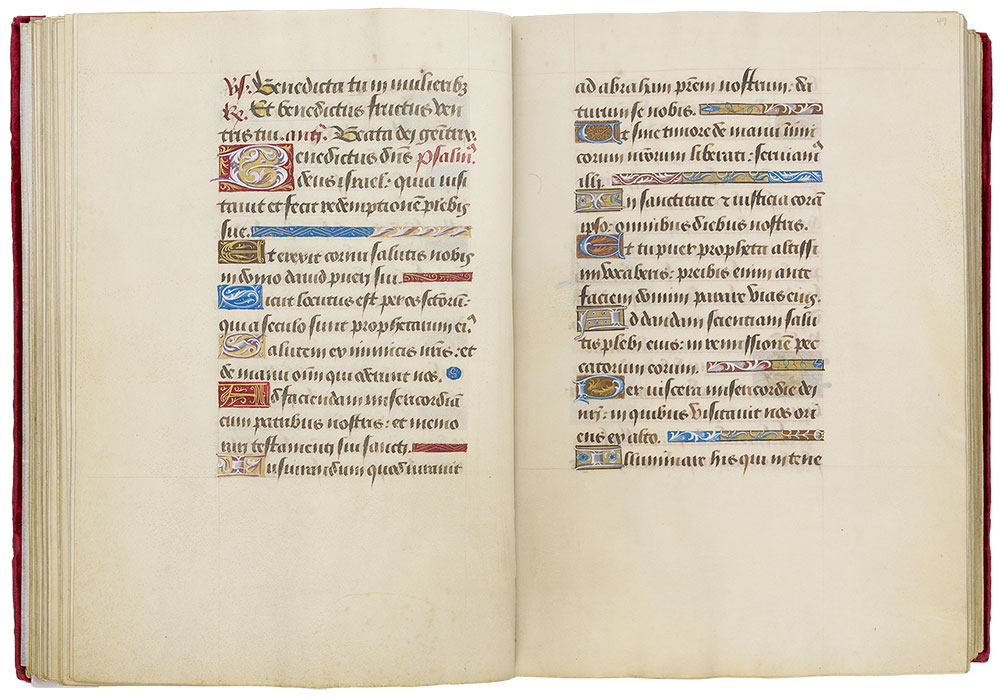
Hours of Henry VIII
Illuminated by Jean Poyer
Gift of the Heineman Foundation, 1977
MS H.8, fols. 49v–50r
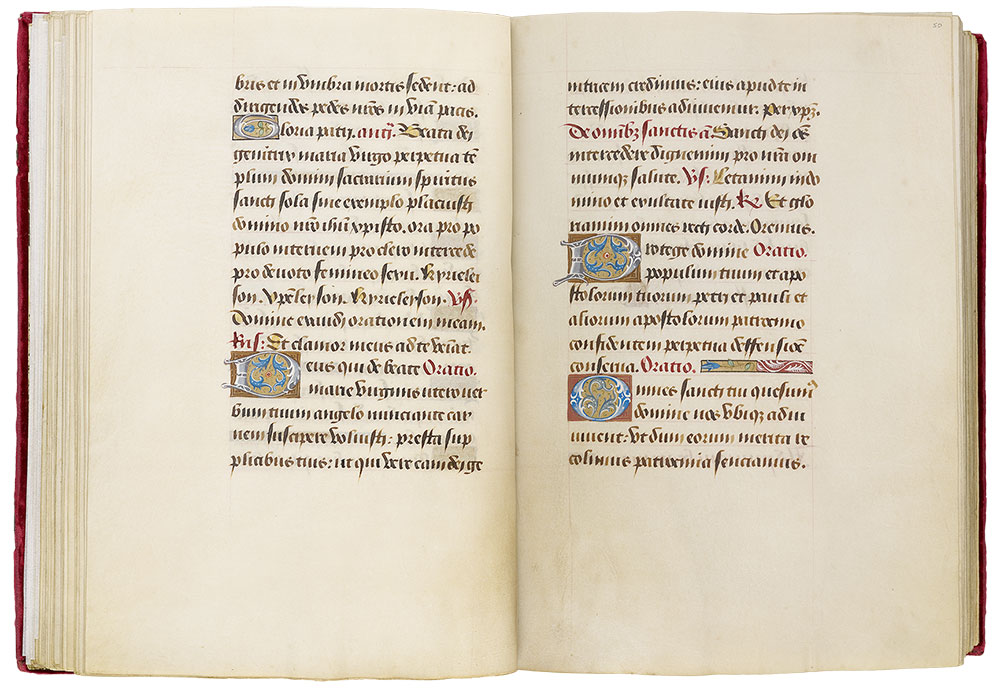
Hours of Henry VIII
Illuminated by Jean Poyer
Gift of the Heineman Foundation, 1977
MS H.8, fols. 50v–51r
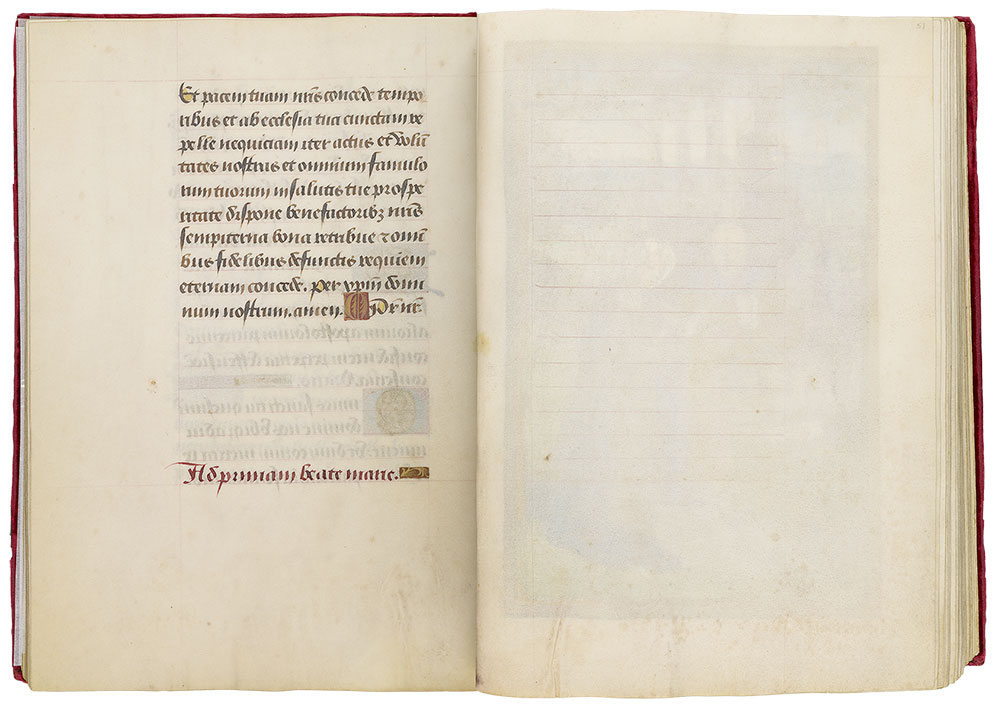
Hours of Henry VIII
Illuminated by Jean Poyer
Gift of the Heineman Foundation, 1977
MS H.8, fols. 51v–52r
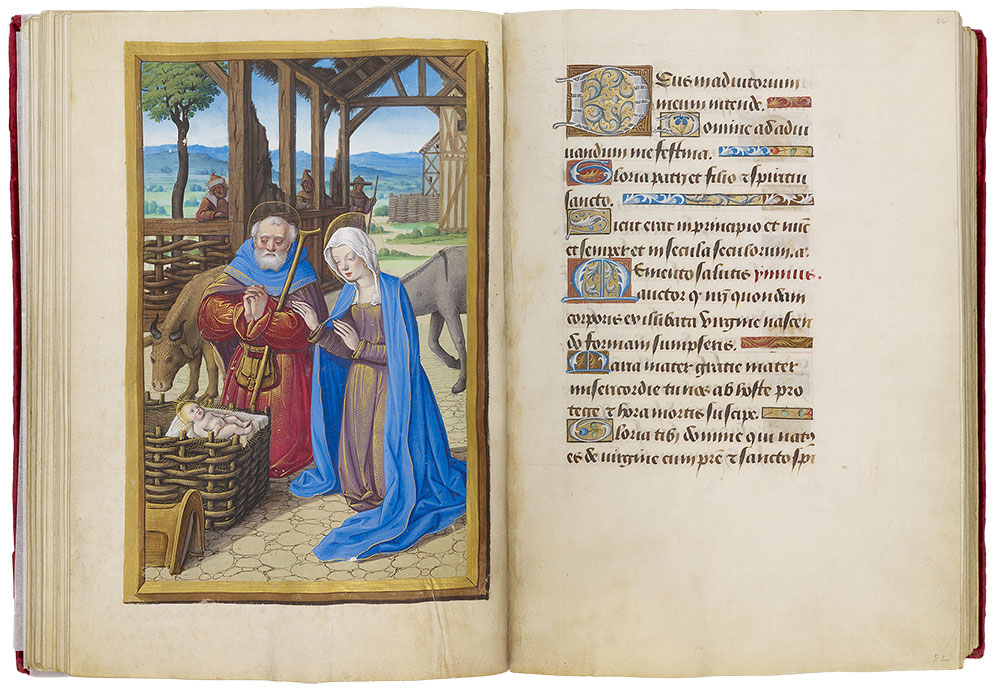
Prime: Nativity
Hours of Henry VIII
Illuminated by Jean Poyer
Gift of the Heineman Foundation, 1977
Prime: Nativity (fol. 51v)
Of the four evangelists, only Luke (2:7) provides details, though scant, concerning the Nativity: "And she brought forth her firstborn son, and wrapped him in swaddling clothes, and laid him in a manger, because there was no room for them in the inn." Here, however, the child is shown naked, revealing his maleness, and golden rays emanate from his body.
Details about the Nativity derive from the Revelations of St. Bridget of Sweden (c. 1303–73), which influenced depictions of the Birth of Christ in the fifteenth and sixteenth centuries. According to Bridget, an ineffable light and splendor radiated from the child. In her description of the scene, St. Bridget notes that the shepherds—three are peering from the background—uninformed whether the child was male or female, wished to confirm that the child was indeed male; they knew that the Messiah should be a son.
The presence of the ox and ass, not mentioned by the Gospels but included by Bridget, had already been exegetically connected with the Nativity because they were thought to fulfill the prophecy of Isaiah (1:3) that the "ox knoweth his owner, and the ass his master's crib."
Sometimes, as here, the animals are not equal witnesses, but represent the contrast between the Old and New Dispensation, or the Old and New Law. The ox, symbolizing the New Law (of Christ) knowingly looks on, while the view of the other, the Old Law (of Moses), is obscured behind the Virgin, and thus uncomprehending. After the birth, said Bridget, the Virgin immediately worshiped the child, as did Joseph.
The partially obscured object in the lower left corner is the saddle upon which Mary rode during her trip to Bethlehem, where the prophets said that the Messiah would be born.
MS H.8, fols. 52v–53r
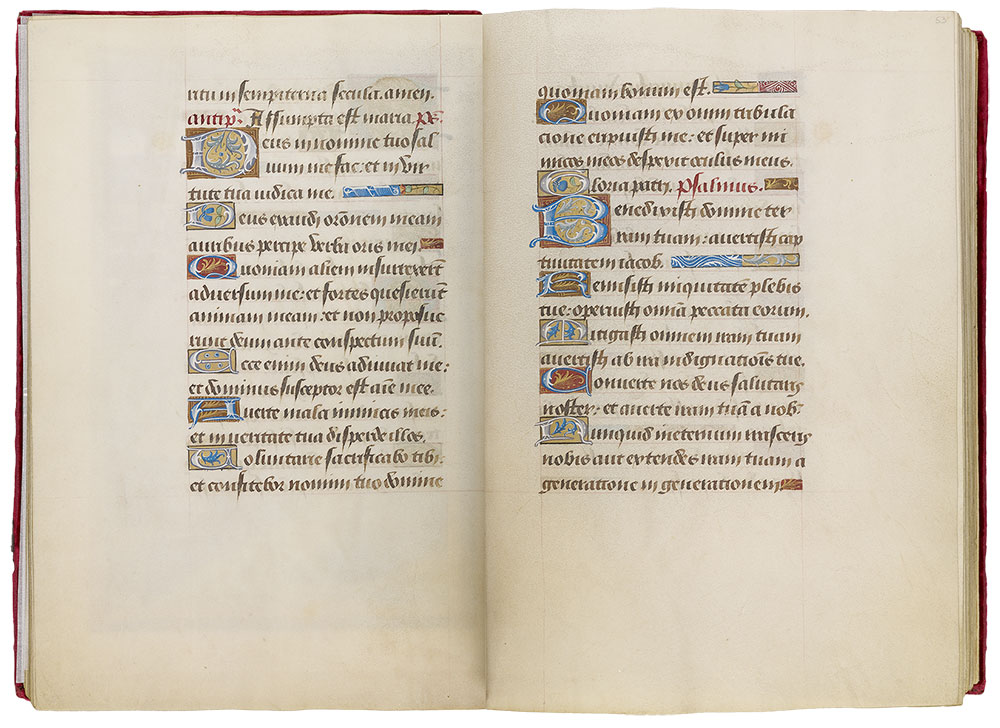
Hours of Henry VIII
Illuminated by Jean Poyer
Gift of the Heineman Foundation, 1977
MS H.8, fols. 53v–54r
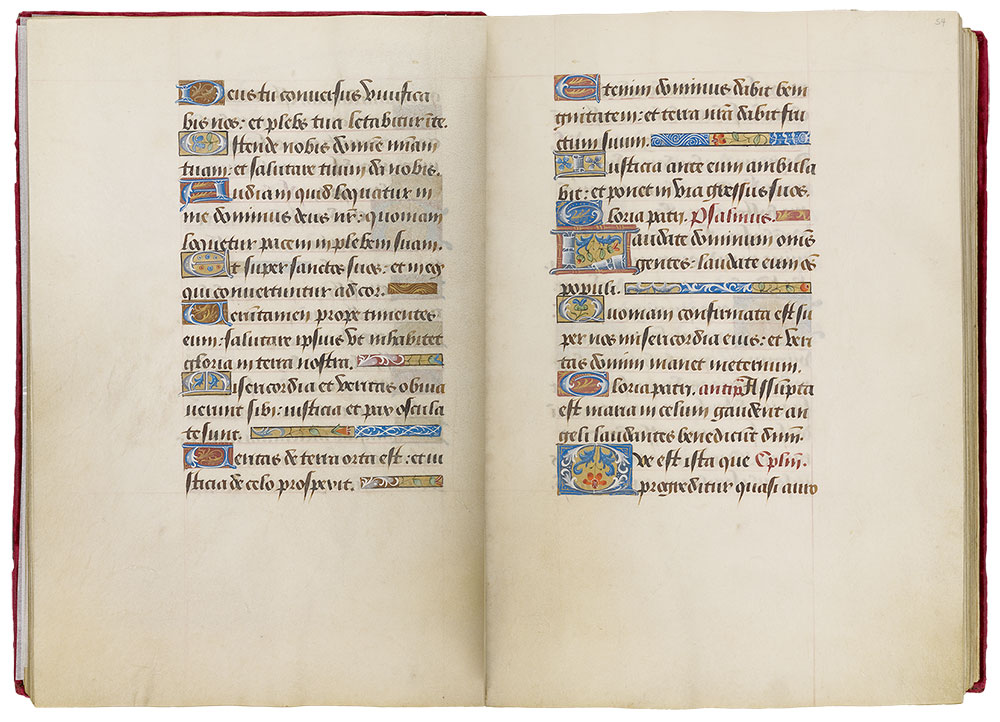
Hours of Henry VIII
Illuminated by Jean Poyer
Gift of the Heineman Foundation, 1977
MS H.8, fols. 54v–55r
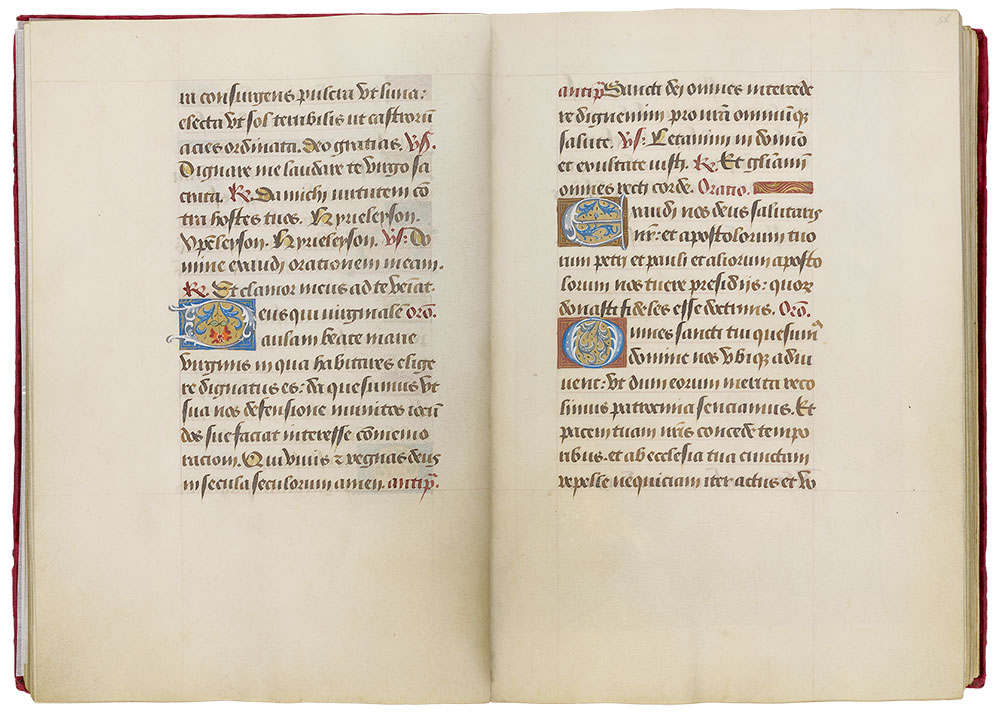
Hours of Henry VIII
Illuminated by Jean Poyer
Gift of the Heineman Foundation, 1977
MS H.8, fols. 55v–56r
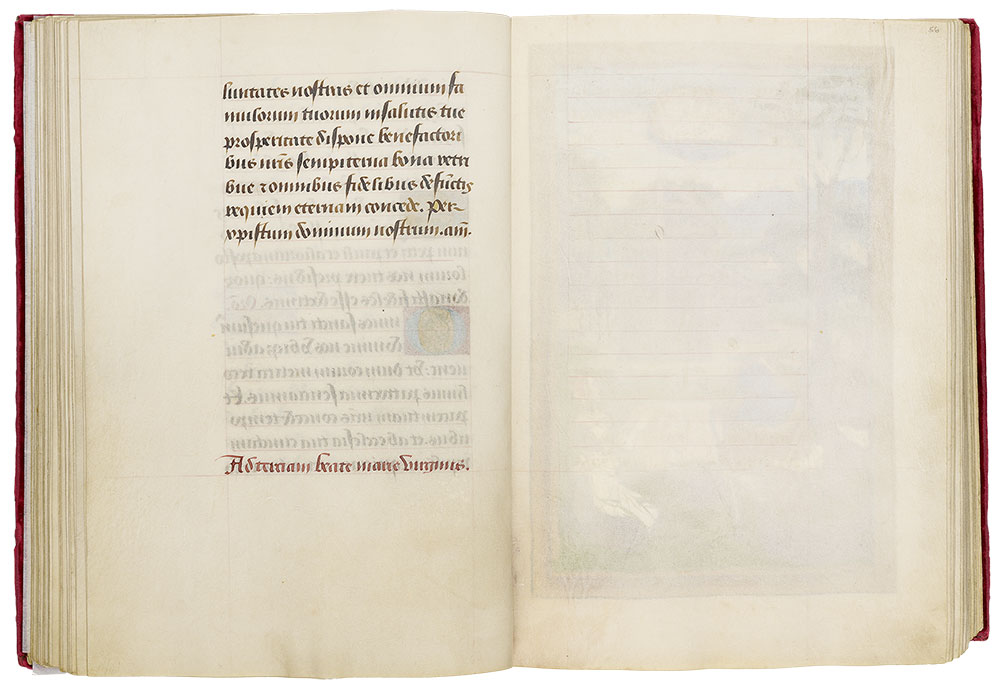
Hours of Henry VIII
Illuminated by Jean Poyer
Gift of the Heineman Foundation, 1977
MS H.8, fols. 56v–57r
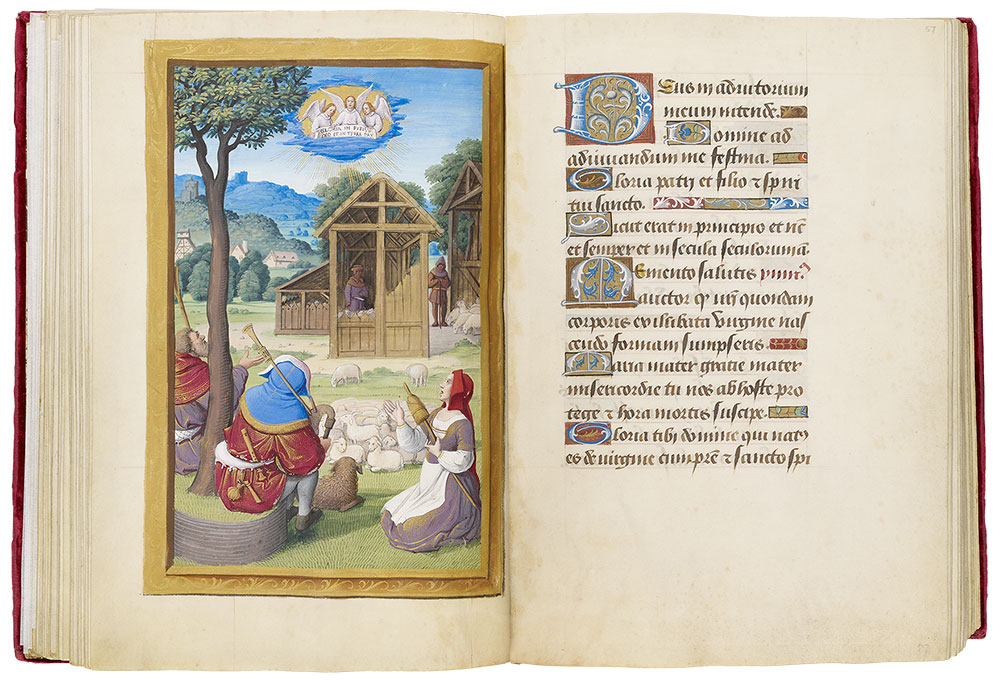
Terce: Annunciation to the Shepherds
Hours of Henry VIII
Illuminated by Jean Poyer
Gift of the Heineman Foundation, 1977
Terce: Annunciation to the Shepherds (fol. 56v)
The Annunciation to the Shepherds, like the Nativity, is only recounted by Luke (2:8–14). Poyer, however, chose not to emphasize the nocturnal appearance of the single annunciatory angel amid the brightness of God but the later moment when the angel, joined by others from the heavenly hosts, sang the familiar "Glory to God in the Highest, and peace on earth to men of good will."
Poyer illustrates the Angels of the Annunciation singing their familiar "Glory to God in the Highest, and on earth peace to men of good will" by adding the text on the scroll that they present: Gloria in exelssi [sic: excelsis] Deo et in terra pax.
Wooden sheds in the background contain more sheep and two shepherds who are not yet aware of the angel's good tidings.
Three shepherds in the fore- ground, seen from the back or side, look up and receive the tidings. One holds a staff while another with a bagpipe has a second instrument—a flute— tucked into his belt; the shepherdess holds a distaff.
One wonders if the solitary and prominently placed goat amid the sheep would have recalled Matthew 25:32, where the future Son of Man would come to judge and separate the blessed from the evil, "just as the shepherd separates the sheep from the goats."
MS H.8, fols. 57v–58r
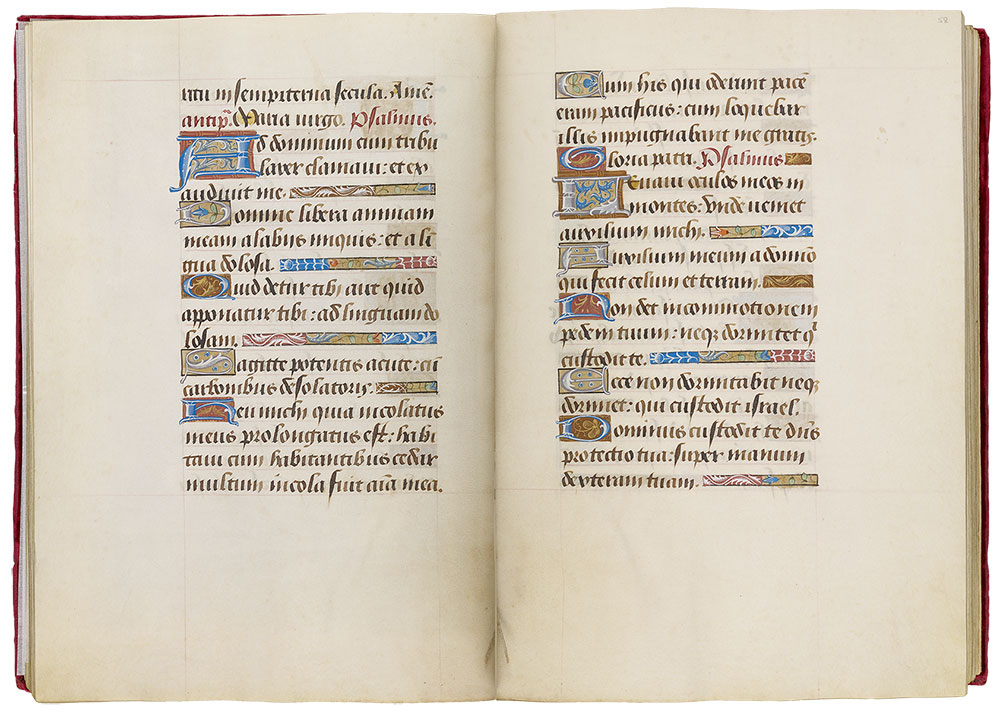
Hours of Henry VIII
Illuminated by Jean Poyer
Gift of the Heineman Foundation, 1977
MS H.8, fols. 58v–59r
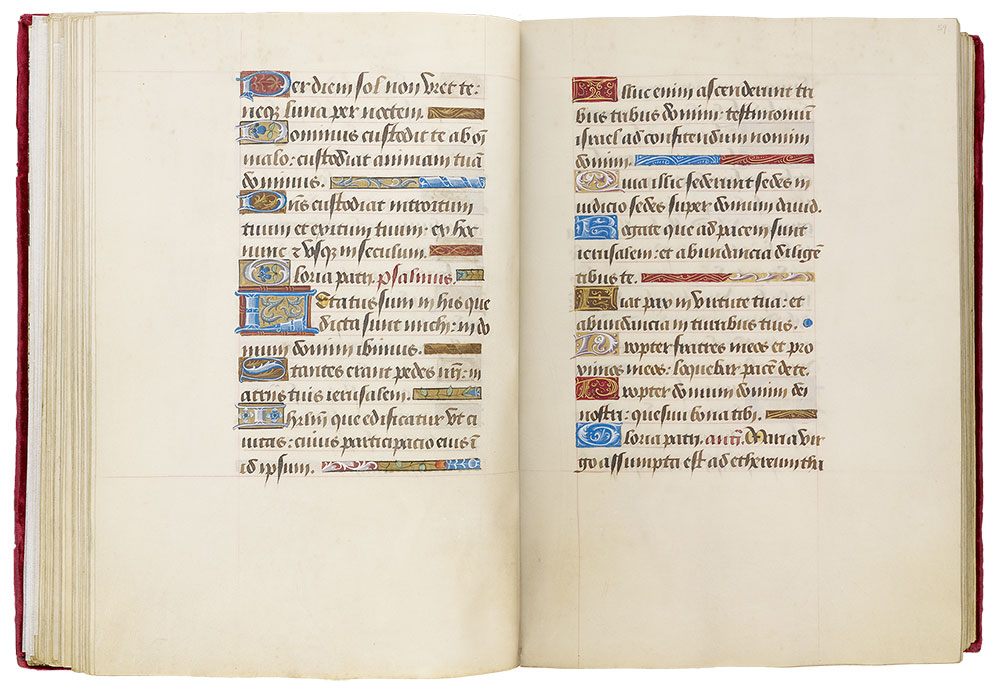
Hours of Henry VIII
Illuminated by Jean Poyer
Gift of the Heineman Foundation, 1977
MS H.8, fols. 59v–60r
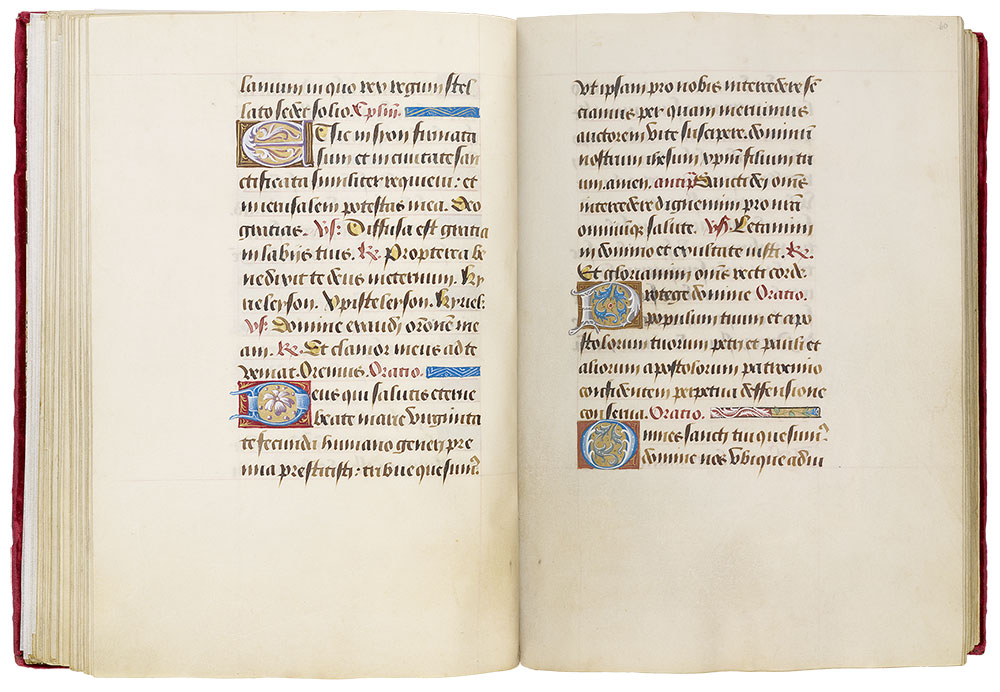
Hours of Henry VIII
Illuminated by Jean Poyer
Gift of the Heineman Foundation, 1977
MS H.8, fols. 60v–61r
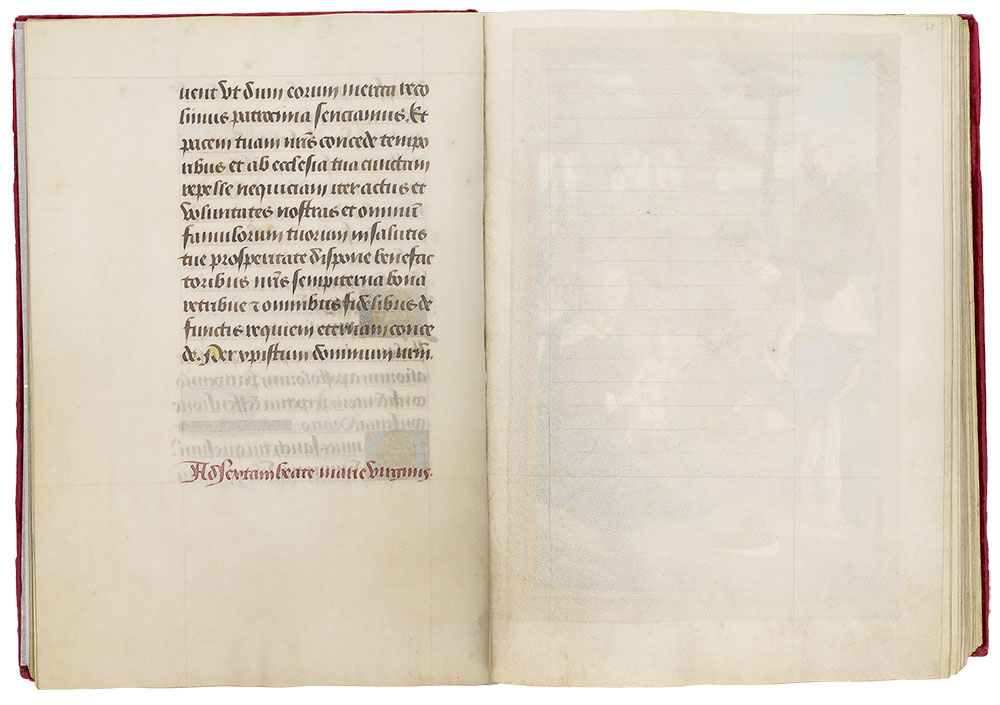
Hours of Henry VIII
Illuminated by Jean Poyer
Gift of the Heineman Foundation, 1977
MS H.8, fols. 61v–62r
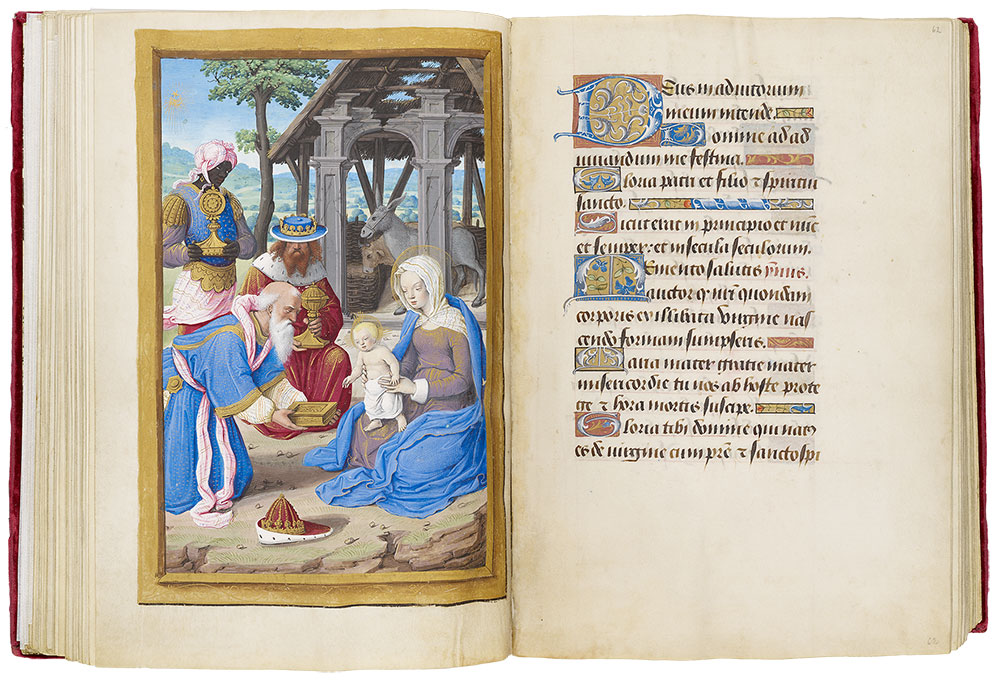
Sext: Adoration of the Magi
Hours of Henry VIII
Illuminated by Jean Poyer
Gift of the Heineman Foundation, 1977
Sext: Adoration of the Magi (fol. 61v)
In Poyer's Adoration, the Virgin, in an act of humility, sits on the ground as each of the Magi presents his gift to the child standing on her lap. The innate nobility of the Magus is achieved by some of Poyer's most inspired painting, especially evident in his closely observed facial features, gold earring, and exotic turban.
Caspar, the name supplied for the oldest Magus, has removed his crown in deference to Christ as King, kneels and presents gold; the second, holding a chalice with incense, waits his turn; while the youngest, still at a distance, stands erect and holds a monstrance.
Poyer designed his compositions like stage sets: the ruinous stone arches of the stable will reappear in the Massacre of the Innocents (cf. folio 69v), and the ox and ass eat hay from the wattled manger that previously served as Christ's cradle.
In the later Middle Ages, when the Magi were connected with the three continents known then (Europe, Africa, Asia), Balthazar was increasingly depicted as a black man. In some late- fifteenth-century paintings, however, as here, it was the youngest Magus who was so depicted.
Adoration of the Magi
According to the Gospel of Matthew (2:1–12), wise men from the East who saw the star signifying the birth of the King of the Jews went to adore him at Jerusalem, only to discover that he was born in Bethlehem (fulfilling the prophecy of Micheas 5:2). Since the wise men offered three gifts—gold, frankincense, and myrrh—it was assumed as early as the third century that they were three; about the same time they were redefined as kings, and by the ninth century they were supplied with the familiar names of Caspar (the oldest), Balthazar, and Melchior (the youngest). In the later Middle Ages, when the Magi were connected with the three continents known then (Europe, Africa, Asia), Balthazar was increasingly depicted as a black man. Their gifts were also given various explanations. According to St. Bernard of Clairvaux (1090–1153), the gold gave testimony to the Virgin's poverty, the incense purified the smell of the stable, and myrrh strengthened the child's limbs (driving out the worms from his entrails). For the Venerable Bede (672/73–735) they signified the royalty, divinity, and humanity of Christ: gold for royal tribute to the highest king; incense for divine worship since he was God; and myrrh for burial, foreshadowing his own death, since he was a mortal man. These explanations were popularized in printed editions of the Golden Legend (compiled by Jacobus de Voragine before 1267).
MS H.8, fols. 62v–63r
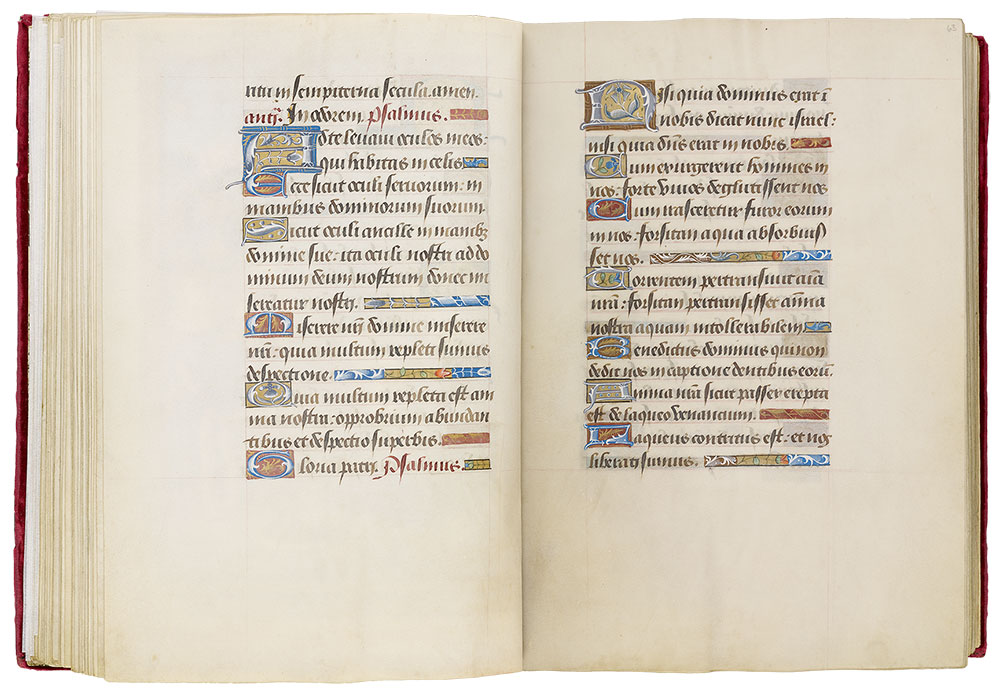
Hours of Henry VIII
Illuminated by Jean Poyer
Gift of the Heineman Foundation, 1977
MS H.8, fols. 63v–64r
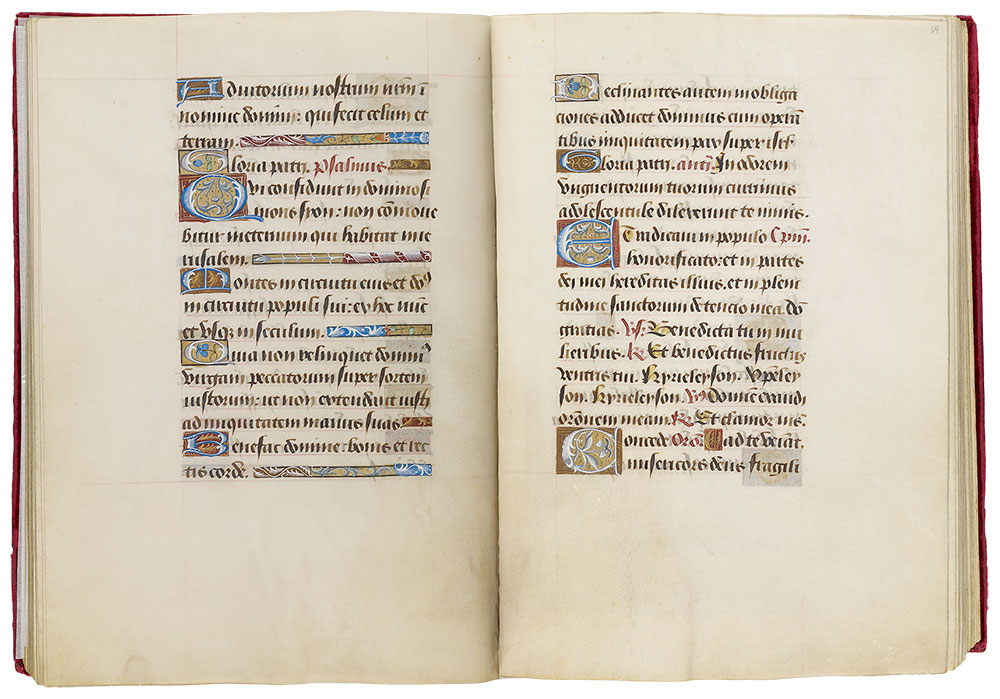
Hours of Henry VIII
Illuminated by Jean Poyer
Gift of the Heineman Foundation, 1977
MS H.8, fols. 64v–65r
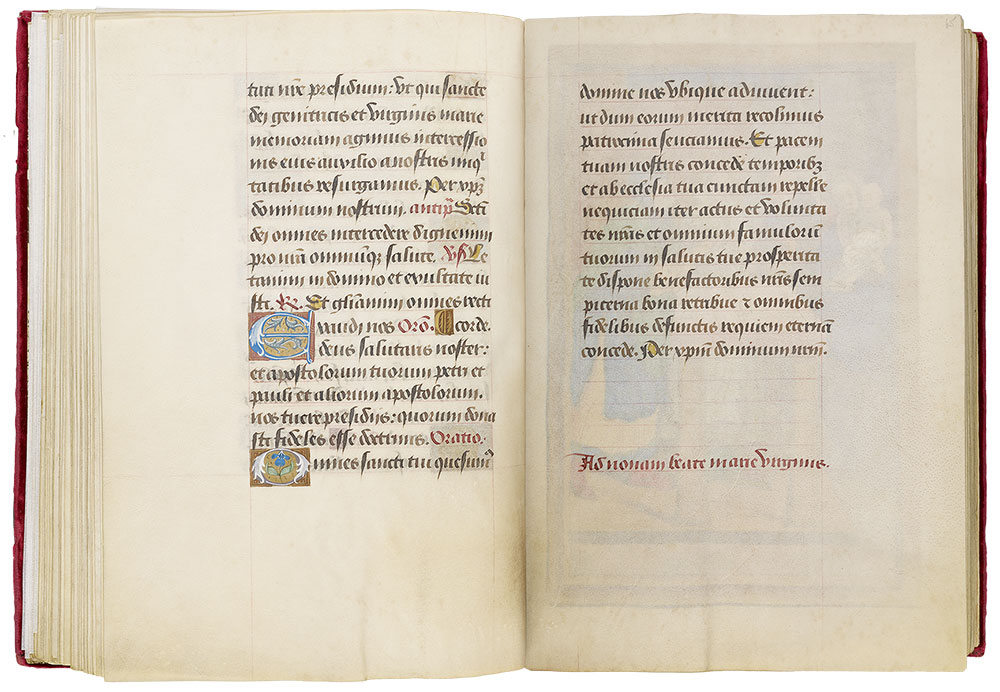
Hours of Henry VIII
Illuminated by Jean Poyer
Gift of the Heineman Foundation, 1977
MS H.8, fols. 65v–66r
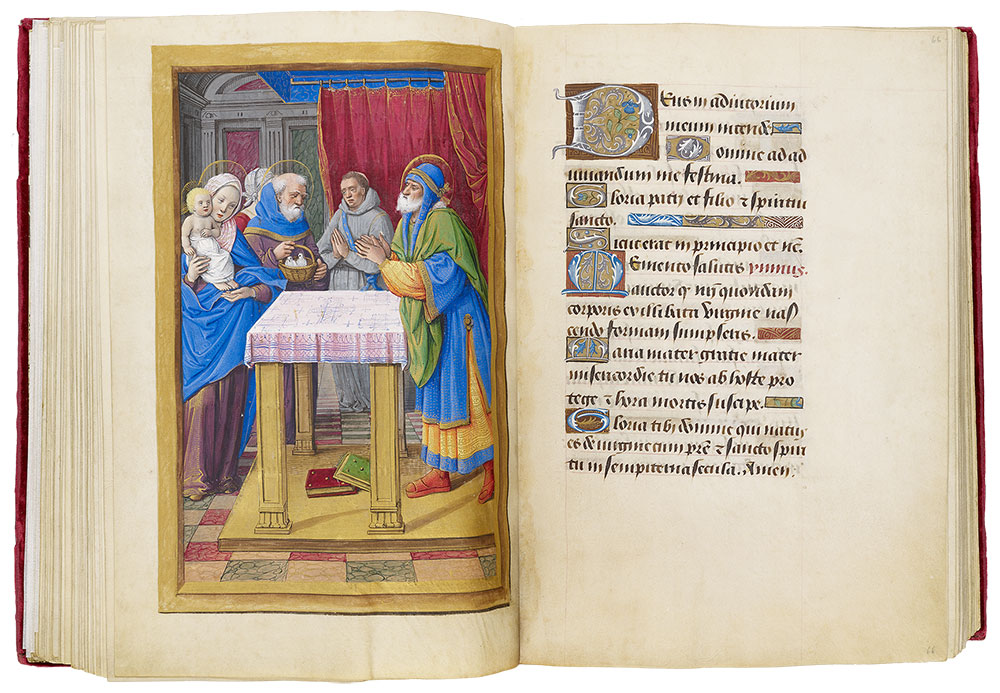
None: Presentation in the Temple
Hours of Henry VIII
Illuminated by Jean Poyer
Gift of the Heineman Foundation, 1977
None: Presentation in the Temple (fol. 65v)
The traditional illustration for None is the Presentation of Christ in the Temple. According to Luke (2:22–40), the Holy Family would be met by Simeon, who was inspired by the Holy Spirit to recognize, before his own death, the Savior.
The altar itself, complete with a blue canopy and red curtains, is situated within a Renaissance interior with walls decorated with pilasters framing large red and green marble panels, echoing the rows of colored floor marbles. The five large crosses that decorate the altar cloth, suggesting the five wounds Christ would endure on the Cross, may allude to Simeon's vision.
As was common in later medieval art, Poyer has identified Simeon with the high priest of the Temple; he would proclaim that the Lord could now let him depart in peace, having seen his salvation. The famous Canticle of Simeon, beginning Nunc dimittis (Now you may dismiss me), does occur in the Hours of the Virgin but at Compline. Poyer has given him a halo because he was subsequently made a saint; the letters on the hem of his garment suggest Hebrew. After blessing the Holy Family, Simeon told Mary that her child was set for the fall and resurrection of many in Israel and a sword would pierce her own soul.
The unusual presence of a Franciscan friar behind the altar suggests that the original owner may have had some connection or special devotion to that order, which was especially favored by French royalty at this time. The manuscript's Calendar has a strong emphasis on Franciscans. They were known as Gray Friars because of the color of their habit, which was originally gray (but later brown).
Luke 2:22–40
The only biblical account for the Presentation of Christ in the Temple is Luke's (2:22–40): "After the days of her purification . . . they carried him to Jerusalem, to present him to the Lord . . . as it is written that every male opening the womb shall be called holy to the Lord, and to offer a sacrifice . . . a pair of turtledoves or two young pigeons." (The sacrificial birds, following Leviticus 12:6–8, were for the purification of women after childbirth.)
MS H.8, fols. 66v–67r
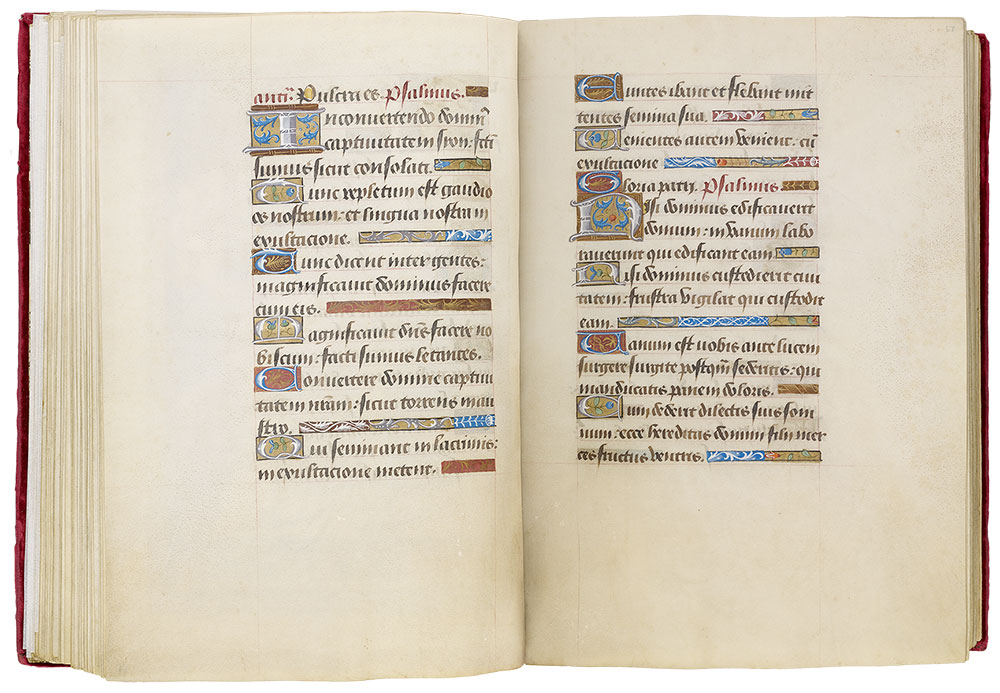
Hours of Henry VIII
Illuminated by Jean Poyer
Gift of the Heineman Foundation, 1977
MS H.8, fols. 67v–68r
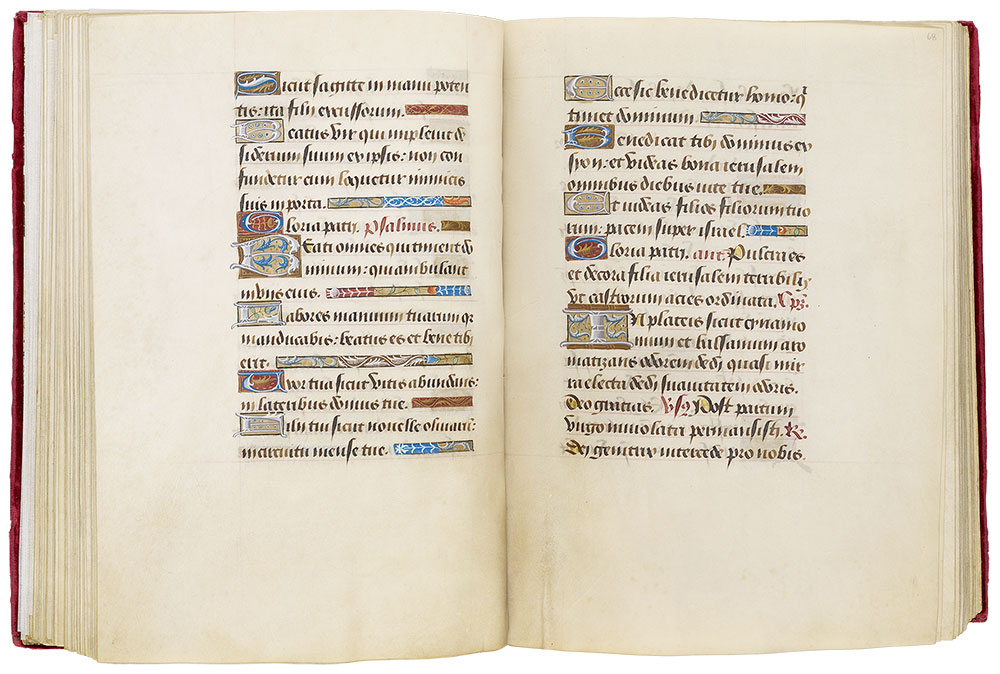
Hours of Henry VIII
Illuminated by Jean Poyer
Gift of the Heineman Foundation, 1977
MS H.8, fols. 68v–69r
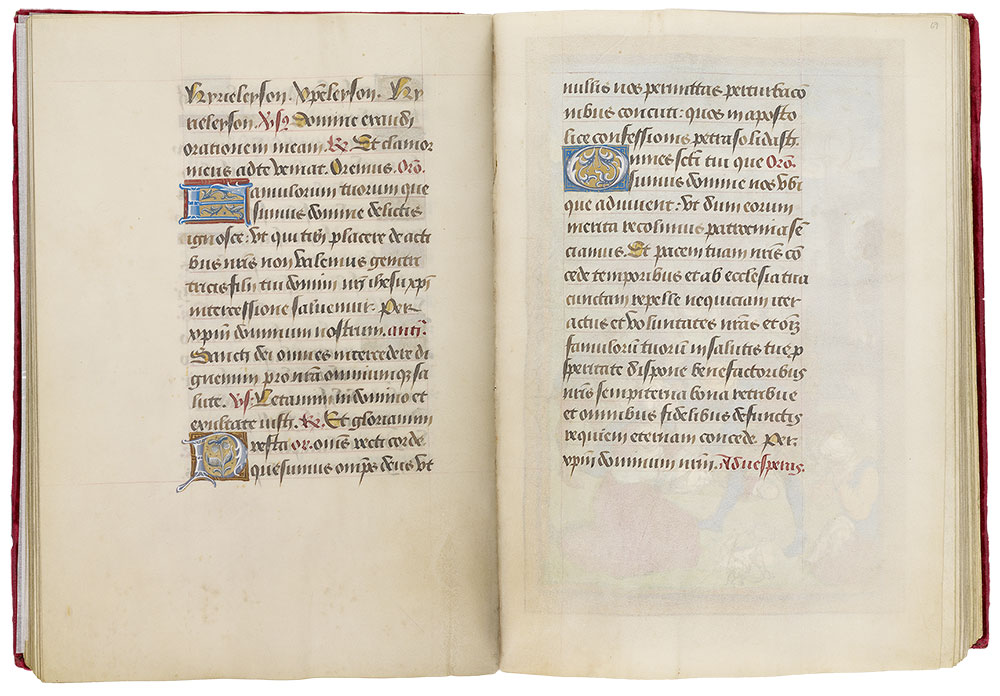
Hours of Henry VIII
Illuminated by Jean Poyer
Gift of the Heineman Foundation, 1977
MS H.8, fols. 69v–70r
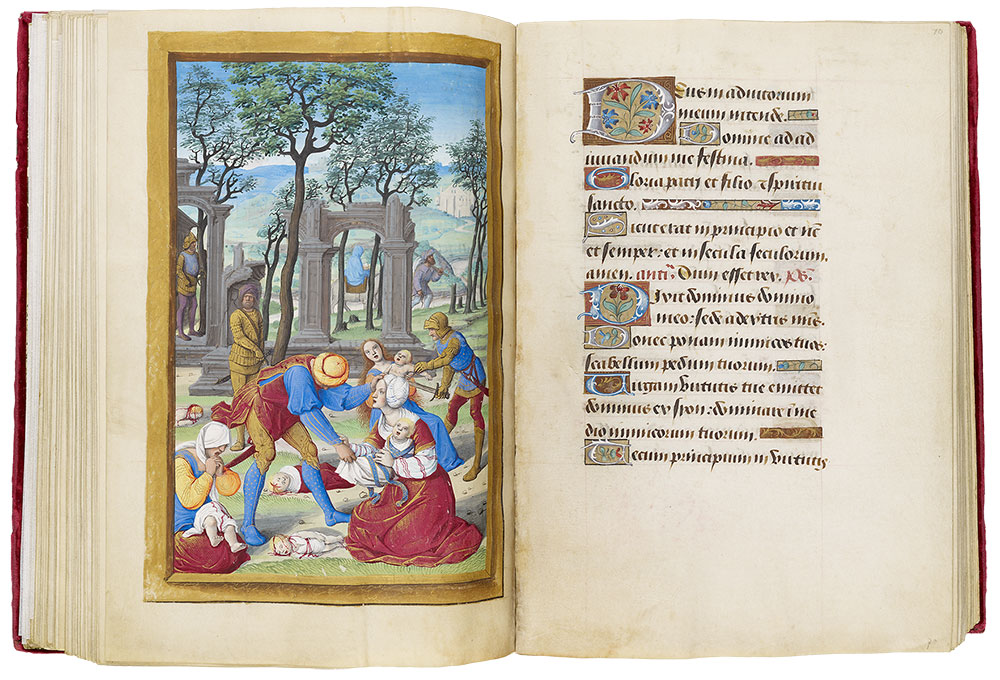
Vespers: Massacre of the Innocents and Flight into Egypt
Hours of Henry VIII
Illuminated by Jean Poyer
Gift of the Heineman Foundation, 1977
Vespers: Massacre of the Innocents and Flight into Egypt (fol. 69v)
While the Massacre of the Innocents is less common than the Flight into Egypt as the Vesper illustration, Poyer managed to include both. As the slaughter takes place in the foreground, the Holy Family departs for Egypt in the background—as can be seen through the stone ruins.
Two mothers futilely attempt to keep their children from soldiers, while a woman on the left wails uncontrollably over her dead baby. The Holy Innocents were regarded as the first martyrs, and their feast day (three days after Christmas) was already celebrated by the early Church.
Massacre of the Innocents
Following his unique account of the Adoration of the Magi, Matthew continues the narrative (2:13–18) with the Flight into Egypt and the Massacre of the Innocents. Herod, learning that a future ruler of Israel would come from Bethlehem, ordered the slaughter of all male children two years old and younger living in or near Bethlehem. An angel had already appeared to Joseph in his sleep, telling him to take Jesus and his mother to Egypt until the death of Herod. (Biblical scholars, including Matthew, have recognized that the Massacre and Flight provided the pretext for the fulfillment of Hosea's prophecy [Hosea 11:1] that, like Moses, the Messiah would come up out of Egypt.)
MS H.8, fols. 70v–71r
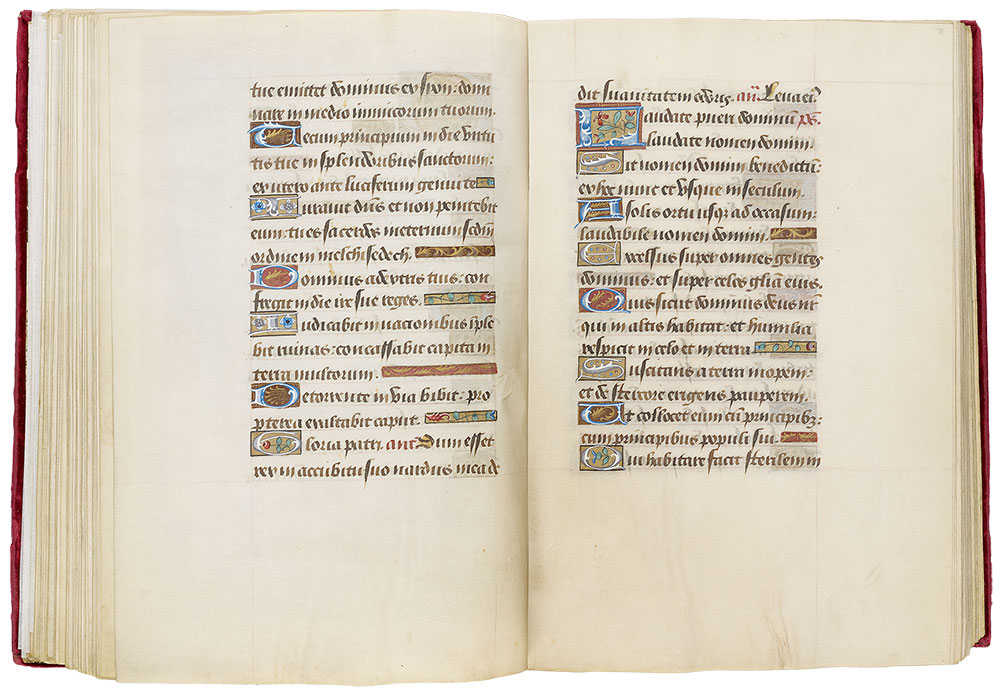
Hours of Henry VIII
Illuminated by Jean Poyer
Gift of the Heineman Foundation, 1977
MS H.8, fols. 71v–72r
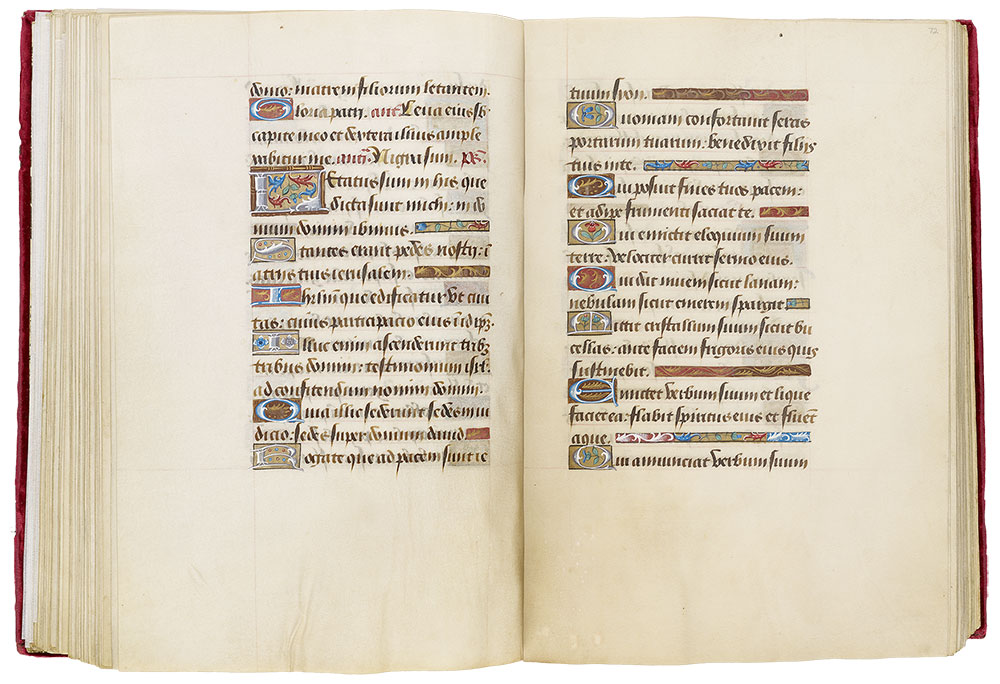
Hours of Henry VIII
Illuminated by Jean Poyer
Gift of the Heineman Foundation, 1977
MS H.8, fols. 72v–73r
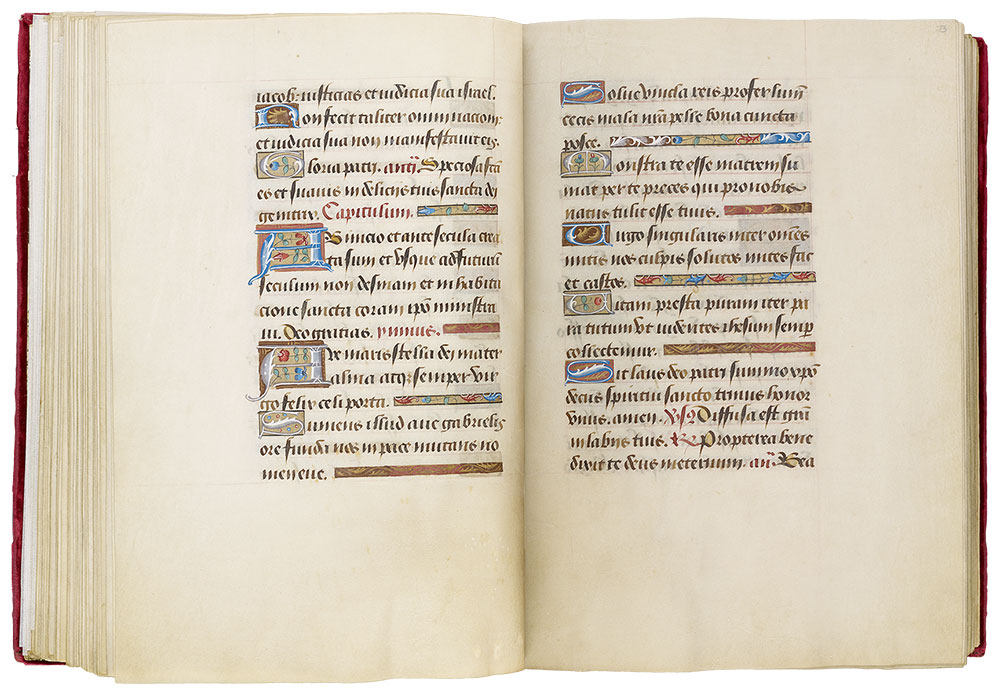
Hours of Henry VIII
Illuminated by Jean Poyer
Gift of the Heineman Foundation, 1977
MS H.8, fols. 73v–74r
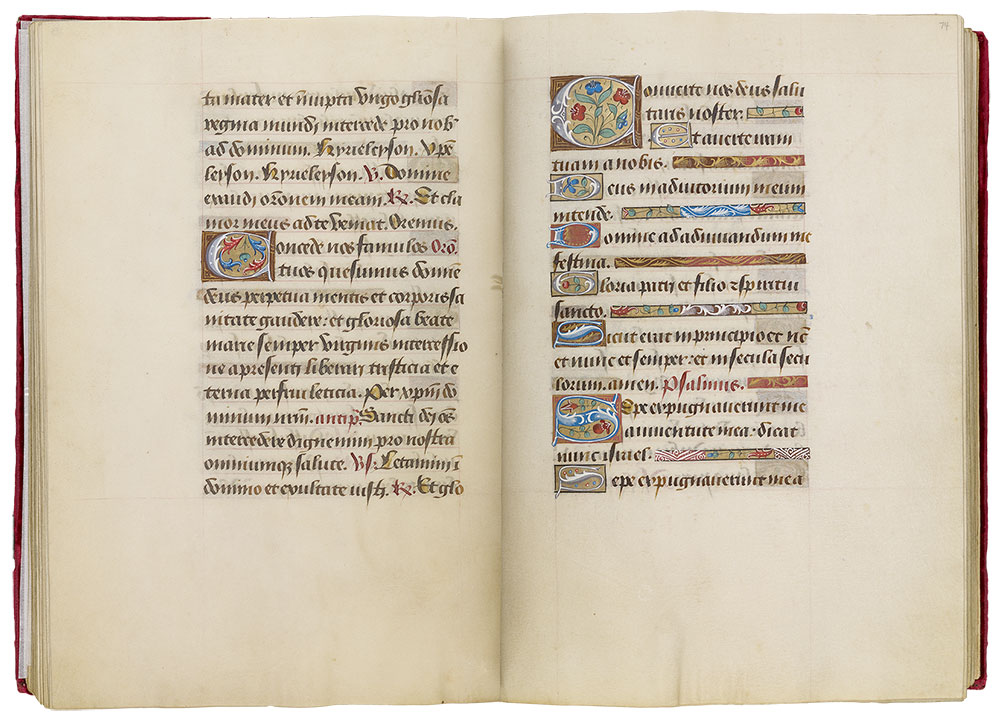
Hours of Henry VIII
Illuminated by Jean Poyer
Gift of the Heineman Foundation, 1977
MS H.8, fols. 74v–75r
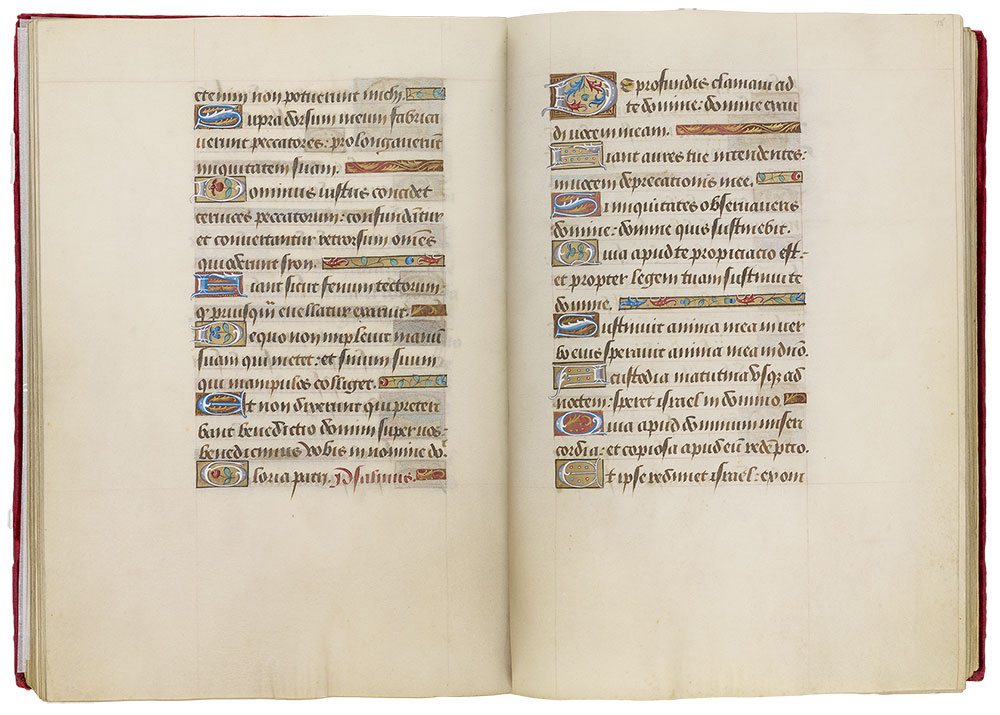
Hours of Henry VIII
Illuminated by Jean Poyer
Gift of the Heineman Foundation, 1977
MS H.8, fols. 75v–76r
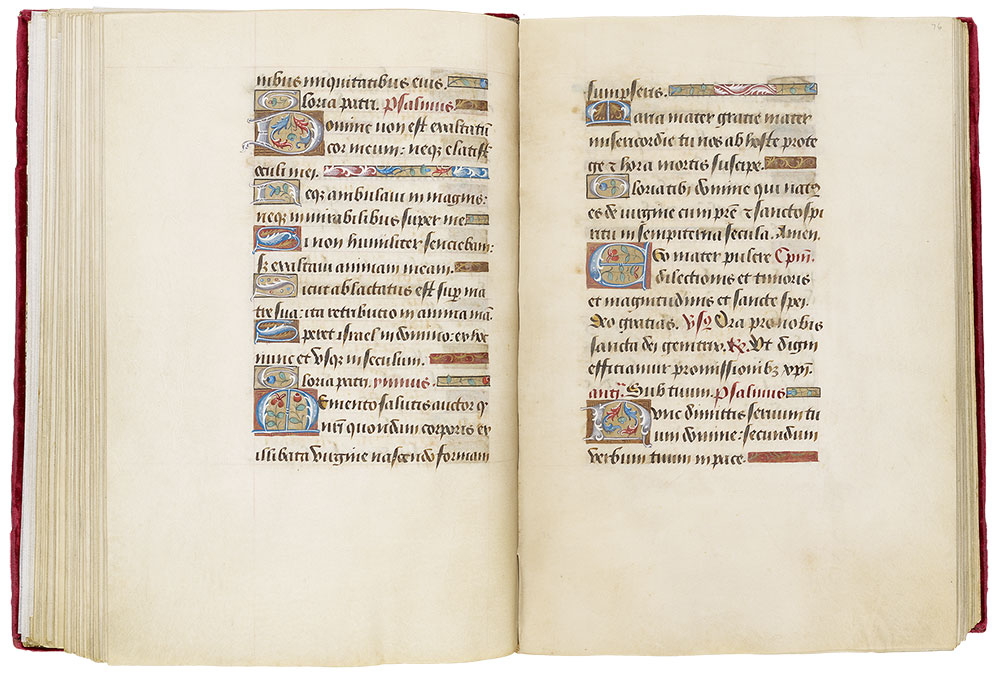
Hours of Henry VIII
Illuminated by Jean Poyer
Gift of the Heineman Foundation, 1977
MS H.8, fols. 76v–77r
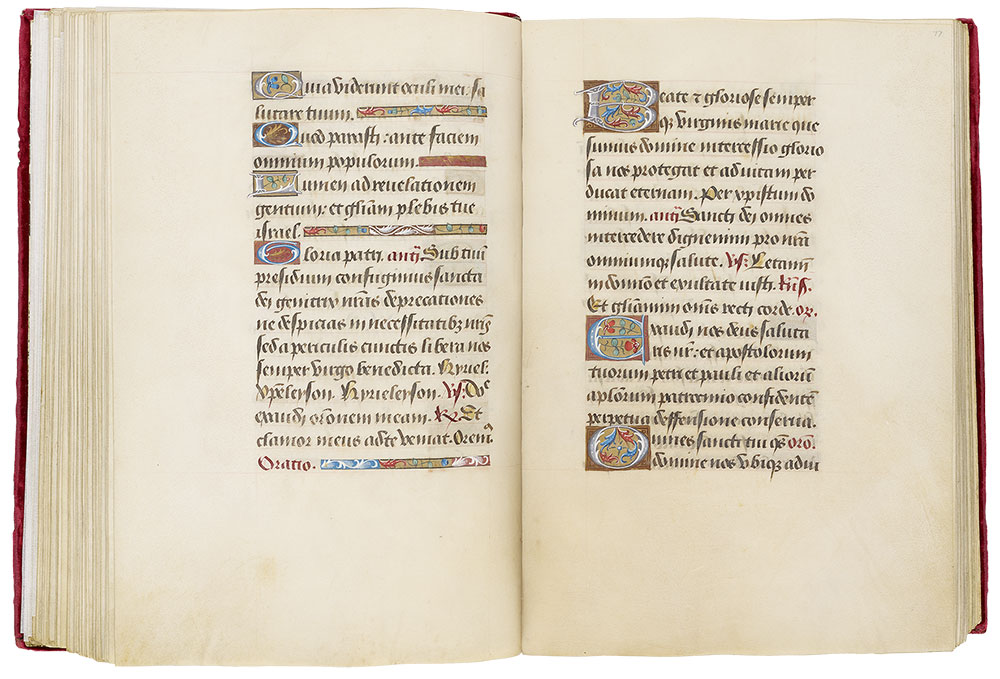
Hours of Henry VIII
Illuminated by Jean Poyer
Gift of the Heineman Foundation, 1977
MS H.8, fols. 77v–78r
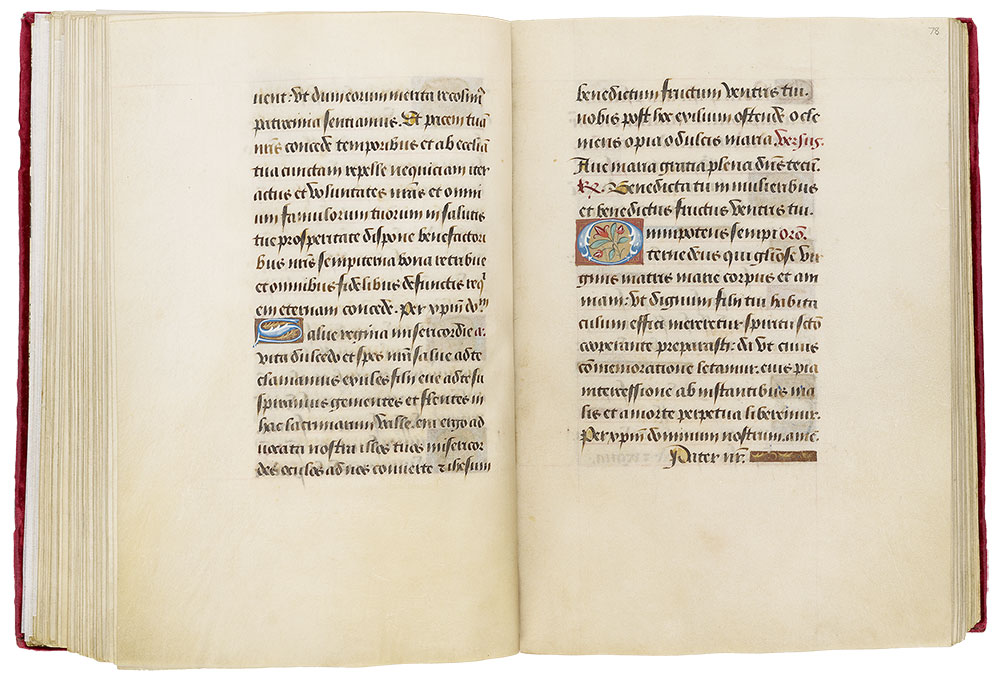
Hours of Henry VIII
Illuminated by Jean Poyer
Gift of the Heineman Foundation, 1977
MS H.8, fols.78 v–79r
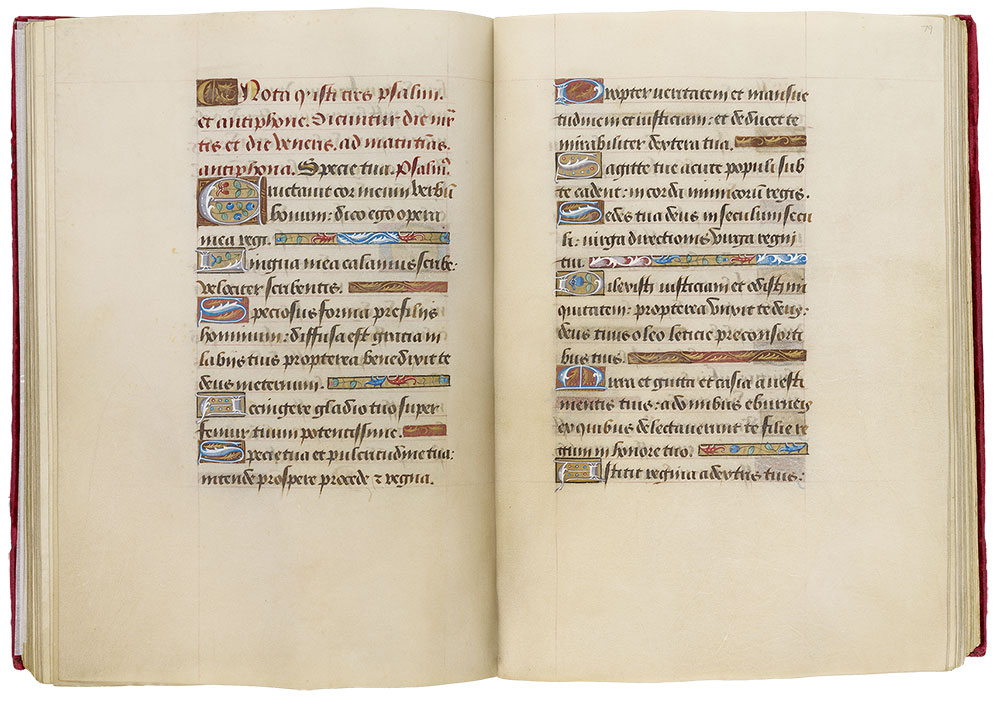
Hours of Henry VIII
Illuminated by Jean Poyer
Gift of the Heineman Foundation, 1977
MS H.8, fols. 79v–80r
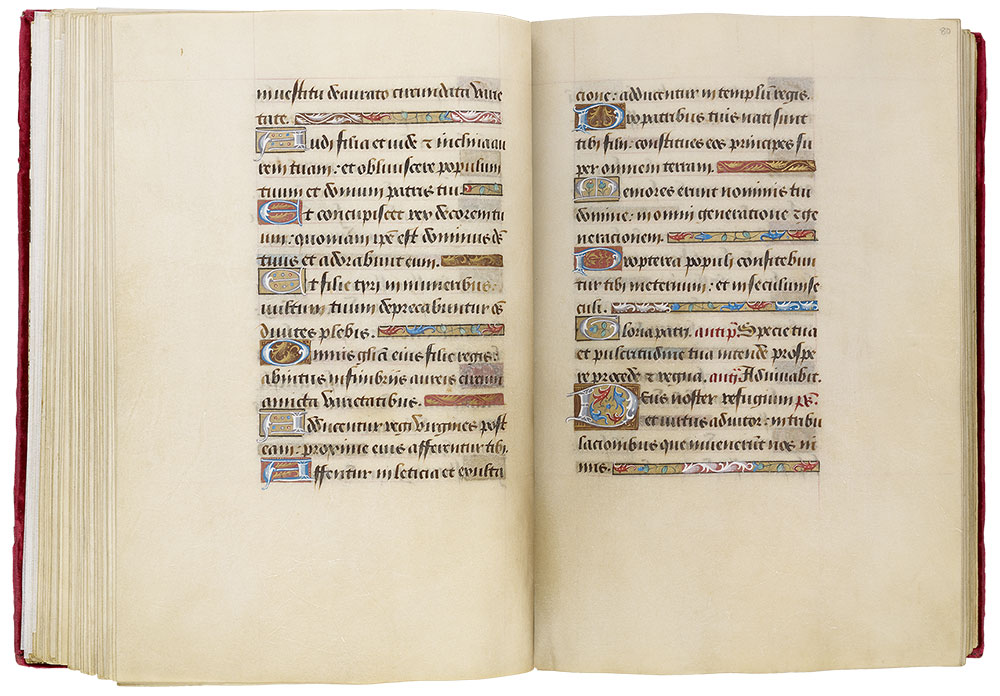
Hours of Henry VIII
Illuminated by Jean Poyer
Gift of the Heineman Foundation, 1977
MS H.8, fols. 80v–81r
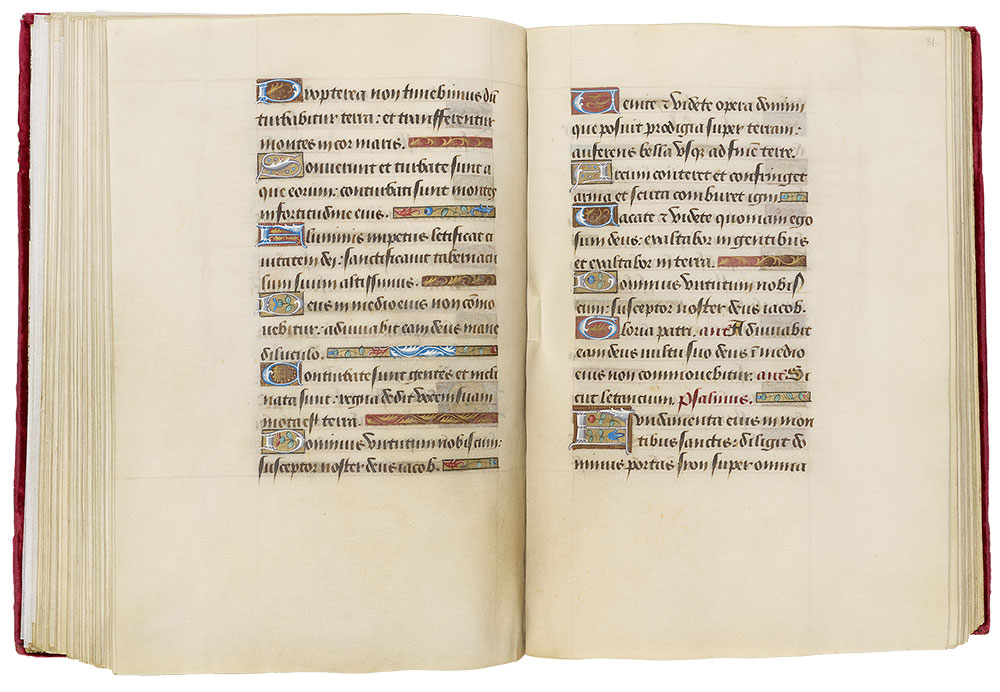
Hours of Henry VIII
Illuminated by Jean Poyer
Gift of the Heineman Foundation, 1977
MS H.8, fols. 81v–82r
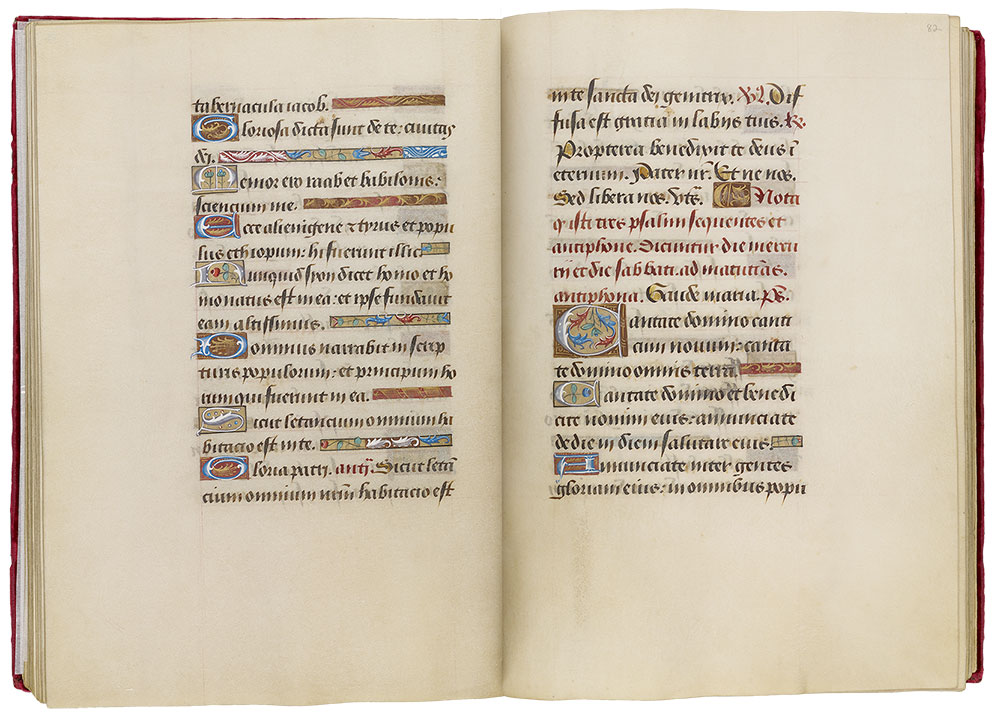
Hours of Henry VIII
Illuminated by Jean Poyer
Gift of the Heineman Foundation, 1977
MS H.8, fols. 82v–83r
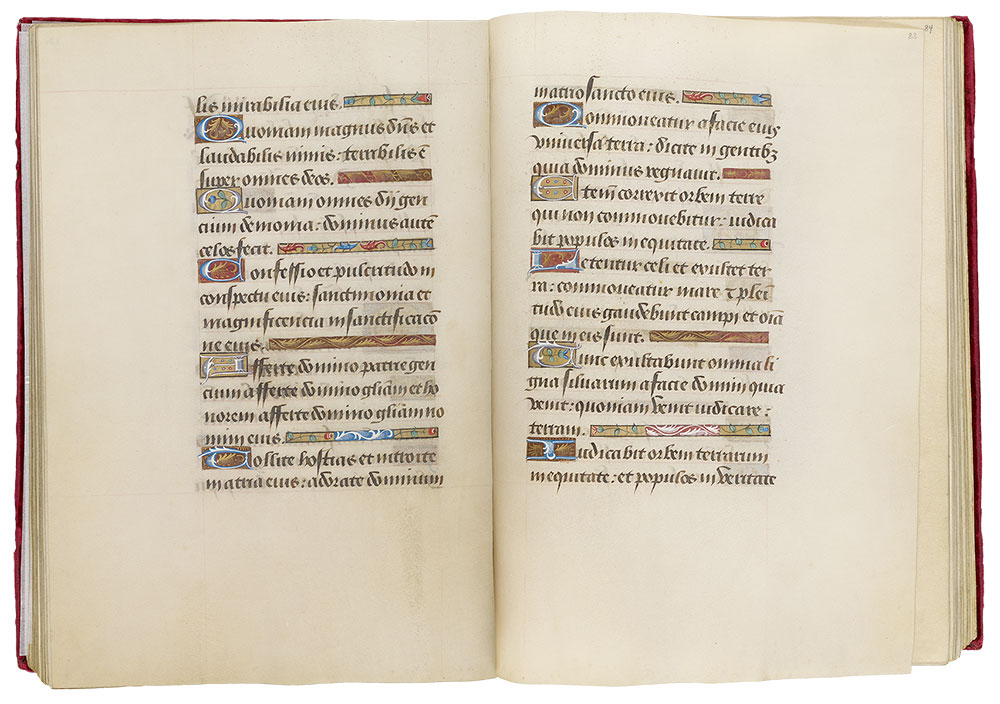
Hours of Henry VIII
Illuminated by Jean Poyer
Gift of the Heineman Foundation, 1977
MS H.8, fols. 83v–84r
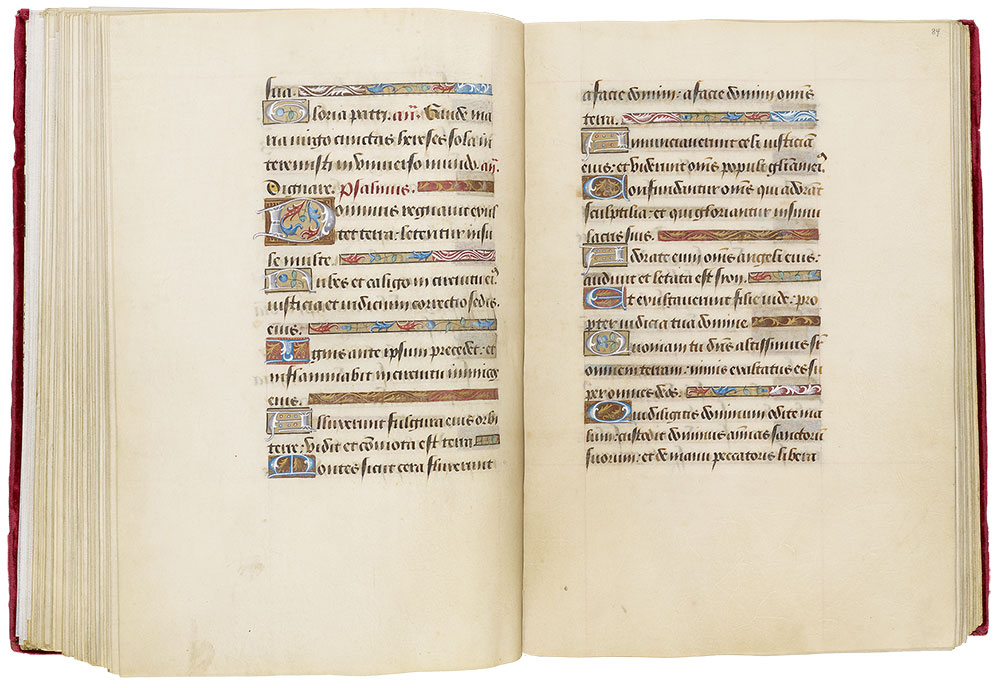
Hours of Henry VIII
Illuminated by Jean Poyer
Gift of the Heineman Foundation, 1977
MS H.8, fols. 84v–85r
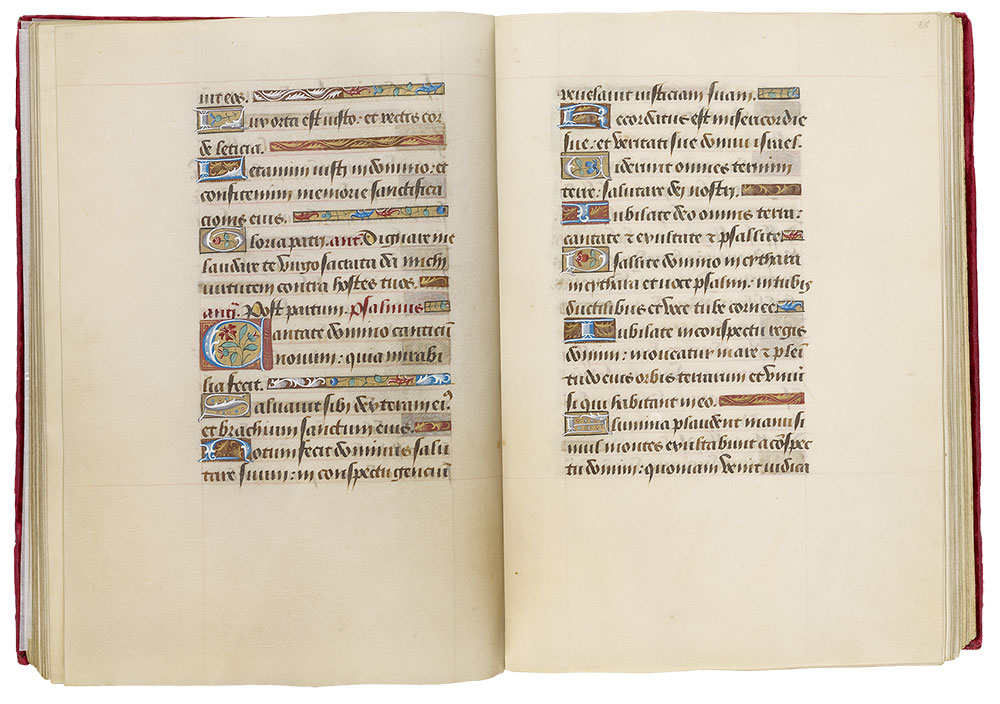
Hours of Henry VIII
Illuminated by Jean Poyer
Gift of the Heineman Foundation, 1977
MS H.8, fols. 85v–86r
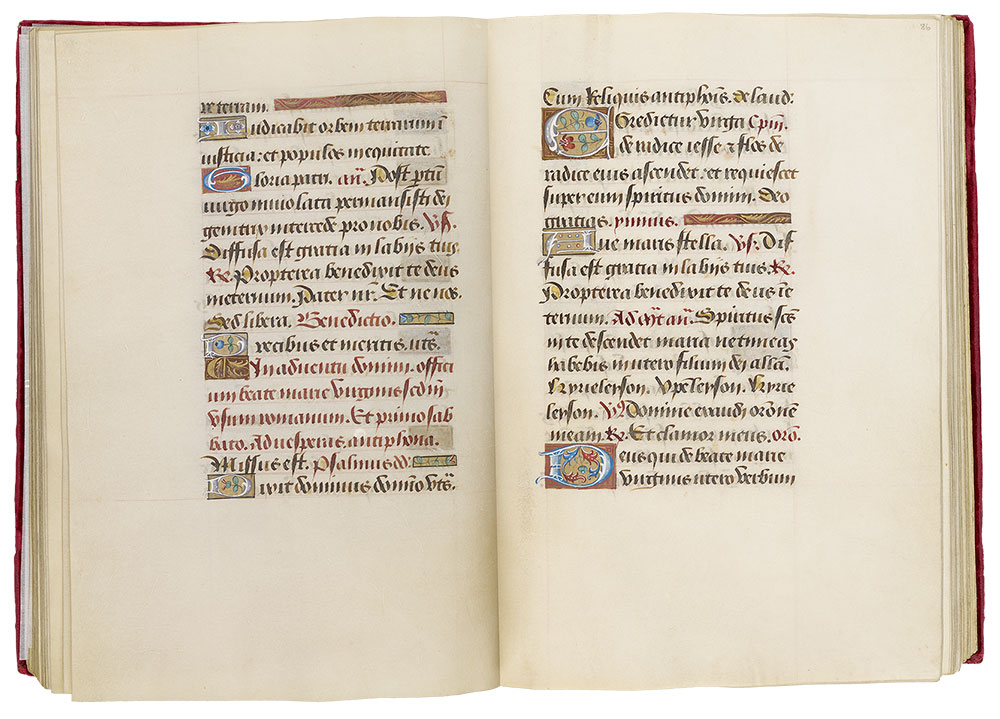
Hours of Henry VIII
Illuminated by Jean Poyer
Gift of the Heineman Foundation, 1977
MS H.8, fols. 86v–87r
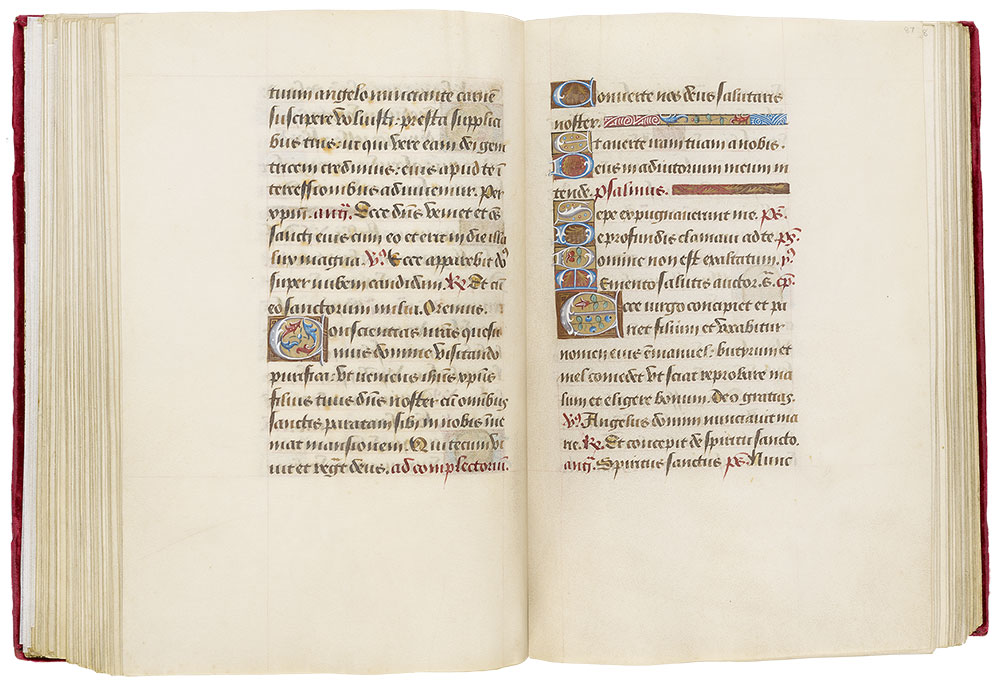
Hours of Henry VIII
Illuminated by Jean Poyer
Gift of the Heineman Foundation, 1977
MS H.8, fols. 87v–88r
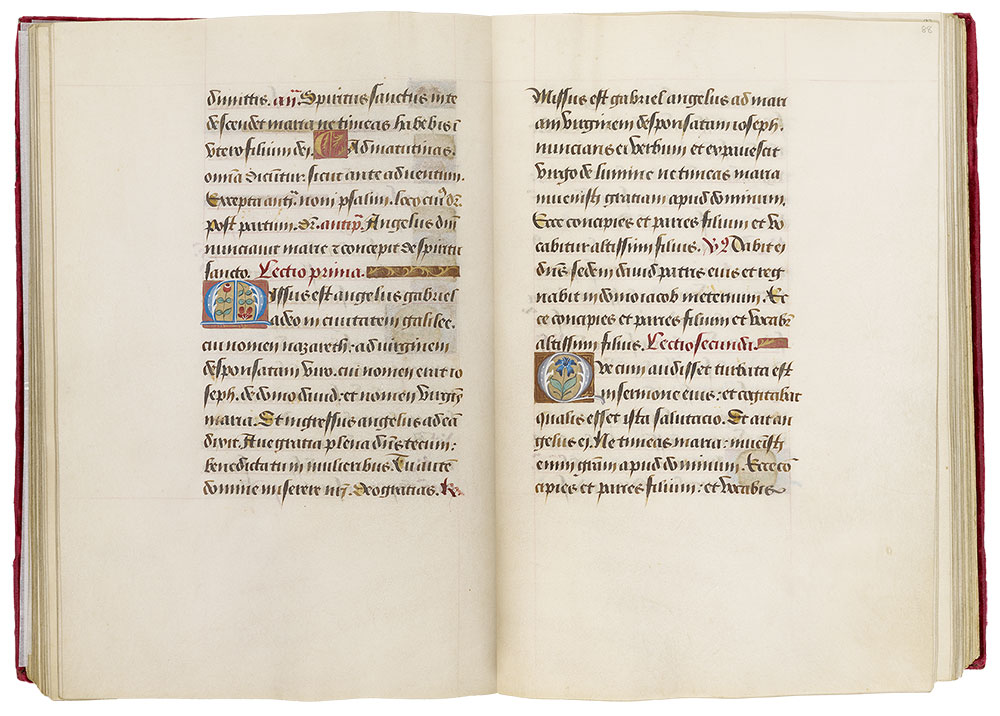
Hours of Henry VIII
Illuminated by Jean Poyer
Gift of the Heineman Foundation, 1977
MS H.8, fols. 88v–89r
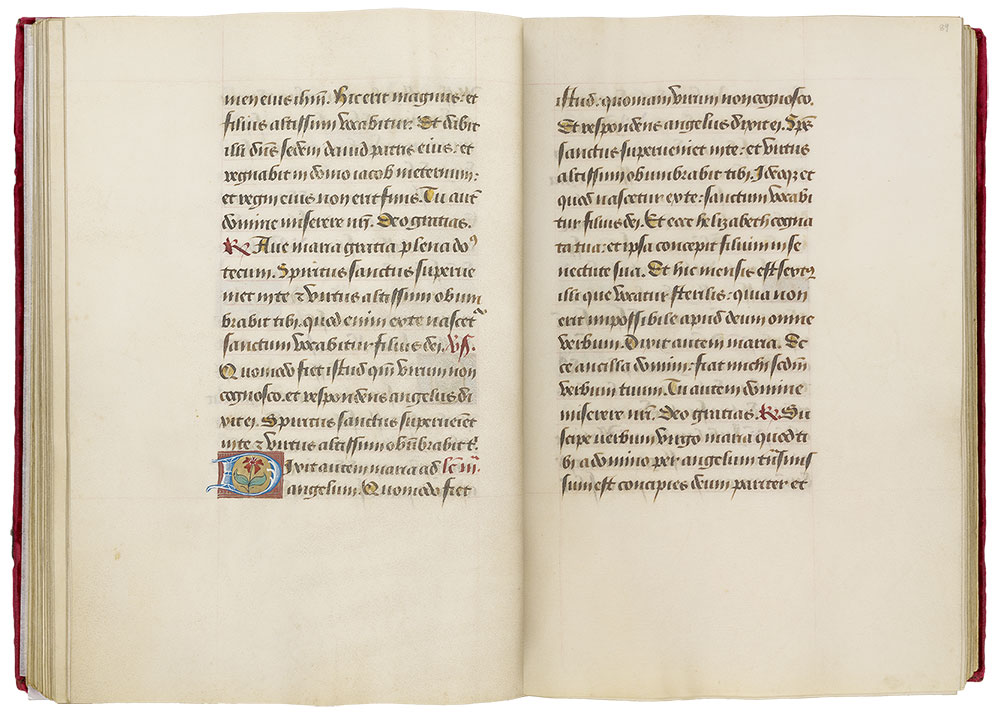
Hours of Henry VIII
Illuminated by Jean Poyer
Gift of the Heineman Foundation, 1977
MS H.8, fols. 89v–90r
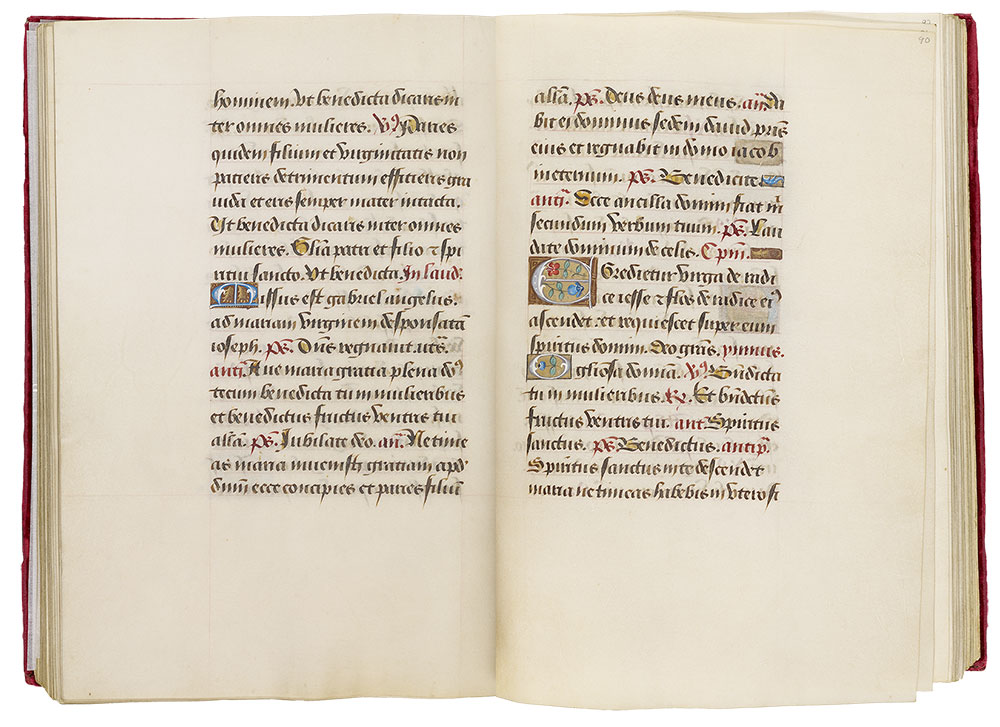
Hours of Henry VIII
Illuminated by Jean Poyer
Gift of the Heineman Foundation, 1977
MS H.8, fols. 90v–91r
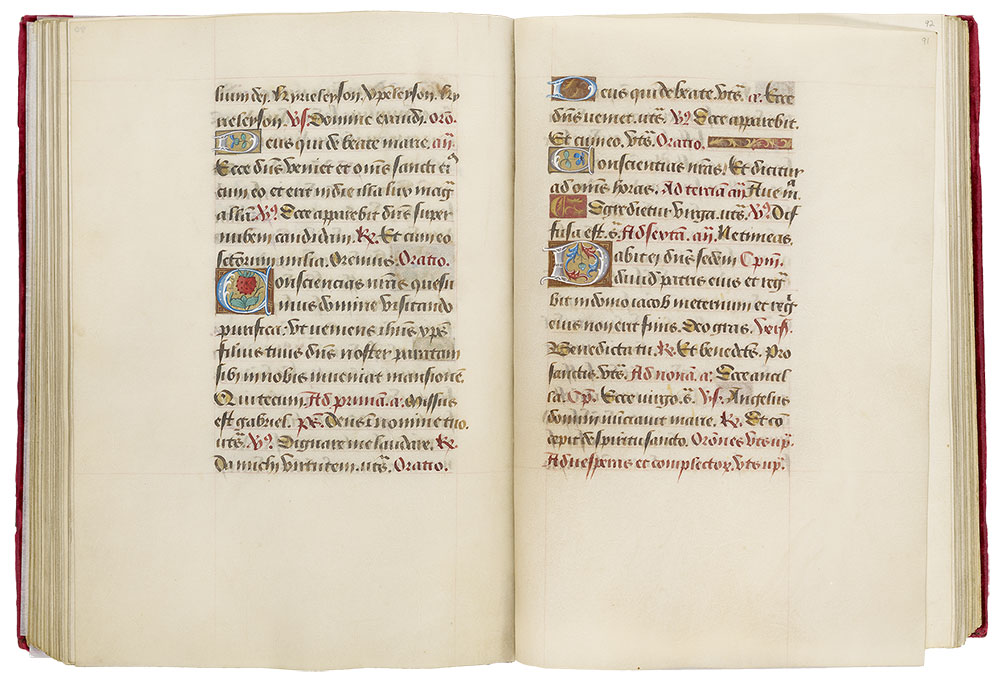
Hours of Henry VIII
Illuminated by Jean Poyer
Gift of the Heineman Foundation, 1977
MS H.8, fols. 91v–92r
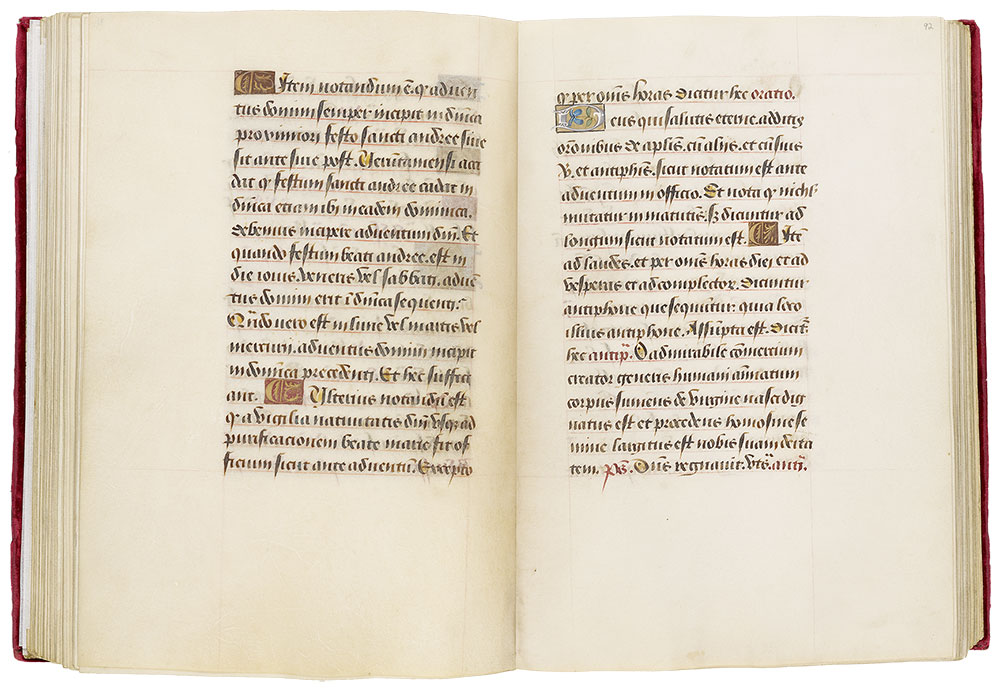
Hours of Henry VIII
Illuminated by Jean Poyer
Gift of the Heineman Foundation, 1977
MS H.8, fols. 92v–93r
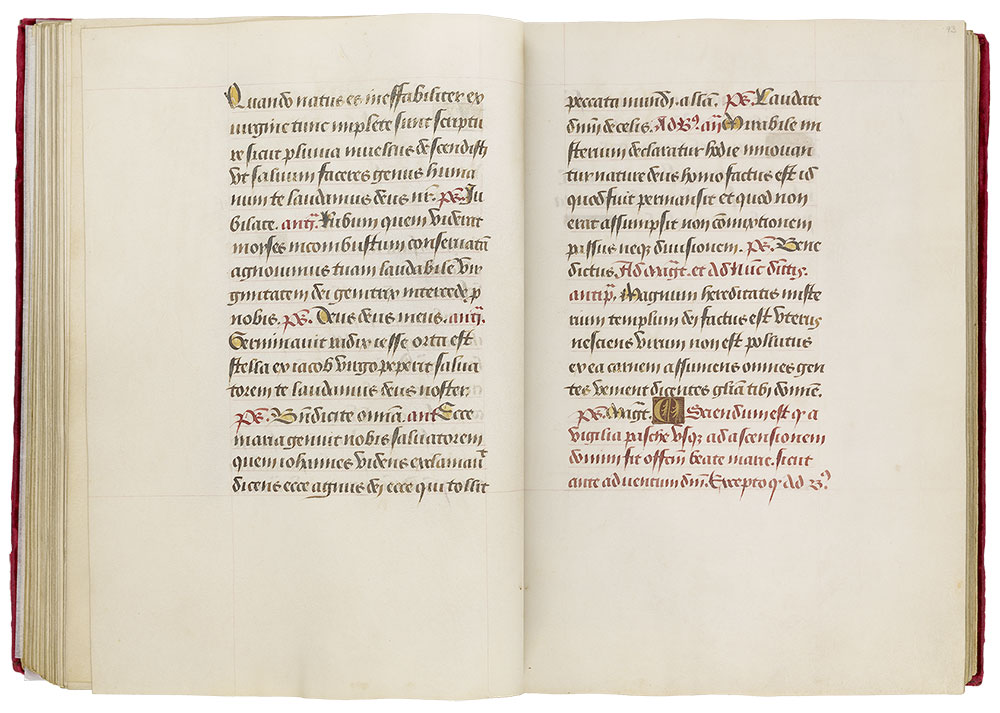
Hours of Henry VIII
Illuminated by Jean Poyer
Gift of the Heineman Foundation, 1977
MS H.8, fols. 93v–94r
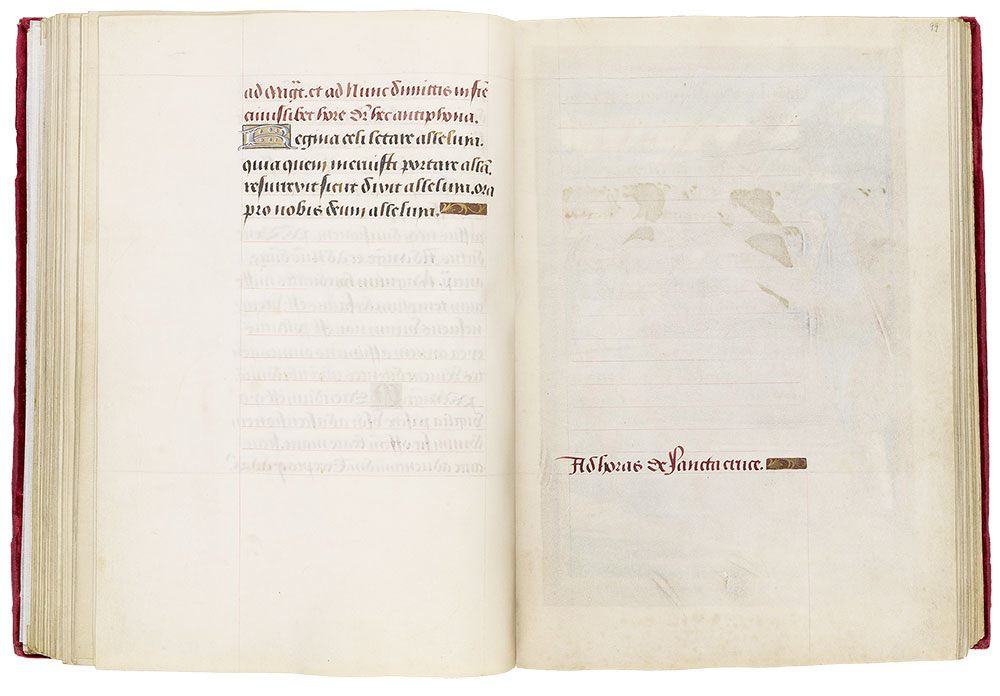
Hours of Henry VIII
Illuminated by Jean Poyer
Gift of the Heineman Foundation, 1977
Hours of the Cross, fol. 94v
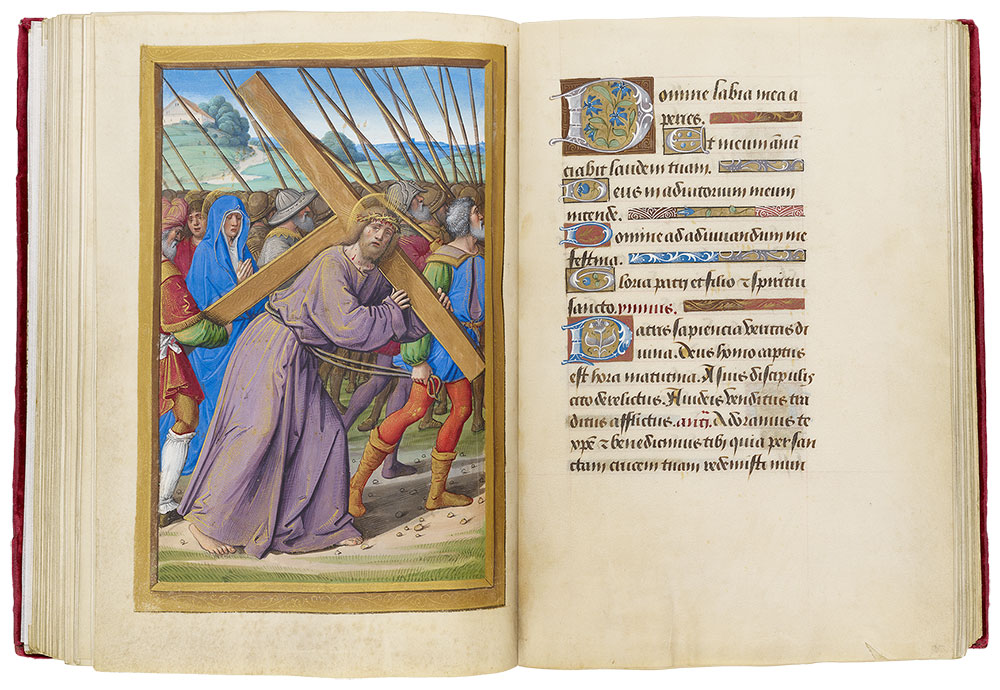
Hours of the Cross: Christ Carrying the Cross
Hours of Henry VIII
Illuminated by Jean Poyer
Gift of the Heineman Foundation, 1977
Hours of the Cross: Christ Carrying the Cross (fol. 94v)
Since the Hours of the Virgin stress her role in the Incarnation and their cycle of miniatures traditionally illustrate the Infancy of Christ, it is not surprising that the Hours of the Cross (fols. 95–101), which emphasizes his Passion, should frequently, as here, come next.
Although it is usually the Crucifixion rather than the Carrying of the Cross that marks the beginning of the Hours of the Cross, the latter is sometimes,though more rarely, encountered.
Carrying of the Cross
In the miniature, Christ, slightly bent by the weight of the Cross, looks out at and gently draws the beholder to him. He is still wearing the purple robe that was placed on him when he was mocked as the king of the Jews. Reflecting a later pictorial tradition, Christ is assisted by Simon of Cyrene. The third ingredient, the agonizing pair of the Virgin and John (not mentioned in the biblical texts), is a prominent feature of later meditational literature that emphasized their compassion. Passion plays and the Stations of the Cross, which were encouraged by the Franciscans and became popular at the end of the fifteenth century, also contributed to the iconography.
Hours of the Cross
The Hours of the Holy Spirit are almost always paired with and proceed from the Hours of the Cross, just as Christ promised the Apostles at the Last Supper that the Father would later send the Holy Spirit to teach them all things (John 14:26) and that the latter's power would come upon them (Acts 1:4).
The two Hours are much shorter than the Hours of the Virgin and follow the same sequence, except that there is no Lauds. Each Hour consists of two pairs of versicles and responses, a "Gloria Patri" followed by an antiphon, a short hymn with a versicle and response, and a prayer (there are no lengthy psalms). The opening versicles and responses are identical to those in the corresponding Hours of the Virgin, beginning with the familiar "Domine labia mea aperies" (Lord, thou shalt open my lips). The different hymns for each Hour of the Cross form a chronological meditation on the Passion of Christ. The Matins hymn, for example, treats his Betrayal and Arrest. It begins with the words "Patris sapiencia":
Circled by his enemies,
By his own forsaken,
Christ the Lord at Matin Hour
For our sakes was taken:
Very Wisdom, Very Light,
Monarch long expected,
In the garden by the Jews
Bound, reviled, rejected.
The following hymns, in turn, deal with Christ before Pilate (Prime), his Crowning with Thorns (Terce), Crucifixion (Sext), death (None), Deposition (Vespers), Entombment (Compline), and an invocation for Christ's comfort at the time of the reader's death. Each of the hymns originally formed an eight-part poem, perhaps composed in the twelfth century, which connected Christ's Passion with the canonical Hours.
As with the Hours of the Cross, the hymns for each of the separate Hours of the Holy Spirit were also taken from a poem ("Nobis sancti Spiritus"), the eight parts of which are thematically related to the Holy Spirit: the Incarnation (Matins), redemption through Christ's Passion (Prime), Pentecost (Terce), proselytization by the Apostles (Sext), qualities of the Holy Spirit (None), the Holy Spirit as Protector (Vespers), the Last Judgment (Compline), and a stanza asking the Holy Spirit for aid in achieving eternal salvation in heaven.
Since the standard illustration for the Hours of the Holy Spirit is Pentecost, an event that the Golden Legend placed at the Hour of Terce, we have translated the Terce hymn here:
God his Holy Spirit sent to his Apostles dear,
On the day of Pentecost to yield them gladsome cheer,
And with fiery tongues in them did ardent zeal impress:
By no means could he endure to leave them comfortless.
MS H.8, fols. 95v–96r
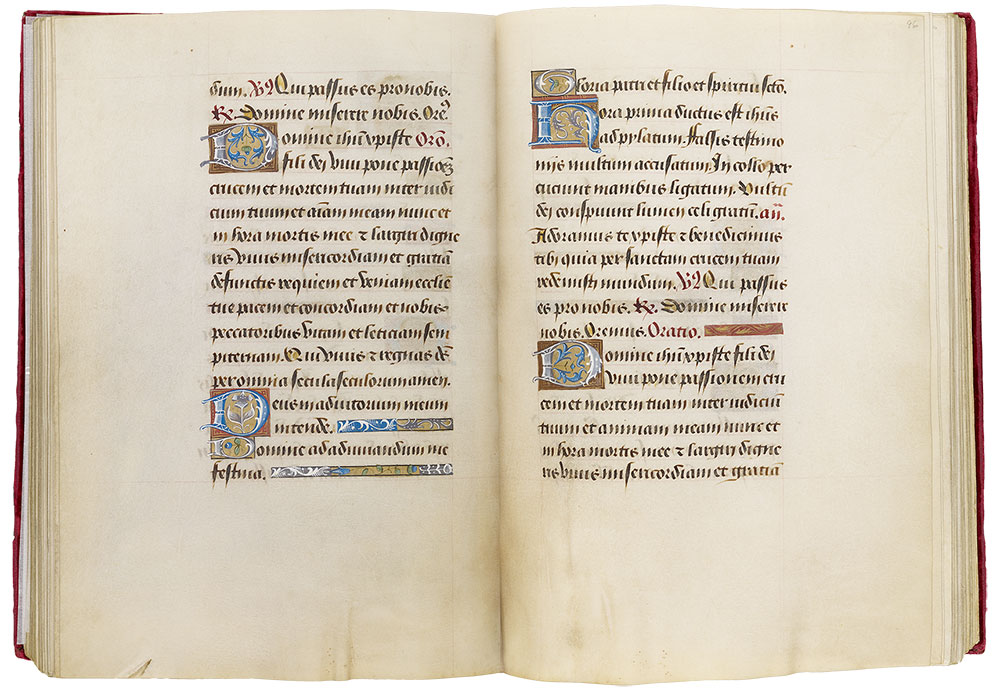
Hours of Henry VIII
Illuminated by Jean Poyer
Gift of the Heineman Foundation, 1977
MS H.8, fols. 96v–97r
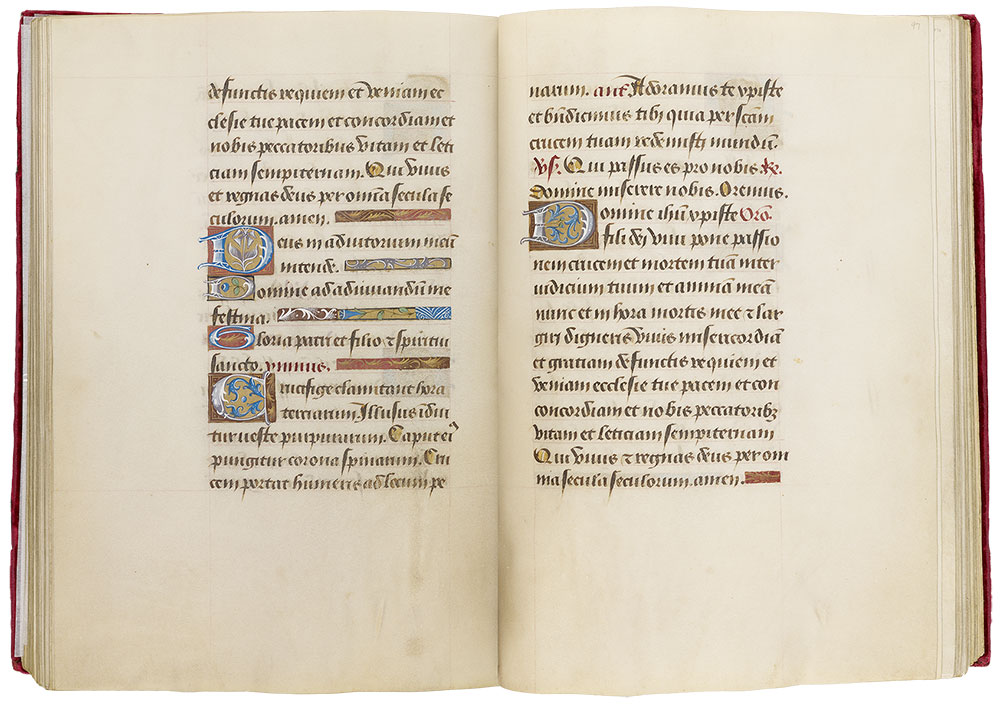
Hours of Henry VIII
Illuminated by Jean Poyer
Gift of the Heineman Foundation, 1977
MS H.8, fols. 98v–99r
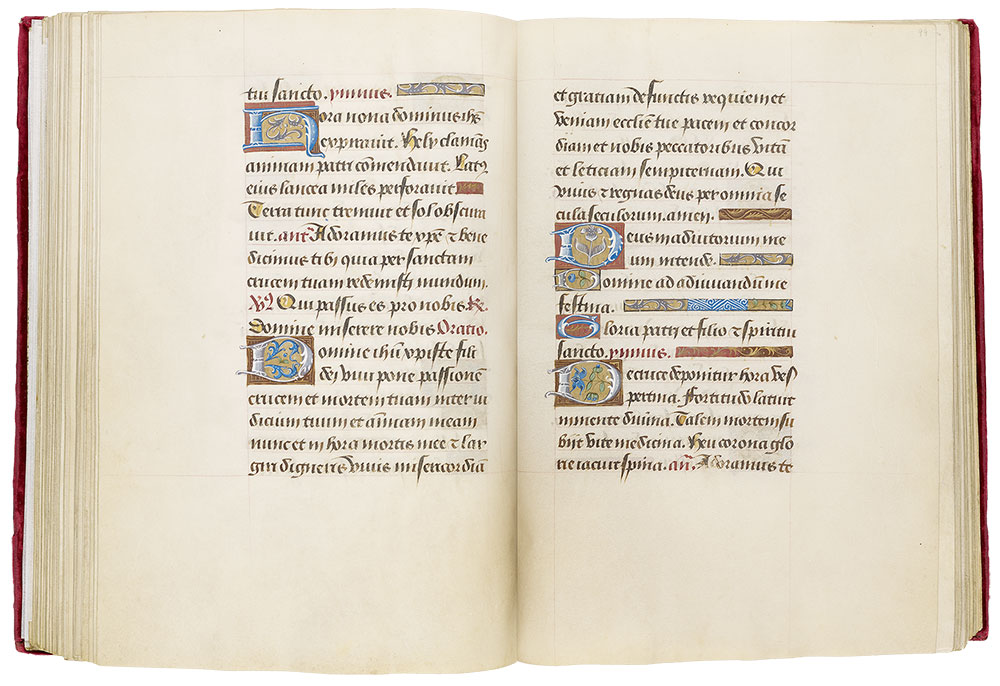
Hours of Henry VIII
Illuminated by Jean Poyer
Gift of the Heineman Foundation, 1977
MS H.8, fols. 99v–100r
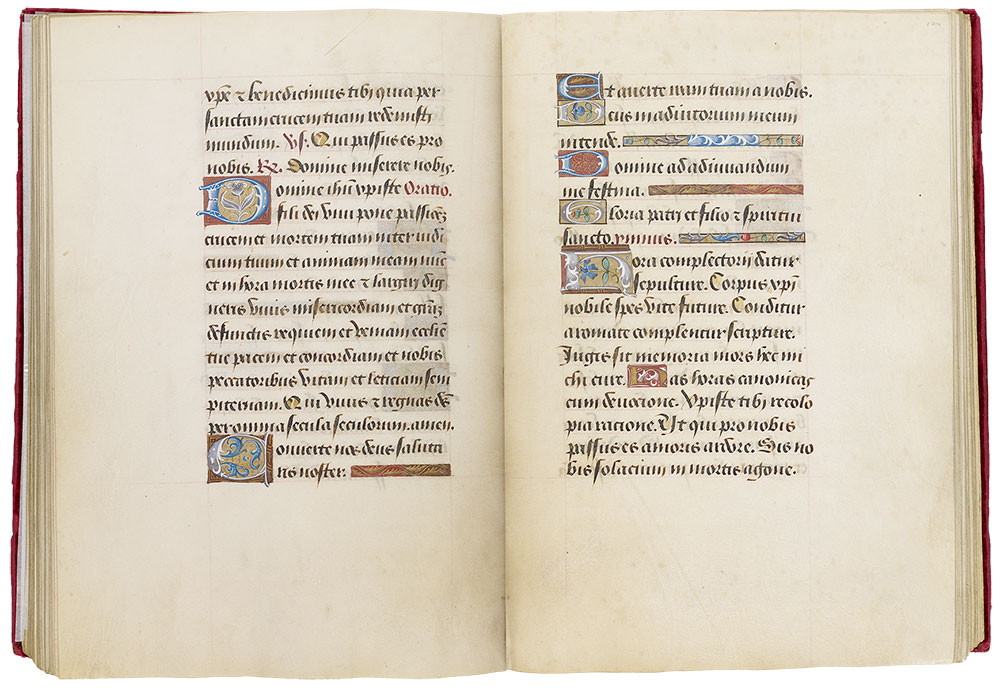
Hours of Henry VIII
Illuminated by Jean Poyer
Gift of the Heineman Foundation, 1977
MS H.8, fols. 100v–101r
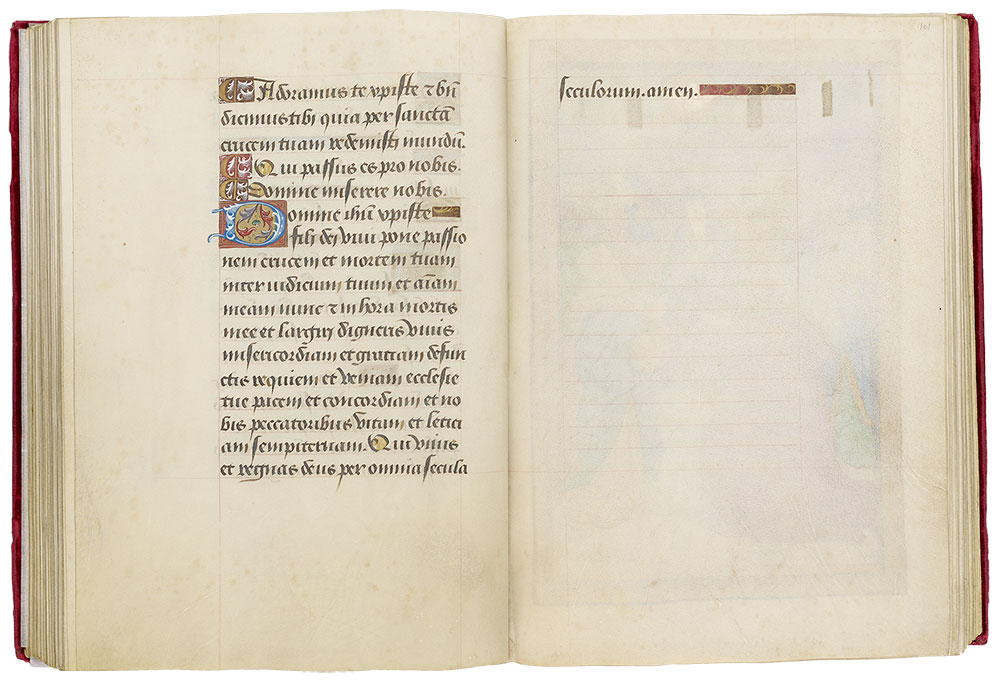
Hours of Henry VIII
Illuminated by Jean Poyer
Gift of the Heineman Foundation, 1977
Hours of the Holy Spirit, fol. 101v
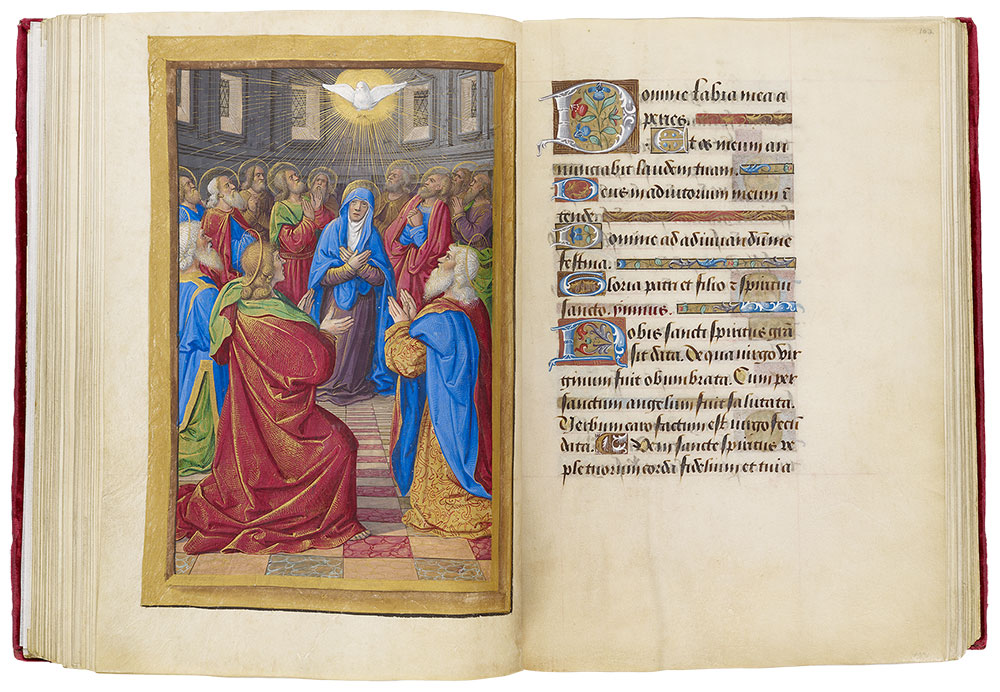
Hours of the Holy Spirit: Pentecost
Hours of Henry VIII
Illuminated by Jean Poyer
Gift of the Heineman Foundation, 1977
Hours of the Holy Spirit: Pentecost (fol. 101v)
Pentecost, or the Descent of the Holy Spirit, as described in the Acts of the Apostles (2:1–4), took place in a house where the disciples met on the Jewish feast of Pentecost. After a sound like a mighty wind came from heaven there appeared to them "parted tongues as it were of fire, and it sat upon every one of them." They were all filled with the Holy Spirit and were given the ability to speak in diverse tongues. Poyer, in a well- established tradition, depicts the power of the Holy Spirit as golden rays emanating from a dove, symbol of the Holy Spirit.
The Virgin is surrounded by Apostles, who are again twelve in number, Judas having been replaced by Matthias. The two Apostles in the foreground are the youthful John (left) and Peter.
The dove, which has a cruciform halo, is directly above the Virgin, who is often included in the scene, though her presence is not specifically mentioned in the Acts. Such writers as St. Odilo of Cluny (ca. 962–1049) simply assumed her presence; linking Pentecost with the earlier descent of the Holy Spirit that brought about the Incarnation, he argued that it would have been impossible to exclude her.
Feast of Pentecost
In the Middle Ages, the Christian feast of Pentecost (from the Greek word meaning "fiftieth day") was celebrated on the fiftieth day after Easter, just as the Jewish Pentecost was celebrated fifty days after Passover. As Easter is in proximity to the Jewish Passover, there was a correspondence made between the two Pentecosts. The Jewish Pentecost commemorated Moses' reception of the Law, while the Christian feast instituted the Church and thus the New Law. The analogy was made, for example, in the Biblia pauperum (a late medieval typological treatise), where the two events were paired; according to the accompanying text, "Just as the law was given to Moses and was written on tables of stone, so, on the day of Pentecost, a new law was written in the hearts of the faithful collected together when the fire appeared above them."
MS H.8, fols. 102v–103r
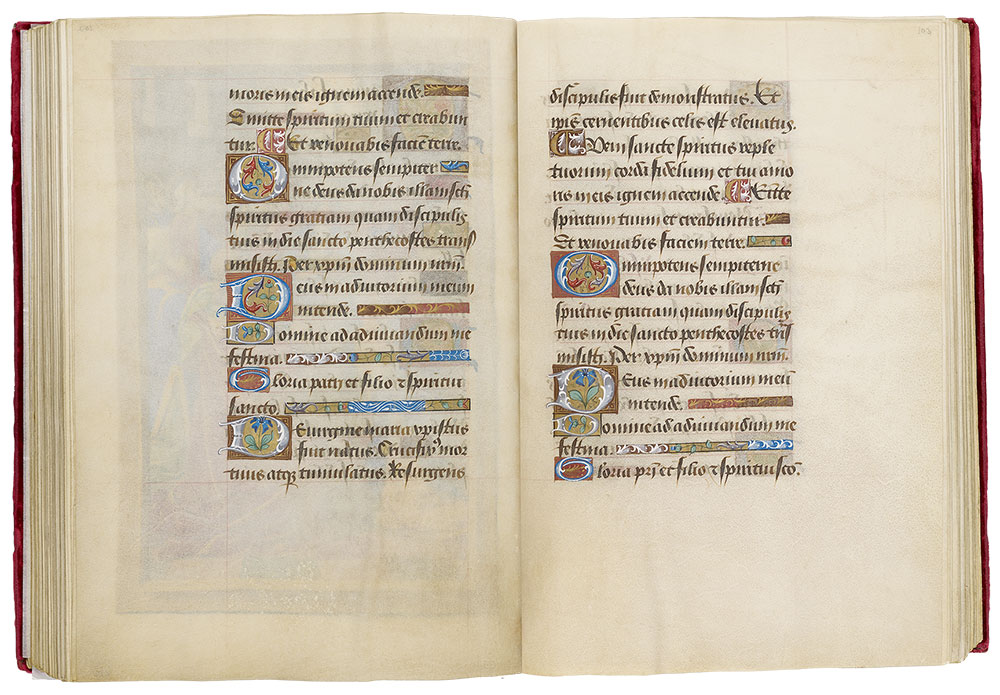
Hours of Henry VIII
Illuminated by Jean Poyer
Gift of the Heineman Foundation, 1977
MS H.8, fols. 103v–104r
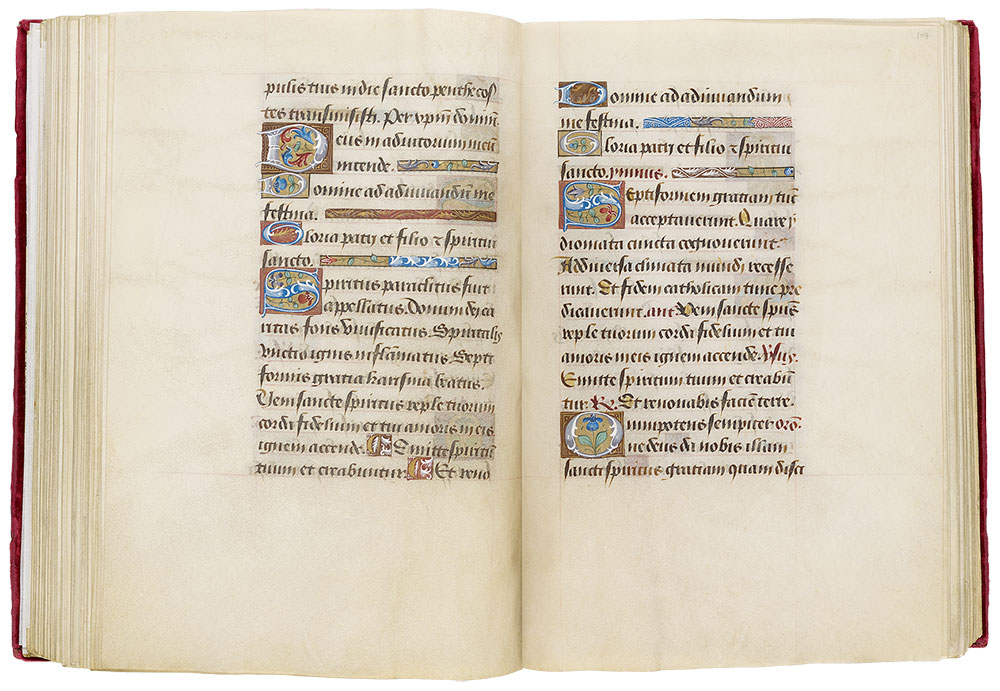
Hours of Henry VIII
Illuminated by Jean Poyer
Gift of the Heineman Foundation, 1977
MS H.8, fols. 104v–105r
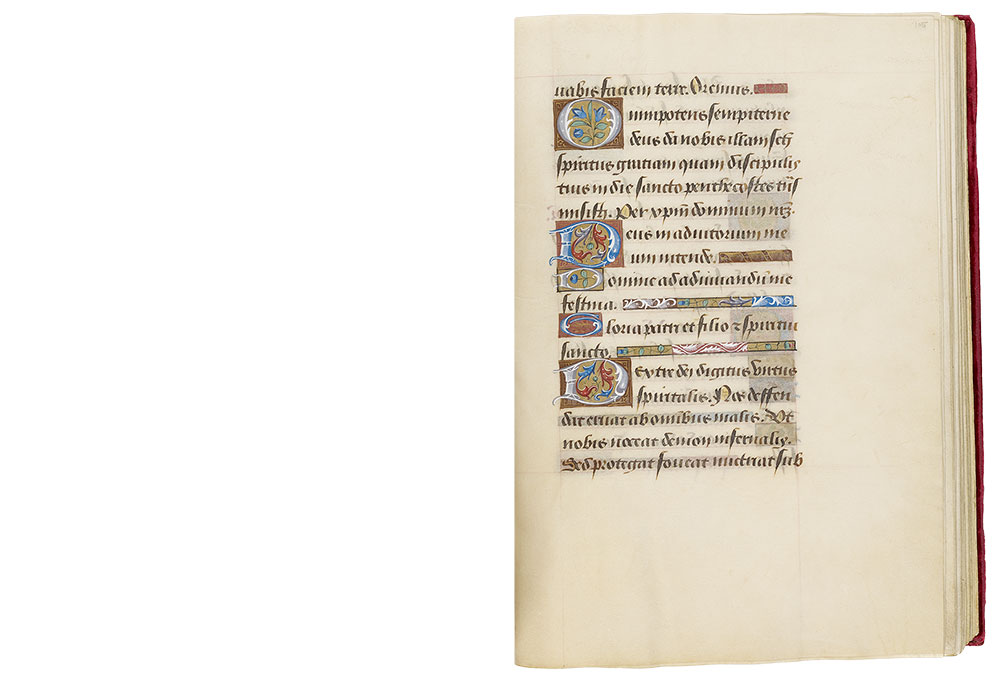
Hours of Henry VIII
Illuminated by Jean Poyer
Gift of the Heineman Foundation, 1977
MS H.8, fols. 105v–106r
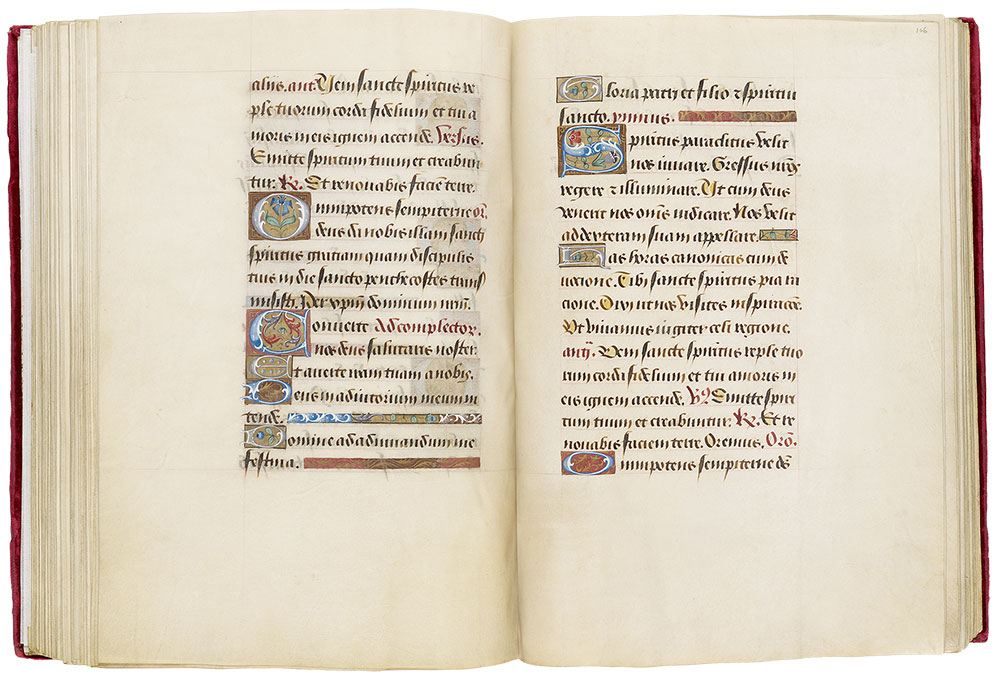
Hours of Henry VIII
Illuminated by Jean Poyer
Gift of the Heineman Foundation, 1977
MS H.8, fols. 106v–107r
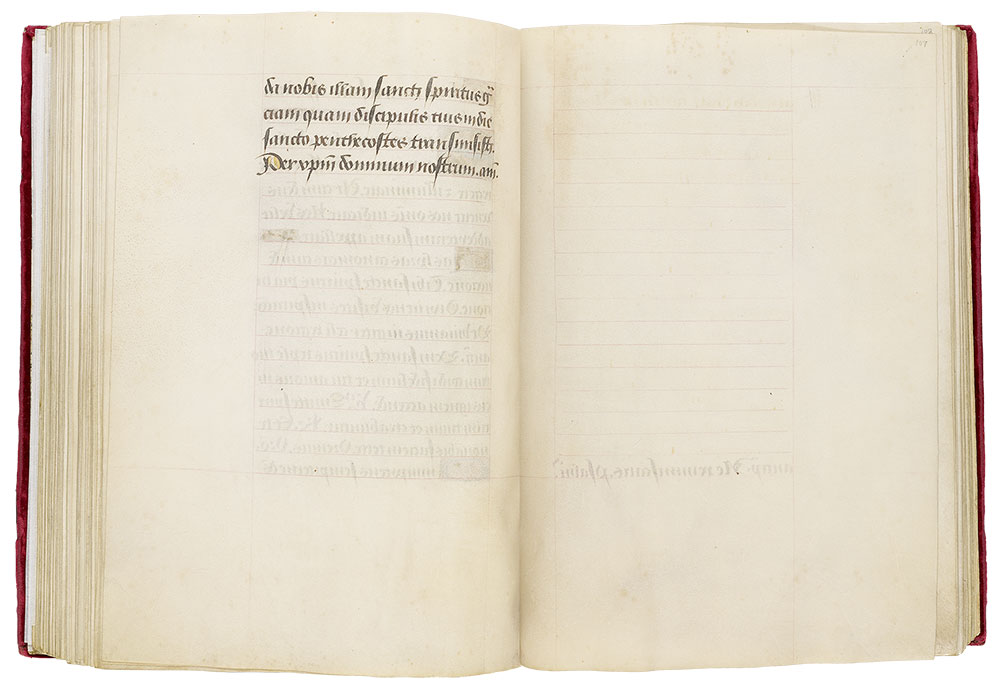
Hours of Henry VIII
Illuminated by Jean Poyer
Gift of the Heineman Foundation, 1977
Penitential Psalms and Litany, fol. 107v
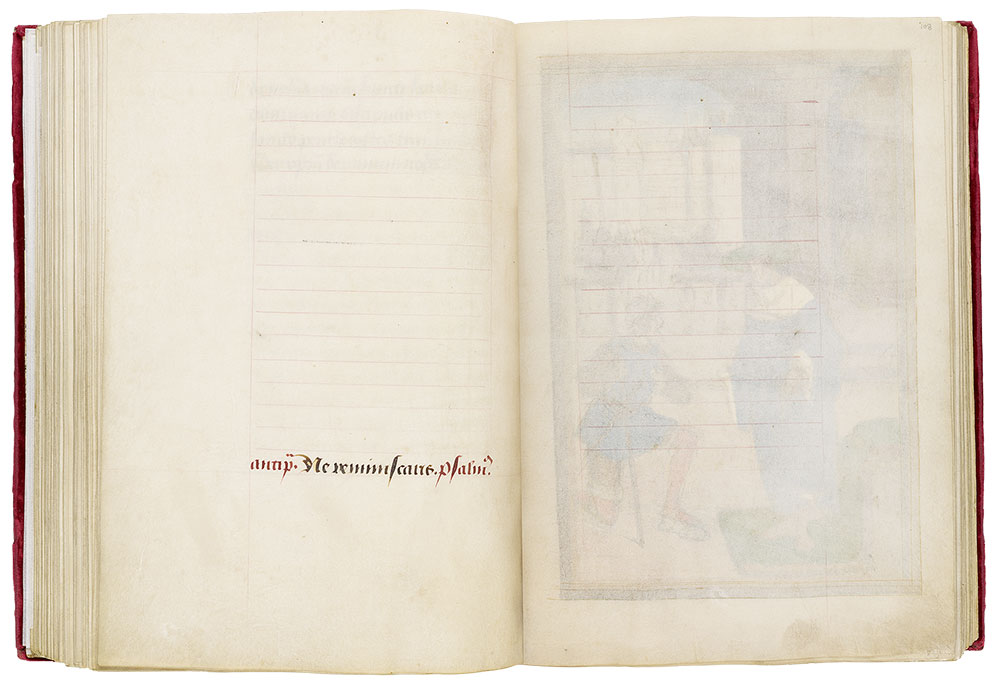
Hours of Henry VIII
Illuminated by Jean Poyer
Gift of the Heineman Foundation, 1977
MS H.8, fols. 108v–109r
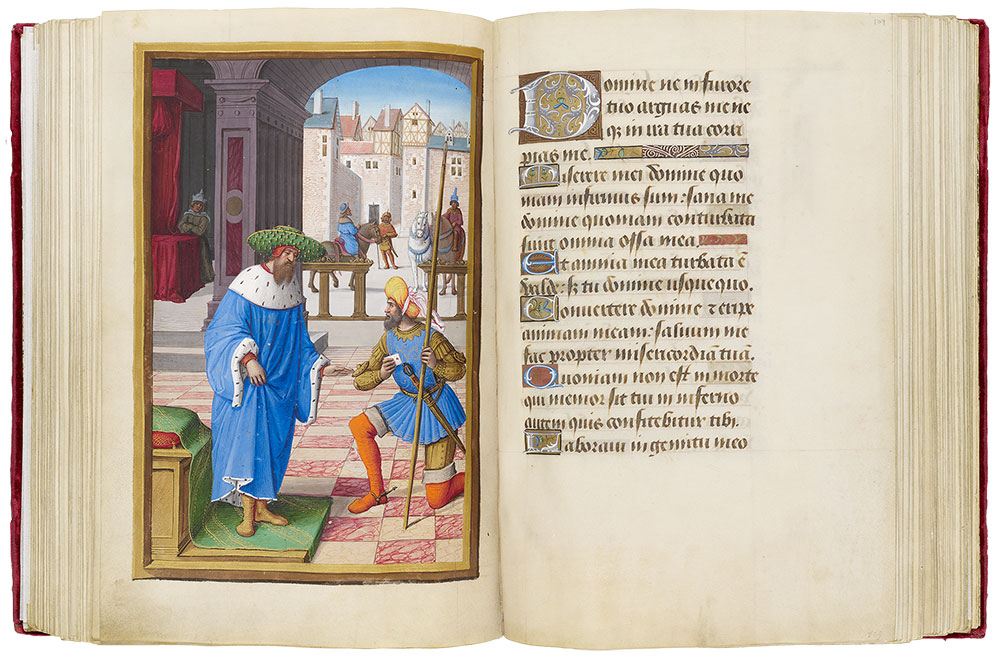
David and Uriah
Hours of Henry VIII
Illuminated by Jean Poyer
Gift of the Heineman Foundation, 1977
David and Uriah (fol. 108v)
In the miniature, Bathsheba's husband, one knee deferentially bent, has already received the sealed order from David, while his white horse stands ready in the background. A shadowy figure stands by the canopied bed to the left, where the sin was consummated.
To solve the problem of Bathsheba's pregnancy, the king sent a letter to Joab ordering him to place Uriah in the front of the battle, where he would surely be killed (2 Samuel 11:14–15).
Although King David in Penance is the usual and obvious subject selected to mark the Penitential Psalms, his adultery with Bathsheba is also popular at this time. Somewhat rarer is the episode selected here, which occurred after his adultery, when he summoned Uriah, her husband, to Jerusalem. He had conveniently been away, serving in the army under Joab.
Penitential Psalms and Litany (fols. 107v–127)
According to medieval tradition, the Seven Penitential Psalms were written by King David as penance for his grievous sins. In any case, the seven Psalms (6, 31, 37, 50, 101, 129, and 142) were long associated with atonement and had already formed part of Jewish liturgy; they were certainly known by Christians in the West by the sixth century, when Cassiodorus, a Roman historian, statesman, and monk, regarded them as a sevenfold means of obtaining forgiveness.
Theme of Miniature
This theme was probably selected to introduce the first Penitential Psalm because David's order for Uriah's death was considered a sin of "anger." The Psalm is the only one to include the name of a specific Deadly Sin, ira, the Latin word for anger. In addition, the Penitential Psalms in some early-sixteenth-century printed Parisian Horae are illustrated by the same subject, along with a rubric stating that the first Psalm should be invoked against that sin.
MS H.8, fols. 109v–110r
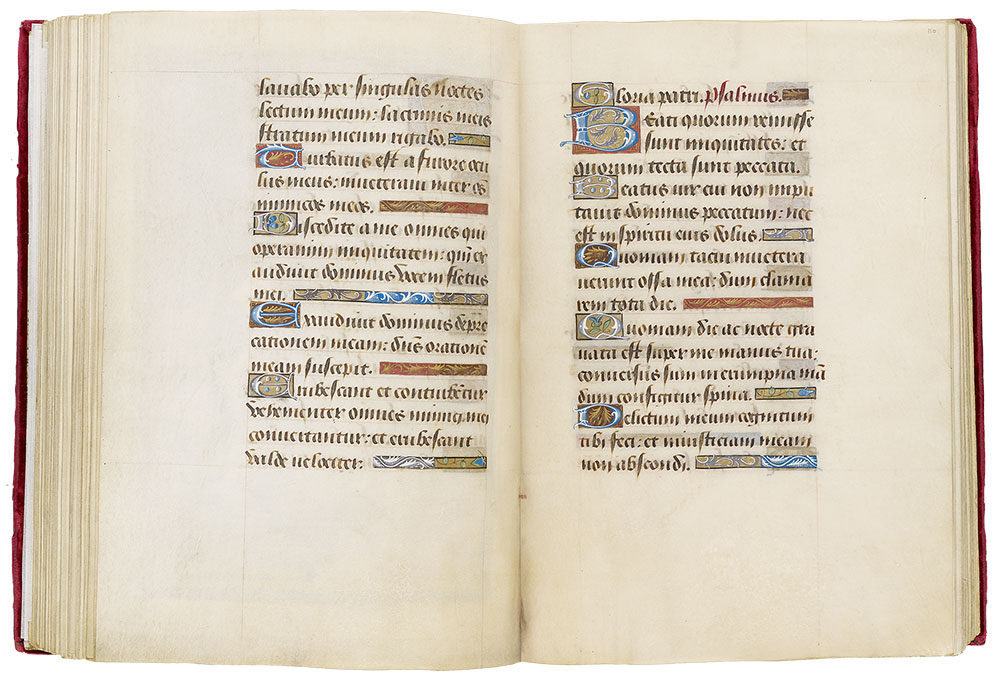
Hours of Henry VIII
Illuminated by Jean Poyer
Gift of the Heineman Foundation, 1977
MS H.8, fols. 110v–111r
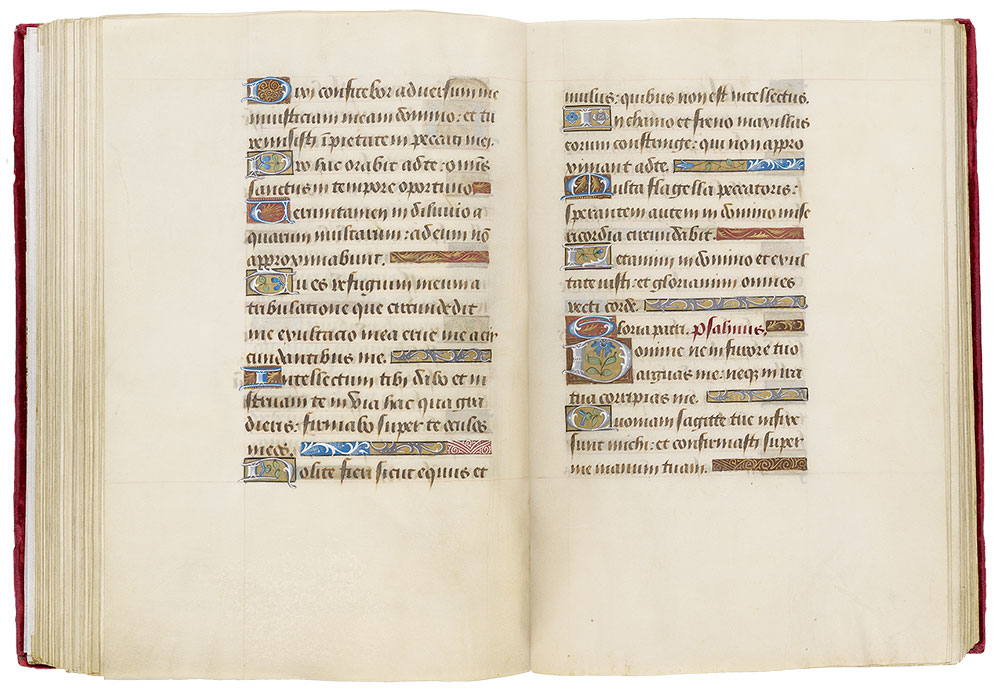
Hours of Henry VIII
Illuminated by Jean Poyer
Gift of the Heineman Foundation, 1977
MS H.8, fols. 111v–112r
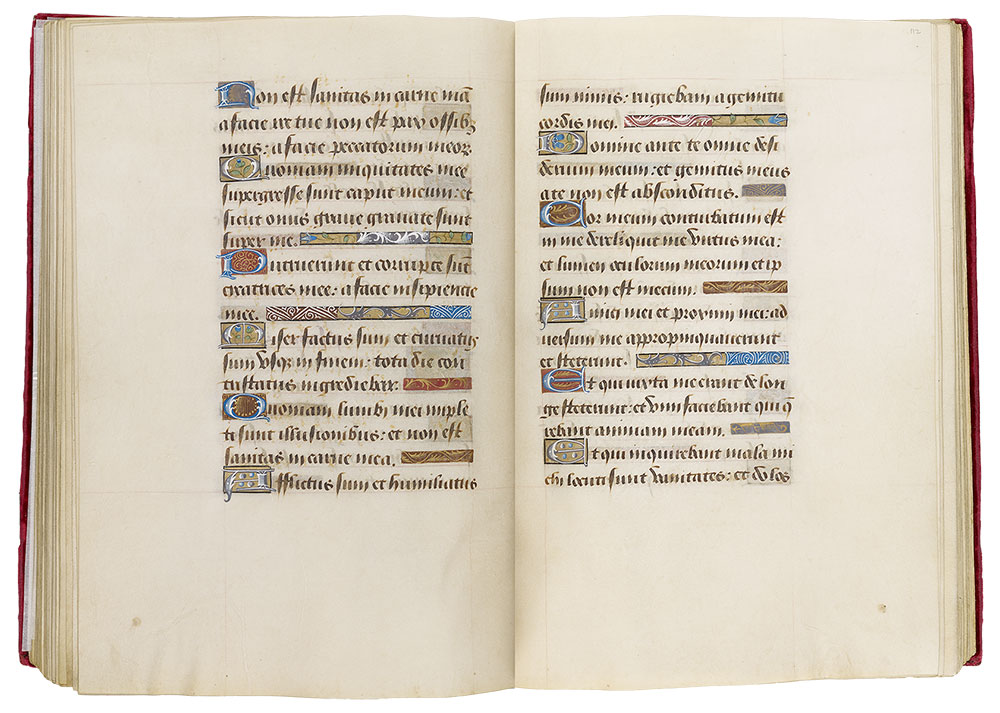
Hours of Henry VIII
Illuminated by Jean Poyer
Gift of the Heineman Foundation, 1977
MS H.8, fols. 112v–113r
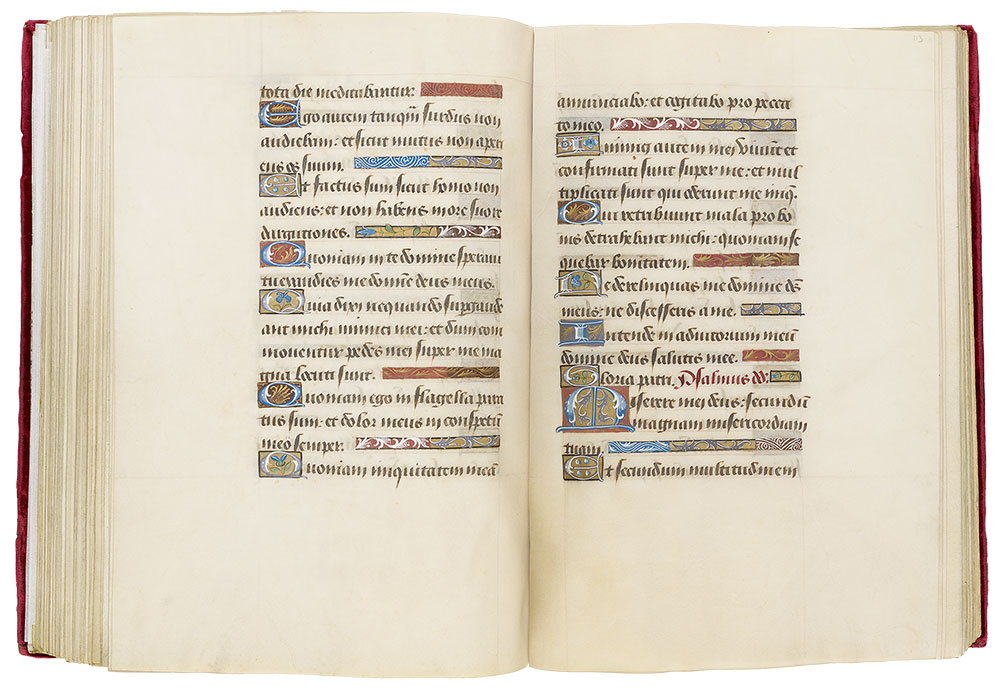
Hours of Henry VIII
Illuminated by Jean Poyer
Gift of the Heineman Foundation, 1977
MS H.8, fols. 113v–114r
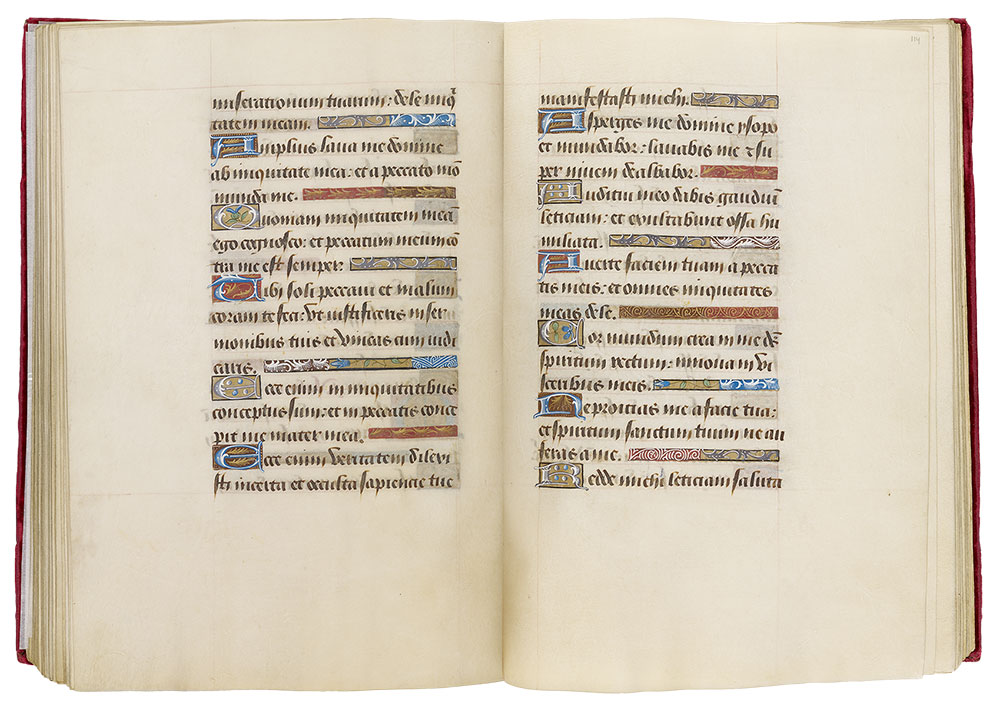
Hours of Henry VIII
Illuminated by Jean Poyer
Gift of the Heineman Foundation, 1977
MS H.8, fols. 114v–115r
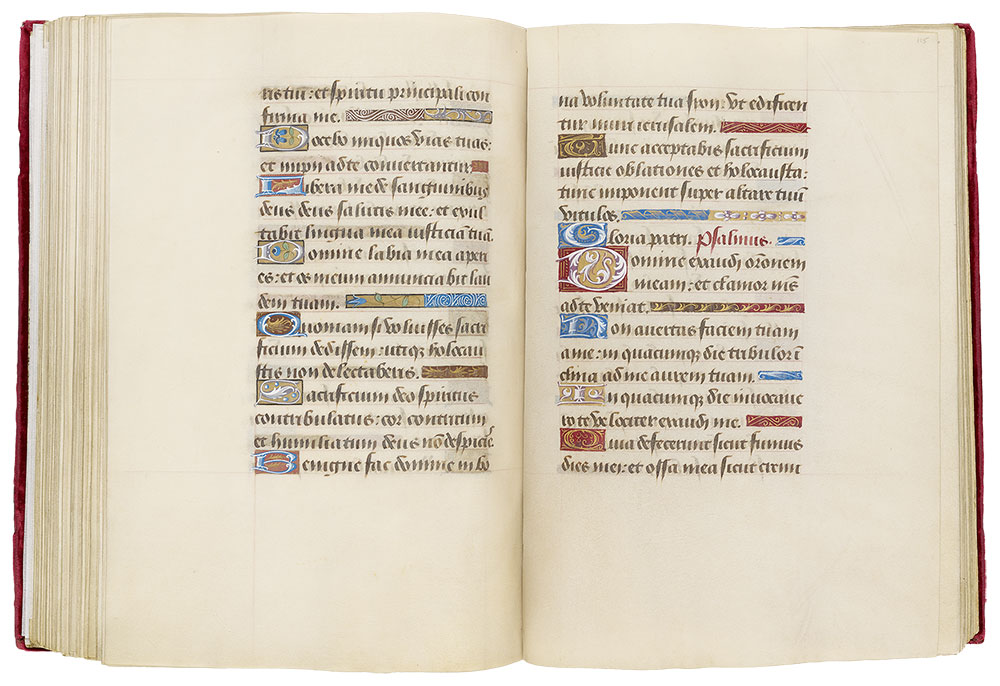
Hours of Henry VIII
Illuminated by Jean Poyer
Gift of the Heineman Foundation, 1977
MS H.8, fols. 115v–116r
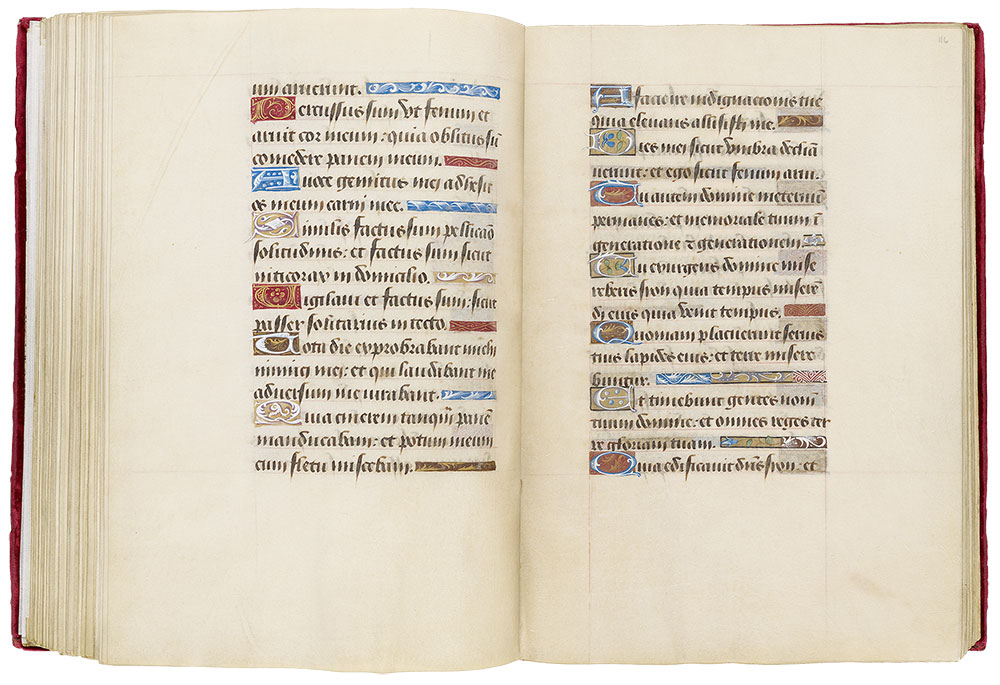
Hours of Henry VIII
Illuminated by Jean Poyer
Gift of the Heineman Foundation, 1977
MS H.8, fols. 116v–117r
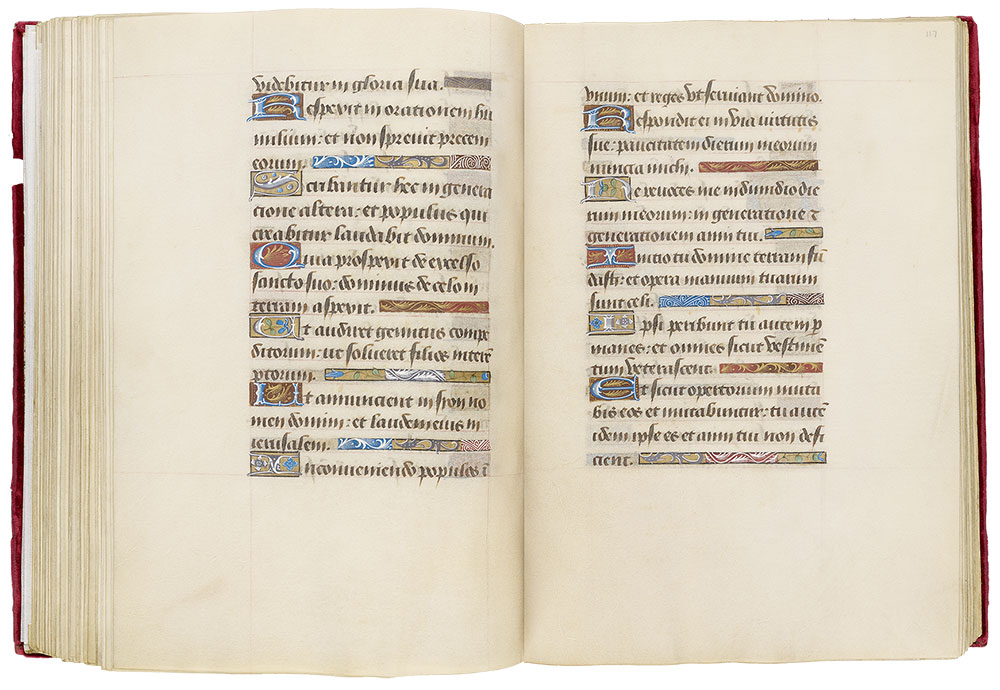
Hours of Henry VIII
Illuminated by Jean Poyer
Gift of the Heineman Foundation, 1977
MS H.8, fols. 117v–118r
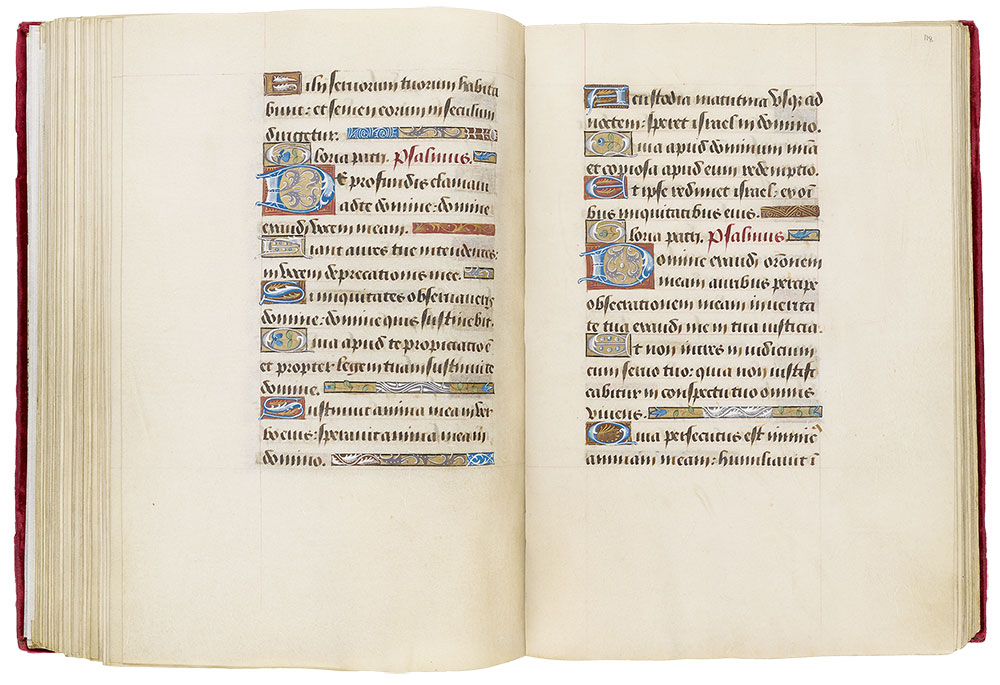
Hours of Henry VIII
Illuminated by Jean Poyer
Gift of the Heineman Foundation, 1977
MS H.8, fols. 118v–119r
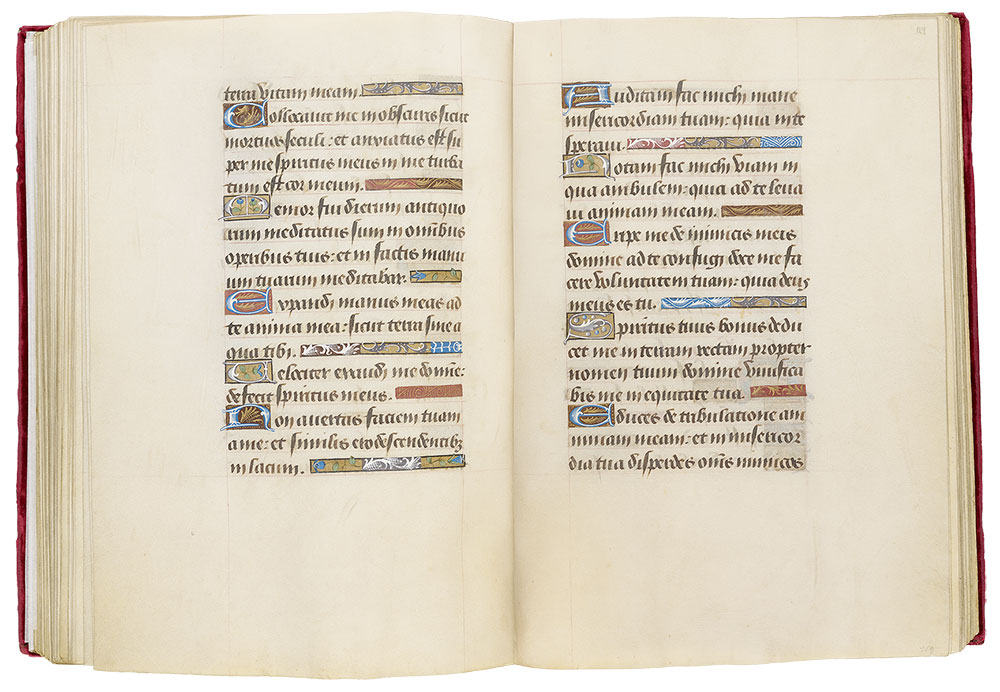
Hours of Henry VIII
Illuminated by Jean Poyer
Gift of the Heineman Foundation, 1977
MS H.8, fols. 119v–120r
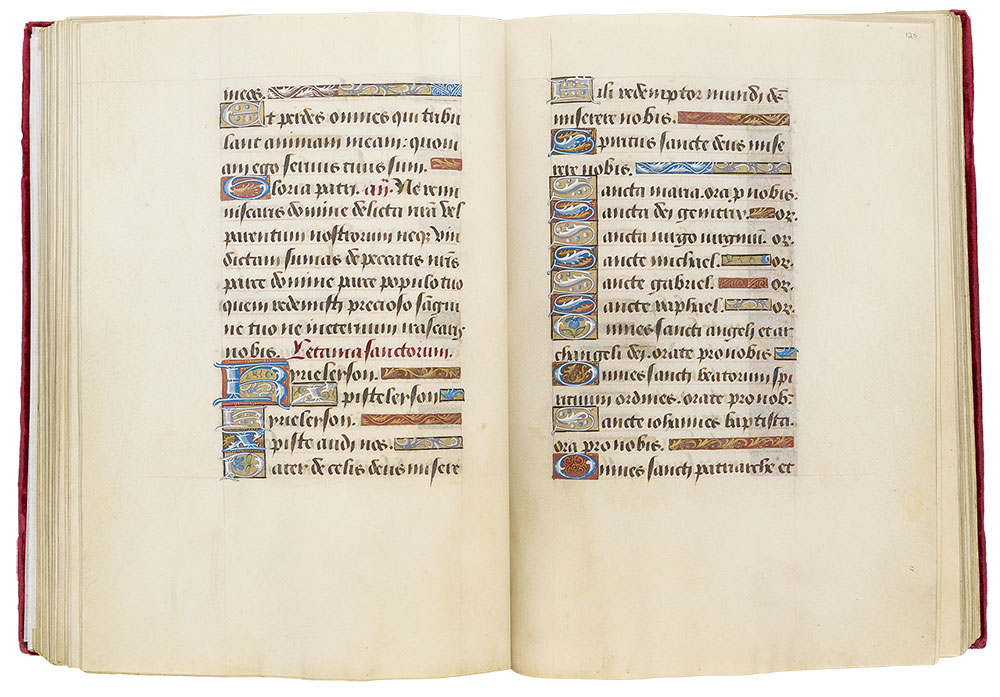
Hours of Henry VIII
Illuminated by Jean Poyer
Gift of the Heineman Foundation, 1977
MS H.8, fols. 120v–121r
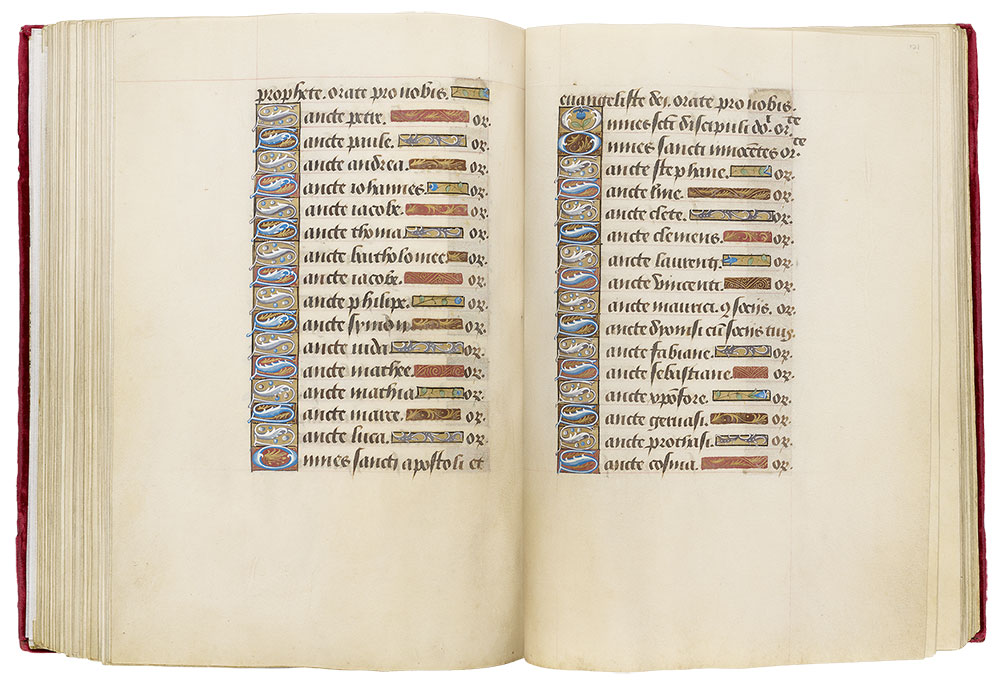
Hours of Henry VIII
Illuminated by Jean Poyer
Gift of the Heineman Foundation, 1977
MS H.8, fols. 121v–122r
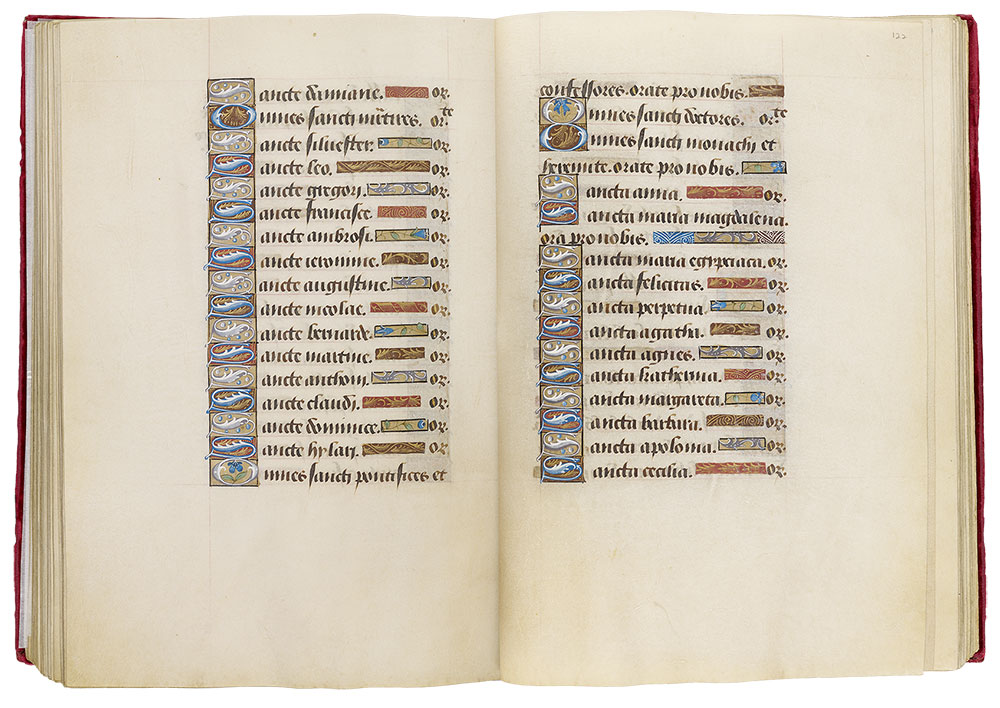
Hours of Henry VIII
Illuminated by Jean Poyer
Gift of the Heineman Foundation, 1977
MS H.8, fols. 122v–123r
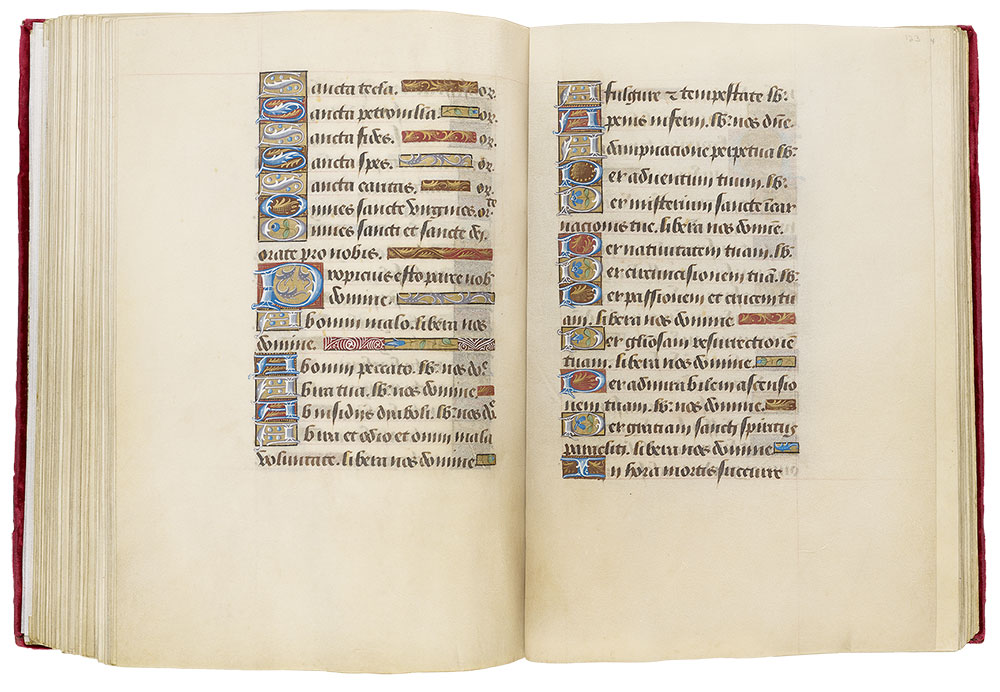
Hours of Henry VIII
Illuminated by Jean Poyer
Gift of the Heineman Foundation, 1977
MS H.8, fols. 123v–124r
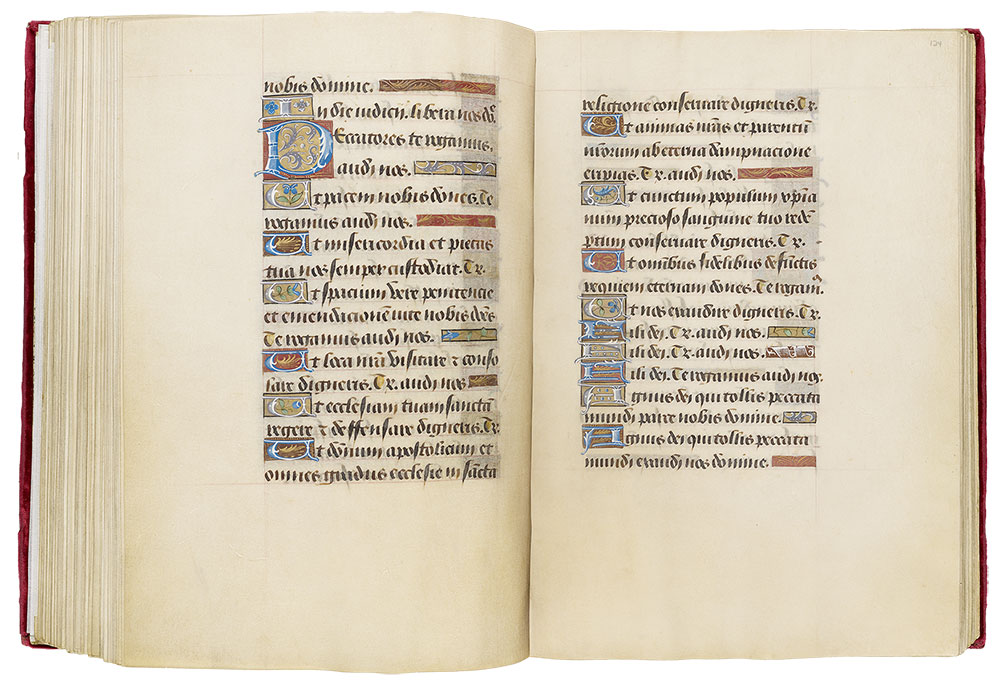
Hours of Henry VIII
Illuminated by Jean Poyer
Gift of the Heineman Foundation, 1977
MS H.8, fols. 124v–125r
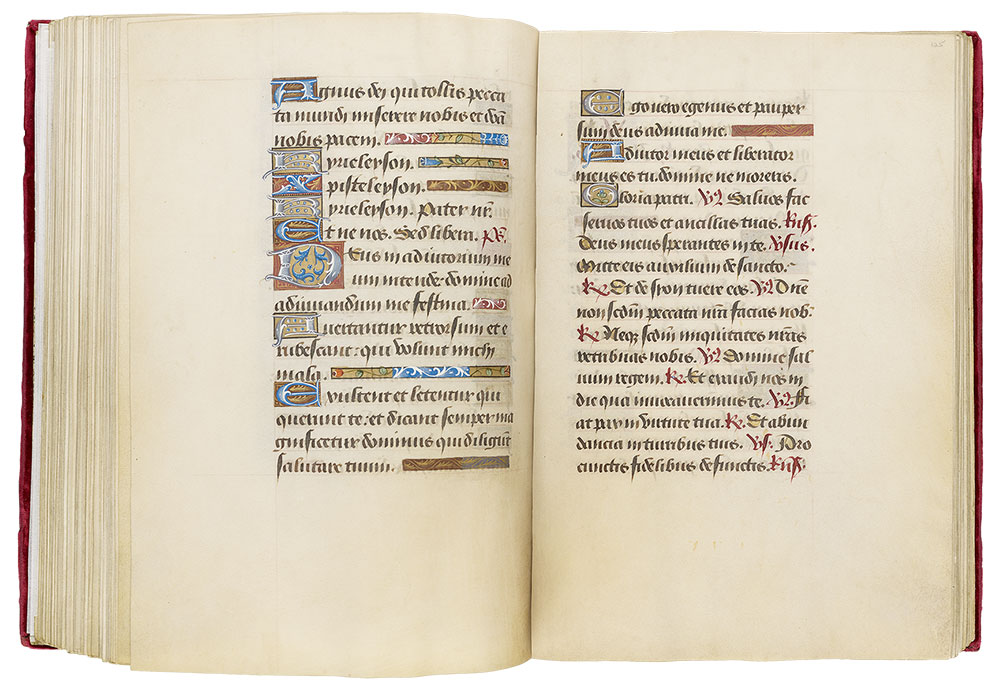
Hours of Henry VIII
Illuminated by Jean Poyer
Gift of the Heineman Foundation, 1977
MS H.8, fols. 125v–126r
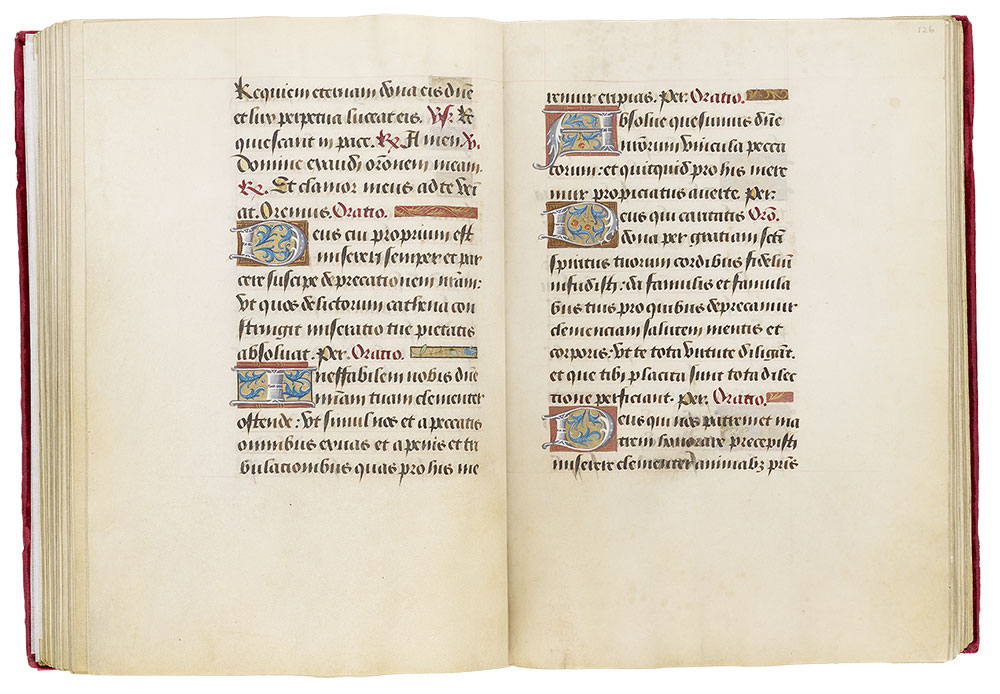
Hours of Henry VIII
Illuminated by Jean Poyer
Gift of the Heineman Foundation, 1977
MS H.8, fols. 126v–127r
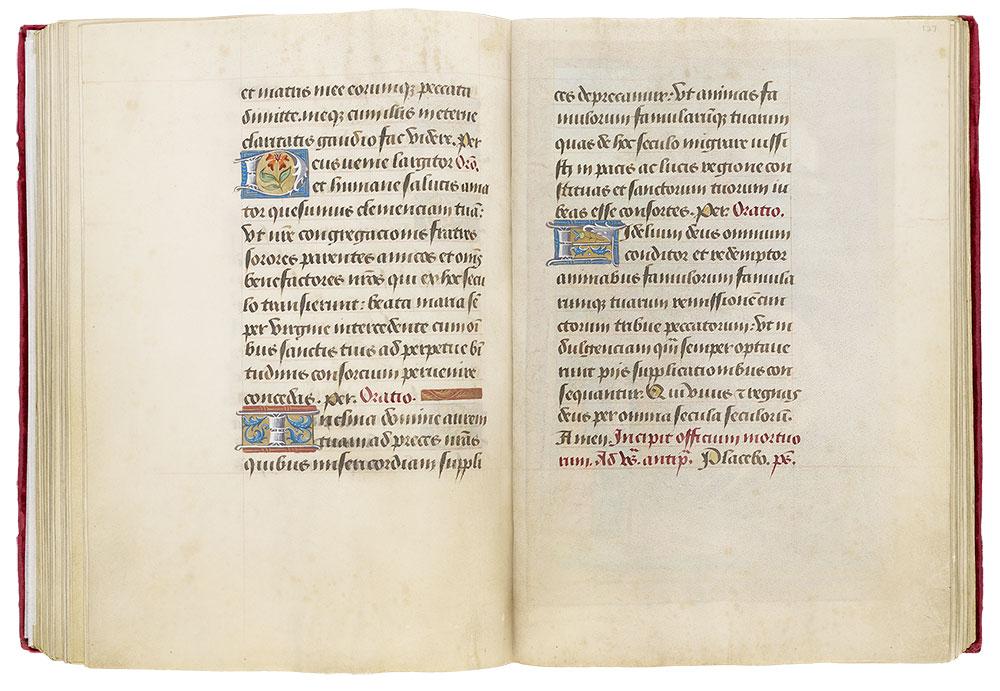
Hours of Henry VIII
Illuminated by Jean Poyer
Gift of the Heineman Foundation, 1977
Office of the Dead, fol. 127v
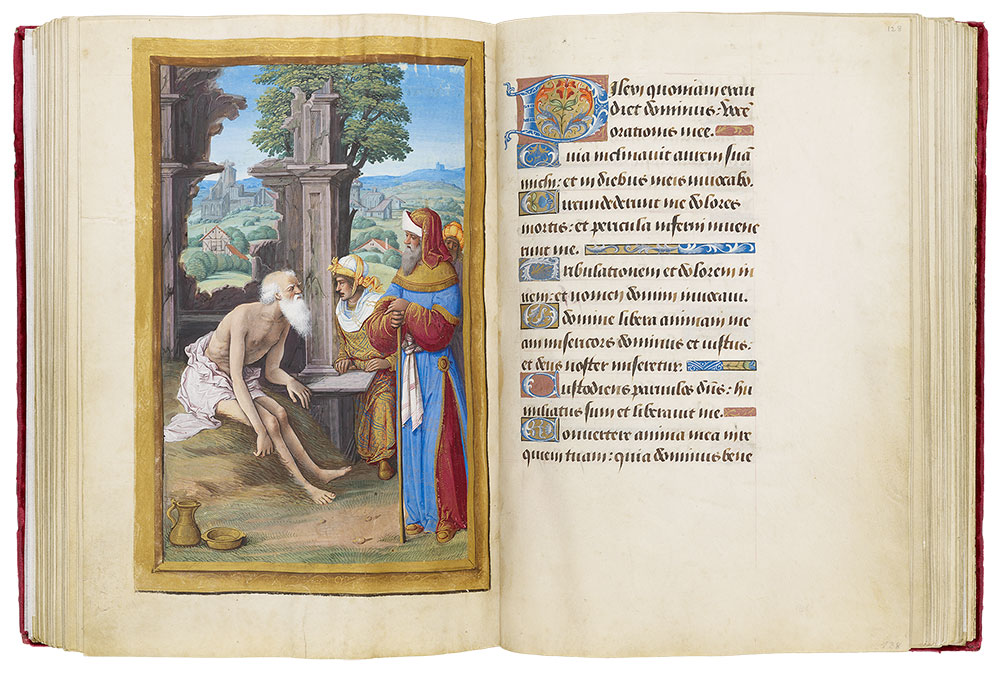
Vespers: Job on the Dungheap
Hours of Henry VIII
Illuminated by Jean Poyer
Gift of the Heineman Foundation, 1977
Vespers: Job on the Dungheap (fol. 127v)
This image of Job elegantly conveys some of the main themes found in the lessons: the brevity of life and its miseries, the constant request for deliverance, and above all, the conviction of faith that permits one to declare he knows that his Redeemer lives.
This miniature depicts Poyer's portrayal of the discourse between the three men that went in Job's favor. His friends incurred the wrath of God, who then instructed them, in a dramatic turnabout, to seek Job's intercession on their behalf, which he gave. Not surprisingly, some of the Church Fathers, such as Gregory the Great, regarded Job as a prophet of the general Resurrection of the Dead.
Although Poyer has depicted Job in a loincloth, he has not included the boils. According to Pope Gregory the Great (r. 590–604), Job sat on the dungheap so that he might consider the substance of the flesh and how quickly it returned to stench.
In medieval lore Job's friends attempt to convince him to give up his faith, but he remains steadfast. Elegantly dressed, they are wealthy, as Job was before God permitted Satan to test his faith. Job is not moved but patient, even though the youngest friend kneels in order to add direct eye contact to the persuasiveness of his argument.
Office of the Dead (fols. 127–67v)
The Office of the Dead usually followed the Penitential Psalms and Litany, shifting the focus of prayer from oneself to the deceased, a function that was more clearly evident from its old name, the Office for the Dead.
The Office of the Dead's importance is indicated by its length (it is second only to the Hours of the Virgin) and by the fact that it is exactly the same Office as found in Breviaries and Antiphonaries. The threat of long periods in the painful fires of purgatory was a serious matter, and anything that could be done to shorten or alleviate such suffering for loved ones had to be considered. Even though the Bible suggested that God would render to every man according to his works (Psalms 61:13), the early Church Fathers had already affirmed that prayers for the dead helped loose them from sins. St. Thomas Aquinas (1225–1274), likewise noted that charity extended not only to the living but also the dead and that punishments in purgatory could be entirely done away by a multiplicity of prayers, adding that those praying for the dead reaped benefits as well. The Councils of Lyons I (1254) and Florence (1439) both asserted that purgatory was a place of expiation and that prayers for the dead were important. Such prayers could aid suffering souls for sins that remained unexpiated by penance at the time of death. Since those in purgatory cannot pray for themselves, said Aquinas, their condition requires that we pray for them.
The Office, the present form of which goes back to the early ninth century, consists only of three Hours: Vespers, Matins, and Lauds; these were also known as "Placebo," "Dirige," and "Exultabant," respectively, after the first words of their opening antiphons. The second, "Dirige," gave rise to the present word dirge, referring to a mournful hymn at a funeral. Vespers was ideally prayed over the coffin in church on the evening before the funeral Mass. Monks were hired by the family to recite or chant it. Matins and Lauds were prayed, again by paid monks, on the morning of the funeral itself. The ordained, who recited the Office on a daily basis, provided an inspired model for the laity to pray it frequently at home. The purpose was the same, to help get the dearly departed out of purgatory as quickly as possible. As with most offices, each of the three Hours is composed of antiphons, psalms, versicles, and responses, except for Matins, which, as in the Hours of the Virgin, has three nocturns, each with three lessons. These psalms usually offer comfort to the dead; perhaps one of the most familiar is Psalm 22, the first recited in the second nocturn of Matins:
The Lord is my shepherd; I shall not want. He maketh me to lie down in green
pastures: he leadeth me beside the still waters. He restoreth my soul: he leadeth
me in the paths of righteousness for his name's sake. Yea, though I walk through
the valley of the shadow of death, I will fear no evil. . . . " (King James Version,
where it is numbered as Psalm 23)
The nine lessons are all taken from the Book of Job and are concerned with his pleadings for mercy and understanding. The extracts that follow, taken from several lessons, are typical:
How long wilt thou not spare me. . . . I have sinned, what shall I do to thee. . . . My
soul is weary of life. . . . Do not condemn me: tell me why thou judgest me so?
Make me know my crimes and offenses. . . . For thou writest bitter things against
me, and consumest me for the sins of my youth. . . . Who will grant me this, that
thou mayst protect me in hell. . . . Deliver me, O Lord, and set me beside thee. . . .
For I know that my redeemer liveth, and on the last day I shall rise out of the
earth. . . . And I shall be clothed again with my skin, and in my flesh I shall see my God.
The readings were selected in such a way that the name of Job is, in fact, never mentioned. Thus (as is clear from the extracts cited above), the first person singular pronoun, I, becomes the voice of the person reading the Office, undergoing trials and tribulations in his search for meaning, and for his understanding of and relationship to God. The Office ends with versicles and responses declaring the hoped for result.
Versicle. From the gates of Hell,
Response. Deliver their souls, O Lord.
Versicle. May they rest in peace.
Response. Amen
Although the Office of the Dead almost always contains a single miniature, the present manuscript has two. The second miniature, as here, usually marks the beginning of Matins, a division reflecting the practice of recitation observed above. Other examples are known, such as the Hours of Etienne Chevalier in Chantilly (Musée Condé, MS 71), which was painted by Jean Fouquet in the 1450s, and which Poyer had probably seen. Among the most common illustrations for the Office are various moments of the funeral (from deathbed to burial), the Last Judgment, Raising of Lazarus, Hell, personifications of Death, Job on the Dungheap, and the Parable of Dives and Lazarus. The last two subjects were selected for the Hours of Henry VIII. Although the nine Matins lessons are taken from the Book of Job, they do not specifically refer to the theme that frequently serves as a frontispiece for the Office, Job's discourse with his three friends, Eliphaz, Bildad, and Zophar.
MS H.8, fols. 128v–129r
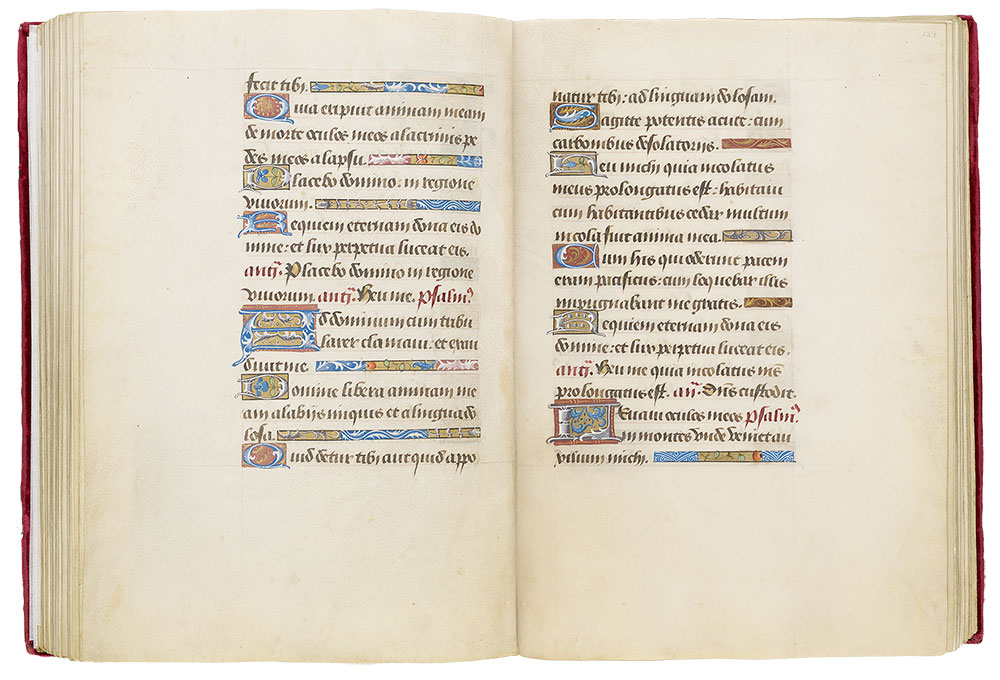
Hours of Henry VIII
Illuminated by Jean Poyer
Gift of the Heineman Foundation, 1977
MS H.8, fols. 129v–130r
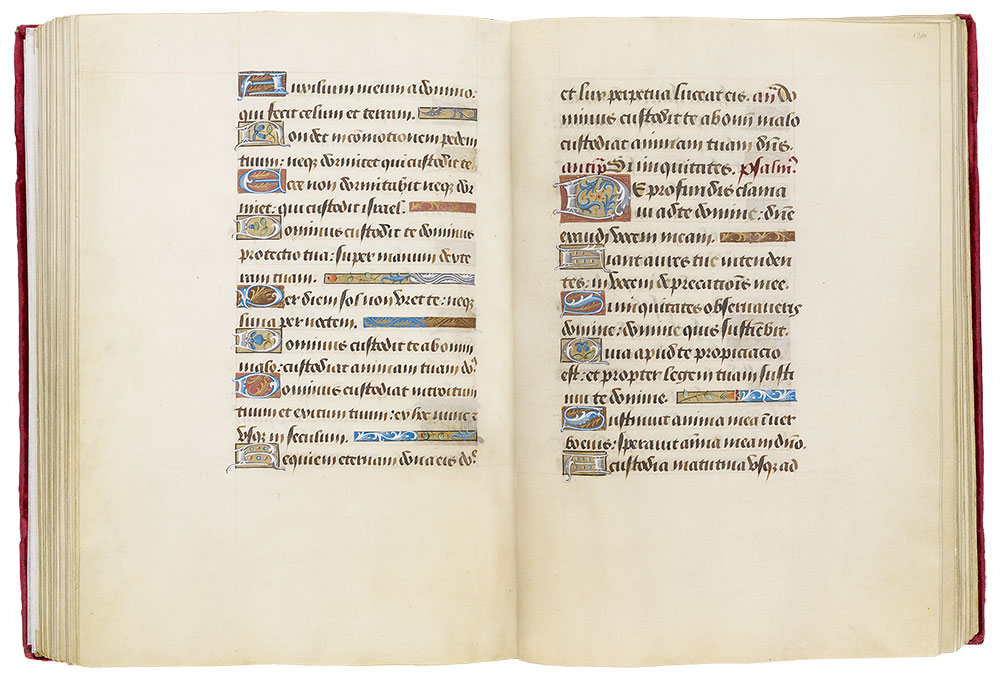
Hours of Henry VIII
Illuminated by Jean Poyer
Gift of the Heineman Foundation, 1977
MS H.8, fols. 130v–131r
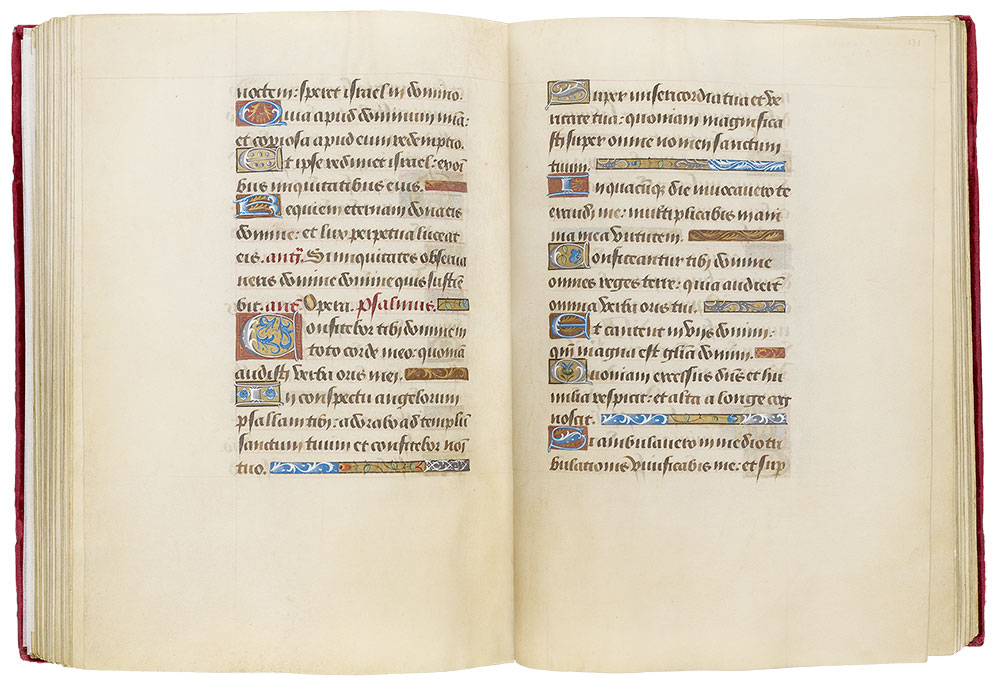
Hours of Henry VIII
Illuminated by Jean Poyer
Gift of the Heineman Foundation, 1977
MS H.8, fols. 131v–132r
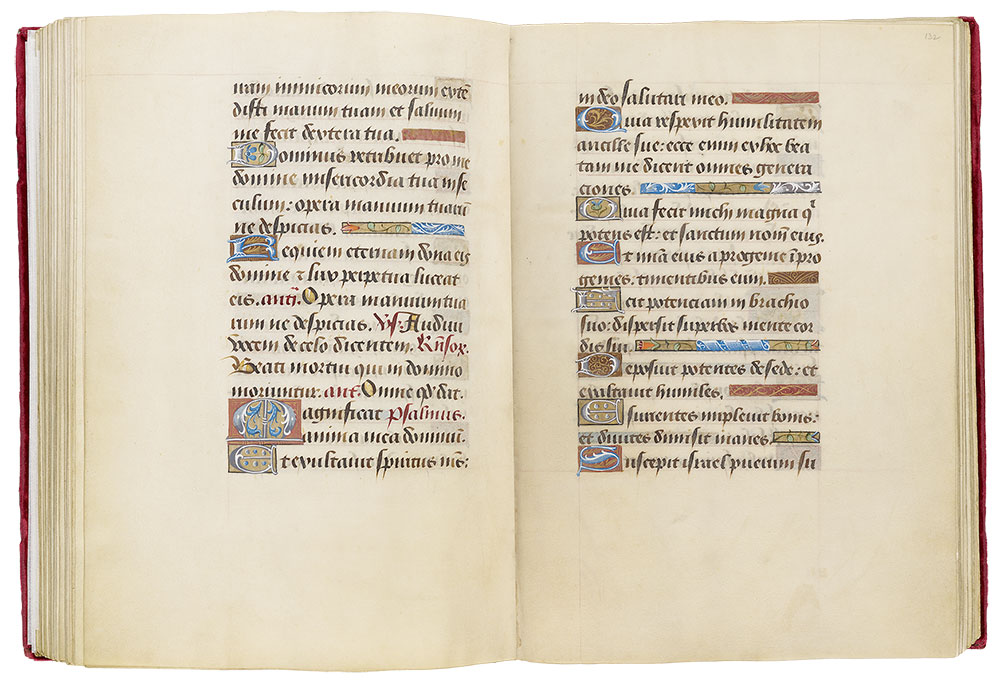
Hours of Henry VIII
Illuminated by Jean Poyer
Gift of the Heineman Foundation, 1977
MS H.8, fols. 132v–133r
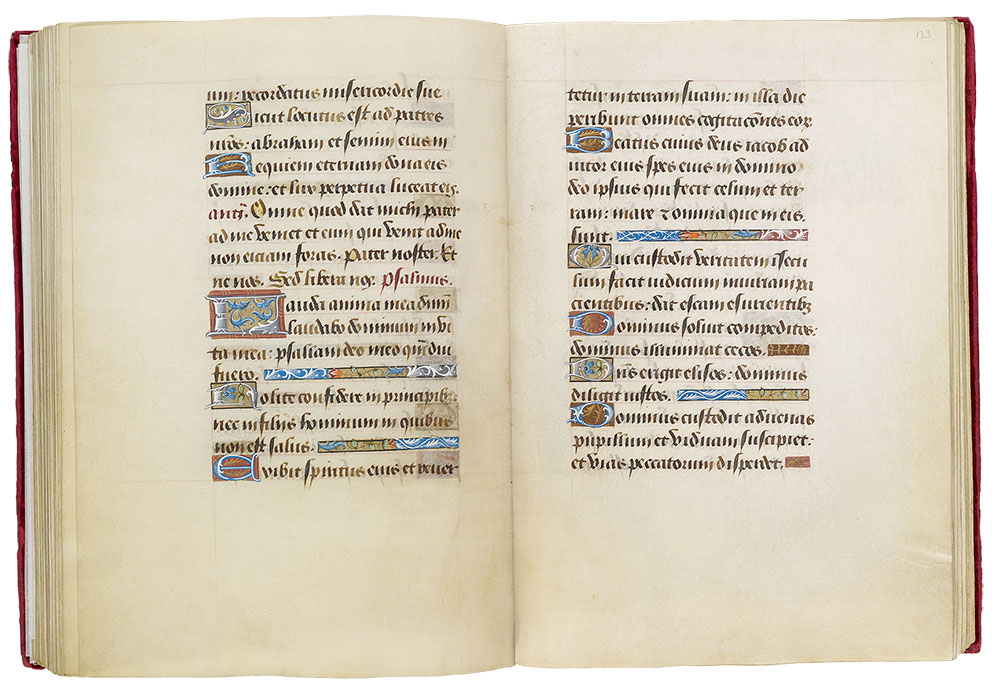
Hours of Henry VIII
Illuminated by Jean Poyer
Gift of the Heineman Foundation, 1977
MS H.8, fols. 133v–134r
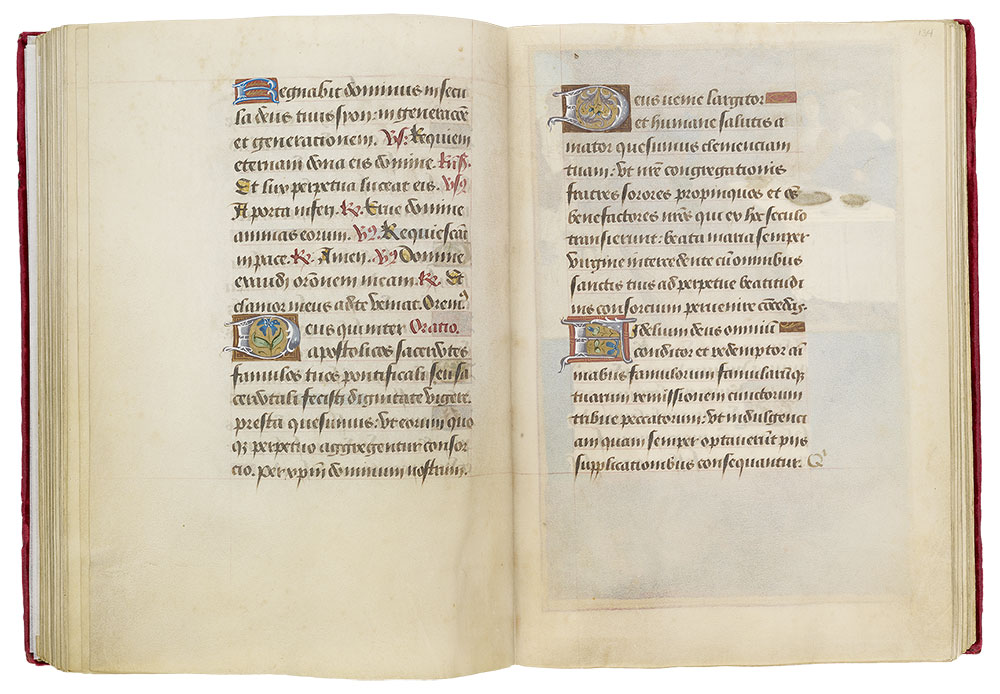
Hours of Henry VIII
Illuminated by Jean Poyer
Gift of the Heineman Foundation, 1977
MS H.8, fols. 134v–135r
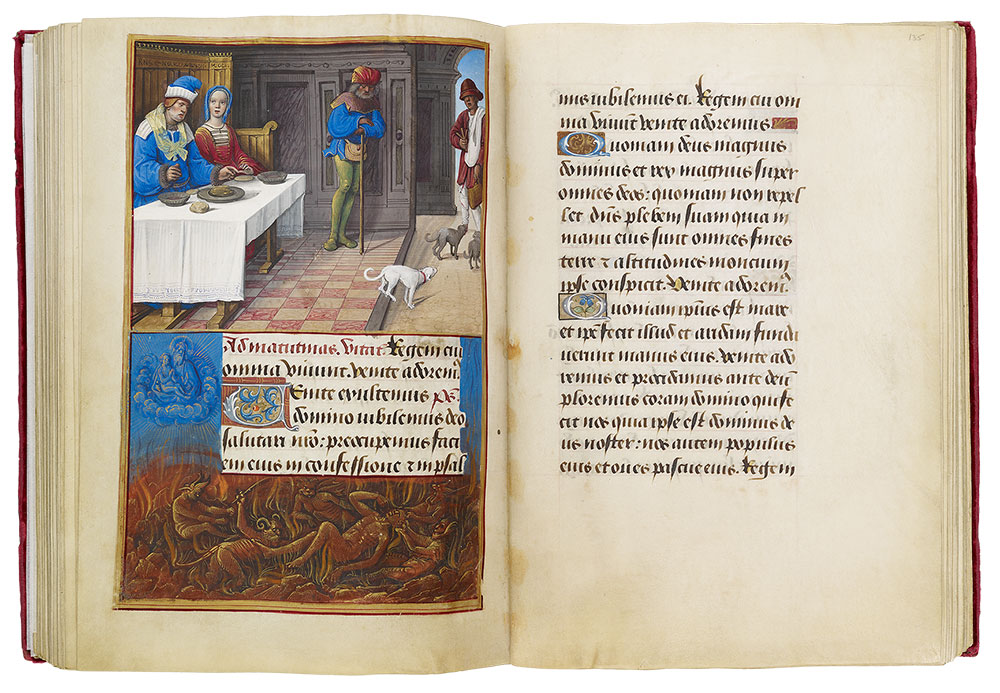
Matins: Feast of Dives
Hours of Henry VIII
Illuminated by Jean Poyer
Gift of the Heineman Foundation, 1977
Matins: Feast of Dives
Border: Dives in Hell (fol. 134v)
The second illustration for the Office of the Dead is smaller and is laid out like the Calendar and Suffrages, where half-page miniatures are in full color and marginal scenes in grisaille.
In the miniature the elegantly dressed rich man and his wife are about to enjoy a meal; Dives, who receives a glance from his wife, looks with disdain at a poor man named Lazarus entering the banquet hall.
The main subject of this illustration is the Feast of Dives, which derives from Luke's parable of the rich man (16:19–31). According to the story an unnamed rich man (Latin: dives) ate sumptuous meals every day in full view of a poor man named Lazarus.
Lazarus sought only the crumbs that fell from the rich man's table; however, while none were given him, the rich man's dogs came and licked Lazarus's sores. The beggar died and was carried by angels to Abraham's bosom.
A disinterested attendant stands nearby, while three dogs head toward Lazarus, who carries a small wooden keg and a clapper to warn passersby that he is a leper.
Abraham replied that he had received good things in his lifetime, while Lazarus had received evil things, but now Lazarus would be comforted while he would be tormented. It is, of course, significant that the poor man is worthy of being named while the rich man is not (this Lazarus, not to be confused with the Lazarus resurrected by Christ, has his feast day on June 21).
Down below, in the flames of hell (appropriately painted in red grisaille), Dives sees Lazarus in the bosom of Abraham (in heavenly blue grisaille) and points to his mouth, a reference to his unfulfilled request. The rich man died and ended up in hell, where, in considerable torment, he lifted his eyes and saw the dead Lazarus cradled by the patriarch. Suffering hell's flames (cf. lower half of image), the rich man asked Abraham to have Lazarus dip the tip of his finger in water and cool his tongue.
MS H.8, fols. 135v–136r
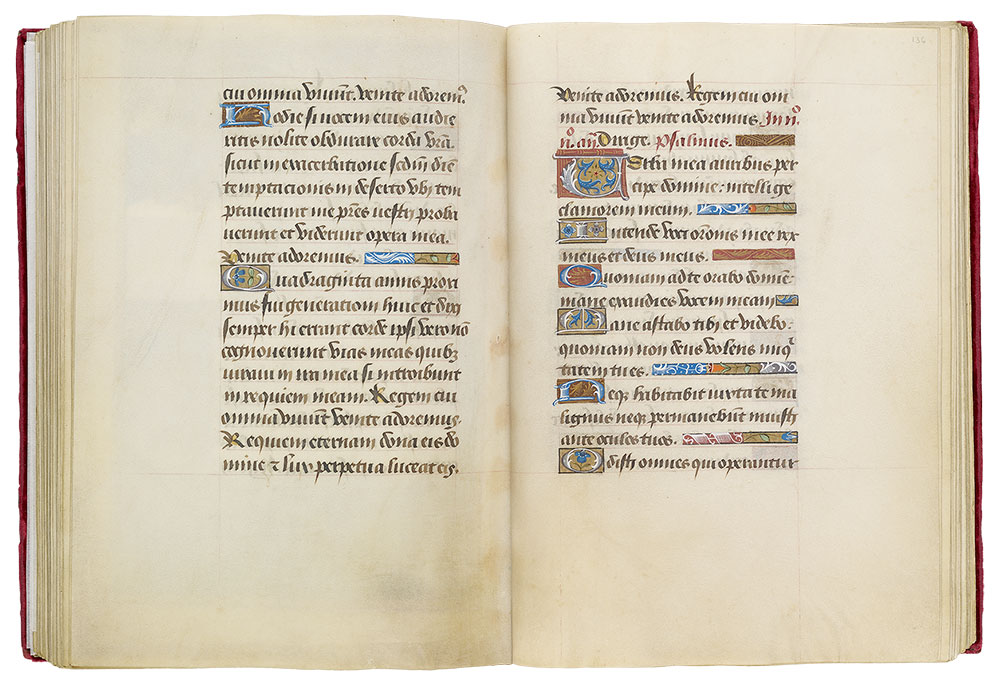
Hours of Henry VIII
Illuminated by Jean Poyer
Gift of the Heineman Foundation, 1977
MS H.8, fols. 136v–137r
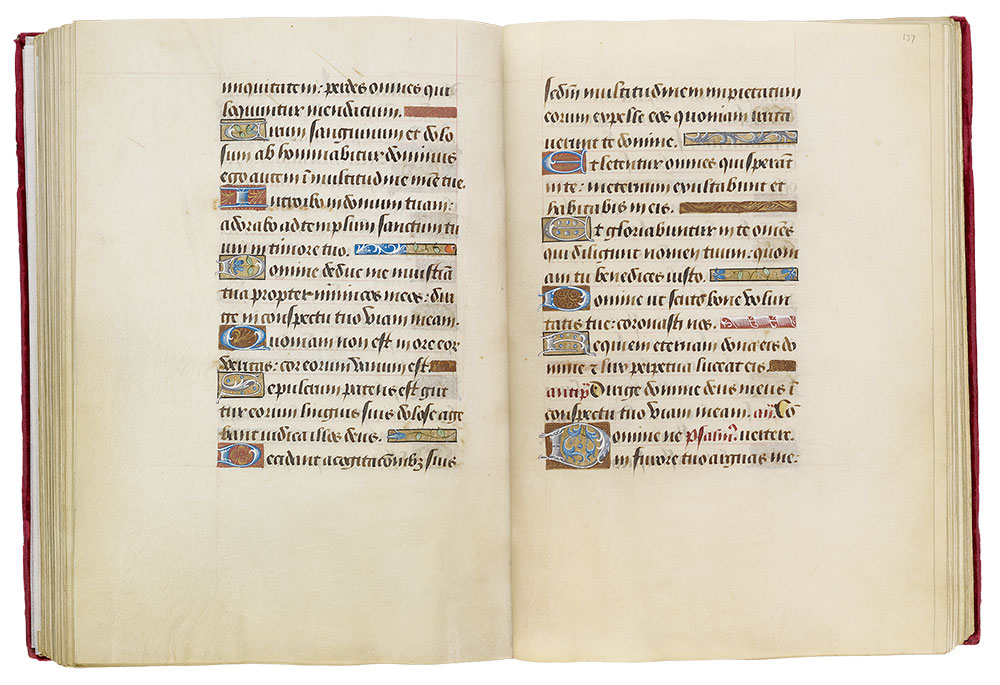
Hours of Henry VIII
Illuminated by Jean Poyer
Gift of the Heineman Foundation, 1977
MS H.8, fols. 137v–138r
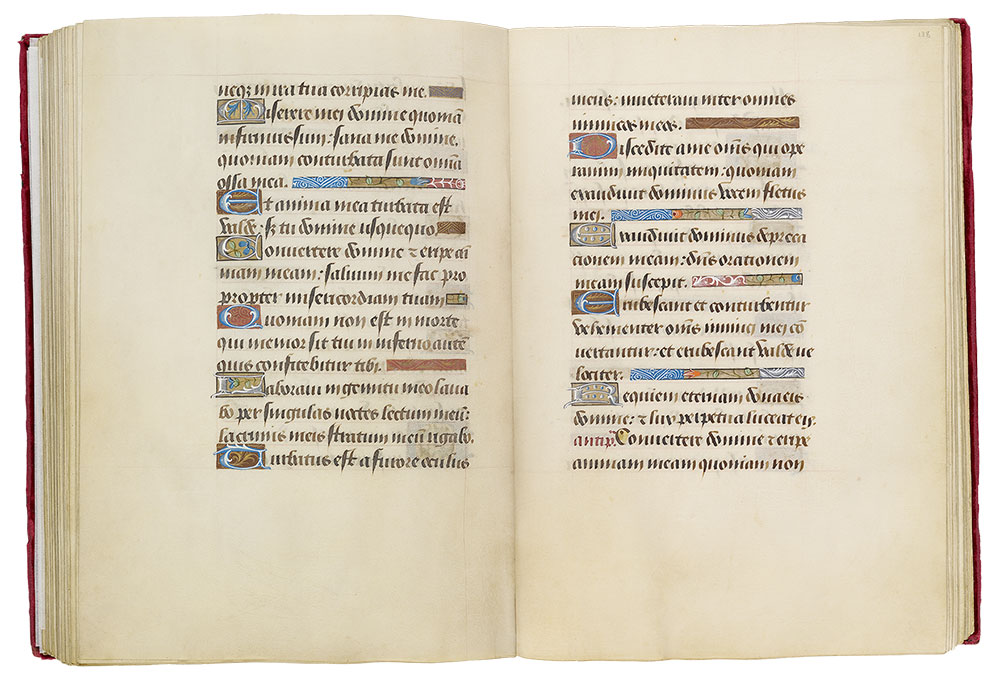
Hours of Henry VIII
Illuminated by Jean Poyer
Gift of the Heineman Foundation, 1977
MS H.8, fols. 138v–139r
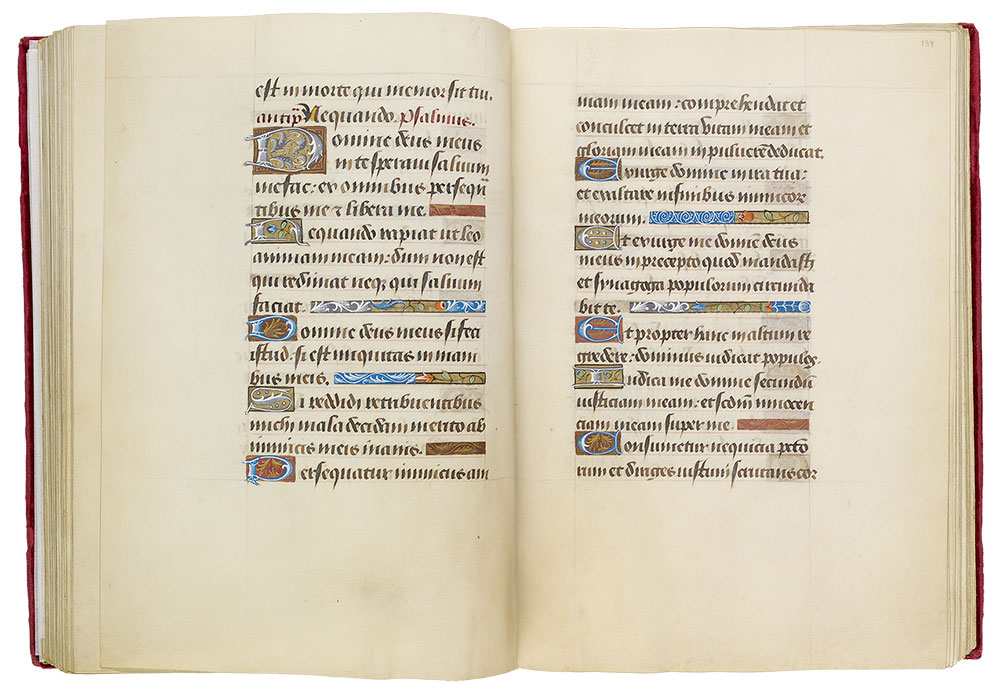
Hours of Henry VIII
Illuminated by Jean Poyer
Gift of the Heineman Foundation, 1977
MS H.8, fols. 139v–140r
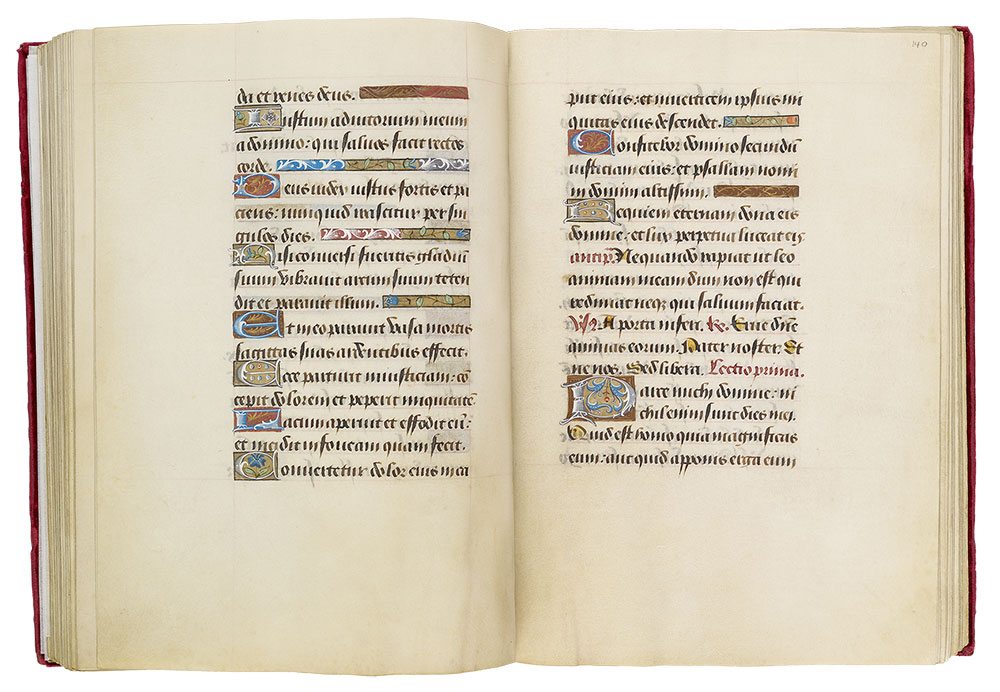
Hours of Henry VIII
Illuminated by Jean Poyer
Gift of the Heineman Foundation, 1977
MS H.8, fols. 140v–141r
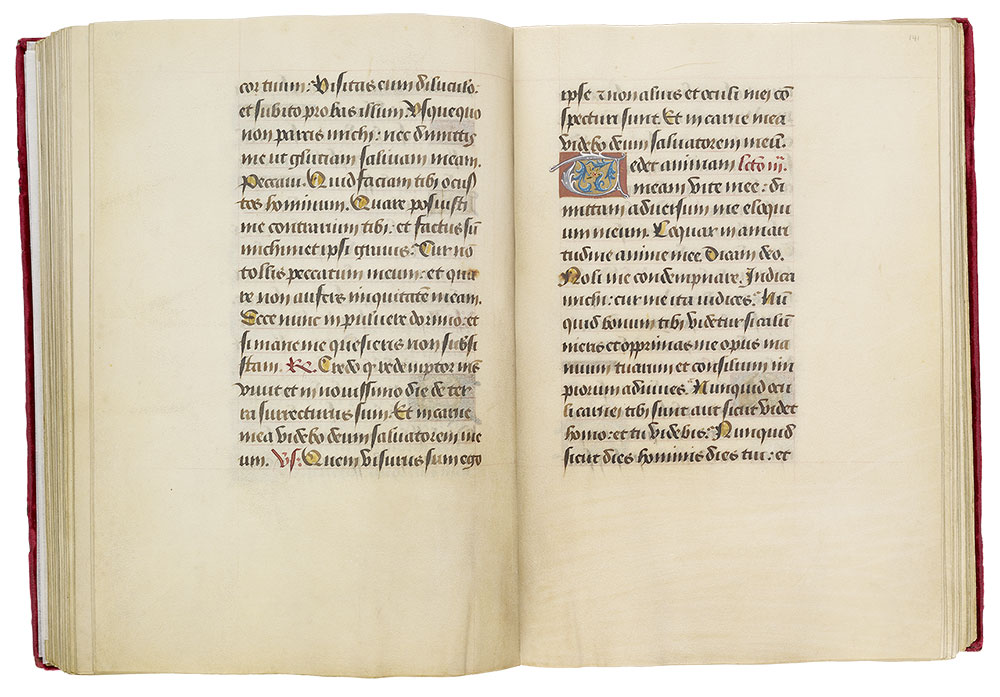
Hours of Henry VIII
Illuminated by Jean Poyer
Gift of the Heineman Foundation, 1977
MS H.8, fols. 141v–142r
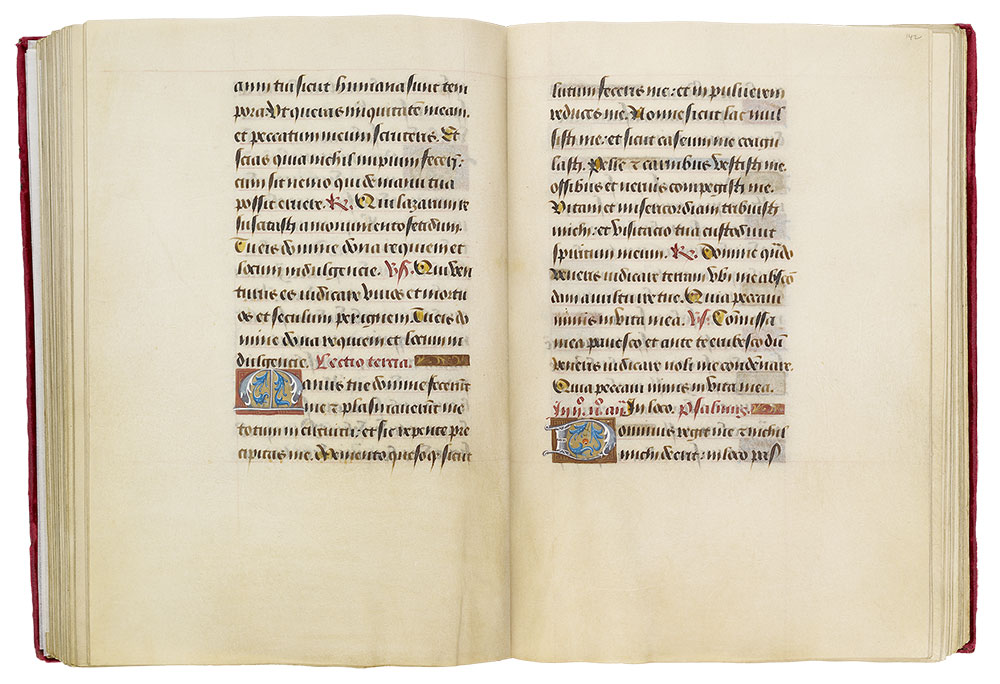
Hours of Henry VIII
Illuminated by Jean Poyer
Gift of the Heineman Foundation, 1977
MS H.8, fols. 142v–143r
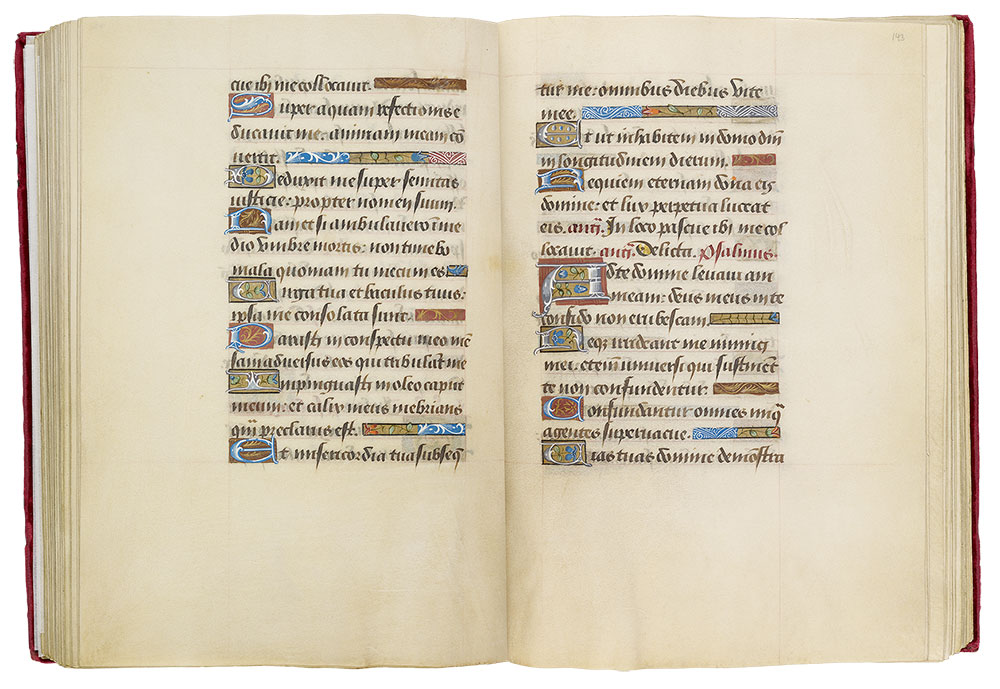
Hours of Henry VIII
Illuminated by Jean Poyer
Gift of the Heineman Foundation, 1977
MS H.8, fols. 143v–144r
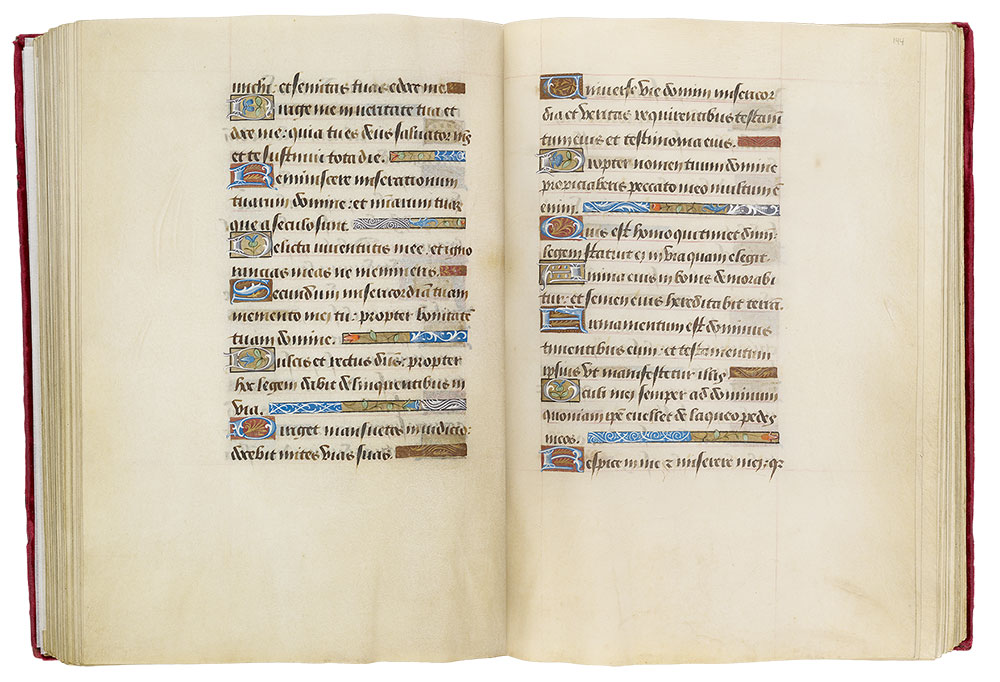
Hours of Henry VIII
Illuminated by Jean Poyer
Gift of the Heineman Foundation, 1977
MS H.8, fols. 144v–145r
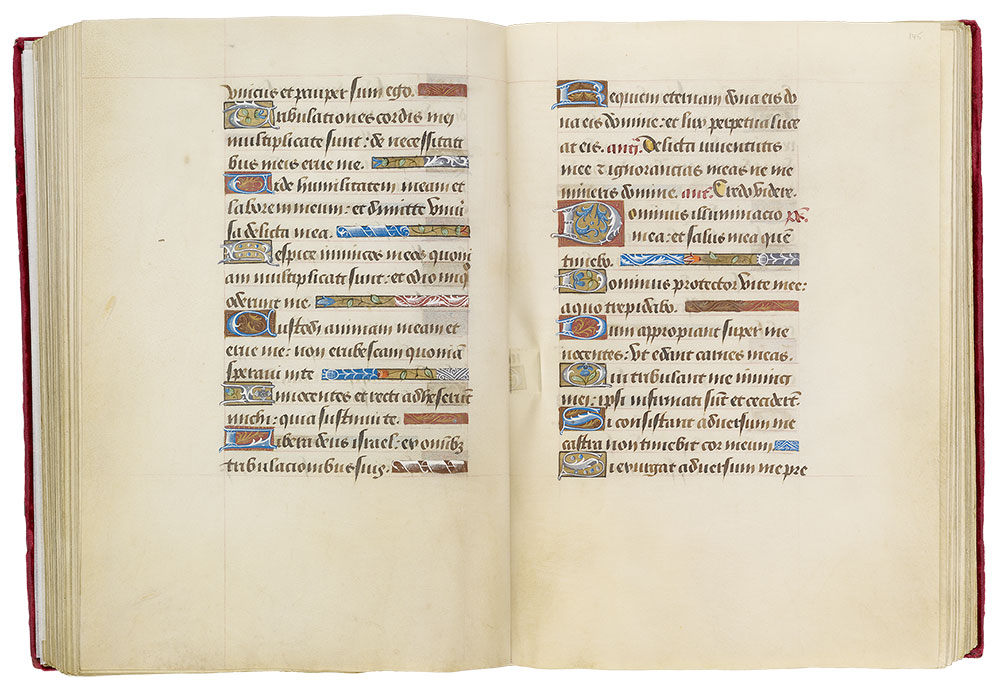
Hours of Henry VIII
Illuminated by Jean Poyer
Gift of the Heineman Foundation, 1977
MS H.8, fols. 145v–146r
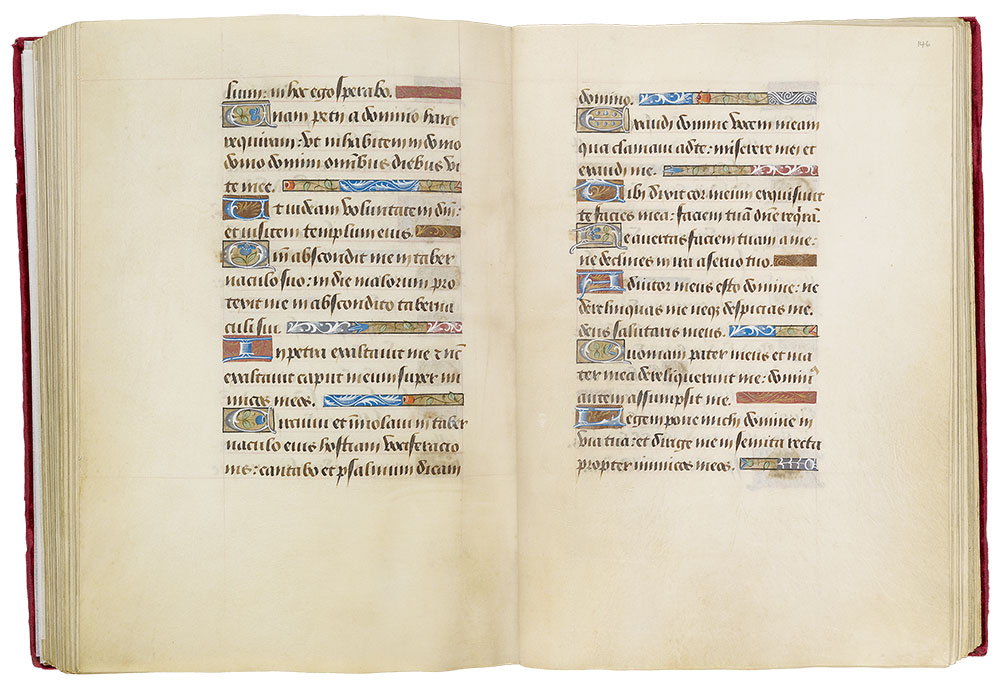
Hours of Henry VIII
Illuminated by Jean Poyer
Gift of the Heineman Foundation, 1977
MS H.8, fols. 146v–147r
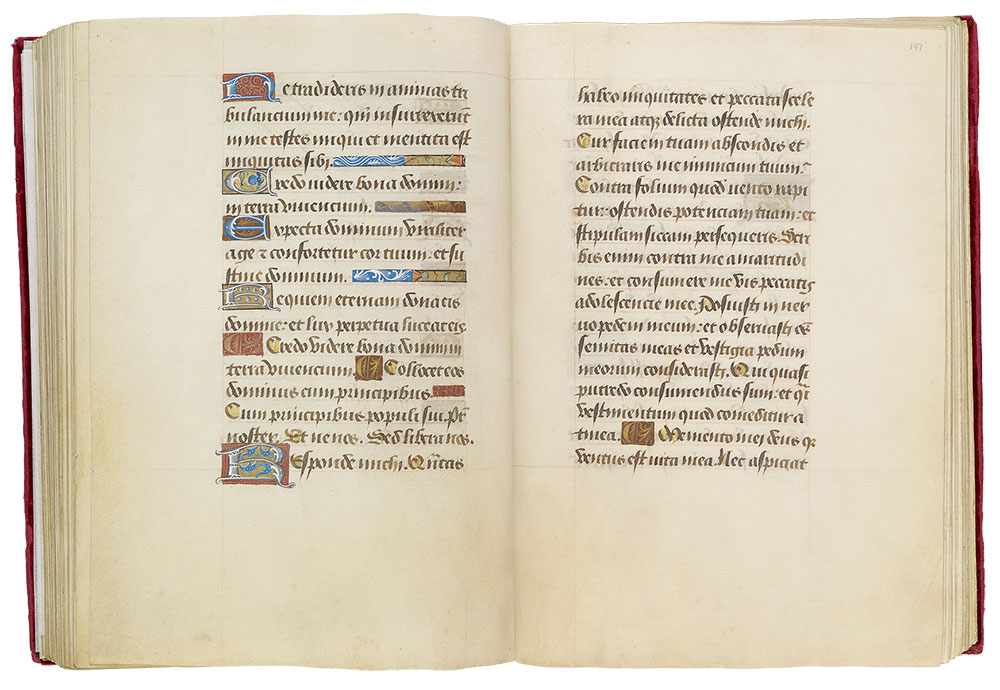
Hours of Henry VIII
Illuminated by Jean Poyer
Gift of the Heineman Foundation, 1977
MS H.8, fols. 147v–148r
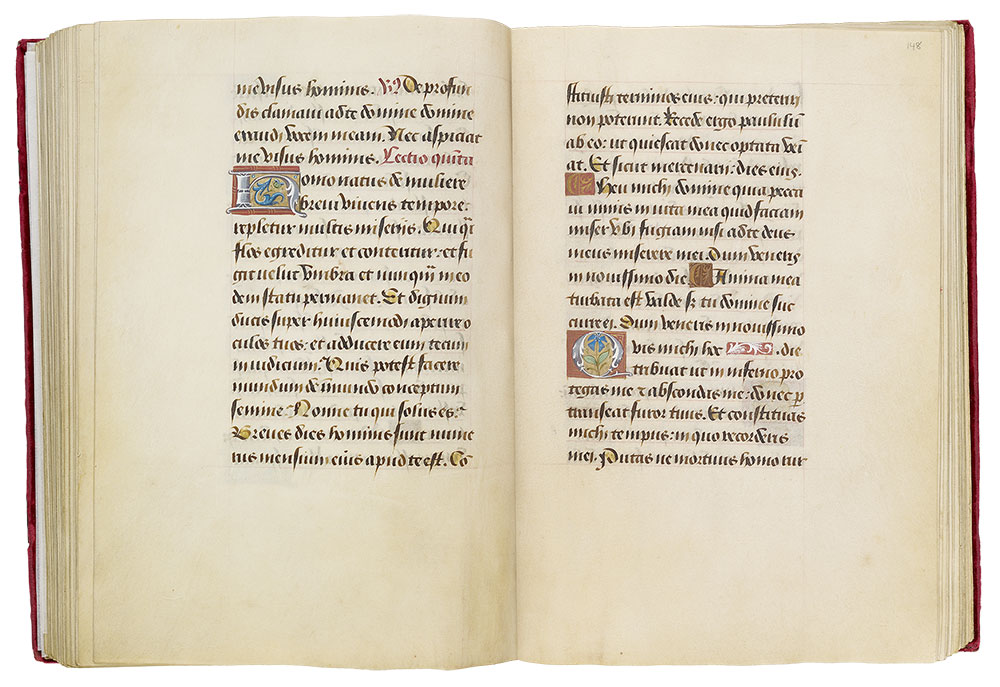
Hours of Henry VIII
Illuminated by Jean Poyer
Gift of the Heineman Foundation, 1977
MS H.8, fols. 148v–149r
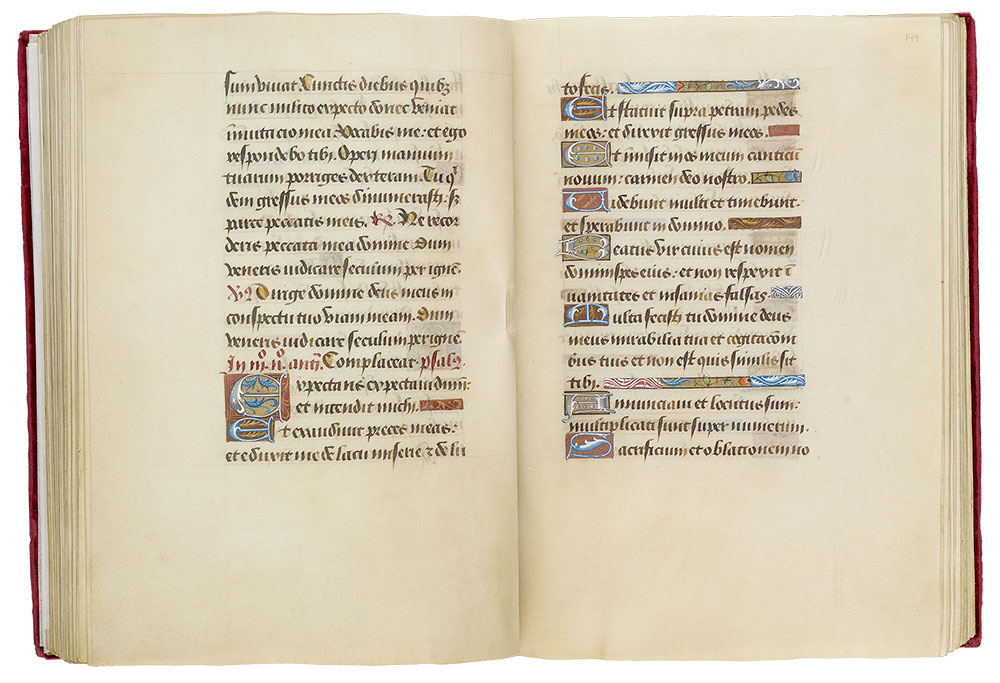
Hours of Henry VIII
Illuminated by Jean Poyer
Gift of the Heineman Foundation, 1977
MS H.8, fols. 149v–150r
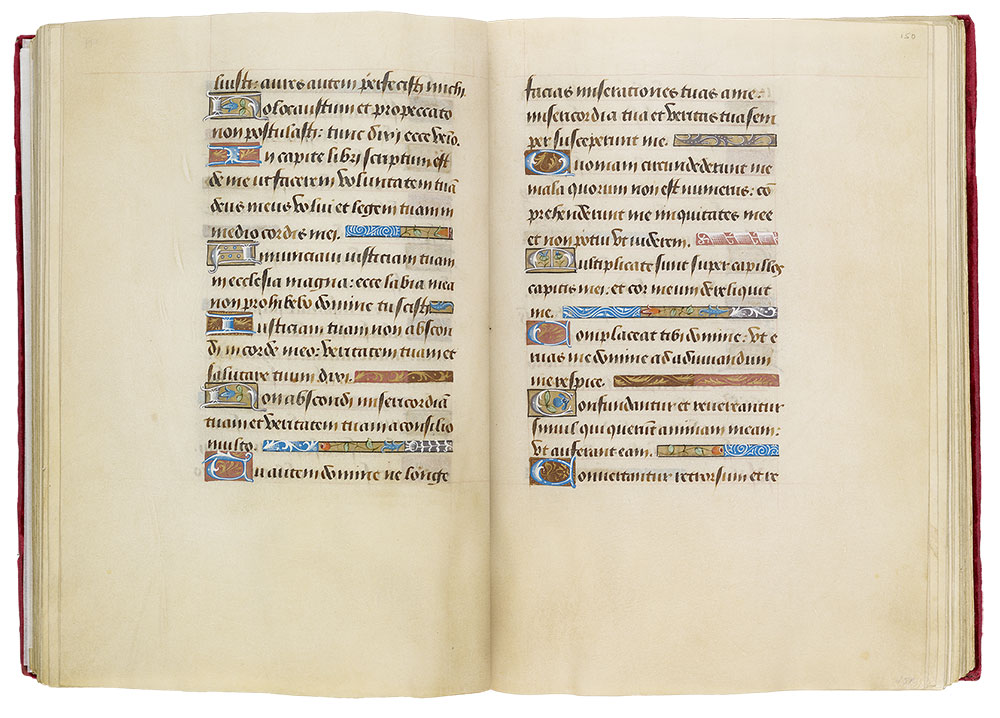
Hours of Henry VIII
Illuminated by Jean Poyer
Gift of the Heineman Foundation, 1977
MS H.8, fols. 150v–151r
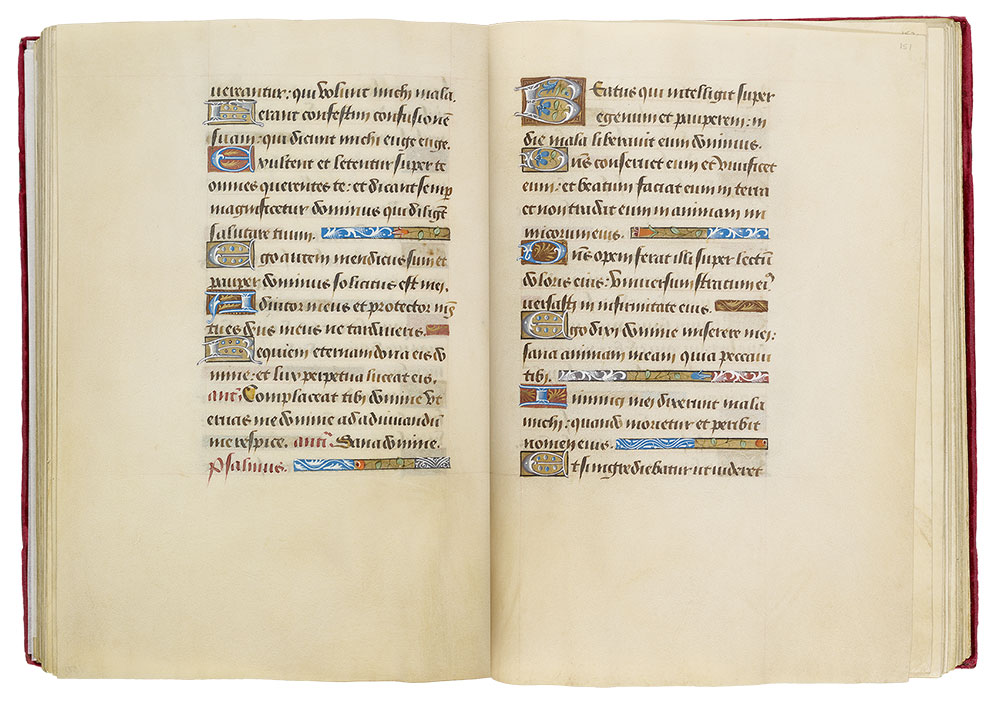
Hours of Henry VIII
Illuminated by Jean Poyer
Gift of the Heineman Foundation, 1977
MS H.8, fols. 151v–152r
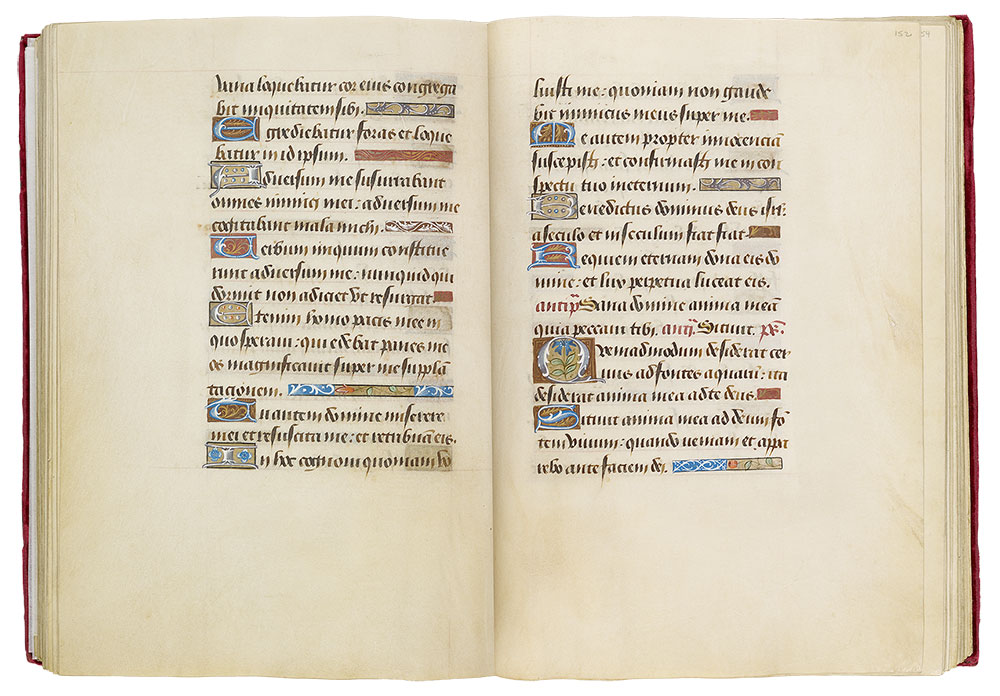
Hours of Henry VIII
Illuminated by Jean Poyer
Gift of the Heineman Foundation, 1977
MS H.8, fols. 152v–153r
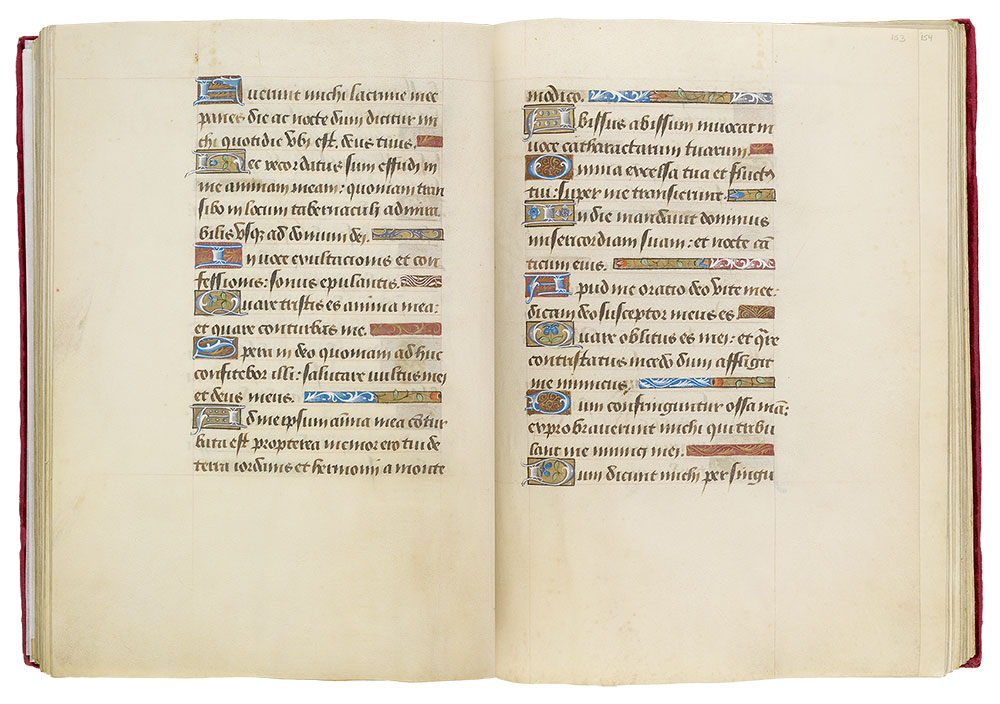
Hours of Henry VIII
Illuminated by Jean Poyer
Gift of the Heineman Foundation, 1977
MS H.8, fols. 153v–154r
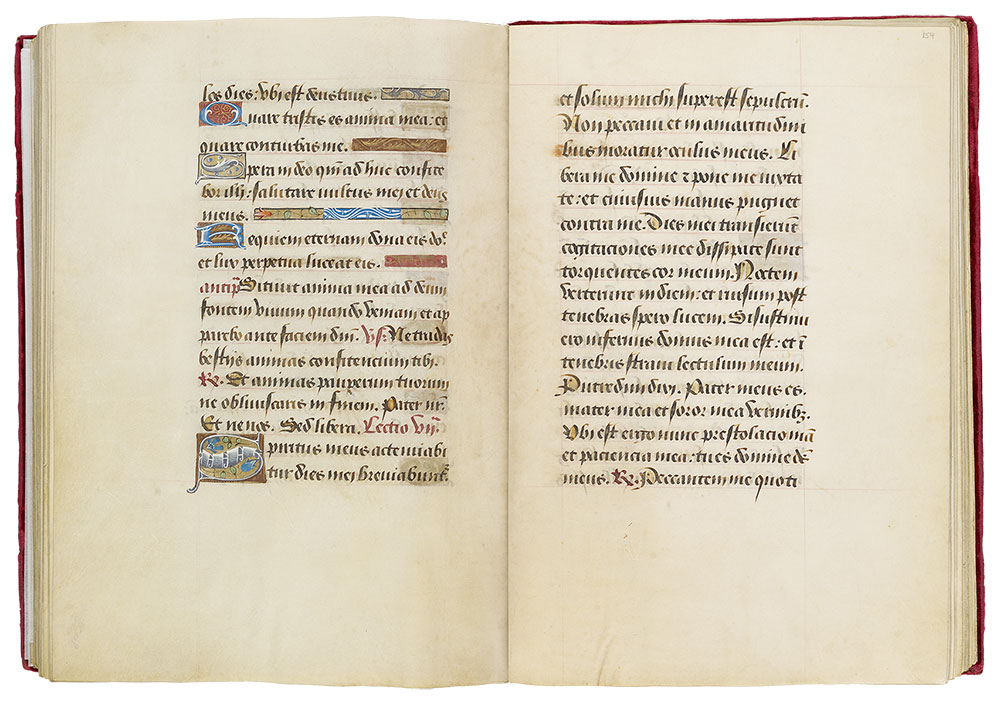
Hours of Henry VIII
Illuminated by Jean Poyer
Gift of the Heineman Foundation, 1977
MS H.8, fols. 154v–155r
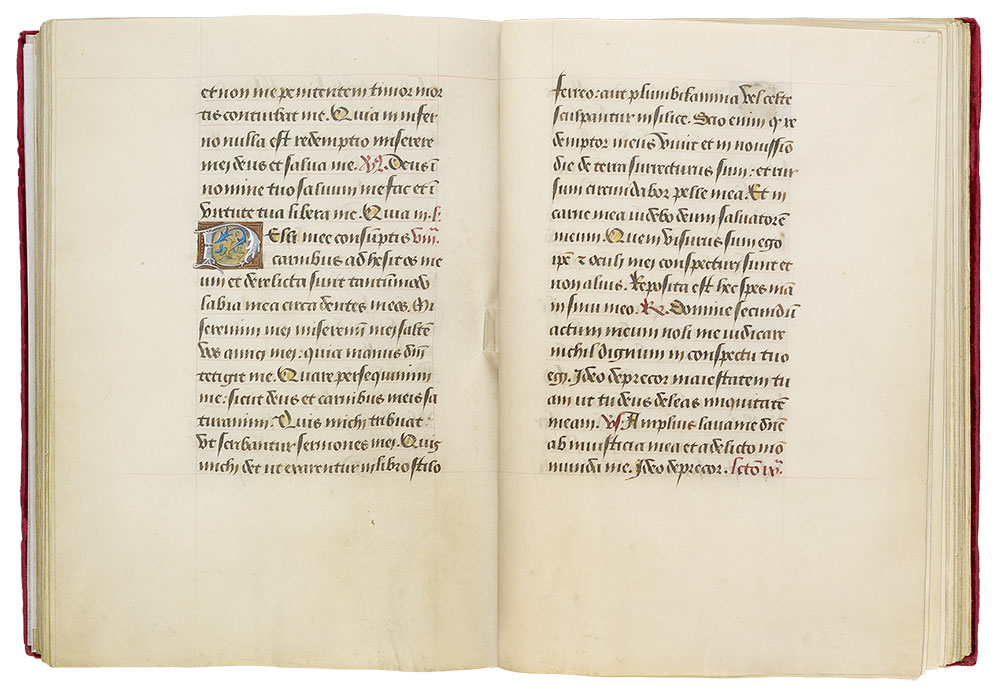
Hours of Henry VIII
Illuminated by Jean Poyer
Gift of the Heineman Foundation, 1977
MS H.8, fols. 155v–156r
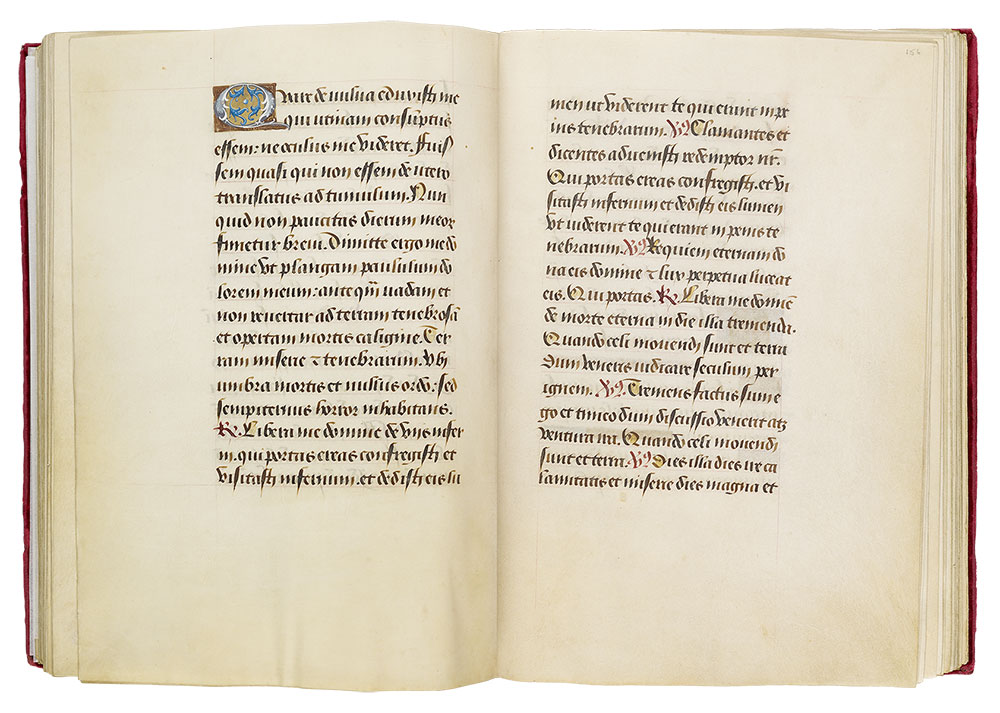
Hours of Henry VIII
Illuminated by Jean Poyer
Gift of the Heineman Foundation, 1977
MS H.8, fols. 156v–157r
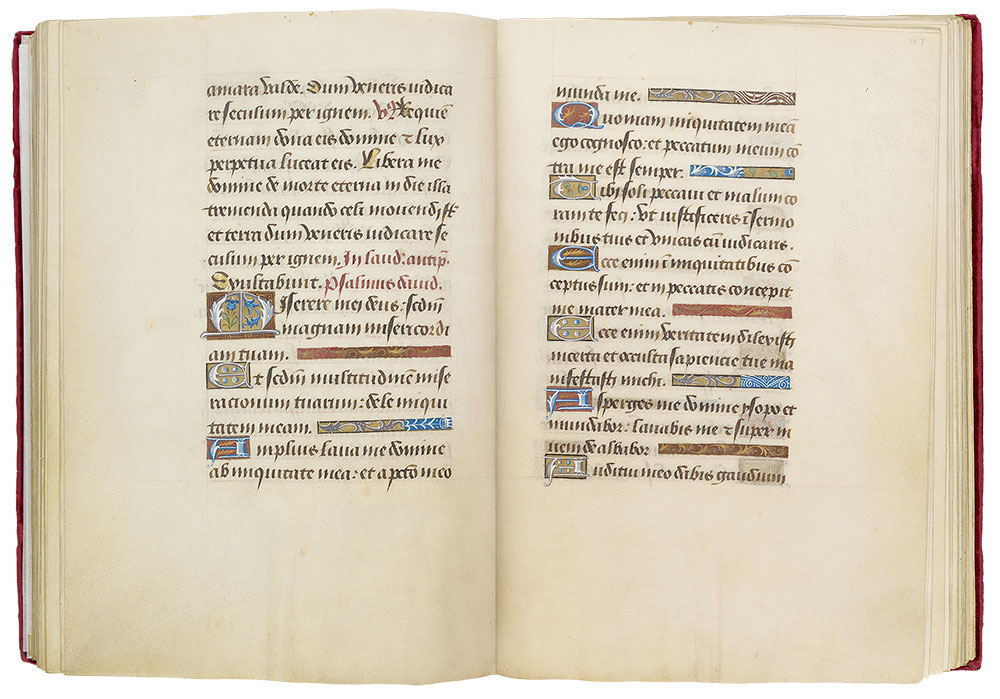
Hours of Henry VIII
Illuminated by Jean Poyer
Gift of the Heineman Foundation, 1977
MS H.8, fols. 157v–158r
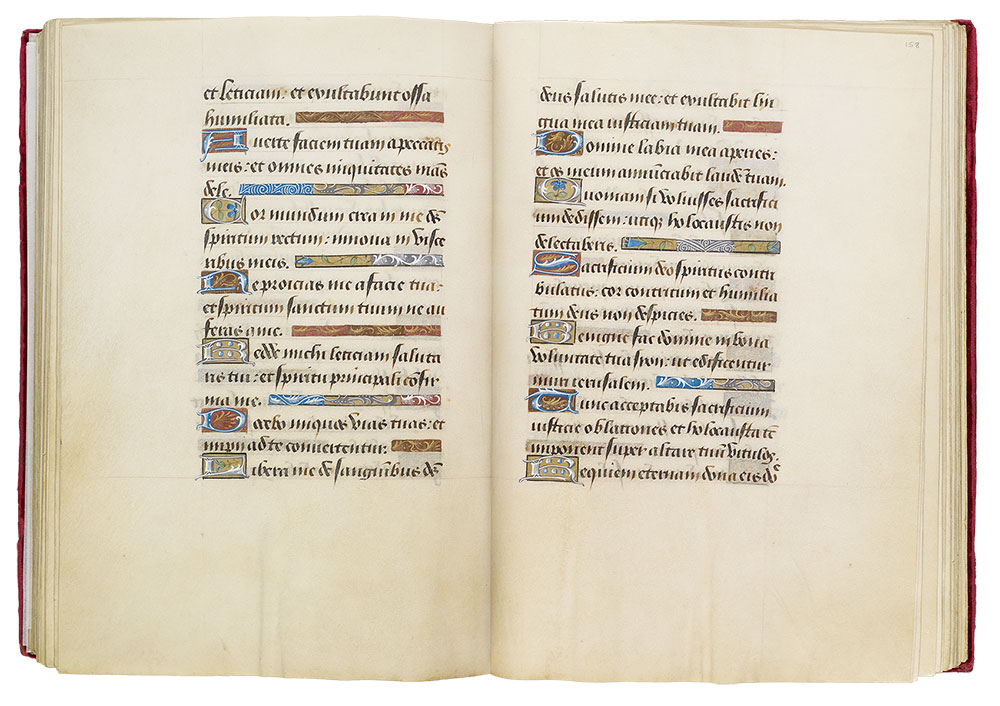
Hours of Henry VIII
Illuminated by Jean Poyer
Gift of the Heineman Foundation, 1977
MS H.8, fols. 158v–159r
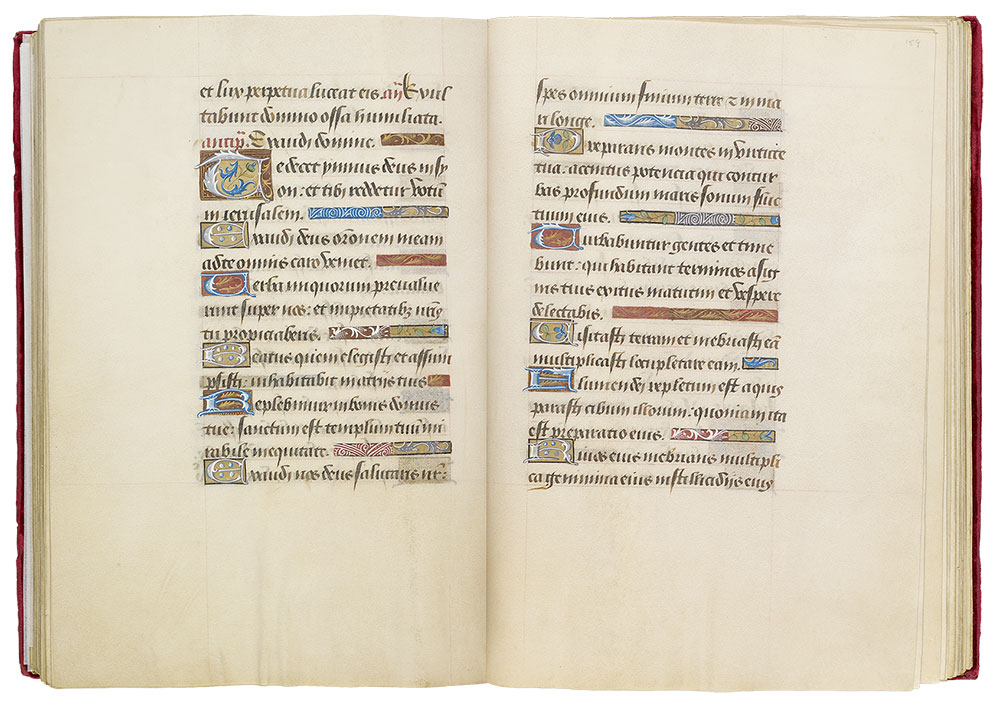
Hours of Henry VIII
Illuminated by Jean Poyer
Gift of the Heineman Foundation, 1977
MS H.8, fols. 159v–160r
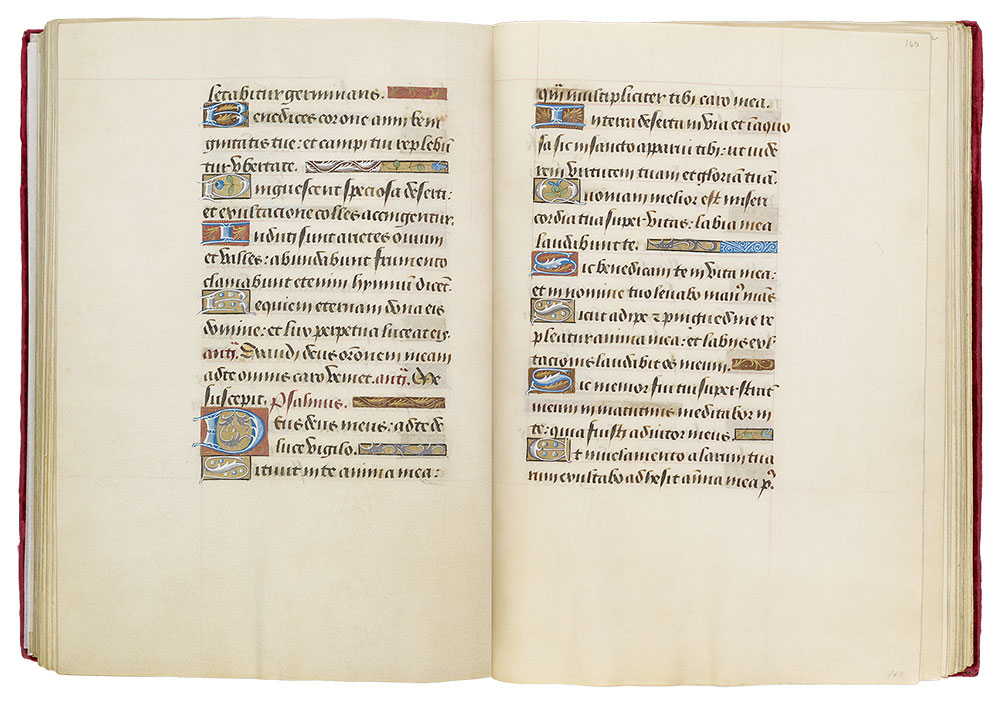
Hours of Henry VIII
Illuminated by Jean Poyer
Gift of the Heineman Foundation, 1977
MS H.8, fols. 160v–161r
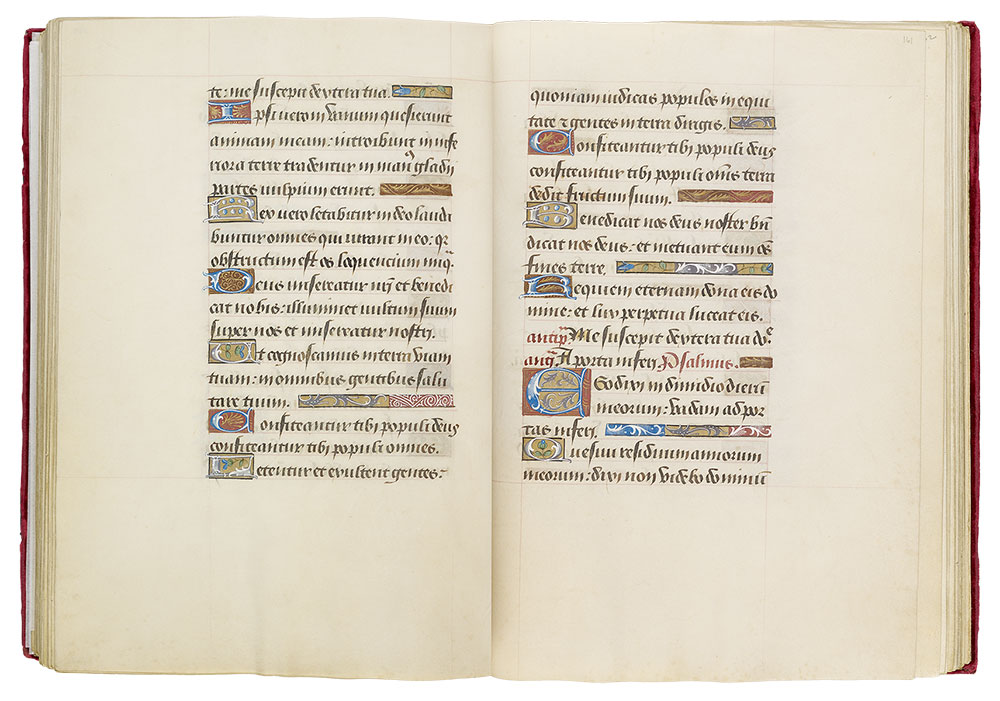
Hours of Henry VIII
Illuminated by Jean Poyer
Gift of the Heineman Foundation, 1977
MS H.8, fols. 161v–162r
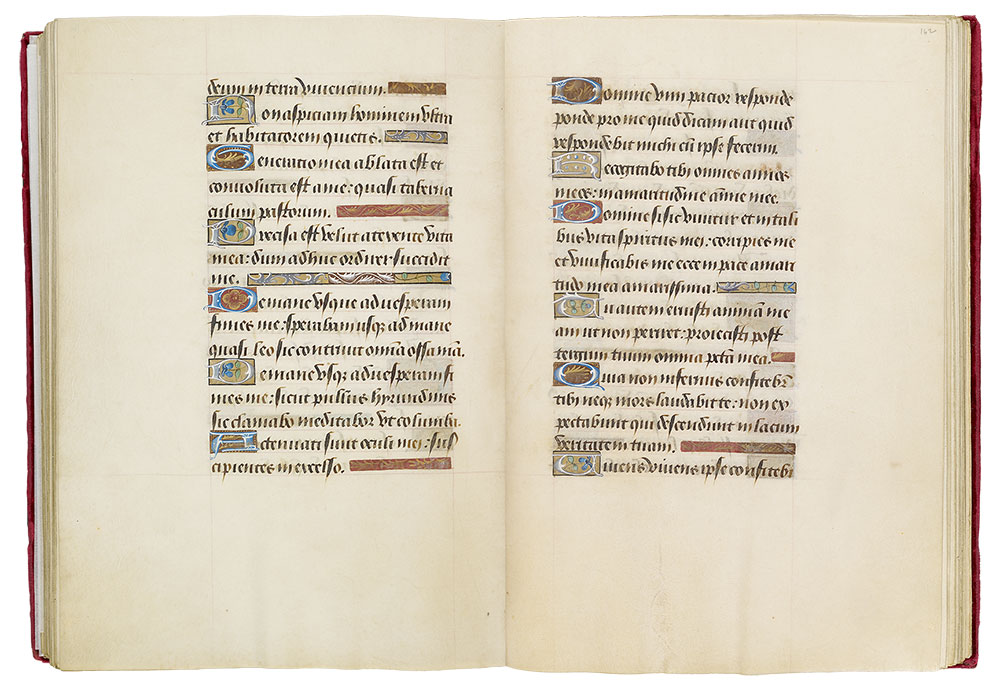
Hours of Henry VIII
Illuminated by Jean Poyer
Gift of the Heineman Foundation, 1977
MS H.8, fols. 162v–163r
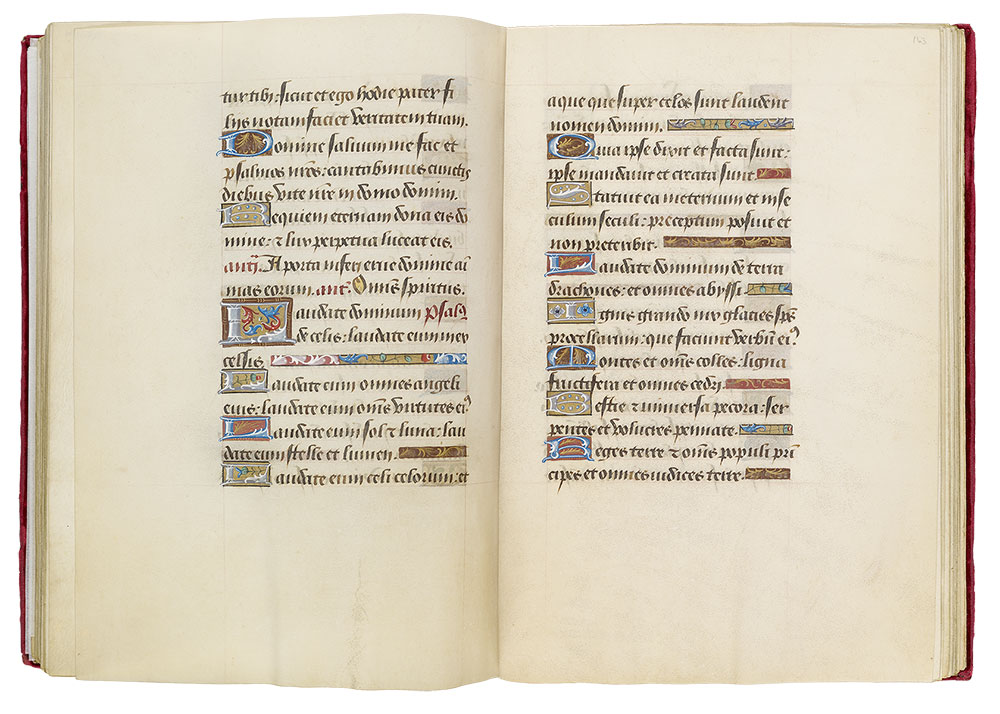
Hours of Henry VIII
Illuminated by Jean Poyer
Gift of the Heineman Foundation, 1977
MS H.8, fols. 163v–164r
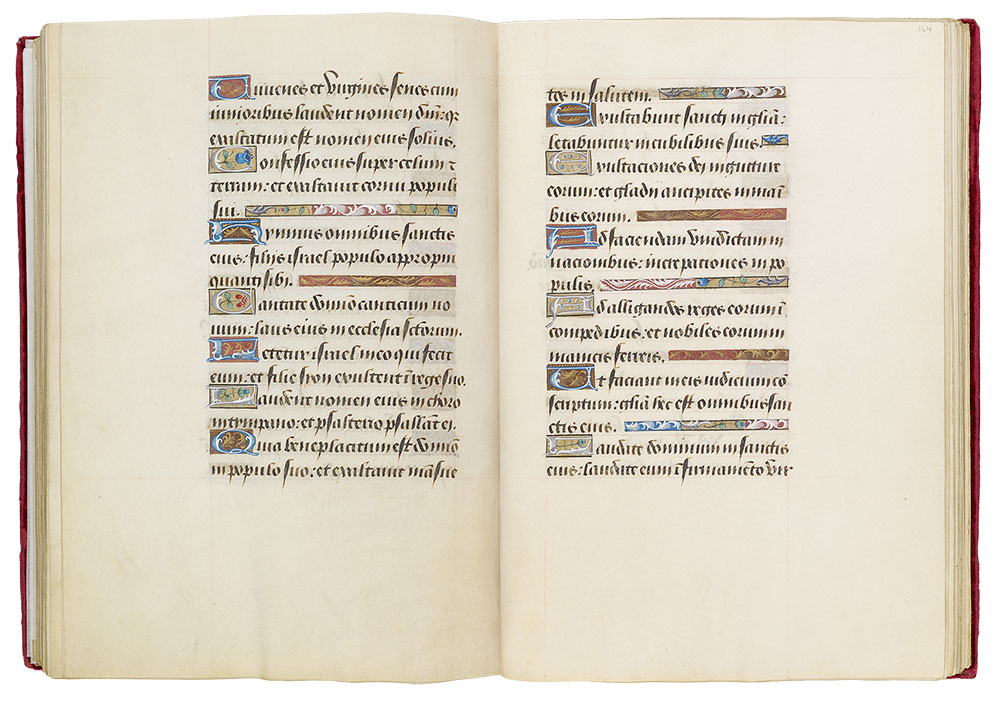
Hours of Henry VIII
Illuminated by Jean Poyer
Gift of the Heineman Foundation, 1977
MS H.8, fols. 164v–165r
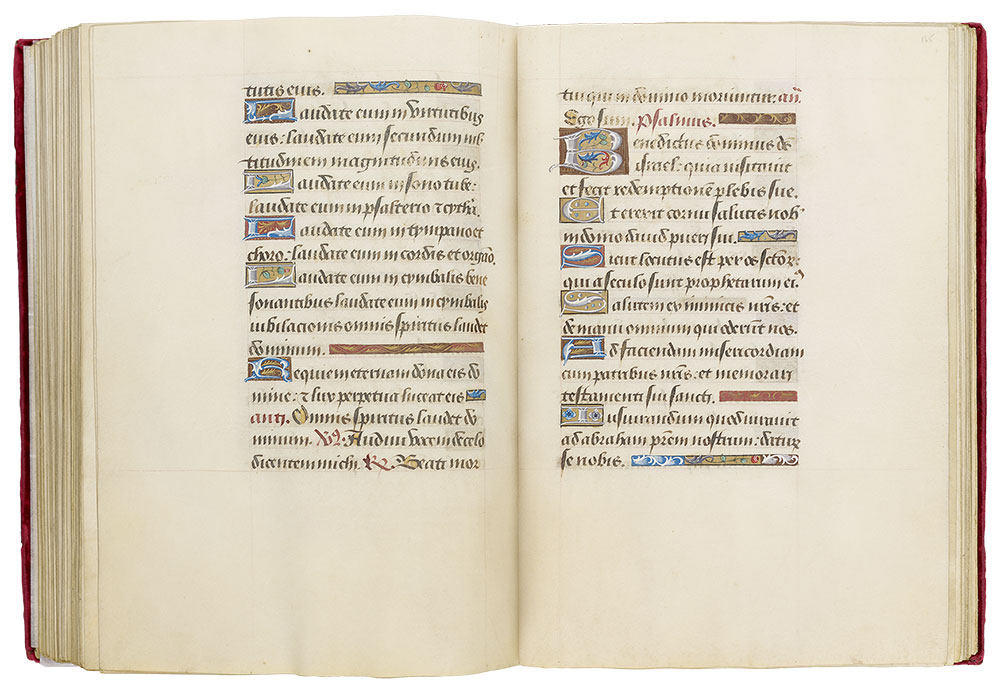
Hours of Henry VIII
Illuminated by Jean Poyer
Gift of the Heineman Foundation, 1977
MS H.8, fols. 165v–166r
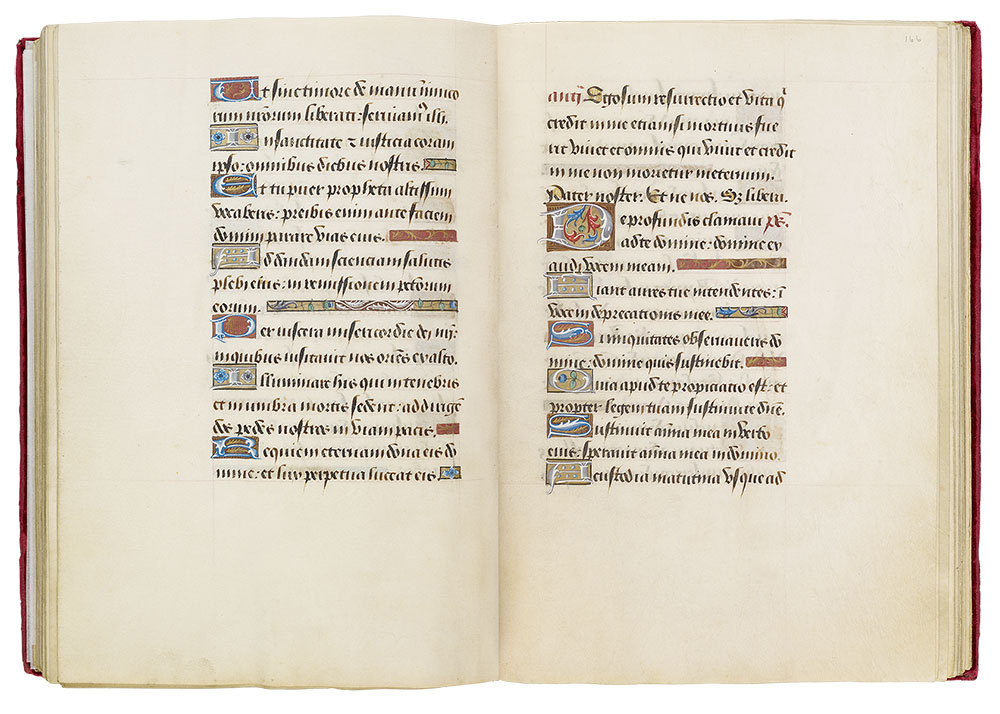
Hours of Henry VIII
Illuminated by Jean Poyer
Gift of the Heineman Foundation, 1977
MS H.8, fols. 166v–167r
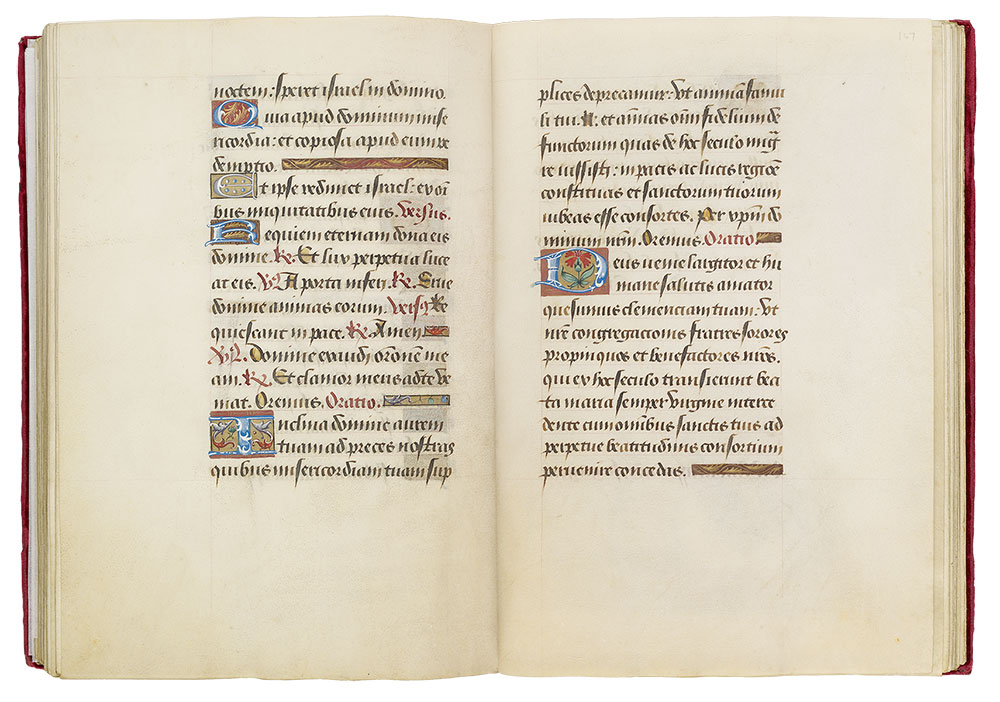
Hours of Henry VIII
Illuminated by Jean Poyer
Gift of the Heineman Foundation, 1977
Seven Prayers of St. Gregory, fol. 168r
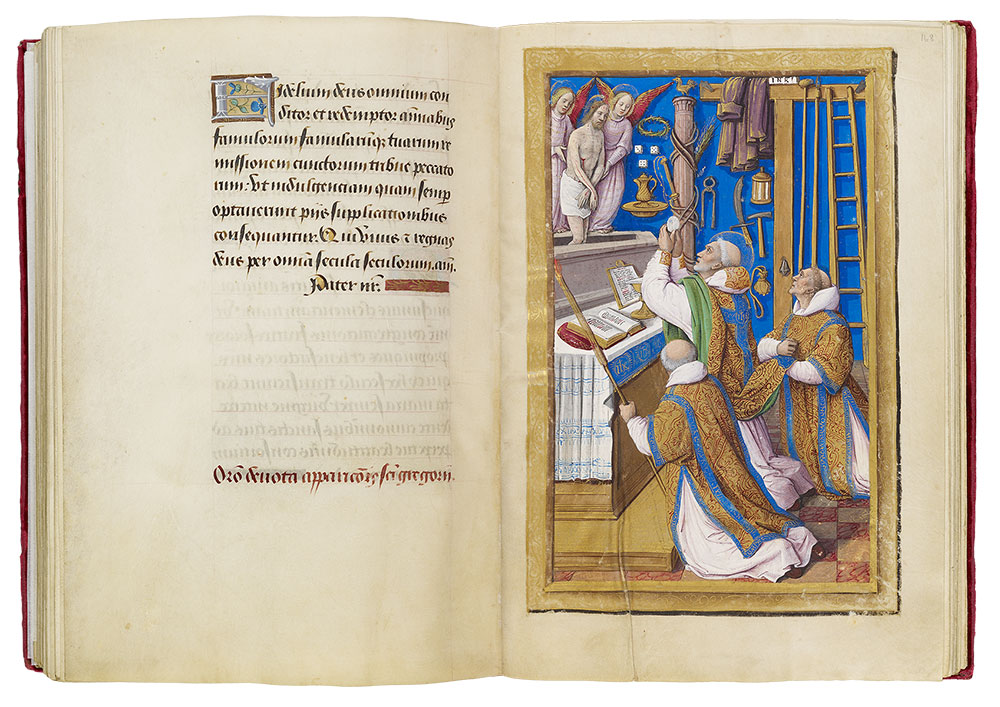
Mass of St. Gregory
Hours of Henry VIII
Illuminated by Jean Poyer
Gift of the Heineman Foundation, 1977
Mass of St. Gregory (fol. 168)
The typical illustration for the Seven Prayers of St. Gregory is the so-called Mass of St. Gregory, an image that apparently was invented in the fifteenth century.
Against the blue background are the arma christi (arms of Christ), which were part of the Man of Sorrows iconography.
A pictographic summary of Christ's Passion makes it possible for the devout to contemplate the enormity of Christ's sufferings; the symbols include the purse (Judas's betrayal for thirty pieces of silver), lantern (Christ was taken at night), sword (with which Peter cut off Malchus's ear), ewer and dish (with which Pilate washed his hands of guilt), cock (crowed when Peter denied he was a disciple of Christ), column with rope and two kinds of scourges (Flagellation), purple garment and Crown of Thorns (Mocking of Christ), Cross (Carrying of Cross), hammer and three nails in Cross with titulus (Crucifixion), three dice (soldiers gambled for Christ's garments), spear with sponge (Christ took vinegar), spear (Christ's side opened, with outpouring of blood and water), and pincers and ladder (for the Deposition).
Gregory, holding the wafer (itself decorated with the Crucifixion) between the first finger and thumb of both hands, recites the words Hoc est enim corpus meum (For this is my Body).
St. Gregory, assisted by a deacon and subdeacon, elevates the consecrated Host during a High Mass. As is liturgically correct, the subdeacon holds a torch, while the deacon lifts the back of Gregory's chasuble, which, like the altar frontal, is embroidered with the monogram of Jesus (IHS).
The live and bleeding Christ miraculously appears on the altar, supported by two angels above his sarcophagus.
Seven Prayers of St. Gregory (fols. 168v–69v)
As discussed above in connection with the accessory Prayers to the Virgin, in addition to the main texts of Books of Hours, a fairly large number of optional texts and prayers could be included, depending on the piety and pocketbook of the patron. Aside from individual prayers, these could include various Hours (of St. Catherine, of St. John the Baptist, and of the days of the week), special Masses (for saints and the days of the week), and a group of devotions organized around the number seven (Seven Joys of the Virgin, Seven Requests to Our Lord, Seven Last Words of Our Lord, Seven Verses of St. Bernard, and the present Seven Prayers of St. Gregory).
According to tradition the Seven Prayers were written by St. Gregory the Great, the fourth Latin Doctor of the Church (as the rubric for the prayers states in a contemporaneous Rouen Horae also in the Morgan Library's Heineman Collection: MS H.1, fol. 114v). The prayers consist of seven short ejaculations addressed to Christ, each followed by an Our Father and Hail Mary. The first begins:
O Domine Ih[es]u Christi adoro te in cruce pendente[m] et coronam spineam
in capite portantem. Deprecor te ut crux tua liberet me ab angelo percutiente.
(O Lord Jesus Christ, I adore you, hanging on the Cross and wearing the Crown of
Thorns on your head. I beseech you so that your Cross might free me from the
persecuting angel.)
The other six prayers (all beginning "O Domine Ihesu Christi adoro te . . . ") relate to the bleeding Christ, the dying Christ, the Entombment, the Descent into Hell, the Resurrection, and Christ as the Good Shepherd. In the present manuscript the text is preceded by a rubric (fol. 167v) identifying it as a devotional prayer of the Vision of St. Gregory ("Or[ati]o devota apparic[i]o[n]is s[an]c[t]i Gregorii").
Mass of St. Gregory
The initial seed for the story of the Mass of St. Gregory, a ninth-century biography of Gregory, was popularized in the Golden Legend. As Gregory was consecrating the Host during Mass, the woman who baked it laughed in disbelief that her kneaded dough would become the Body of Christ. Instead of giving her communion, he placed the wafer on the altar, praying to God for her unbelief. When the woman saw the host change into a piece of flesh in the form of a finger, she immediately rejoined the faithful; thereafter the flesh again became bread and she took communion. About 1400, however, owing to the growing emphasis fostered by Franciscans on Christ's human suffering—especially in the Meditations on the Life of Christ—the story circulated that the Man of Sorrows himself appeared on the altar. Around the same time a variant story developed to explain the thirteenth-century wonder-working mosaic icon of the Imago pietatis in Santa Croce in Gerusalemme in Rome. It was believed to have been commissioned by Gregory himself after, in a Mass, he asked God to change the wine into real blood; in that story Christ appeared on the altar and his blood flowed into the chalice. Indulgences were granted to pilgrims praying before the Santa Croce image, and under Pope Urban VI (r. 137–89), they applied equally to copies of it, which later included prints. Such indulgences were also attached to representations of the Mass of St. Gregory, although none is cited in the present manuscript (a French Horae of about 1485 in Baltimore, Walters Art Gallery, MS W.245, offered, for example, an indulgence of 46,000 years).
MS H.8, fols. 168v–169r
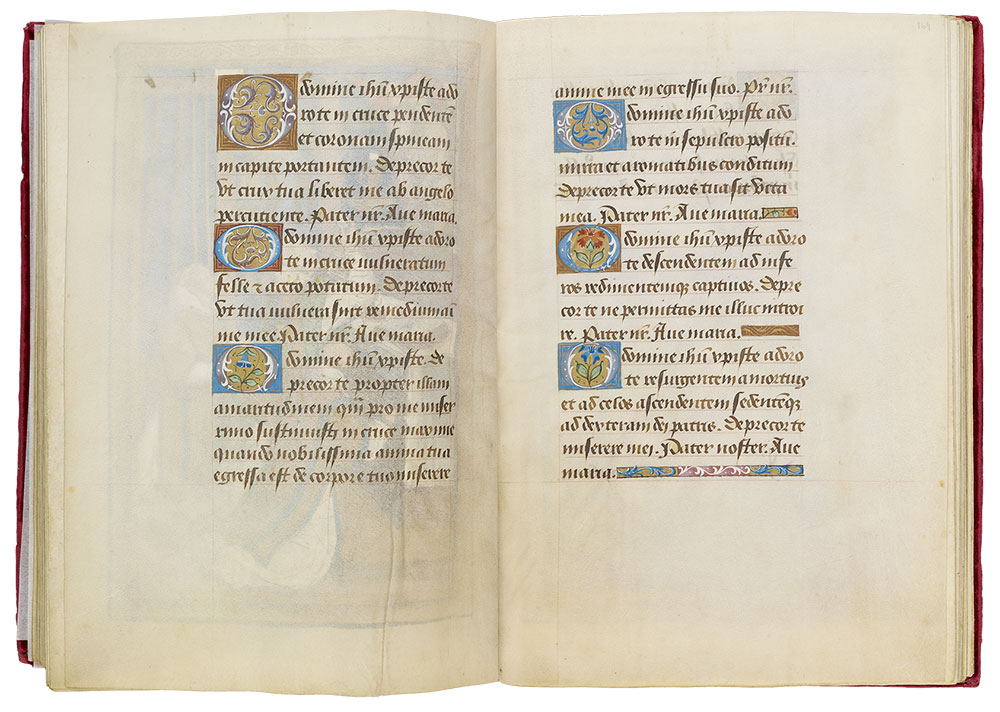
Hours of Henry VIII
Illuminated by Jean Poyer
Gift of the Heineman Foundation, 1977
MS H.8, fols. 169v–170r
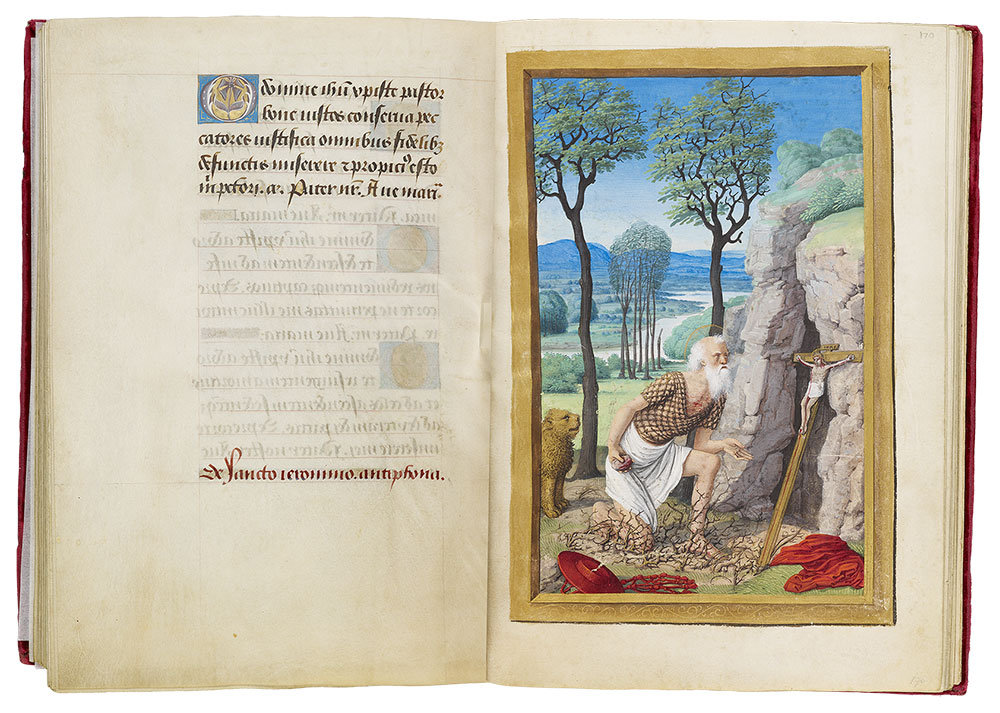
St. Jerome: Jerome in Penance
Hours of Henry VIII
Illuminated by Jean Poyer
Gift of the Heineman Foundation, 1977
St. Jerome: Jerome in Penance (fol. 170)
As is common in Books of Hours, the final component of the Hours of Henry VIII includes a series of prayers, known as Suffrages, seeking favor from various saints. The well-educated St. Jerome, considered the most learned of the Latin Church fathers, was born around 342 in the small town of Stridon in Dalmatia.
In Antioch St. Jerome decided to retire as a hermit in the Syrian Desert, where he suffered temptations of the flesh. In a letter to his friend Eustachium, he recounted how in the heat of the sun, with no other companions besides scorpions and wild beasts, he imagined Roman maidens dancing before him.
To avoid the temptations of his lascivious imagination, St. Jerome threw himself amid thorn bushes before a crucifix, beat his breast (the rock was a later medieval invention), and fled into the wilderness for four years.
One evening, according to a legend, as Jerome sat within the gates of his monastery, a lion entered, limping in pain. The saint removed a thorn from its paw, tending the lion's wound until it healed. The beast became one of the saint's attributes.
St. Jerome
St. Jerome was sent to Rome as a youth to study the Greek and Latin classics with the pagan grammarian Donatus. Baptized and later ordained as a priest, Jerome made a pilgrimage to the Holy Land. In 382 he returned to Rome, where he produced the standard text of the Latin Bible (the Vulgate) before moving to Bethlehem, founding a monastic settlement of contemplative hermits with St. Paula (the Hieronymite Order). Although Jerome was never a cardinal (the office did not yet exist), he is depicted as one. Here the cardinal's cloak and hat lie on the ground so we can see his hair shirt. Images of the penitent Jerome in the wilderness originated in Pisa during the late thirteenth/early fourteenth centuries.
St. Jerome Beating His Breast
The motif of the saint beating his breast with a stone—which first occurs in a fourteenth-century panel in Pisa (Galleria San Matteo)—was adopted in the north at the end of the fifteenth century. Scenes of Jerome in the wilderness also afforded the artist an opportunity to explore nature, landscape, and wildlife—features exploited by Poyer. (Feast day: September 30)
Suffrages (fols. 170v–93)
Suffrages, prayers to saints seeking favor or support (also called Memorials), are frequently the last component in a Book of Hours. Petitionary or intercessory in nature, they normally consist of four elements: the first three, an antiphon, versicle, and response, make up a string of praises; the fourth part is a longer prayer (oratio) specifically dealing with some aspect of the saint, along with a request for God's aid through the saint's intercession. Many of these elements are quotations or extractions drawn from the Church's official liturgical texts found in the Breviary, which contained the rounds of offices recited by the clergy during the year, or in the Missal, which contained the Masses. The collect from the Mass and Office (Lauds) of St. Nicholas (6 December), for example, served as the Oratio for his Suffrage (fol. 182v); a translation of the entire suffrage follows.
Antiphon. Nicholas, friend of God, when invested with the episcopal insignia,
showed himself a friend to all.
Versicle. Pray for us, blessed Nicholas.
Response. That we may be made worthy of the promises of Christ.
Oratio. O God, you adorned the pious blessed Bishop Nicholas with countless
miracles; grant, we beseech you, that through his merits and prayers, we
may be delivered from the flames of hell. Through Jesus Christ our Lord.
The justification and efficacy of such petitions to the saints had already been established by the fourth century and were unequivocally reaffirmed in the thirteenth century by Thomas Aquinas in his Summa theologica. In raising the question if one should pray to God alone, he referred to Job (5:l), where Eliphaz exhorted him to call upon some of the saints; to show that the saints in heaven could indeed pray for us Aquinas also quoted Jerome: "If the apostles and martyrs while yet in body can pray for others, how much more now that they have the crown of victory and triumph." In asking if prayer to greater saints was more acceptable to God than to lesser saints, Aquinas said it was sometimes more profitable to pray to a lesser saint, since some saints were granted special patronage in certain areas, such as St. Anthony against the fires of hell. Moreover, he added, the effect of prayer depended on one's devotion, and that could be greater for a lesser saint. Aquinas also alluded to another common custom of the Church to support his conclusions, the recitation of the Litany of saints (a practice dating back to the fourth century). It is the celestial hierarchy of saints in the Litany, moreover, that provides the basic ordering of the Suffrages in Books of Hours. Indeed, in the present manuscript, all of the Suffrages are illustrated, forming a kind of pictorial Litany (albeit a very selective one). After the Three Persons of the Trinity comes the Archangel Michael, followed by John the Baptist (our future intercessor at the Last Judgment). Next are the Apostles, male martyrs, confessors (male nonmartyr saints), female martyrs, and widows. The series concludes with All Saints. (It may be of interest to observe that the first five female saints precisely follow the order in which they appear in the manuscript's Litany.) The idea of placing large miniatures of the saints above the Suffrages, with other scenes from the life of the saint in different colored grisailles in the lower borders, brings full circle the page layout of the Calendar and Gospel Lessons at the beginning of the manuscript. The number of Suffrages in Books of Hours can vary greatly, and each is not always illustrated; the series of twenty-four in the present manuscript is particularly rich and bespeaks of a fairly wealthy patron. The placement of Jerome at the beginning of the Suffrages is highly unusual. His position here may have been intended to link Jerome with Pope Gregory, the Church Father who was believed to have written the previous text (Seven Prayers of St. Gregory). In addition, Jerome's Suffrage, as is clear from the translation below, emphasizes his role as a teacher rather than as a penitent.
Antiphon. I shall liken him to a wise man who built his house on rock.
Versicle. The Lord led the just man in right paths.
Response. And showed him the kingdom of God.
Oratio. O God, who didst vouchsafe to provide for thy Church blessed Jerome,
thy confessor, a great doctor for the expounding of the Sacred Scriptures, grant,
we beseech thee, that through his merits we may be enabled, by thine assistance,
to practice what by word and deed he hath taught us. Through Our Lord Jesus
Christ thy Son, who liveth and reigneth, God, with thee, in the unity of the Holy
Spirit, world without end. Amen.
Since the accompanying picture of Jerome in Penance is, like the Mass of Gregory, a full-page miniature (all of the other Suffrages are half-page miniatures with historiated borders), it could be seen as a kind of frontispiece for the Suffrage section. In any case, Jerome and Gregory were both Latin Doctors of the Church, and both miniatures focus on the crucified body of Christ. Codicological evidence and the rubric for the Suffrage (De sancto Ieronimo) would indicate that the present placement was intended, suggesting that Jerome had some special significance for the patron. Pictures of Jerome in Penance became increasingly popular at this time: a similar image by the Master of Claude de France, for example, was inserted in the 1510s to Poyer's Hours of Mary of England, probably by King Louis XII when he had the book remodeled for his last wife.
Suffrages, fol. 170v
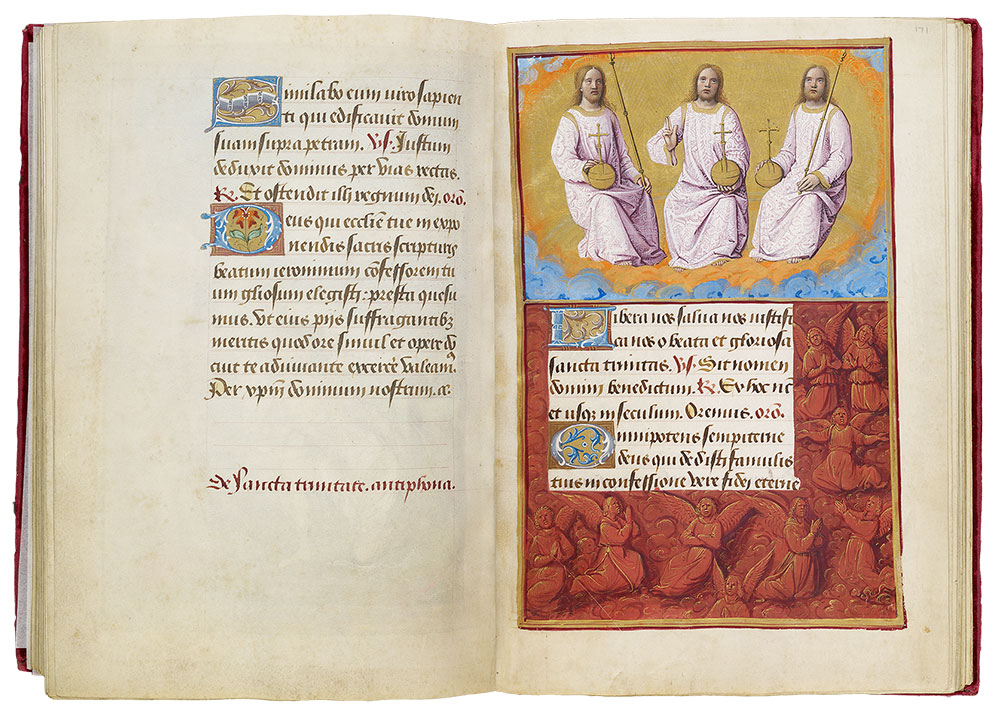
Trinity: Trinity
Hours of Henry VIII
Illuminated by Jean Poyer
Gift of the Heineman Foundation, 1977
Trinity: Trinity
Border: Angels (fol. 171)
The Christian conception of a triune God, each part equal and indistinguishable, is the subject of this miniature. (The same corruption can be seen in Poyer's Prayer Book of Anne de Bretagne, M.50, fol. 1.)
The Three Persons of God, seated on a golden rainbow within an aureole surrounded by clouds, are physically and hierarchically identical: they each appear as a young Christ holding an orb. It is tempting to identify the central blessing figure as God the Father, flanked by Christ at his right hand (as in the Apostles' and Nicene Creeds) and the Holy Spirit at his left.
Three Persons of God
The Athanasian Creed (sometimes called the "Quicunque vult" from its opening words in Latin), which specifically emphasizes the equality of the Three Persons of the Trinity, is included as the last text in the Hours of Henry VIII (fols. 196–99v).
Trinity Sunday, the feast day dedicated to the Trinity, was not originally celebrated in the early Christian Church. Although it was observed regionally in the tenth century, it was not universally accepted until 1334, when Pope John XXII (r. 1316–34) ordered it to be generally observed. (Feast day: the first Sunday after Pentecost, or the eighth Sunday after Easter)
Nine Orders of Angels
The nine celestial angels kneeling in adoration and prayer below may recall nine orders of angels, a hierarchy codified in the fifth century.
The ranks of the nine orders of angels were codified in the fifth century in De Hierarchia Celesti, a work that was attributed to Kionysius the Areopagite, the convert St. Paul. The choirs were grouped hierarchically:
- Seraphim, Cherubim, Theones
- Dominations, Virtues, Powers
- Princedoms, Archangels, Angels
The first group perpetually adored God, while the second group made the stars and elements. The princedoms protected earthly kingdoms, and the last two were messengers.
MS H.8, fols. 171v–172r
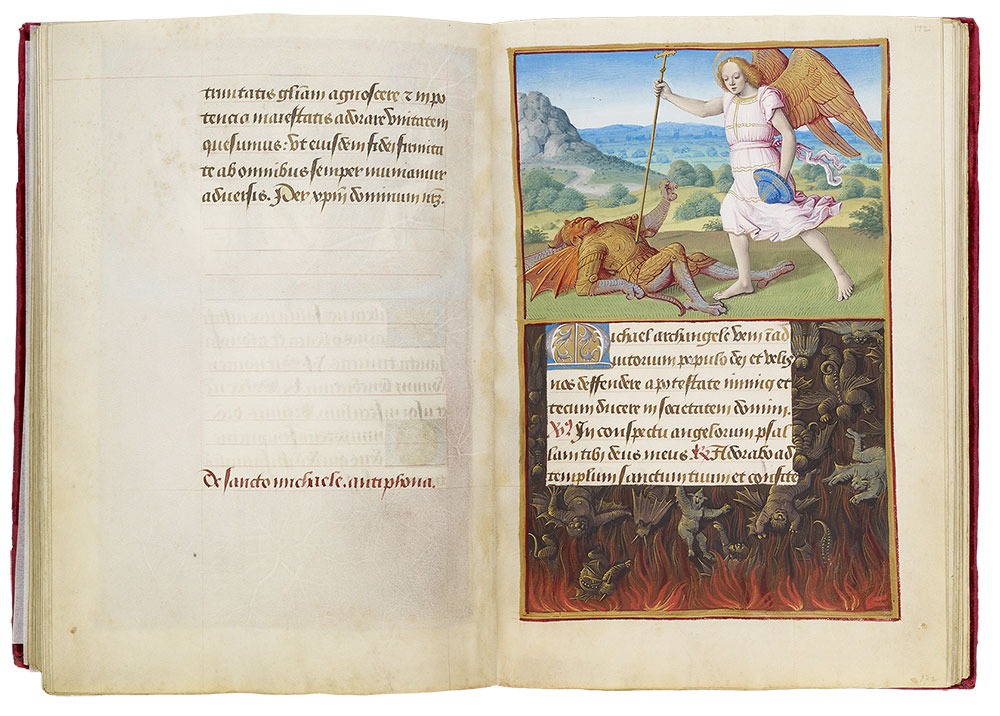
St. Michael the Archangel: Michael Battling a Devil
Hours of Henry VIII
Illuminated by Jean Poyer
Gift of the Heineman Foundation, 1977
St. Michael the Archangel: Michael Battling a Devil
Border: Fall of the Rebel Angels (fol. 172)
Throughout the Middle Ages, St. Michael's iconography varied. We know him best in armor or at least minimally carrying a shield (as here) while slaying the Devil in the form of a dragon or demon.
With a cross-surmounted spear Michael stabs the defeated Satan, who is garbed in antique- style armor (a convention Poyer acquired while visiting Italy).
Michael is sometimes confused with St. George, who also slew a dragon, but there is an easy way to distinguish the two. George, a canonized human, is never depicted with wings, while Michael, an archangel, always has them. (Feast day: September 29, Michaelmas)
In the margin, Satan's corps of rebellious angels, changed into demons, fall into the flames of hell.
St. Michael the Archangel
St. Michael the Archangel is God's commander in chief in the war against the Devil. In his dramatic confrontation with Satan at the beginning of time, Michael defeated his army and hurled the fallen angel and his minions into hell. At the end of the world it is said that Michael will return to earth for his final battle with the Antichrist. The archangel's second duty will be to weigh the souls of the departed and determine if they can enter heaven.
Michael's cult began in the East, where he was invoked for care of the sick (Constantine built a church near Constantinople for this purpose). A fifth-century apparition on Monte Gargano (in southeast Italy) was important in spreading the cult to the West. In the later Middle Ages, the Valois dynasty of French kings adopted him as their patron saint.
MS H.8, fols. 172v–173r
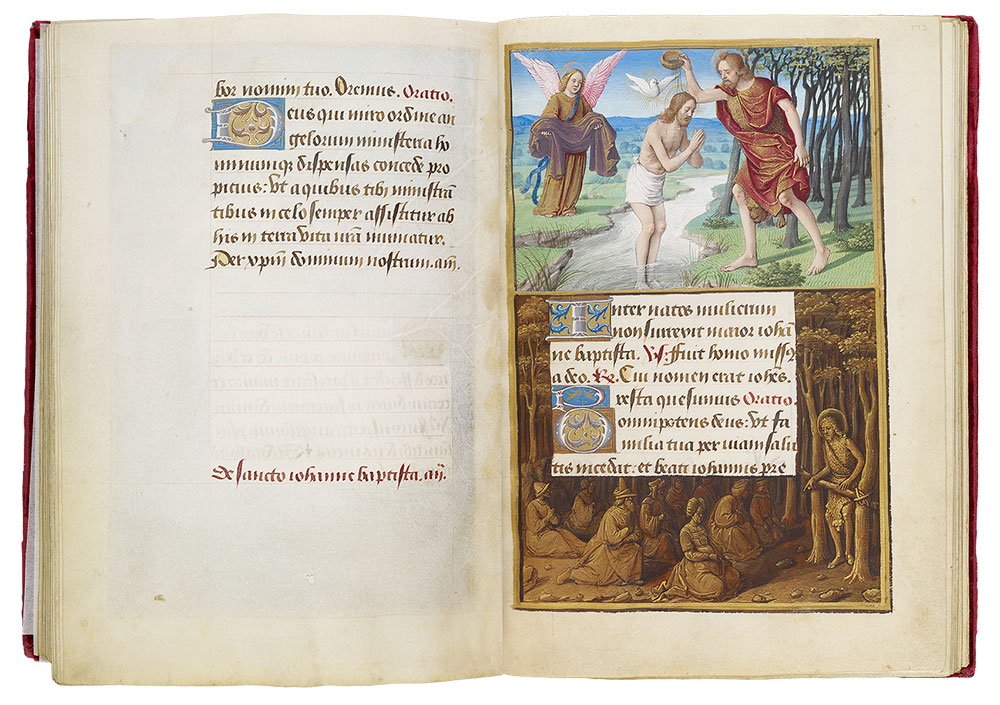
St. John the Baptist: Baptism of Christ
Hours of Henry VIII
Illuminated by Jean Poyer
Gift of the Heineman Foundation, 1977
St. John the Baptist: Baptism of Christ
Border: John the Baptist Preaching (fol. 173)
Around A.D. 27, St. John the Baptist moved to the desert of Judea near the river Jordan, where he preached penance, the coming kingdom of God, and baptism for the remission of sins; he lived on locusts and wild honey and wore a camel's hair garment.
While St. John is normally depicted wearing a leather girdle and a garment made from camel's hair, Poyer clothed him in a camel skin instead, with the camel's head and even a paw bumping about the saint's knees. John's long hair and scruffy beard identify him as a hermit.
St. John baptized Jesus in the river, recognizing him as the Redeemer when the Holy Spirit descended above him in the form of a dove. In the miniature, an angel waits on the opposite bank with Christ's robe.
In the margin, John preaches to the multitude in a forest, his pulpit formed by a branch hori- zontally attached to two tree trunks. (Feast day: June 24)
St. John the Baptist
The Archangel Gabriel told John's elderly parents, Zacharias, a Jewish priest, and Elizabeth, the Virgin Mary's cousin, that they would have a son named John. After Gabriel informed Mary that she, too, would have a son, the two women visited each other (the Visitation); on that occasion John leaped in his mother's womb at the presence of the yet unborn Jesus. Although the Golden Legend says they were childhood playmates, John and Jesus did not meet again until manhood.
St. John's outspoken preaching led to his martyrdom. He publicly censured Governor Herod Antipas for his incestuous marriage with his brother's wife and was subsequently imprisoned in the fortress of Machaerus. The dancer Salome, who had attracted Herod's notice through her dancing at his birthday feast, demanded and received the Baptist's head on a platter.
MS H.8, fols. 173v–174r
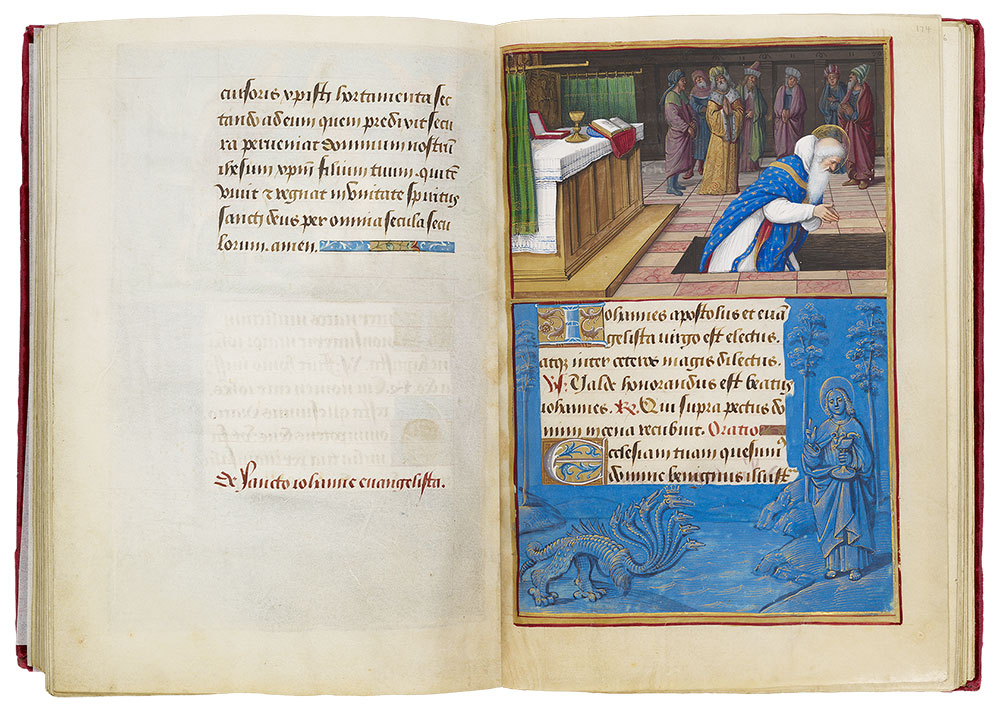
St. John the Evangelist: John the Evangelist Descending into His Grave
Hours of Henry VIII
Illuminated by Jean Poyer
Gift of the Heineman Foundation, 1977
St. John the Evangelist: John the Evangelist Descending into His Grave
Border: John and the Beast of the Apocalypse (fol. 174)
St. John was a prominent figure in the early Church. He preached in Samaria and Jerusalem with St. Peter and traveled on to Rome, from where he was presumably exiled to Patmos under the persecution of Emperor Domitian. Tradition (but not modern scholarship) says that on this island he wrote the Apocalypse, or Book of Revelation, based on visions he experienced there.
The youngest of the Apostles, the Evangelist survived all of the Apostles and lived to the ripe old age of about 101. As his end neared, according to the Golden Legend,Jesus appeared and called him. John had a grave dug near the altar of his church and then, as in the miniature, walked into it. He said a prayer, a bright light surrounded him, and the saint vanished, leaving the grave filled with manna.
In the lower margin of fol. 174, John blesses the poisoned cup, from which serpents slither. Across a narrow body of water is the seven-headed beast of the Apocalypse. (Feast day: December 27)
After Domitian's death (A.D. 96), John went to Ephesus. There Aristodemus, high priest of Diana, challenged him to drink a cup of poisoned wine as a test of his God's strength. John blessed the cup, and the poison departed in the form of a serpent.
John the Evangelist
In the first year of his teaching, Christ called John the Evangelist (son of Zebedee) and his younger brother, St. James the Elder, while they were mending their fishing nets on the Sea of Galilee. Originally disciples of John the Baptist, they became followers of Jesus. John witnessed the Transfiguration and the Agony in the Garden with Peter and James, and was the "beloved disciple" who fell asleep on the bosom of Christ at the Last Supper. The only disciple not to forsake the Savior during the Passion, he was made the guardian of Jesus' mother, Mary, and was thought to have cared for her until her death.
MS H.8, fols. 174v–175r
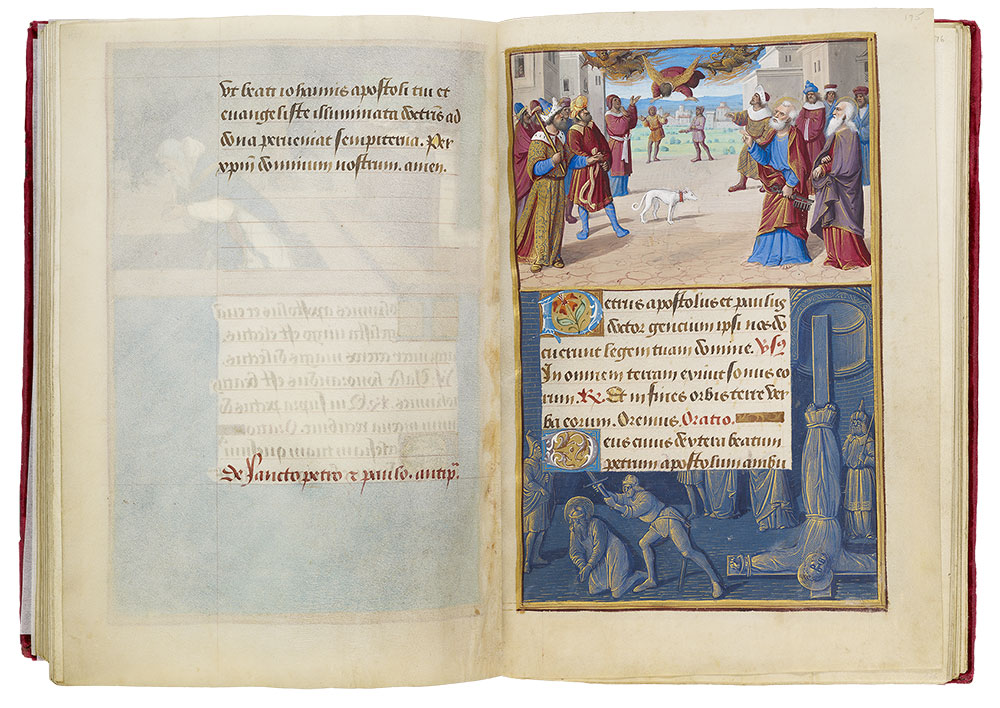
Sts. Peter and Paul: Fall of Simon Magus
Hours of Henry VIII
Illuminated by Jean Poyer
Gift of the Heineman Foundation, 1977
Sts. Peter and Paul: Fall of Simon Magus
Border: Decapitation of Paul and Crucifixion of Peter (fol. 175)
According to the Apocryphal Acts of Peter, there was a sorcerer in Jerusalem named Simon Magus who proclaimed himself the source of truth and promised immortality to his believers. He confronted Peter to prove that he was God, but the Apostle refuted and exposed him. So the sorcerer went to Rome and gained Nero's support. Simon called the people together and declared that he was offended by the presence of Peter and Paul in the city; he threatened to abandon Rome and ascend into heaven.
Even without attributes, it is possible to distinguish between Peter and Paul by their appearance. Peter traditionally has a square, bald head with a short rectangular beard and Paul a bulbous forehead, narrow chin, and a long beard. (Feast day: June 29)
Climbing a tower, Simon Magus rose in flight, while Nero accused the two Apostles of being imposters. Peter, pointing out the flying sorcerer to Paul, cried out, "Angels of Satan, who hold this man up in the air, in the name of my Master Jesus Christ, I command you to hold him up no longer!" As shown in the miniature, they obeyed and Simon promptly plunged to his death. The disgruntled emperor then cast the two saints into prison, condemning them to death.
In the border Poyer illustrated the Decapitation of Paul and Crucifixion of Peter. Although their executions did not occur at the same location, they are often depicted together, as in this margin, since they happened (and are thus commemorated) on the same day.
Peter
Simon Peter, another fisherman turned Apostle, was known as the "rock of the Church." The Gospels record Christ's words to him, "Thou art Peter, and upon this rock I will build my church, and the gates of Hades shall not prevail against it; I will give unto thee the keys of the kingdom of Heaven." These words are also the source for Peter's attribute, a large key. One of the three apostles who witnessed Christ's Transfiguration, he traveled to Antioch after the Resurrection and preached the Gospel until A.D. 42. Peter was the first bishop of Rome and suffered martyrdom there. Nero ordered his crucifixion on 29 June 64, in his circus below Vatican Hill. Considering himself unworthy to die as Jesus had, the saint insisted upon being crucified head downward.
Paul
Paul, formerly a Greek-Jewish tent maker named Saul, was a strict Pharisee and persecuted the young Christian Church fanatically until an apparition of the resurrected Christ on the road to Damascus converted him. After he returned to Rome, he was beheaded by Nero on the road to Ostia, on the same day as Peter's martyrdom.
MS H.8, fols. 175v–176r
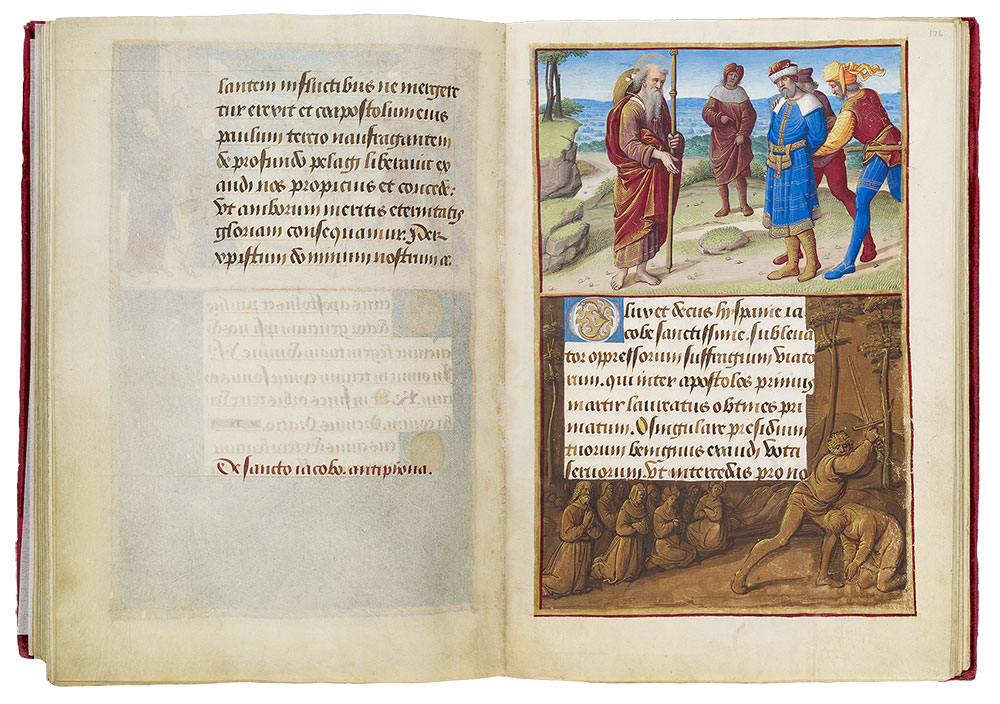
St. James: St. James with Hermogenes
Hours of Henry VIII
Illuminated by Jean Poyer
Gift of the Heineman Foundation, 1977
St. James: St. James with Hermogenes
Border: Decapitation of James (fol. 176)
James the Greater, or Elder (he was the older of two Apostles named James), was the brother of John the Evangelist. Here Poyer rendered the demons holding Hermogenes as exotically dressed soldiers, while the converted Philetus looks on. The terrified magician repented and promised to destroy his magic books.
After Christ's Ascension, James preached in Judea and Samaria, and then went to Spain. When he returned to Judea, the Pharisees requested that the magician Hermogenes should send his disciple, Philetus, to confront and refute the saint.
St. James performed some miracles, resulting in the conversion of Philetus and the rage of Hermogenes, who then ordered two demons to capture James and Philetus. Warned of the plot, the saint prayed that the demons bind and deliver Hermogenes instead, which they did.
The terrified magician repented and promised to destroy his magic books. Afraid of the demons, Hermogenes asked for something that belonged to the saint to prevent their attack, so James gave him his staff; when the converted magician returned with his tomes, the Apostle threw them into the sea.
The disappointed Pharisees dragged the saint before Herod Agrippa, who condemned him to be beheaded (A.D. 43). In the margin a crowd of kneeling men and women witness James's decapitation. This story apparently was modeled on that of Peter and Simon Magus in the preceding narrative.
James's Decapitation
After James's death, angels transported his body to Spain, where it lay on a stone that closed over it. His relics were discovered in the year 800 and taken to Compostella, which became a major pilgrimage site in the Middle Ages.
Pilgrims would return with badges as souvenirs, especially scallop shells (see also M.50 fol. 3); these were valued and often handed down as legacies. By the late Middle Ages, the saint himself was depicted as a pilgrim—his costume including a satchel decorated with a shell, a large hat, a traveler's cape, and staff; in the miniature two scallop shells decorate James's hat. (Feast day: July 25)
MS H.8, fols. 176v–177r
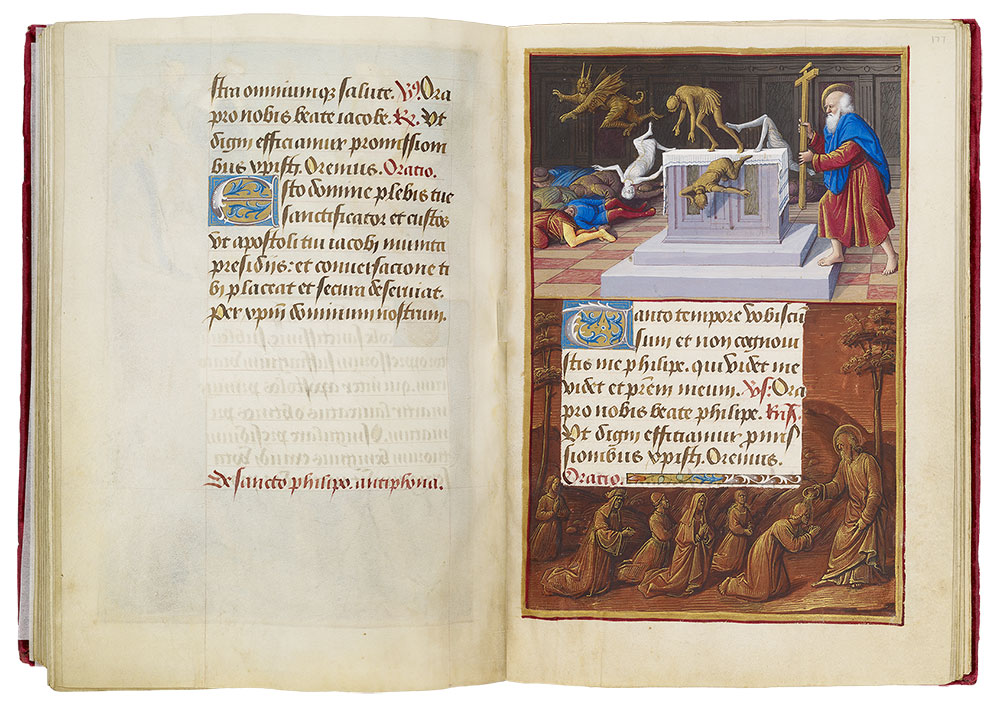
St. Philip: Philip Vanquishing Idols and a Demon
Hours of Henry VIII
Illuminated by Jean Poyer
Gift of the Heineman Foundation, 1977
St. Philip: Philip Vanquishing Idols and a Demon
Border: Philip Baptizing (fol. 177)
Philip, a native of Bethsaida in Galilee and a married father of three, gave up everything to follow Jesus. In the Apostle's most famous miracle, he cast the Devil, in the form of a hideous dragon, out of a statue of Mars.
Statue of Mars
A group of Scythian pagans had attempted to force the saint to sacrifice to a statue of the god Mars, but a huge dragon suddenly emerged from the statue, slaying the son of the priest and the two tribunes who had arrested the saint. The beast's noxious breath of the sickened onlookers.
Poyer's miniature, however, depicts a horned demon (instead of the traditional dragon) fleeing from Philip, and four statues fall from the altar of Mars (the golden ones are men, the white ones women). Beneath the demon are the fallen bodies of the sick and wounded, soon to be restored to health.
Philip told the crowd that if they broke the statue and adored the Lord's Cross, the sick would be cured and the dead would be brought back to life. The crowd agreed, and the saint spoke to the dragon, sending it to a faraway desert. Philip then healed the injured and revived the dead, converting the entire city.
(Border) In this image the saint baptizes the first of a long line of new converts made as a result of the miracle. (Feast day: May 1)
MS H.8, fols. 177v–178r
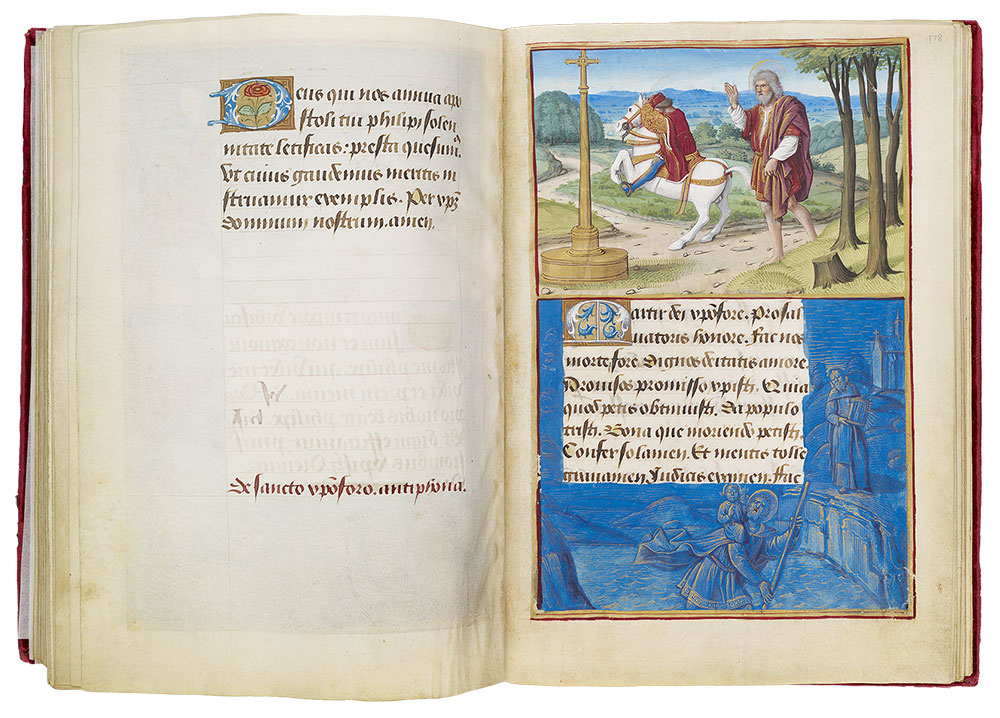
St. Christopher: Conversion of Christopher
Hours of Henry VIII
Illuminated by Jean Poyer
Gift of the Heineman Foundation, 1977
St. Christopher: Conversion of Christopher
Border: Christopher Carrying Christ (fol. 178)
The miniature portrays the moment when St. Christopher embraced Christianity, acknowledging the Cross's power with a reverential glance and gesture. The Devil, on horseback, gallops away in terror.
The name Christopher, which means "Christ-bearer" seems to suggest the basis of the saint's legend. As a Canaanite named Reprobus before his baptism, Christopher was a fearsome giant of a man.
Deciding to serve only the most powerful lord on earth, Christopher became a follower of Satan. However, the Devil fled upon seeing a crucifix planted in the roadway. Seeing Satan's fear, the giant resolved to follow Christ and his Cross instead.
In the margin, with the young Christ Child perched on his back, the saint struggles to cross the raging river. He leans heavily on his staff, panting with exertion. On the opposite bank is his mentor, the old hermit, who holds a lantern to light the way. (Feast day: formerly July 14)
Christopher's Resolve to Follow Christ
A hermit subsequently instructed the newly baptized Christopher in the Christian faith and gave him the task of helping travelers across a river. One stormy night a child asked the saint's assistance in traversing the current. The child was so heavy on Christopher's back that he nearly did not manage to cross. On the opposite bank the child announced that he was Jesus and Christopher had just carried the weight of the entire world on his shoulders. As proof of this, the child commanded the saint to plant his staff in the ground, where the next day it would blossom with flowers and dates.
MS H.8, fols. 178v–179r
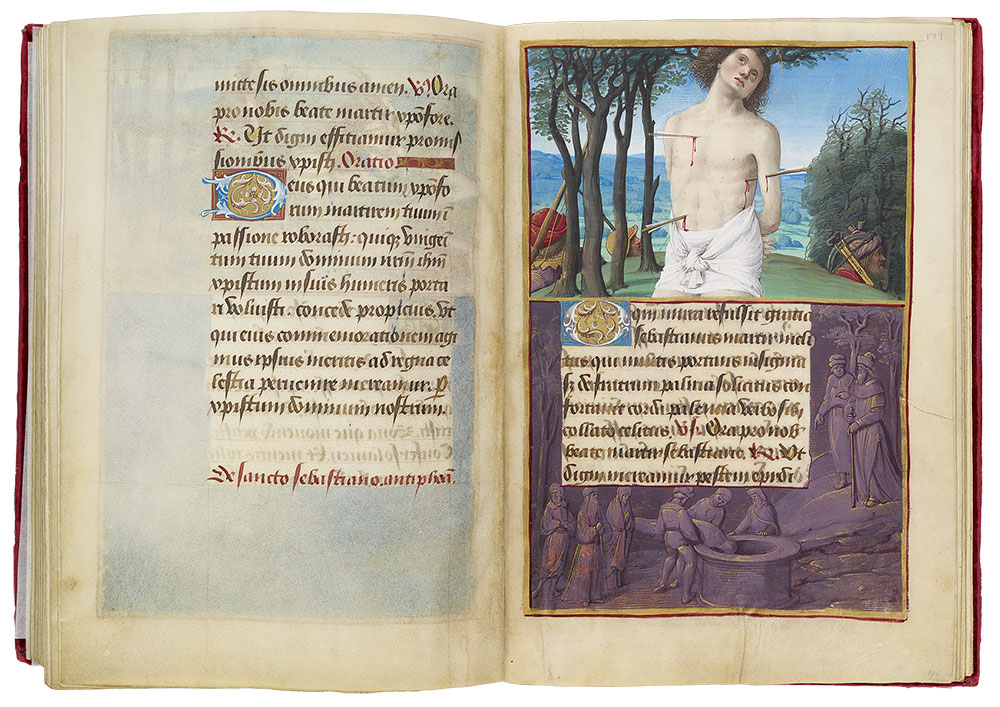
St. Sebastian: Sebastian Shot with Arrows, Abandoned by Archers
Hours of Henry VIII
Illuminated by Jean Poyer
Gift of the Heineman Foundation, 1977
St. Sebastian: Sebastian Shot with Arrows, Abandoned by Archers
Border: Sebastian's Body Cast into the Sewer (fol. 179)
During the late Middle Ages, Sebastian was usually depicted as a handsome, beardless youth, bound to a stake and pierced with arrows, his eyes looking heavenward. From the fifteenth century on he was nude (or nearly so).
Poyer's muscular Sebastian, his eyes turned upward, and clothed in a loincloth, is based on an Italian model. (Feast day: January 20)
In the lower margin two men dump Sebastian's shrouded body into the sewer. To the right a figure leaning on his staff, probably the emperor, oversees the operation, while at the left three Christians, including the matron Lucina, wait to reclaim the body.
St. Sebastian
According to legend, Sebastian was born in Gaul and raised in Milan. Although a Christian, he joined the Roman army in 283, rising to captain in the Praetorian Guard under Emperor Diocletian. Sebastian clandestinely assisted and consoled imprisoned Christians in addition to converting and baptizing other soldiers and civilians. His own religious convictions remained a secret until the tortures inflicted on his Christian friends Marcus and Marcellinus so infuriated him that he publicly proclaimed his faith. He was then condemned to die as a target for archery practice. After the attack a pious widow, Irene, claimed the body but discovered that Sebastian was still alive. She nursed him back to health, and he returned to the palace to confront the emperor. Diocletian promptly ordered Sebastian beaten to death and the body dumped into the Cloaca Maxima, the main sewer of Rome, preventing Christians from preserving and venerating it as the relic of a martyr. On the following night, however, the saint appeared to a Roman matron, St. Lucina, revealing the location of his body, which was subsequently retrieved and interred in the catacomb on the Appian Way.
MS H.8, fols. 179v–180r
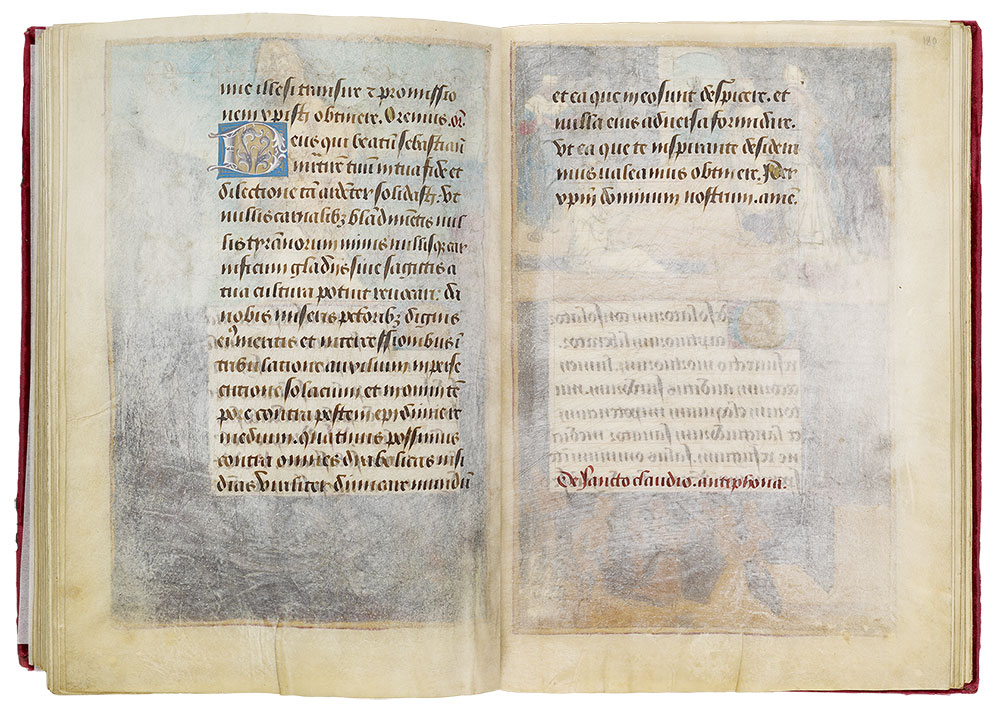
Hours of Henry VIII
Illuminated by Jean Poyer
Gift of the Heineman Foundation, 1977
MS H.8, fols. 180v–181r
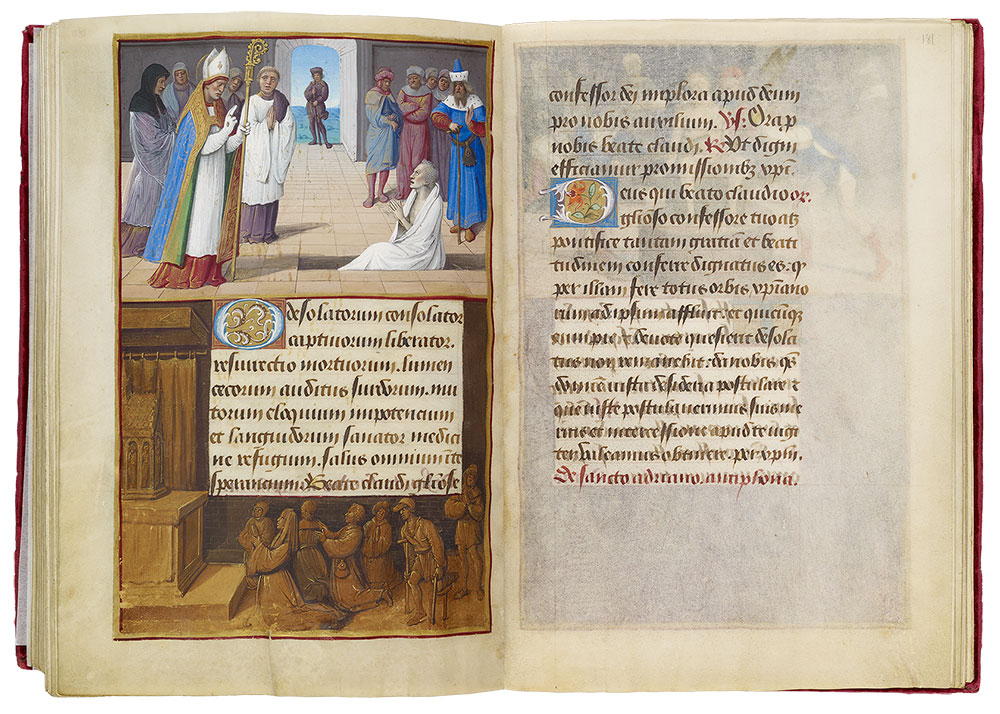
St. Claude of Besançon: Claude Resuscitating a Dead Man
Hours of Henry VIII
Illuminated by Jean Poyer
Gift of the Heineman Foundation, 1977
St. Claude of Besançon: Claude Resuscitating a Dead Man
Border: Pilgrims Kneeling Before Claude's Shrine (fol. 180v)
Claude, as in the miniature, is usually depicted as a bishop with miter and crosier. Here, as a result of his blessing, a dead man sits up in his grave, newly restored to life. (Legends often mention a dead child.)
Born at Salins in 607, Claude of Besançon was said to be from a Roman senatorial family. At the age of twenty he gave up a military career to become canon of Besançon; later he became a monk at the monastery of St. Oyend in the Jura Mountains, where he was subsequently elected abbot. As abbot, Claude applied the rule of St. Benedict and restored the monastery's buildings. In 685 he was chosen bishop of Besançon but retired eight years later to Condate, where he later died and was buried (6 June 699). His burial place (later called Saint-Claude) was a popular pilgrimage site, and miraculous cures took place there, including the resuscitation of three drowned children and a dead boy.
In the margin a group of pilgrims worships before the jewel-encrusted shrine containing the saint's relics. A woman in contemporary court dress kneels in front. Claude was often prayed to by French nobility for the birth of sons. At the rear hobbles a lame man, hoping for his eventual cure. (Feast day: June 6)
MS H.8, fols. 181v–182r
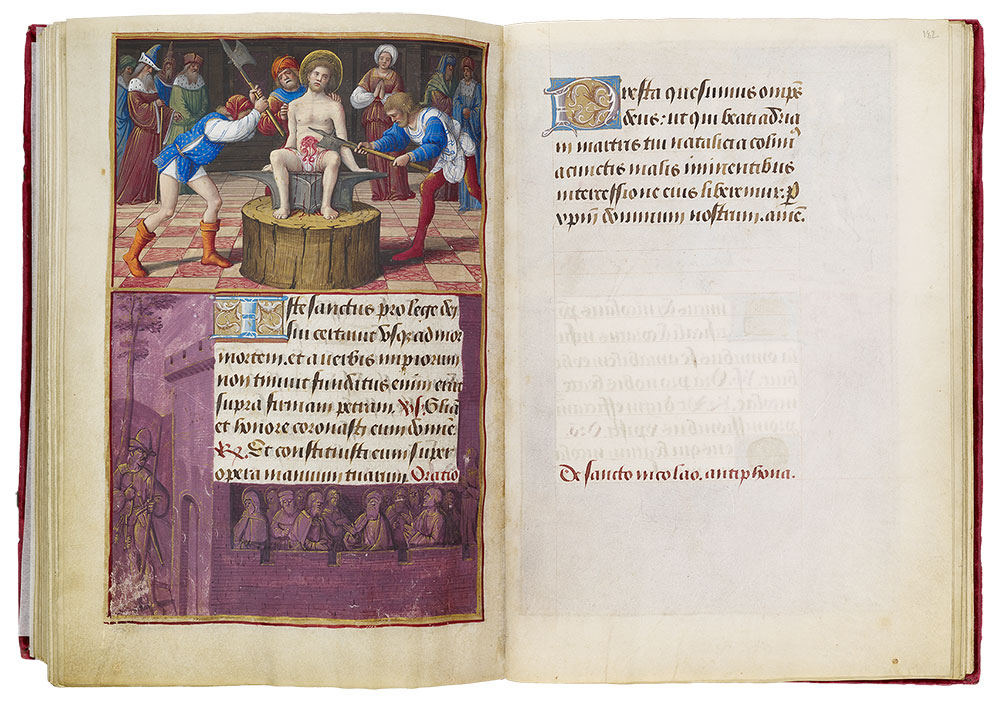
St. Adrian: Martyrdom of Adrian
Hours of Henry VIII
Illuminated by Jean Poyer
Gift of the Heineman Foundation, 1977
St. Adrian: Martyrdom of Adrian
Border: Christians in Prison (fol. 181v)
The miniature shows Adrian's two-part martyrdom. He is seated on the anvil, his intestines having already fallen out, as two executioners begin to hack off his legs. Adrian looks heavenward, while in the background Natalia prays contentedly; the emperor, at the left, directs the torture.
Adrian (or Hadrian) was a young Praetorian Guard in Nicomedia under Emperor Maximian (r. 286–305). The soldier was converted by witnessing the steadfast confidence of a group of Christians under torture. Impressed by their constancy, he asked to be counted among their ranks. Needless to say, Adrian was promptly arrested and imprisoned. His new wife, Natalia, (a secret Christian) was overjoyed, ran to the prison, and encouraged him to remain firm in his new faith, kissing his chains. When he learned the date of his impending martyrdom, the saint convinced the guards to allow him to tell his wife so that she could witness the event.
On the day of his death (ca. 300), Adrian was first beaten so severely that his "bowels fell out." After he was returned to prison, the emperor ordered that the legs of all the imprisoned martyrs be broken on an anvil and cut off. Natalia, who was present, additionally requested that the guards cut off her husband's hands, so that he would be equal to other saints who had suffered more. After Adrian's death Natalia managed to get away with a hand (holding it to her bosom), taking it with her to Argyropolis, where she died peacefully.
In the margin a jailer guards the imprisoned Christians who prompted Adrian's conversion. (Feast day: September 8, the translation of his relics to Rome)
MS H.8, fols. 182v–183r
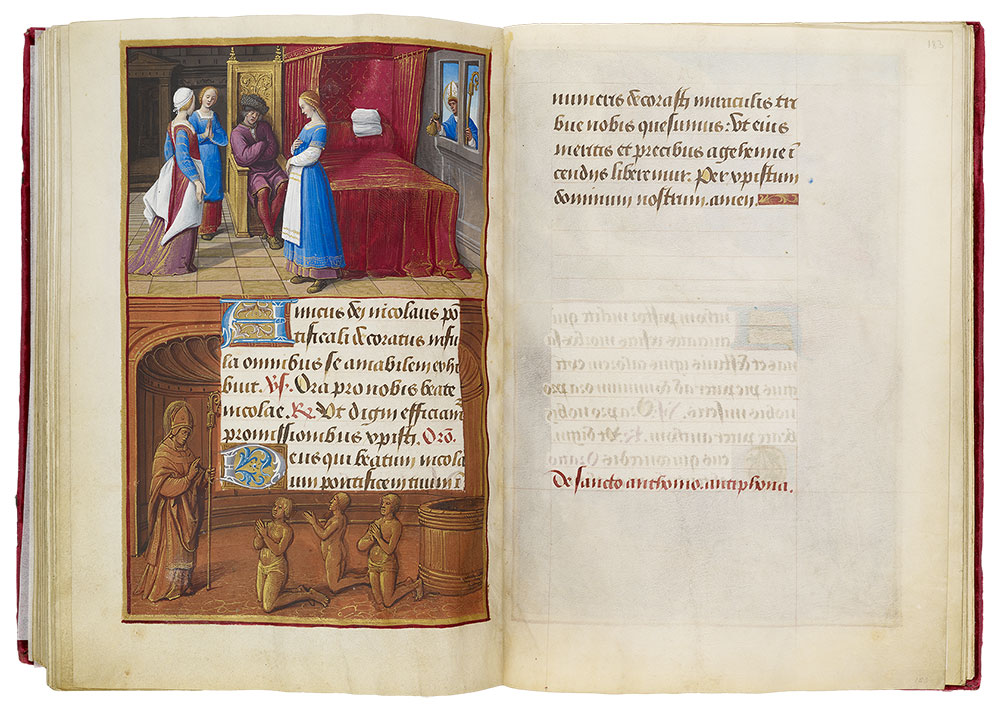
St. Nicholas: NIcholas Giving Gold to the Three Maidens
Hours of Henry VIII
Illuminated by Jean Poyer
Gift of the Heineman Foundation, 1977
St. Nicholas: NIcholas Giving Gold to the Three Maidens
Border: Nicholas Resuscitating the Three Boys (fol. 182v)
Nicholas (of Myra or Bari), one of the most universally venerated saints, is said to have been born about 270 and died in 342. A precociously religious child of wealthy parents, Nicholas supposedly stood up and praised God the moment he was born. When he inherited his father's fortune, he gave it away to the poor.
In the miniature the saint appears at a double window holding a bag of gold near a bed, while the girls' despondent father slumps in a chair. (The three gold balls became the insignia for the pawnbroker.)
St. Nicholas's most celebrated act of generosity occurred upon hearing an impoverished neighbor lament that he could not supply dowries for his three daughters, leaving them no alternative but a life of prostitution. On three successive nights Nicholas threw a bag of gold (or a gold ball) through their window.
The saint's second famous miracle involves an unscrupulous innkeeper who, during a food shortage, dismembered and pickled three young boys to feed his guests. Sensing foul play, Nicholas made the Sign of the Cross over the tub, and the three stood up, restored to life.
In the grisaille border the three boys, now restored to life, kneel in gratitude before the blessing saint. This legend may have developed from the three purses or gold balls normally shown with the saint, which were mistaken for the towheads of children.
As Nicholas's feast falls during the Christmas season, he was confused with a folklore character who rewarded good children with gifts brought secretly during the night. The two eventually merged to become Father Christmas, or Santa Claus (Feast day: December 6)
MS H.8, fols. 183v–184r
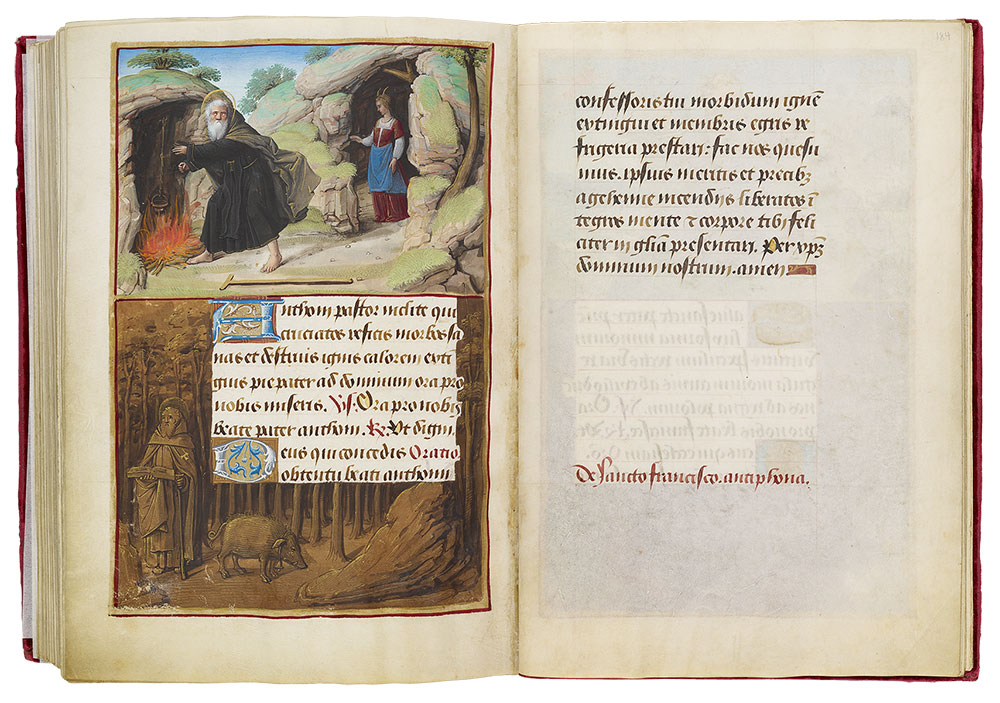
St. Anthony Abbot: Temptation of Anthony
Hours of Henry VIII
Illuminated by Jean Poyer
Gift of the Heineman Foundation, 1977
St. Anthony Abbot: Temptation of Anthony
Border: Anthony in the Wilderness (fol. 183v)
Anthony Abbot, or Anthony the Great (ca. 251–356), is best known for his long life of asceticism in the Egyptian deserts. Born in an Egyptian village near Memphis, Anthony Abbot decided at age twenty, when his parents died, to become a hermit. For two decades the saint lived in complete solitude in an abandoned tomb. Here the Devil tempts him in the form of an attractive woman, and scares him in the forms of a black man and then wild animals.
In 1095, in La Motte (in southern France), an order of Hospitalers was created in the saint's honor. Wearing black robes with a blue tau cross, they traveled widely, ringing bells for alms. By special ordinance, the Hospitalers' pigs were allowed to forage freely, leading to pictures of the saint accompanied by a pig.
Poyer's miniature presents Anthony as an old bearded man in a black robe and tau cross (the Egyptian cross and a symbol of his abbatial authority). The crutch at the saint's feet refers both to Christ's Cross and to the Hospitalers' care of the infirm. Anthony reaches toward the fire to escape the demonic young woman (note her horns).
In the margin below Anthony appears with his staff in the wilderness; the open book symbolizes the book of nature, which compensated the saint for lack of any other reading material. The belled pig at his side refers to the order of Hospitalers, but it was also his only companion in the wilderness. (Feast day: January 17)
MS H.8, fols. 184v–185r
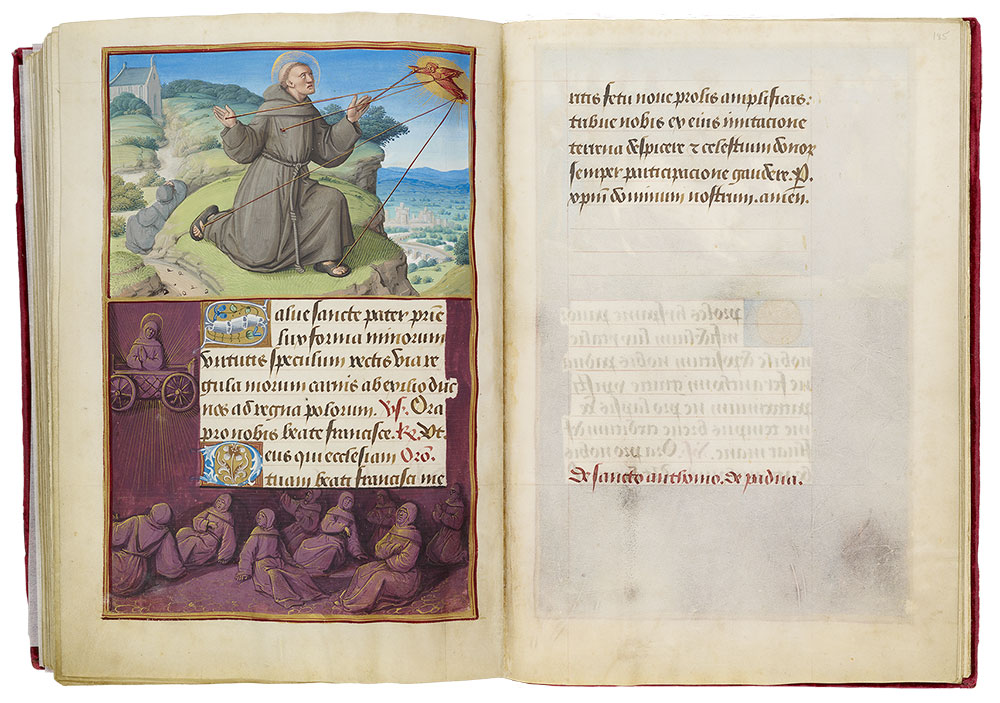
St. Francis: Stigmatization of Francis
Hours of Henry VIII
Illuminated by Jean Poyer
Gift of the Heineman Foundation, 1977
St. Francis: Stigmatization of Francis
Border: Francis in the Fiery Chariot (fol. 184v)
A great deal is known about the life of Francis of Assisi (118–1226), the founder of the Order of Friars Minor (Franciscans). As a youth he led the life of a carefree cavalier, but a year spent as a prisoner of war in Perugia (1201) and a subsequent serious illness changed Francis's values, leading him to become a monk devoted to the care of the poor and lepers. In 1210 the saint, with a dozen followers, traveled to Rome, petitioning Pope Innocent III to establish his new order, the brotherhood of poverty. The order was created and grew rapidly.
On 14 September 1224, while on retreat at Mount Alvernia, Francis prayed that he might feel with his own body the agony of Christ on the Cross and was rewarded with the stigmata, which he hid from others until his death. The event, appropriately, occurred on the feast day of the Exaltation of the True Cross. Francis died two years later; he was canonized by Pope Gregory IX (r. 1227–41) in 1228.
The miniature shows the moment of stigmatization. Francis kneels in prayer on a mountaintop before the apparition of a seraph who folds his wings to form the shape of a cross. Five rays project from the angel, marking the saint in the same places as Christ's wounds (as also shown in the left border of fol. 5v).
Francis wears the gray habit of his order with a cord for a belt. The knotted belt is a reminder of the cords that bound Christ; the three knots symbolize the three Franciscan virtues of poverty, chastity, and obedience.
At the left is one of the three monks who went with Francis to the mountaintop but slept through the event.
The grisaille scene depicts an obscure miracle—derived from Elijah's chariot of fire—that was popularized during the fourteenth century. Francis, concerned that his monks had been lax, appeared to them in a floating fiery chariot, reminding them tofollow his rules of poverty and humility. The apparition awakens the monks, some of whom are still befuddled by sleep; two in the right rear, however, kneel in prayer. (Feast day: October 4)
MS H.8, fols. 185v–186r
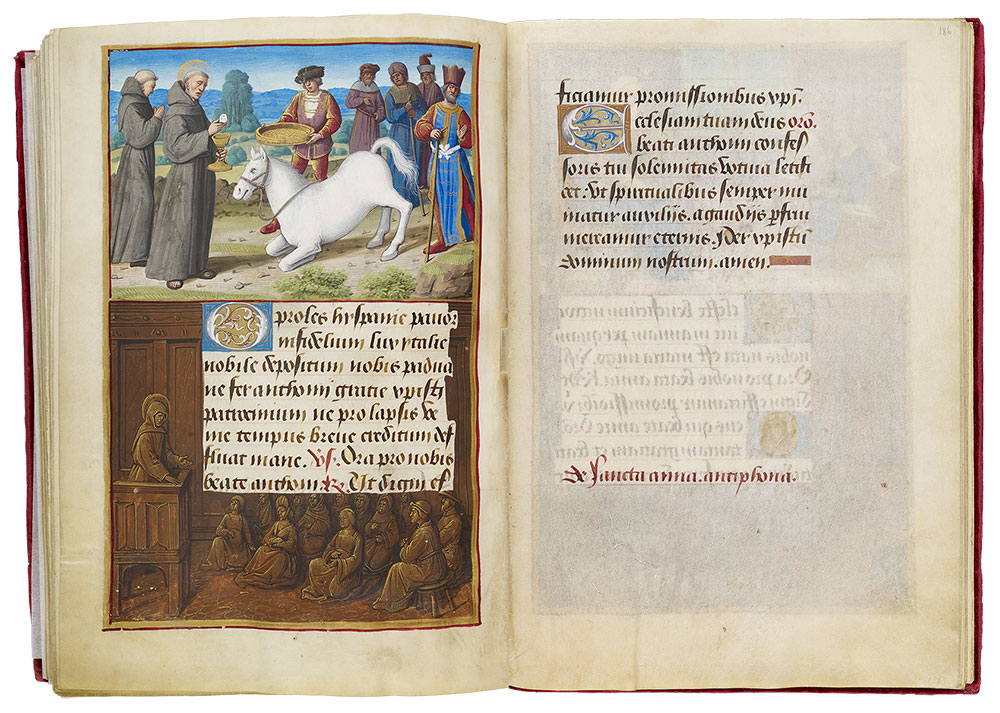
St. Anthony of Padua: Anthony and the Miracle of the Kneeling Horse
Hours of Henry VIII
Illuminated by Jean Poyer
Gift of the Heineman Foundation, 1977
St. Anthony of Padua: Anthony and the Miracle of the Kneeling Horse
Border: Anthony Preaching (fol. 185v)
One of Anthony's most popular miracles involved a challenge to prove the real presence of Christ in the Eucharist. Although the story is normally told about a mule, Poyer has replaced it with a horse, who ignores the proffered feed and kneels before the host that Anthony holds over a chalice.
Born in Lisbon in 1195, the saint is known as Anthony of Padua because the basilica in that city (where he briefly resided) possesses his miracle-working relics. Already, as a pious youth, he used prayer to overcome the severe temptations against purity that he suffered during his teens. Initially joining the Augustinian order, he later became a Franciscan friar and preached throughout northern Italy and southern France with great success.
Anthony died in 1231 at Arcella, near Padua, and was quickly canonized by Pope Gregory IX the following year. Until the end of the fourteenth century his cult was a local Paduan phenomenon. However, in the fifteenth century, Bernardino of Siena, a noted theologian and leader of the Franciscan order, brought Anthony wider renown, making him the most popular Franciscan saint after Francis of Assisi.
An unbelieving man, a Jew named Guillard, looks on in astonishment, as he had claimed that he would be convinced if a horse could pass up a measure of oats for the consecrated Host. (Feast day: June 13)
Having a magnificent memory and vast knowledge of the Bible, Anthony and was acclaimed for his skill in preaching, which began when a misunderstanding at an ordination left the service without a speaker. His superiors ordered him to come forward and say whatever the Holy Spirit put into his mouth, which he did with great style, passion, and erudition.
MS H.8, fols. 186v–187r
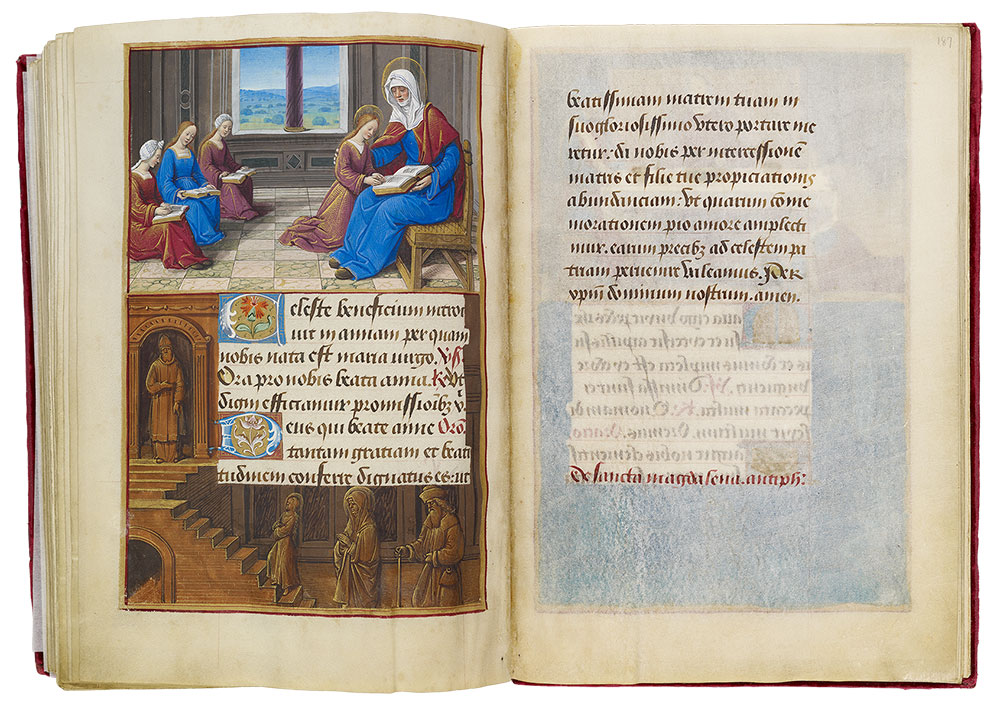
St. Anne: Anne Instructing the Virgin
Hours of Henry VIII
Illuminated by Jean Poyer
Gift of the Heineman Foundation, 1977
St. Anne: Anne Instructing the Virgin
Border: Presentation of the Virgin in the Temple (fol. 186v)
In the later Middle Ages (with its increased literary levels) Anne is often depicted, as here, instructing the Virgin in her reading. The scene takes place in a domestic interior that also includes other students, but Mary is distinguished by her primacy as well as her halo.
According to the apocryphal Gospel of James, the Virgin Mary's parents, Anne and Joachim, were an elderly and childless couple. An angel answered their prayers for a child, telling them that their offspring would become famous. Anne vowed to dedicate the infant Mary to the Lord, and at the age of three, the girl was presented in the temple, where she was raised in the service of God. Once Mary was old enough to marry, the priests sent her home so that she might find a husband.
According to the Golden Legend, Anne married twice after Joachim's death: first to Cleophas and then Salome, bearing a daughter named Mary to each of them. Each of her daughters named Mary, respectively, bore one, four, and two sons, making Anne the grandmother of Jesus; Sts. Simon, Jude, Joseph the Just, and James the Less; and Sts. John the Evangelist and James the Great.
The Prayer Book of Anne de Bretagne (see also M.50), also illustrated by Poyer, includes a Suffrage (different from the one here) mentioning Anne's trio of husbands; the accompanying illustration also depicts St. Anne instructing the Virgin (M.50, fol. 13). (Feast day: July 26)
Poyer's border depicts Mary's presentation at the Temple. The three-year-old child, followed, but not assisted, by Anne and Joachim, has begun to climb the fifteen steps leading to the temple. Zacharias, priest and father of John the Baptist, waits to receive her in the doorway.
MS H.8, fols. 187v–188r
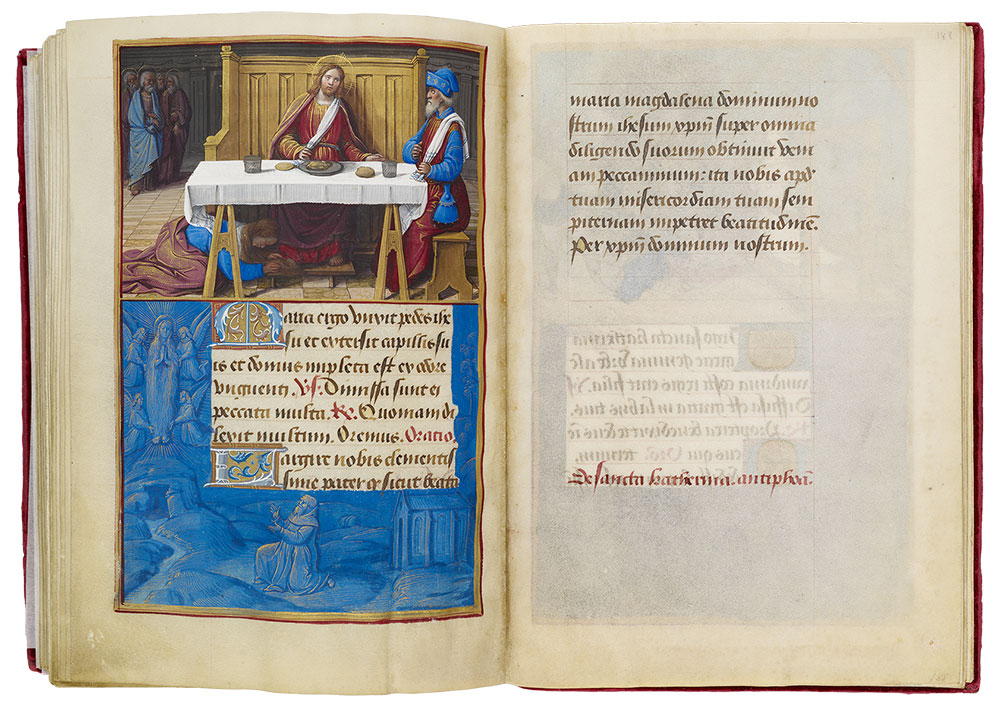
St. Mary Magdalene: Mary Magdalene Washing the Feet of Christ
Hours of Henry VIII
Illuminated by Jean Poyer
Gift of the Heineman Foundation, 1977
St. Mary Magdalene: Mary Magdalene Washing the Feet of Christ
Border: Levitation of Mary Magdalene (fol. 187v)
In the miniature of Christ's dinner at Simon's house, the Magdalene dries Christ's feet with her long, flowing hair, while the Savior leans to the Pharisee, who is stiff with indignation, and defends her actions. At the left, the Apostles huddle together in disapproval.
The legend of Mary Magdalene, the archetypal repentant woman sinner, is a conflation of three New Testament persons: Mary of the village of Magdala from whom Jesus drove seven devils; Mary of Bethany, sister of Lazarus and Martha; and the un- named sinner at Simon the Pharisee's (or Leper's) house who washed Christ's feet with her tears and then anointed them. Be that as it may, Mary Magdalene witnessed Christ's Crucifixion, prepared his body for burial, and was the first witness to his Resurrection. Mary Magdalene is depicted in The Prayer Book of Anne de Bretagne.
The immobilized hermit witnessing Mary's celestial feeding is shown in the border. The iconography of her ascension via angels, begun in the twelfth century, is based on the Assumption of the Virgin. The Magdalene's hair, which has grown to her feet, covers her body. (Feast day: July 22)
After Christ's Ascension, according to an eleventh-century Provençal legend recorded in the Golden Legend, Mary, with Sts. Martha and Lazarus, was cast adrift in a rudderless boat by infidels; guided by an angel, however, they reached Marseilles, France. After a period of preaching, Mary retired to the cave of Sainte-Baume in the Maritime Alps, passing thirty years in penitence and contemplation. Never eating, she was refreshed by the songs of the heavenly hosts, which she heard when angels carried her aloft every day at the canonical Hours. On one occasion, a hermit, who had built a cell near her grotto, witnessed the angels lifting and returning the saint to earth. Wanting proof of what he had seen, he ran to where she appeared but was paralyzed. The saint then revealed her identity.
MS H.8, fols. 188v–189r
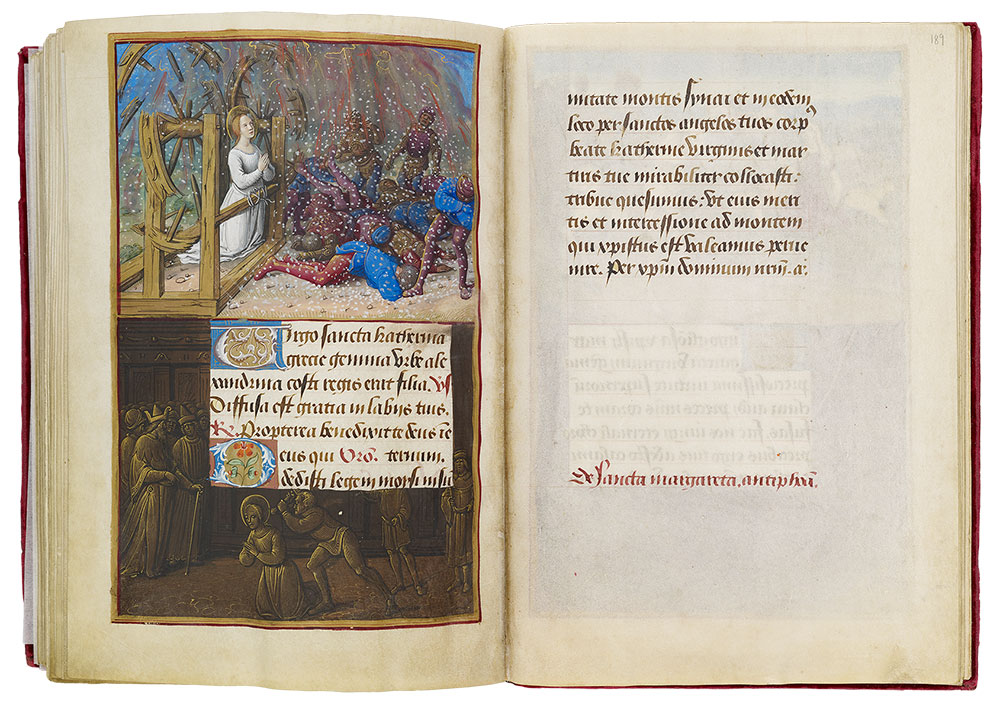
St. Catherine: Catherine Rescued from the Torture Wheels
Hours of Henry VIII
Illuminated by Jean Poyer
Gift of the Heineman Foundation, 1977
St. Catherine: Catherine Rescued from the Torture Wheels
Border: Decapitation of Catherine (fol. 188v)
According to the Golden Legend, Catherine was the daughter of King Costas of Cyprus. Renowned for her noble birth and education, she attracted the interest of the early- fourth-century Emperor Maxentius (r. 306–12) who wanted to marry her. She refused him, having chosen instead to become the "bride of Christ."
Catherine's steadfast refusal of the emperor led to the order for her execution. Two spiked wheels, which were to grind against each other, were constructed, and the saint was placed between them. She prayed to the Lord for the machine to fall to pieces so that his name would be praised and those who stood by might be converted. Instantly an angel struck thedevice with such violence it broke apart, killing her tormentors.
Believing he could force the young woman to apostatize, Maxentius gathered fifty prominent pagan philosophers in Alexandria to convince her of the errors of Christianity. Shesuccessfully refuted them and even converted the philosophers, who were subsequently executed. Catherine, however, was unharmed, as the emperor still lusted after her.
The spurned emperor ordered Catherine beheaded, the subject depicted in the margin. Maxentius, holding a staff, looks on as the executioner prepares to do his job (his sword is hidden by the text).
At her death, Catherine prayed to Jesus that "whosoever shall celebrate the memory of my passion, or shall call upon me at the moment of death or in any necessity, may obtain the benefit of thy mercy," increasing the popularity of her cult and ensuring the efficacy of her intercession. After Catherine's death, angels carried her body to Mount Sinai, where it is preserved in the famous monastery that bears her name. (Feast day: formerly November 25)
MS H.8, fols. 189v–190r
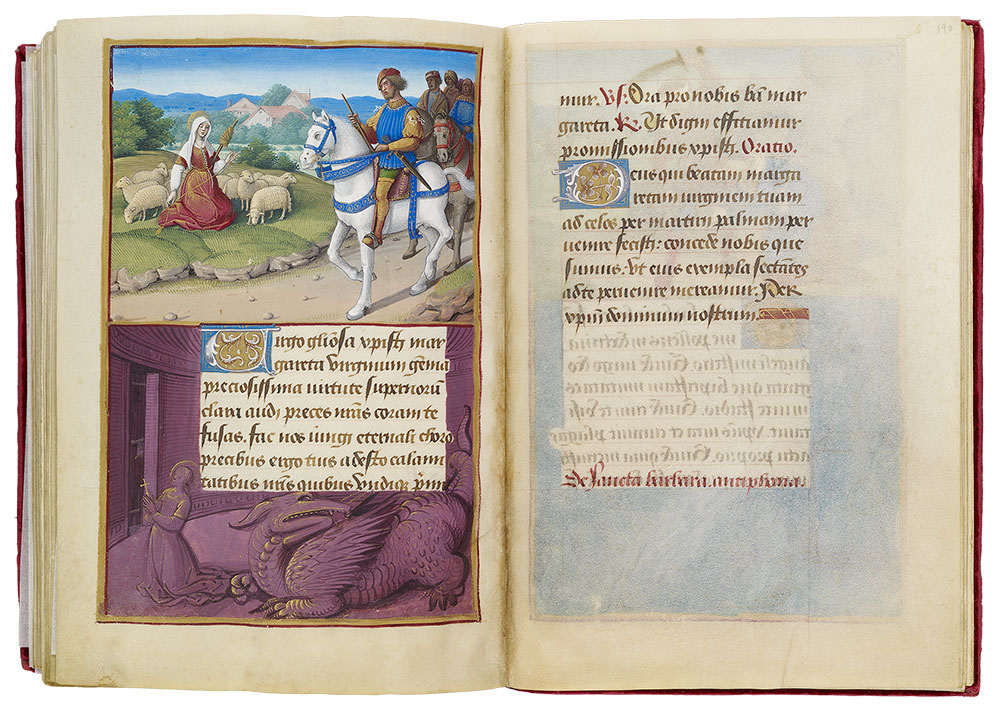
St. Margaret: Margaret and Olybrius
Hours of Henry VIII
Illuminated by Jean Poyer
Gift of the Heineman Foundation, 1977
St. Margaret: Margaret and Olybrius
Border: Margaret and the Dragon (fol. 189v)
Margaret was the daughter of Theodosius of Antioch, a third-century pagan prince. Shortly after Magaret's birth, her mother died, so her father placed her in the care of a countrywoman, a secret Christian who raised the young girl in that faith. Later, after Margaret's conversion was discovered, she was disowned and banished with her nurse from the palace. They lived in the country as shepherdesses.
One day Governor Olybrius of Antioch, as in the miniature, saw Margaret spinning wool while tending sheep and fell in love with her. Margaret's refusal to yield her faith angered the governor.
Olybrius ordered Margaret tortured and thrown into prison, where a fierce dragon appeared and swallowed her. The saint made the sign of the Cross, causing the dragon to explode, freeing her from its belly. She then prayed that women in labor invoking her name would be as safely delivered as she was from the dragon.
During the late fourteenth and early fifteenth centuries, Margaret was most frequently shown guarding sheep; later the prison scene with the dragon (her primary attribute) became popular. (Feast day: formerly July 20)
MS H.8, fols. 190v–191r
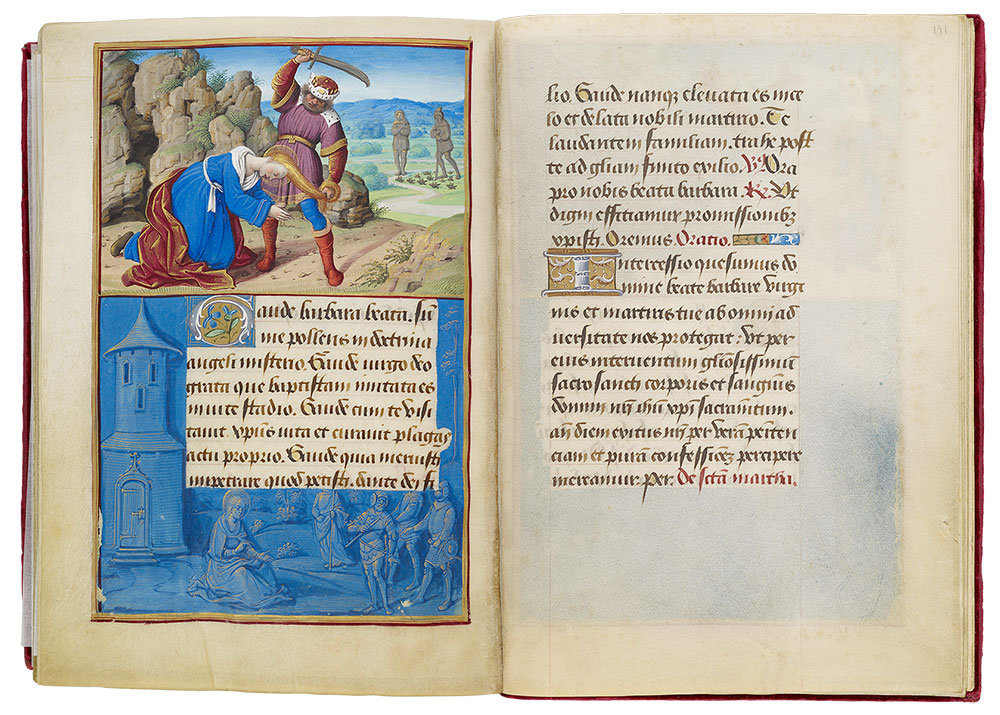
St. Barbara: Decapitation of Barbara
Hours of Henry VIII
Illuminated by Jean Poyer
Gift of the Heineman Foundation, 1977
St. Barbara: Decapitation of Barbara
Border: Barbara Before Her Tower (fol. 190v)
Legend has it that Barbara was the daughter of an Eastern governor, Dioscurus of Heliopolis, who imprisoned her in a two-windowed tower so that no man could see her. Seeking religious fulfillment she wrote to the Church father Origen (ca. 185–ca. 254), who sent his disciple Valentine to instruct her. Disguised as her doctor, he gained access to the tower and eventually baptized her.
Poyer depicted the two shepherds who saw Barbara fly up to a mountain, where they kept their sheep, and betrayed her. At their feet, their flock of sheep, through divine retribution, were transformed into insects. (Feast day: formerly December 4)
Dioscurus handed his daughter over to the Proconsul Marcian for torture, but she steadfastly refused to renounce Christianity. Out of anger and frustration, the governor dragged his daughter by the hair to the mountaintop and cut off her head.
When her father was away on a trip, Barbara had workmen add a third window—in honor of the Trinity—in her tower. Upon his return, she told her father that the three windows symbolized the Father, Son, and Holy Spirit, who had illuminated her. Furious, Dioscurus forced her to take refuge at the top of her tower, from which angels carried her away to a secret hiding place.
MS H.8, fols. 191v–192r
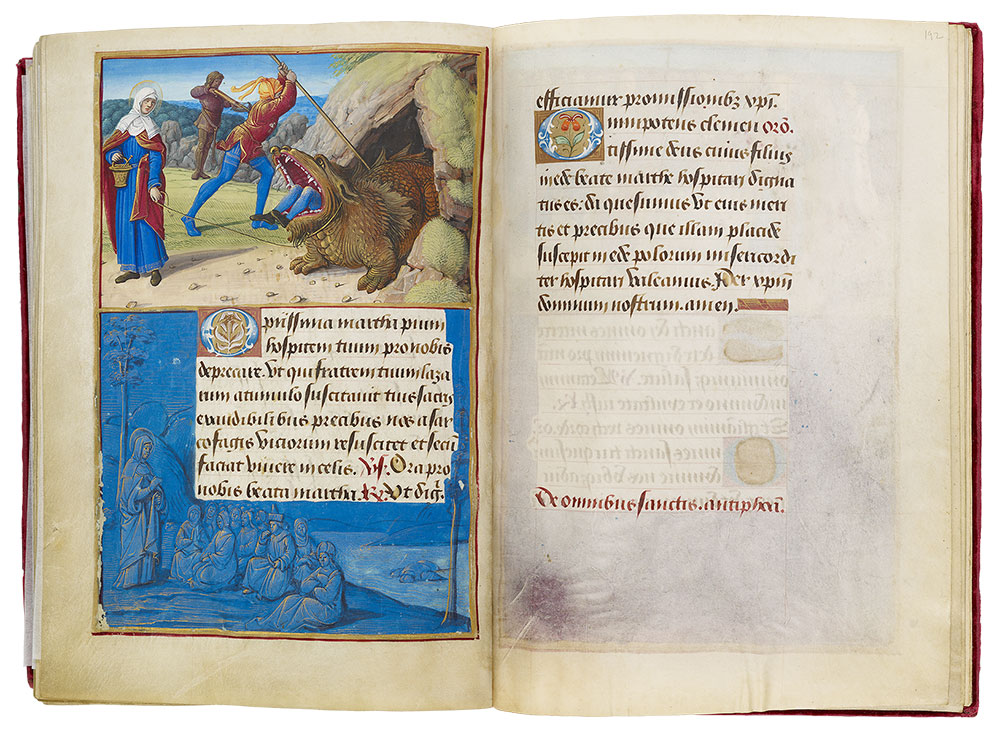
St. Martha: Martha Taming the Tarasque
Hours of Henry VIII
Illuminated by Jean Poyer
Gift of the Heineman Foundation, 1977
St. Martha: Martha Taming the Tarasque
Border: Martha Preaching (fol. 191v)
Martha was the sister of Lazarus and Mary Magdalene. After Christ's Ascension, they were set adrift in a boat, which was guided by an angel to Marseilles.
In Marseilles, according to legend, Martha overcame a dragon, the Tarasque, which had been terrorizing the people of Tarascon in Provence. Half- animal and half-fish, the monster slew passersby and sank ships. The people appealed to Martha for help. Armed with an aspergillum (a device to sprinkle holy water) and holy water bucket, she went after the dragon, which she found devouring a man.
After subduing the beast with holy water, as in the miniature, she bound it about the neck with her girdle and led it away to be killed. One man plunges a spear into its neck while another—at a considerably safer distance— aims his crossbow.
Martha, devoting herself to prayer and fasting, remained in Tarascon, where a great community of religious women grew up around her. One day, while she was preaching on the bank of the Rhône River near Avignon, her second famous miracle occurred.
A young man on the opposite bank was eager to hear her words. Having no boat, he attempted to swim across, but he was overcome by the current and drowned (as shown in the border). After the body was recovered, it was laid at the saint's feet so that she might revive him. In her prayer she asked Christ, who had raised her brother Lazarus to life, to do the same for the dead youth. Taking the young man by the hand, she caused him to rise at once, and he was baptized. (Feast day: July 29)
MS H.8, fols. 192v–193r
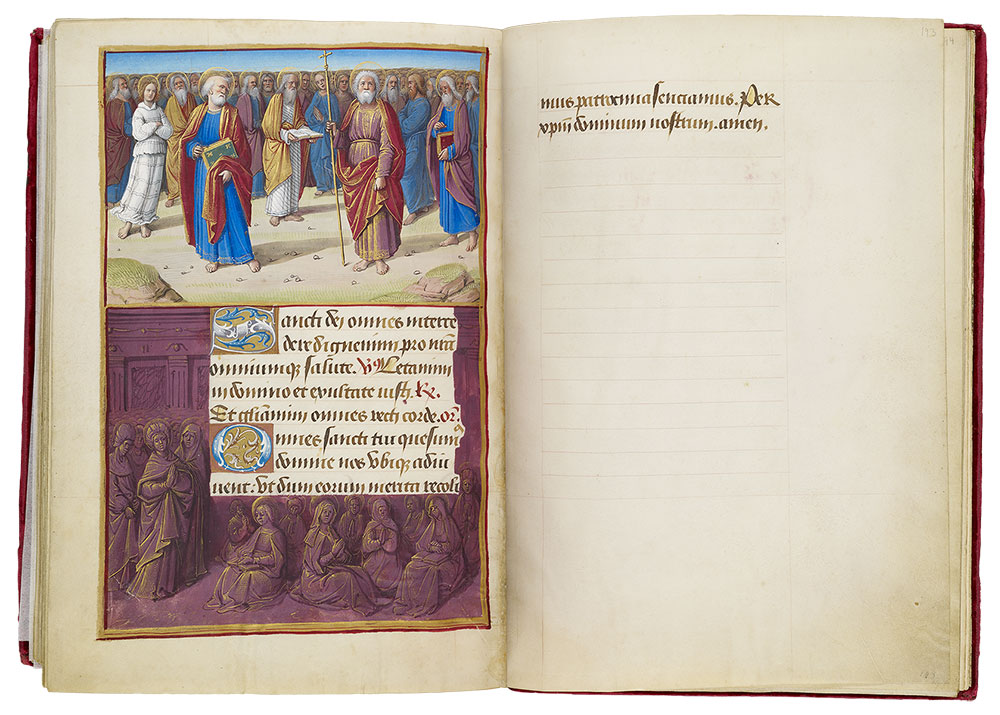
All Saints: All Male Saints
Hours of Henry VIII
Illuminated by Jean Poyer
Gift of the Heineman Foundation, 1977
All Saints: All Male Saints
Border: All Female Saints (fol. 192v)
All Saints was a catchall feast of Eastern origin, which celebrated the "martyrs of the whole world" on the first Sunday after Pentecost. (In the early Church all saints, with the exception of the Apostles, were martyrs.) Images of all saints typically show them in ranks. In accordance with a well-established hierarchy, the male saints out-ranked the females (hence the women's relegation to the margin).
During the last few years (ca. 303–5) of Emperor Diocletian's reign so many Christians were martyred that it became impossible for each to have his or her own assigned day for commemoration, hence this all-encompassing feast. With the dedication of the Pantheon in Rome to St. Mary of the Martyrs on 13 May 609 (or 610), the feast changed to that date. When Pope Gregory III dedicated a chapel on November 1 to All Saints in St. Peter's Basilica, the feast was changed to that day, where it has remained. According to the Golden Legend, the date was changed so that greater crowds could come to Rome after the harvest and vintage to participate in the popular celebration. In English the feast is known as All Hallows and the night before as Hallowe'en (short for All Saints' Eve).
Within the context of Suffrages in a Book of Hours, this massive grouping of saints serves an additional purpose. Praying to all the saints at once, encourages them to join in an intercession. Surely it would be impossible for God not to grant the prayers of all the saints on one's behalf. Little wonder that the feast day was such a favorite.
The male saints were further ordered by status: first came the Apostles, followed by martyrs, and then confessors. Poyer suggested these divisions by placing Peter and Paul at the head of the contingent. Close behind them are the four evangelists; the young man at left dressed in white is John, the beloved disciple. Behind them, the rest of the saints form an isocephalic horizon.
The women in the margin of the lower image, seated with books or praying, have no identifying attributes. (Feast day: November 1)
Series of prayers, fol. 193v
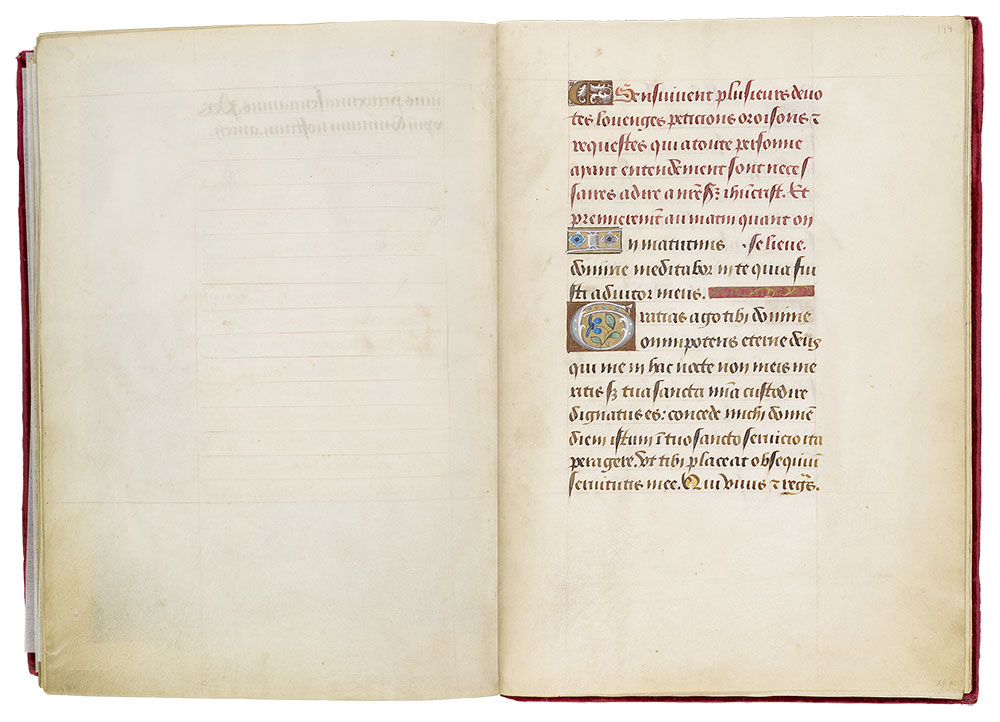
Hours of Henry VIII
Illuminated by Jean Poyer
Gift of the Heineman Foundation, 1977
MS H.8, fols. 194v–195r
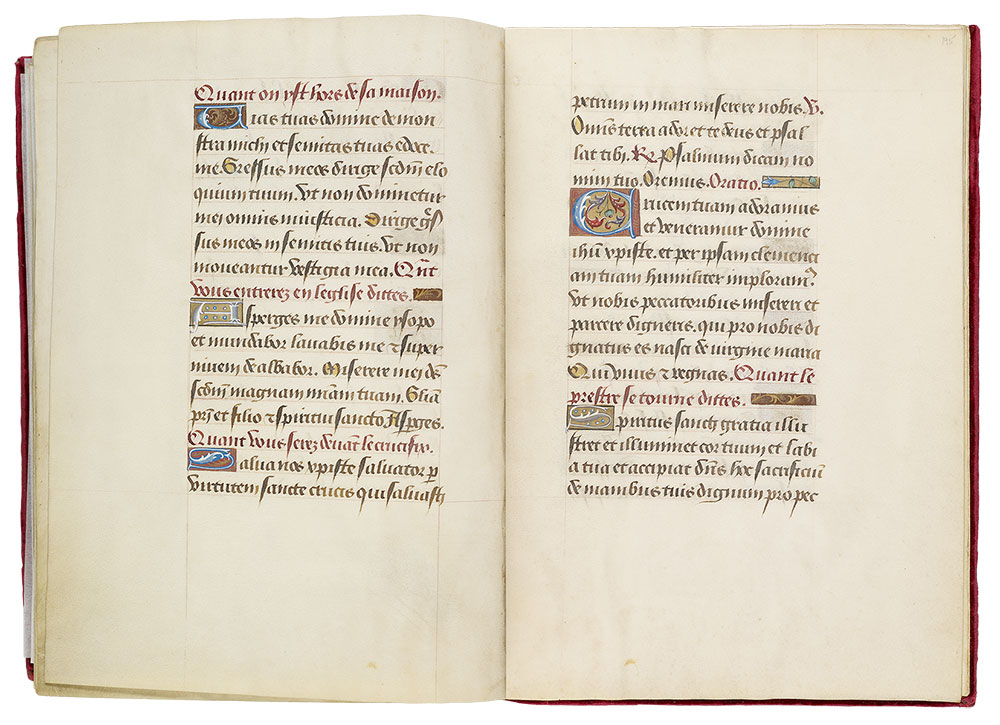
Hours of Henry VIII
Illuminated by Jean Poyer
Gift of the Heineman Foundation, 1977
MS H.8, fols. 195v–196r
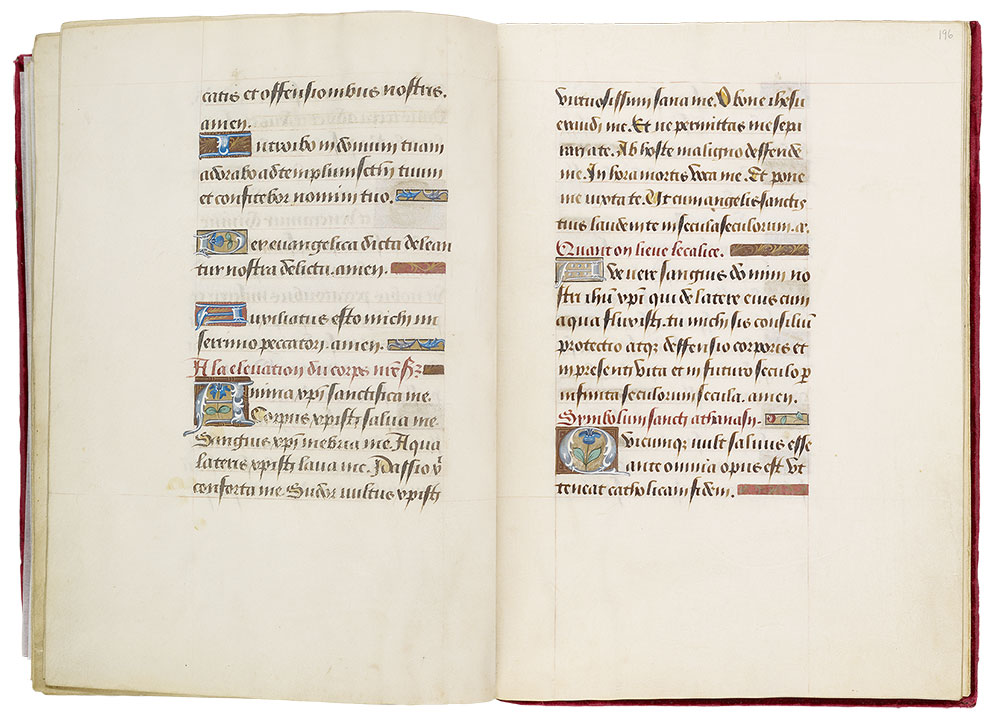
Hours of Henry VIII
Illuminated by Jean Poyer
Gift of the Heineman Foundation, 1977
MS H.8, fols. 196v–197r
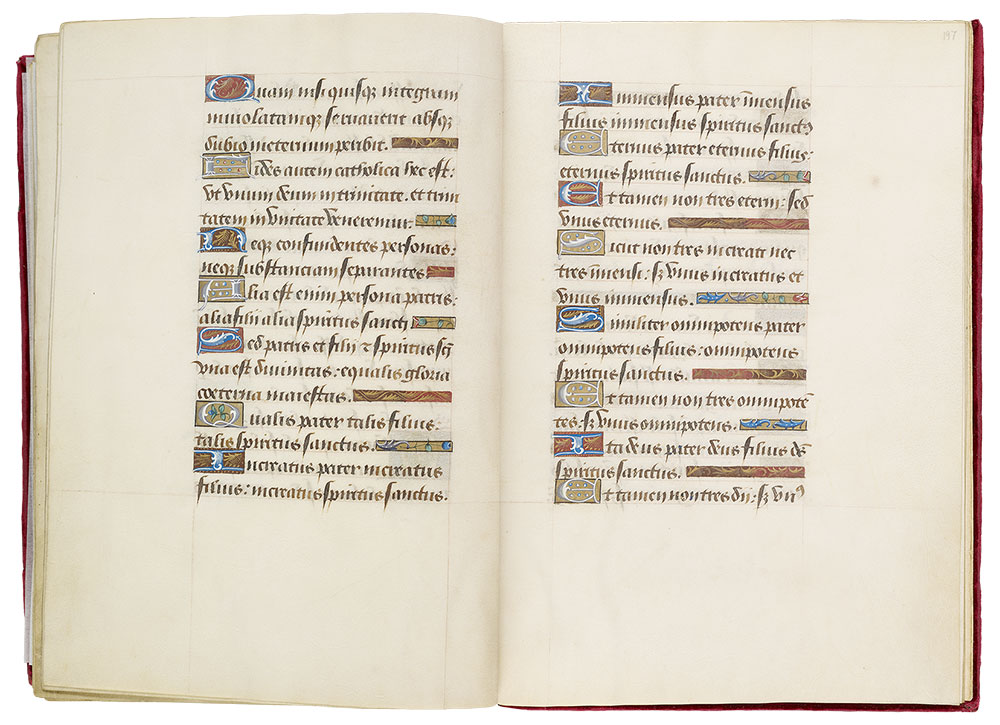
Hours of Henry VIII
Illuminated by Jean Poyer
Gift of the Heineman Foundation, 1977
MS H.8, fols. 197v–198r
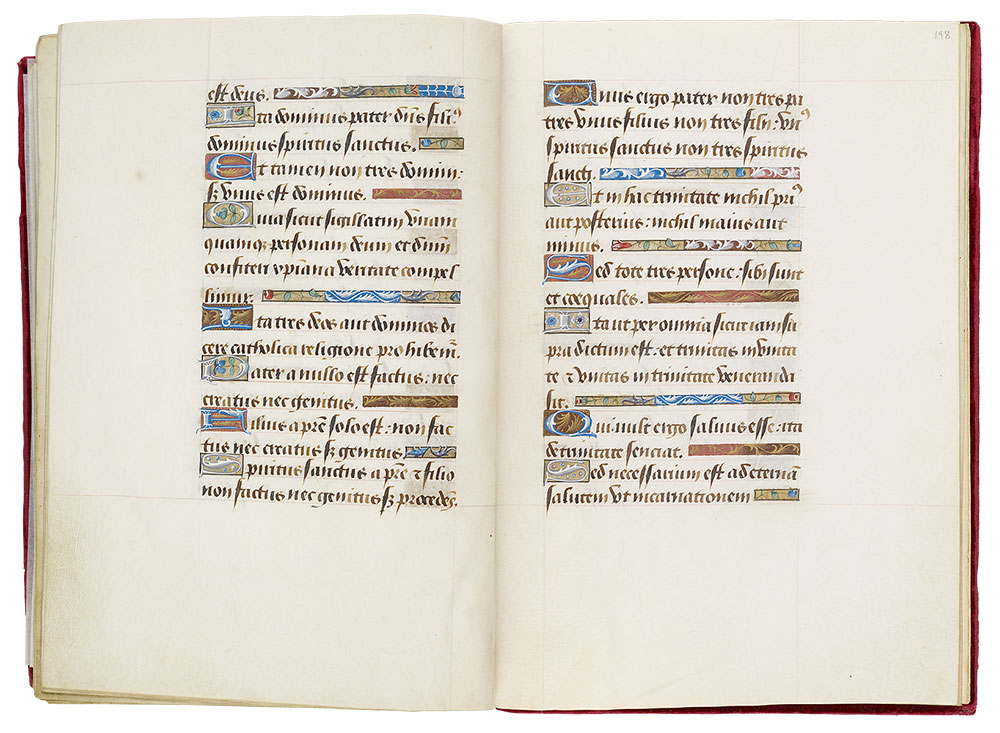
Hours of Henry VIII
Illuminated by Jean Poyer
Gift of the Heineman Foundation, 1977
MS H.8, fols. 198v–199r
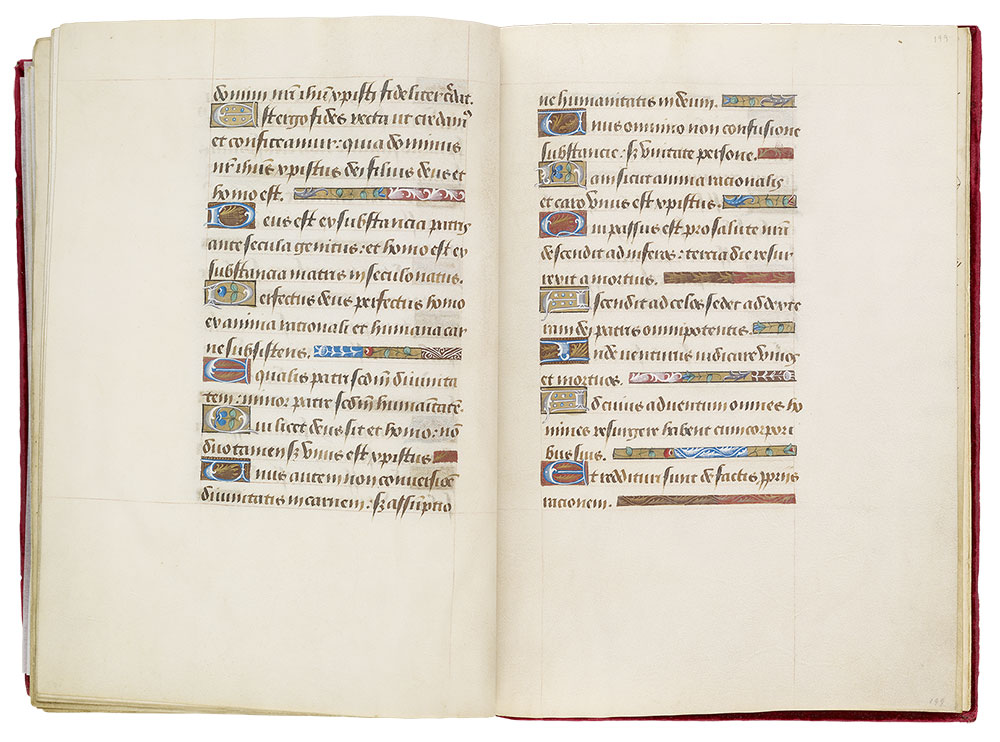
Hours of Henry VIII
Illuminated by Jean Poyer
Gift of the Heineman Foundation, 1977
Provenance note by George Wade
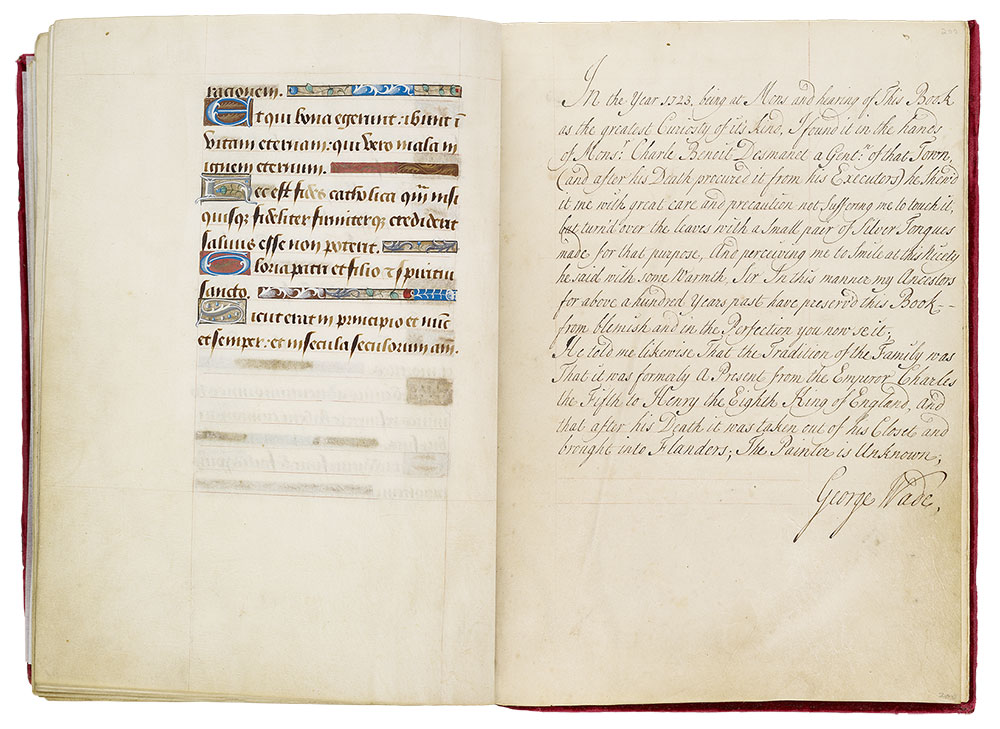
Hours of Henry VIII
Illuminated by Jean Poyer
Gift of the Heineman Foundation, 1977
Blank fly leaves
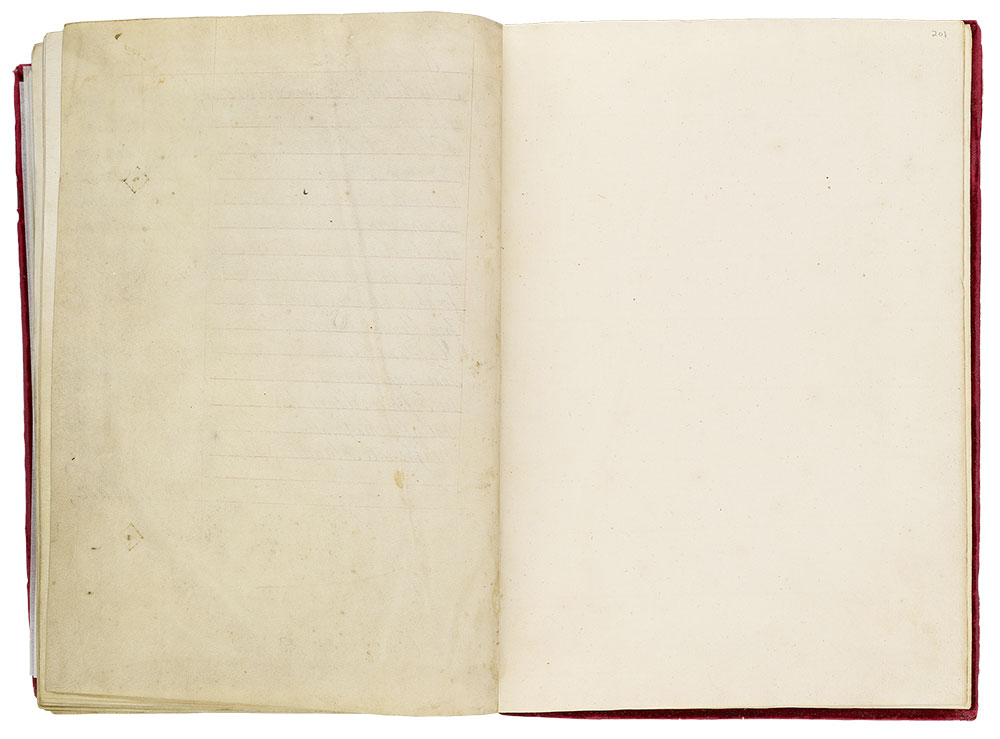
Hours of Henry VIII
Illuminated by Jean Poyer
Gift of the Heineman Foundation, 1977
MS H.8, fols. 201v–202r
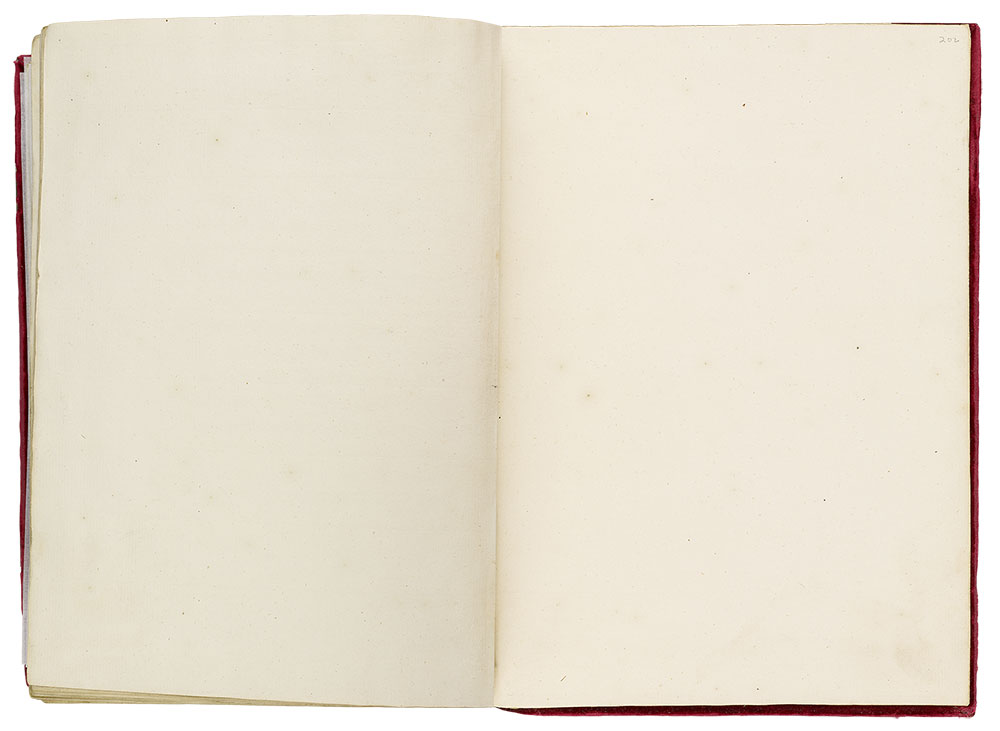
Hours of Henry VIII
Illuminated by Jean Poyer
Gift of the Heineman Foundation, 1977
MS H.8, fols. 202v–203r
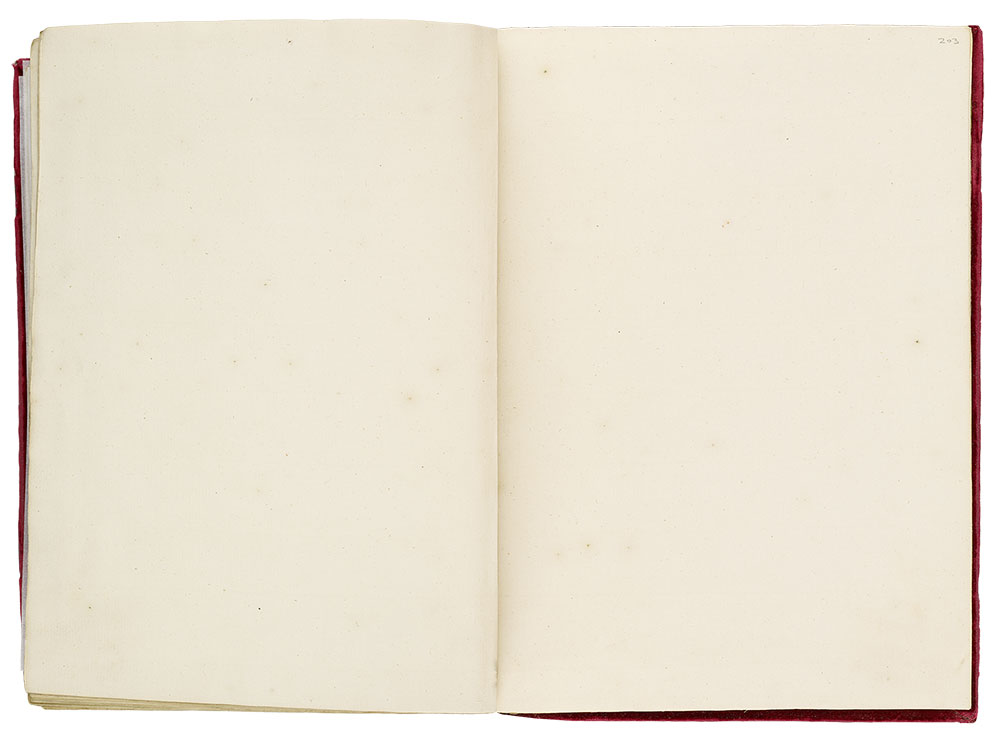
Hours of Henry VIII
Illuminated by Jean Poyer
Gift of the Heineman Foundation, 1977
MS H.8, fols. 203v–204r
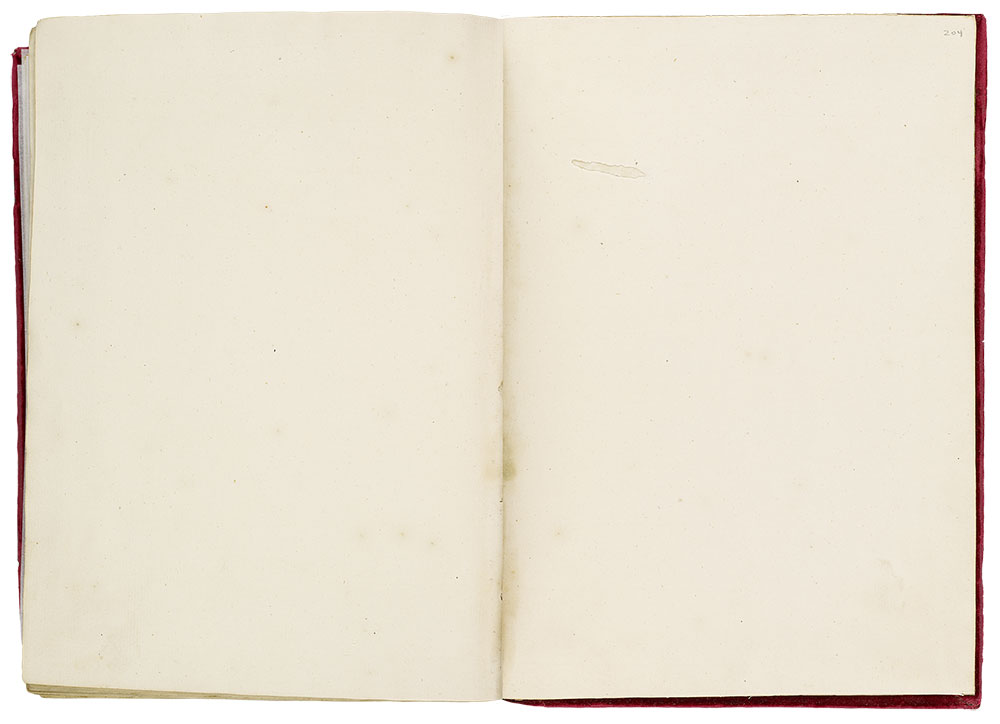
Hours of Henry VIII
Illuminated by Jean Poyer
Gift of the Heineman Foundation, 1977
MS H.8, fols. 204v–205r
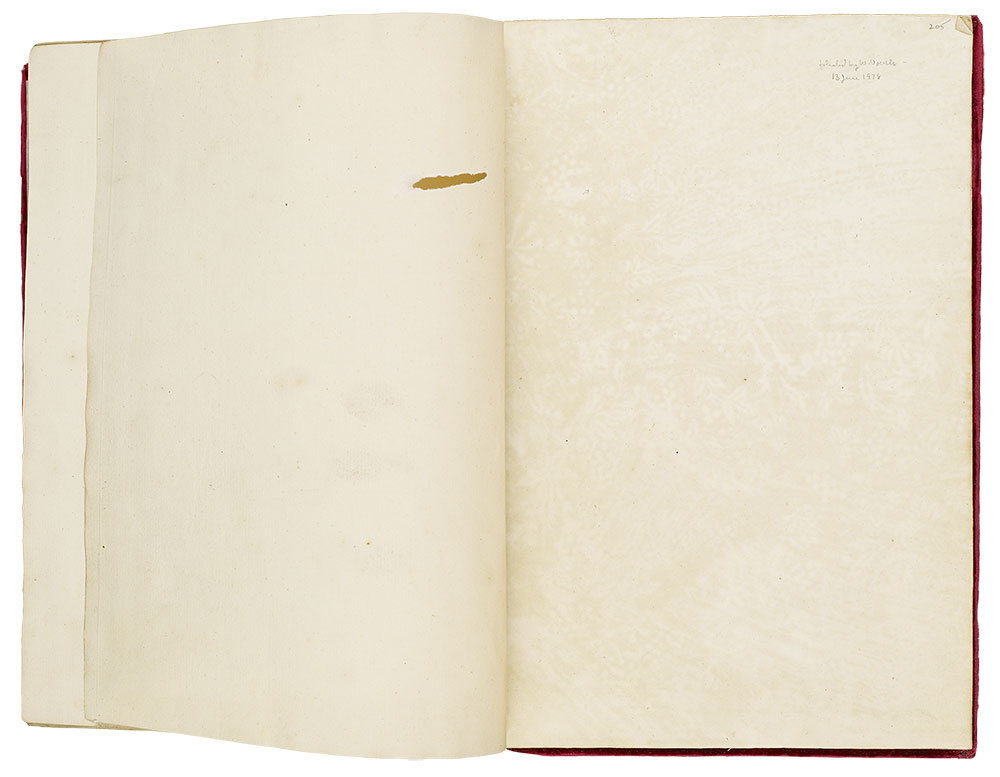
Hours of Henry VIII
Illuminated by Jean Poyer
Gift of the Heineman Foundation, 1977
Back fly leaf–inside back cover
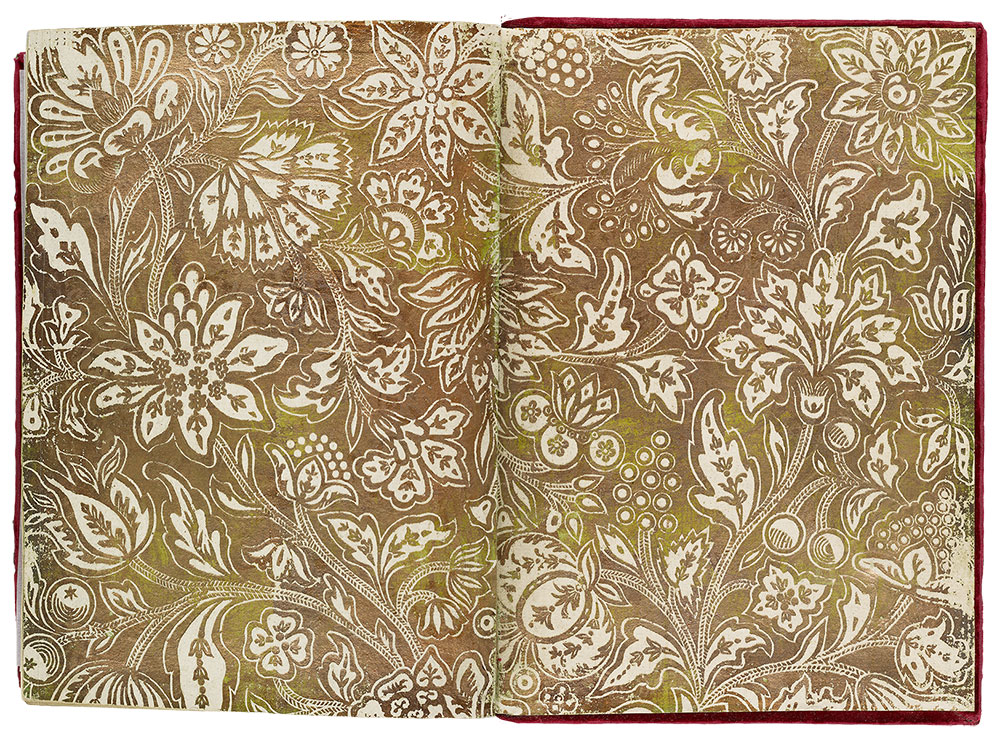
Hours of Henry VIII
Illuminated by Jean Poyer
Gift of the Heineman Foundation, 1977
MS H.8, back cover
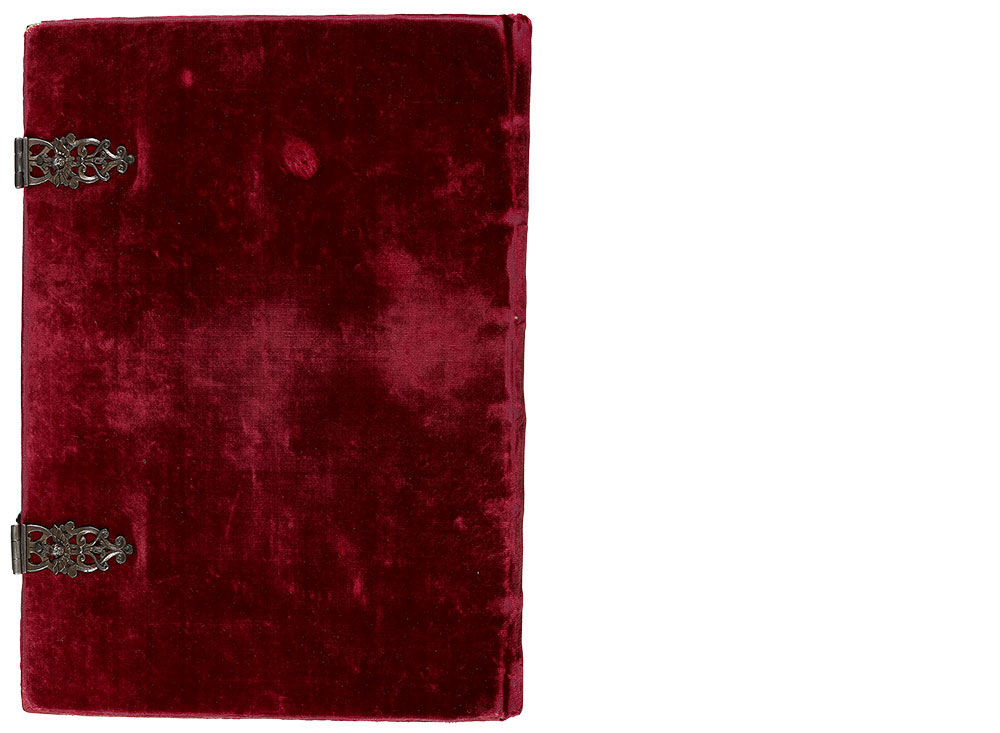
Hours of Henry VIII
Illuminated by Jean Poyer
Gift of the Heineman Foundation, 1977